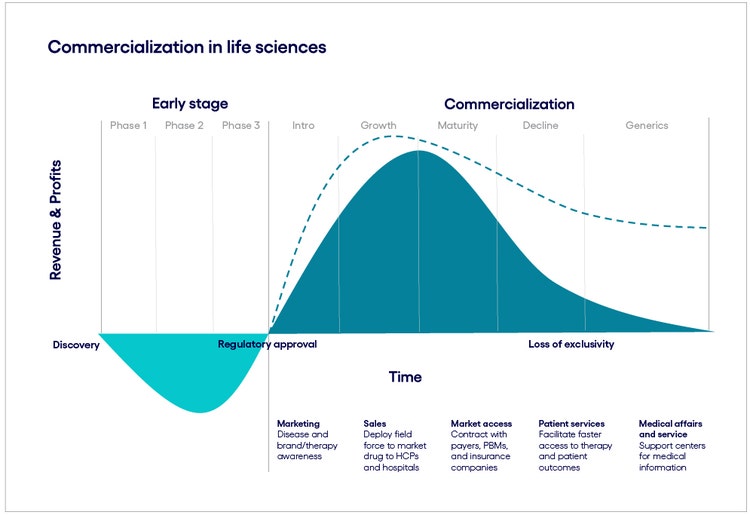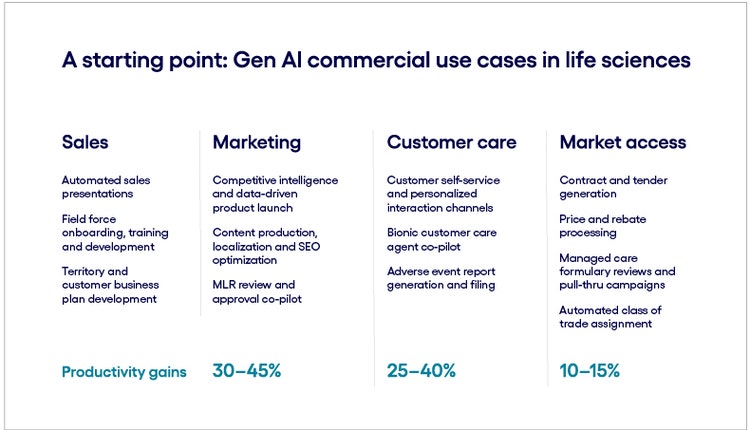<p><br> <span class="small">March 08, 2024</span></p>
Gen AI for biopharma: 5 less obvious truths
<p><b>Value-driven, scalable gen AI programs can deliver a lasting competitive advantage for biopharma firms. But only if they move quickly and think differently.</b></p>
<p>In March 2023, NVIDIA <a href="https://nvidianews.nvidia.com/news/nvidia-unveils-large-language-models-and-generative-ai-services-to-advance-life-sciences-r-d" target="_blank">launched BioNeMo™,</a> a cloud service that aimed to accelerate drug research and discovery through large language models and generative AI. At the time, media coverage focused on the platform’s potential—how it might rapidly identify potential drug molecules, predict their interactions in the body, and even simulate some aspects of clinical trials.</p> <p>A year later, it looks like the hype around BioNeMo may, if anything, have understated its potential. In the words of David M. Reese, CTO of Amgen, an early-access customer of the service, BioNeMo has been a “hinge moment” for his company, which will soon be using the service. It will train state-of-the-art AI models on one of the world’s largest human datasets in <a href="https://blogs.nvidia.com/blog/genomics-ai-amgen-superpod/" target="_blank">a matter of days rather than months</a>. That could mean significant improvements in time to market, particularly impacting drug discovery and phase 1 clinical trials.</p> <p>Amgen’s proactive embrace of gen AI, in other words, is already bearing fruit, with the prospect of even richer harvests in coming years. For other life sciences companies that want to follow suit, they need to move quickly and think differently. As a starting point, in this post we offer five core truths that companies can embrace to create value-driven, scalable generative AI programs and turn them into a multi-year competitive advantage.</p> <h5><span style="font-weight: normal;"><span class="text-bold-italic">1.</span> Every successful gen AI strategy is equal parts speed and scale.</span></h5> <p>While there is a dizzying number of exciting potential use cases for generative AI in the life sciences arena, it makes sense to focus initial investments on those that either shorten the discovery and development periods or amplify the scalability of treatments post-market.</p> <p>As every pharmaceutical leader knows, the success of a new drug is a matter of speed <i>and</i> scale. Companies usually have between <a href="https://www.ncbi.nlm.nih.gov/pmc/articles/PMC10242760/" target="_blank">five and eight years</a> to recoup the discovery and development costs of bringing that new drug to market…and funding the next one. When it comes to gen AI, an adoption strategy that puts speed and scale first is the key to realizing a competitive advantage. On the clinical front, this approach may resemble Amgen’s collaboration with NVIDIA, streamlining discovery and development phases through the application of advanced models that swiftly evaluate molecules, or facilitate in silico clinical trials.</p> <p>On the commercial side, generative AI is an invaluable tool to help educate healthcare professionals, hospitals, payers, insurance companies and even patients about a treatment’s value, thus helping companies capitalize on the limited in-market growth phase. Efforts here can take the form of microbrand launches, precision targeting of HCPs, optimized contracting and pricing strategies, more personalized customer and patient engagement, and/or better field force effectiveness.</p> <p>In the end, the main commercial objective should be accelerating access to therapy and care to all eligible patients. That drives better patient outcomes, which in turn drives better business outcomes.</p>
<p><svg xmlns="http://www.w3.org/2000/svg" id="Layer_1" data-name="Layer 1" viewbox="0 0 886 555"> <defs><mask id="Mask-1" style="mask-type: alpha;"><path id="light-solid" d="M293.023,316.003C266.389,368.503,239.755,421.003,202.088,421.003C164.422,421.003,115.722,368.503,67.0231,316.003" fill="#06c7cc" fill-rule="evenodd" stroke-width="0px" transform="translate(131.249,71.5027) translate(-180.023,-368.503)"></path></mask> <mask id="Mask-2" style="mask-type: alpha;"><path id="dark-solid" d="M293.023,316.003C357.59,200.38,422.157,84.7579,485.669,73.6059C549.181,62.4539,607.538,209.112,674.097,249.091C740.656,289.07,812.839,301.274,885.023,313.478" fill="#05819b" fill-rule="evenodd" stroke-width="0px" transform="translate(296,136.181) translate(-589.023,-194.503)"></path></mask> <mask id="Mask-3" style="mask-type: alpha;"><path id="dotted" d="M294.023,316.003C328.936,200.496,363.849,84.99,433.282,58.3214C502.715,31.6528,636.663,136.422,710.62,155.991C784.577,175.56,849.289,174.001,877.023,175.733" fill="none" stroke="#05819b" stroke-dasharray="0 0 9 6.75" stroke-miterlimit="8" stroke-width="2.25px" transform="translate(292.5,155.503) translate(-585.523,-185.003)"></path></mask></defs> <path fill="#000048" opacity="0" d="M4.116,-9.8C4.816,-9.8,5.46467,-9.67867,6.062,-9.436C6.65933,-9.19333,7.17733,-8.855,7.616,-8.421C8.05467,-7.987,8.39767,-7.47367,8.645,-6.881C8.89233,-6.28833,9.016,-5.642,9.016,-4.942C9.016,-4.23267,8.89233,-3.577,8.645,-2.975C8.39767,-2.373,8.05467,-1.85267,7.616,-1.414C7.17733,-0.975333,6.65933,-0.63,6.062,-0.378C5.46467,-0.126,4.816,0,4.116,0L0.896,0L0.896,-9.8ZM4.228,-1.568C4.676,-1.568,5.089,-1.65433,5.467,-1.827C5.845,-1.99967,6.17167,-2.23533,6.447,-2.534C6.72233,-2.83267,6.93933,-3.18733,7.098,-3.598C7.25667,-4.00867,7.336,-4.45667,7.336,-4.942C7.336,-5.418,7.259,-5.859,7.105,-6.265C6.951,-6.671,6.734,-7.01867,6.454,-7.308C6.174,-7.59733,5.845,-7.82367,5.467,-7.987C5.089,-8.15033,4.676,-8.232,4.228,-8.232L2.534,-8.232L2.534,-1.568ZM10.2547,-9.016C10.2547,-9.28667,10.3527,-9.52233,10.5487,-9.723C10.7447,-9.92367,10.978,-10.024,11.2487,-10.024C11.5287,-10.024,11.7667,-9.92367,11.9627,-9.723C12.1587,-9.52233,12.2567,-9.28667,12.2567,-9.016C12.2567,-8.74533,12.1587,-8.512,11.9627,-8.316C11.7667,-8.12,11.5287,-8.022,11.2487,-8.022C10.978,-8.022,10.7447,-8.12,10.5487,-8.316C10.3527,-8.512,10.2547,-8.74533,10.2547,-9.016ZM12.0187,-6.846L12.0187,0L10.4647,0L10.4647,-6.846ZM16.3095,0.14C15.4602,0.14,14.7672,-0.0653333,14.2305,-0.476C13.6939,-0.886667,13.3882,-1.46067,13.3135,-2.198L14.8116,-2.198C14.8396,-1.89933,14.9842,-1.659,15.2456,-1.477C15.5069,-1.295,15.8336,-1.204,16.2255,-1.204C16.6082,-1.204,16.9045,-1.27633,17.1145,-1.421C17.3245,-1.56567,17.4296,-1.75933,17.4296,-2.002C17.4296,-2.24467,17.3315,-2.42433,17.1355,-2.541C16.9395,-2.65767,16.6945,-2.751,16.4006,-2.821C16.1066,-2.891,15.7892,-2.95633,15.4485,-3.017C15.1079,-3.07767,14.7905,-3.17333,14.4965,-3.304C14.2025,-3.43467,13.9575,-3.62367,13.7615,-3.871C13.5655,-4.11833,13.4675,-4.45667,13.4675,-4.886C13.4675,-5.18467,13.5282,-5.46233,13.6495,-5.719C13.7709,-5.97567,13.9435,-6.19733,14.1676,-6.384C14.3915,-6.57067,14.6622,-6.71767,14.9795,-6.825C15.2969,-6.93233,15.6562,-6.986,16.0576,-6.986C16.4122,-6.986,16.7505,-6.93933,17.0725,-6.846C17.3945,-6.75267,17.6815,-6.615,17.9335,-6.433C18.1856,-6.251,18.3932,-6.027,18.5565,-5.761C18.7199,-5.495,18.8202,-5.18933,18.8575,-4.844L17.2896,-4.844C17.2522,-5.07733,17.1216,-5.27567,16.8975,-5.439C16.6735,-5.60233,16.3842,-5.684,16.0296,-5.684C15.7215,-5.684,15.4695,-5.621,15.2736,-5.495C15.0775,-5.369,14.9795,-5.19867,14.9795,-4.984C14.9795,-4.75067,15.0775,-4.58267,15.2736,-4.48C15.4695,-4.37733,15.7145,-4.29567,16.0085,-4.235C16.3025,-4.17433,16.6222,-4.11367,16.9675,-4.053C17.3129,-3.99233,17.6325,-3.88967,17.9265,-3.745C18.2205,-3.60033,18.4656,-3.395,18.6616,-3.129C18.8575,-2.863,18.9555,-2.492,18.9555,-2.016C18.9555,-1.708,18.8879,-1.42333,18.7526,-1.162C18.6172,-0.900667,18.4329,-0.672,18.1996,-0.476C17.9662,-0.28,17.6886,-0.128333,17.3666,-0.021C17.0445,0.0863333,16.6922,0.14,16.3095,0.14ZM23.4496,0.14C22.9456,0.14,22.479,0.049,22.0496,-0.133C21.6203,-0.315,21.247,-0.564667,20.9296,-0.882C20.6123,-1.19933,20.3626,-1.575,20.1806,-2.009C19.9986,-2.443,19.9076,-2.912,19.9076,-3.416C19.9076,-3.92,19.9986,-4.39133,20.1806,-4.83C20.3626,-5.26867,20.6123,-5.64667,20.9296,-5.964C21.247,-6.28133,21.6203,-6.531,22.0496,-6.713C22.479,-6.895,22.9456,-6.986,23.4496,-6.986C23.8603,-6.986,24.2523,-6.92067,24.6256,-6.79C24.999,-6.65933,25.3326,-6.47967,25.6266,-6.251C25.9206,-6.02233,26.1633,-5.74933,26.3546,-5.432C26.546,-5.11467,26.6696,-4.76933,26.7256,-4.396L25.1296,-4.396C25.0456,-4.71333,24.8473,-4.97467,24.5346,-5.18C24.222,-5.38533,23.8603,-5.488,23.4496,-5.488C23.1696,-5.488,22.906,-5.43433,22.6586,-5.327C22.4113,-5.21967,22.199,-5.075,22.0216,-4.893C21.8443,-4.711,21.7043,-4.494,21.6016,-4.242C21.499,-3.99,21.4476,-3.71467,21.4476,-3.416C21.4476,-3.12667,21.499,-2.856,21.6016,-2.604C21.7043,-2.352,21.8443,-2.135,22.0216,-1.953C22.199,-1.771,22.4113,-1.62633,22.6586,-1.519C22.906,-1.41167,23.1696,-1.358,23.4496,-1.358C23.8603,-1.358,24.2243,-1.463,24.5416,-1.673C24.859,-1.883,25.0596,-2.16067,25.1436,-2.506L26.7396,-2.506C26.693,-2.114,26.574,-1.757,26.3826,-1.435C26.1913,-1.113,25.9486,-0.835333,25.6546,-0.602C25.3606,-0.368667,25.0246,-0.186667,24.6466,-0.056C24.2686,0.0746667,23.8696,0.14,23.4496,0.14ZM31.2083,-6.986C31.7123,-6.986,32.1789,-6.895,32.6083,-6.713C33.0376,-6.531,33.4133,-6.28133,33.7353,-5.964C34.0573,-5.64667,34.3093,-5.26867,34.4913,-4.83C34.6733,-4.39133,34.7643,-3.92,34.7643,-3.416C34.7643,-2.912,34.6733,-2.443,34.4913,-2.009C34.3093,-1.575,34.0573,-1.19933,33.7353,-0.882C33.4133,-0.564667,33.0376,-0.315,32.6083,-0.133C32.1789,0.049,31.7123,0.14,31.2083,0.14C30.7043,0.14,30.2376,0.049,29.8083,-0.133C29.3789,-0.315,29.0056,-0.564667,28.6883,-0.882C28.3709,-1.19933,28.1213,-1.575,27.9393,-2.009C27.7573,-2.443,27.6663,-2.912,27.6663,-3.416C27.6663,-3.92,27.7573,-4.39133,27.9393,-4.83C28.1213,-5.26867,28.3709,-5.64667,28.6883,-5.964C29.0056,-6.28133,29.3789,-6.531,29.8083,-6.713C30.2376,-6.895,30.7043,-6.986,31.2083,-6.986ZM29.1783,-3.416C29.1783,-3.12667,29.2296,-2.856,29.3323,-2.604C29.4349,-2.352,29.5773,-2.135,29.7593,-1.953C29.9413,-1.771,30.1559,-1.62633,30.4033,-1.519C30.6506,-1.41167,30.9189,-1.358,31.2083,-1.358C31.4883,-1.358,31.7543,-1.41167,32.0063,-1.519C32.2583,-1.62633,32.4753,-1.771,32.6573,-1.953C32.8393,-2.135,32.9839,-2.352,33.0913,-2.604C33.1986,-2.856,33.2523,-3.12667,33.2523,-3.416C33.2523,-3.71467,33.1986,-3.99,33.0913,-4.242C32.9839,-4.494,32.8393,-4.71333,32.6573,-4.9C32.4753,-5.08667,32.2583,-5.23367,32.0063,-5.341C31.7543,-5.44833,31.4883,-5.502,31.2083,-5.502C30.9189,-5.502,30.6506,-5.44833,30.4033,-5.341C30.1559,-5.23367,29.9413,-5.08667,29.7593,-4.9C29.5773,-4.71333,29.4349,-4.494,29.3323,-4.242C29.2296,-3.99,29.1783,-3.71467,29.1783,-3.416ZM38.944,0L37.6,0L34.73,-6.846L36.424,-6.846L38.272,-2.086L40.106,-6.846L41.814,-6.846ZM46.0257,0.14C45.5216,0.14,45.055,0.049,44.6256,-0.133C44.1963,-0.315,43.8206,-0.567,43.4986,-0.889C43.1766,-1.211,42.9246,-1.59133,42.7426,-2.03C42.5606,-2.46867,42.4697,-2.94,42.4697,-3.444C42.4697,-3.948,42.5606,-4.41467,42.7426,-4.844C42.9246,-5.27333,43.1743,-5.64667,43.4916,-5.964C43.809,-6.28133,44.1823,-6.531,44.6116,-6.713C45.041,-6.895,45.503,-6.986,45.9977,-6.986C46.4643,-6.986,46.8983,-6.902,47.2996,-6.734C47.701,-6.566,48.0533,-6.33033,48.3566,-6.027C48.66,-5.72367,48.898,-5.369,49.0706,-4.963C49.2433,-4.557,49.3296,-4.116,49.3296,-3.64C49.3296,-3.56533,49.3273,-3.46733,49.3226,-3.346C49.318,-3.22467,49.311,-3.12667,49.3016,-3.052L43.9396,-3.052C44.0143,-2.492,44.236,-2.04167,44.6046,-1.701C44.9733,-1.36033,45.4423,-1.19,46.0117,-1.19C46.4596,-1.19,46.8353,-1.28567,47.1386,-1.477C47.442,-1.66833,47.631,-1.92733,47.7057,-2.254L49.2456,-2.254C49.1896,-1.89,49.0683,-1.561,48.8816,-1.267C48.695,-0.973,48.4593,-0.721,48.1746,-0.511C47.89,-0.301,47.5656,-0.14,47.2016,-0.028C46.8376,0.084,46.4456,0.14,46.0257,0.14ZM47.6777,-4.186C47.631,-4.61533,47.4466,-4.97,47.1246,-5.25C46.8026,-5.53,46.4036,-5.67,45.9276,-5.67C45.4516,-5.67,45.048,-5.54167,44.7166,-5.285C44.3853,-5.02833,44.1543,-4.662,44.0236,-4.186ZM50.6991,-6.846L52.2531,-6.846L52.2531,-5.936C52.4584,-6.26267,52.7151,-6.51933,53.0231,-6.706C53.3311,-6.89267,53.6904,-6.986,54.1011,-6.986C54.2037,-6.986,54.3111,-6.97667,54.423,-6.958C54.535,-6.93933,54.6424,-6.92067,54.745,-6.902L54.745,-5.474C54.633,-5.502,54.5187,-5.52533,54.4021,-5.544C54.2854,-5.56267,54.1711,-5.572,54.0591,-5.572C53.8071,-5.572,53.5714,-5.53,53.3521,-5.446C53.1327,-5.362,52.9414,-5.23833,52.778,-5.075C52.6147,-4.91167,52.4864,-4.711,52.3931,-4.473C52.2997,-4.235,52.2531,-3.962,52.2531,-3.654L52.2531,0L50.6991,0ZM58.1789,-0.364L55.4629,-6.846L57.1429,-6.846L58.9769,-2.184L60.8109,-6.846L62.4909,-6.846L58.6269,2.408L56.9469,2.408Z" fill-rule="nonzero" transform="translate(38.1078,381.406) translate(-31.3271,5.01897)" style="animation: 4.2s linear both a0_o; animation-play-state: paused;"></path> <path id="light-solid-mask" fill="#06c7cc" stroke="none" d="M13.3013,0L13.3013,0L13.3013,142.282L13.3013,142.282Z" mask="url(#Mask-1)" transform="translate(62.0756,419.566) translate(-13.3013,-71.141)" style="animation: 4.2s linear both light-solid-mask_d; animation-play-state: paused;"></path> <path fill="#000048" opacity="0" d="M0.896,-9.8L4.578,-9.8C4.98867,-9.8,5.376,-9.72533,5.74,-9.576C6.104,-9.42667,6.42367,-9.22133,6.699,-8.96C6.97433,-8.69867,7.19133,-8.39067,7.35,-8.036C7.50867,-7.68133,7.588,-7.29867,7.588,-6.888C7.588,-6.20667,7.42233,-5.62333,7.091,-5.138C6.75967,-4.65267,6.30467,-4.312,5.726,-4.116L8.4,0L6.412,0L3.976,-3.934L2.534,-3.934L2.534,0L0.896,0ZM4.522,-5.502C4.93267,-5.502,5.271,-5.63267,5.537,-5.894C5.803,-6.15533,5.936,-6.48667,5.936,-6.888C5.936,-7.28,5.803,-7.59967,5.537,-7.847C5.271,-8.09433,4.93267,-8.218,4.522,-8.218L2.534,-8.218L2.534,-5.502ZM12.51,0.14C12.006,0.14,11.5394,0.049,11.11,-0.133C10.6807,-0.315,10.305,-0.567,9.98303,-0.889C9.66103,-1.211,9.40903,-1.59133,9.22703,-2.03C9.04503,-2.46867,8.95403,-2.94,8.95403,-3.444C8.95403,-3.948,9.04503,-4.41467,9.22703,-4.844C9.40903,-5.27333,9.6587,-5.64667,9.97603,-5.964C10.2934,-6.28133,10.6667,-6.531,11.096,-6.713C11.5254,-6.895,11.9874,-6.986,12.482,-6.986C12.9487,-6.986,13.3827,-6.902,13.784,-6.734C14.1854,-6.566,14.5377,-6.33033,14.841,-6.027C15.1444,-5.72367,15.3824,-5.369,15.555,-4.963C15.7277,-4.557,15.814,-4.116,15.814,-3.64C15.814,-3.56533,15.8117,-3.46733,15.807,-3.346C15.8024,-3.22467,15.7954,-3.12667,15.786,-3.052L10.424,-3.052C10.4987,-2.492,10.7204,-2.04167,11.089,-1.701C11.4577,-1.36033,11.9267,-1.19,12.496,-1.19C12.944,-1.19,13.3197,-1.28567,13.623,-1.477C13.9264,-1.66833,14.1154,-1.92733,14.19,-2.254L15.73,-2.254C15.674,-1.89,15.5527,-1.561,15.366,-1.267C15.1794,-0.973,14.9437,-0.721,14.659,-0.511C14.3744,-0.301,14.05,-0.14,13.686,-0.028C13.322,0.084,12.93,0.14,12.51,0.14ZM14.162,-4.186C14.1154,-4.61533,13.931,-4.97,13.609,-5.25C13.287,-5.53,12.888,-5.67,12.412,-5.67C11.936,-5.67,11.5324,-5.54167,11.201,-5.285C10.8697,-5.02833,10.6387,-4.662,10.508,-4.186ZM20.4582,2.856C20.1129,2.856,19.7442,2.81633,19.3522,2.737C18.9602,2.65767,18.5962,2.52233,18.2602,2.331C17.9242,2.13967,17.6395,1.883,17.4062,1.561C17.1729,1.239,17.0469,0.84,17.0282,0.364L18.5822,0.364C18.5915,0.550667,18.6475,0.718667,18.7502,0.868C18.8529,1.01733,18.9859,1.14333,19.1492,1.246C19.3125,1.34867,19.5039,1.42567,19.7232,1.477C19.9425,1.52833,20.1735,1.554,20.4162,1.554C20.6869,1.554,20.9412,1.512,21.1792,1.428C21.4172,1.344,21.6249,1.225,21.8022,1.071C21.9795,0.917,22.1195,0.732667,22.2222,0.518C22.3249,0.303333,22.3762,0.0653333,22.3762,-0.196L22.3762,-0.91L22.3902,-0.91L22.3902,-1.4C22.1475,-0.970667,21.8209,-0.639333,21.4102,-0.406C20.9995,-0.172667,20.5142,-0.056,19.9542,-0.056C19.4969,-0.056,19.0675,-0.147,18.6662,-0.329C18.2649,-0.511,17.9172,-0.758333,17.6232,-1.071C17.3292,-1.38367,17.0982,-1.75233,16.9302,-2.177C16.7622,-2.60167,16.6782,-3.052,16.6782,-3.528C16.6782,-4.004,16.7622,-4.452,16.9302,-4.872C17.0982,-5.292,17.3292,-5.65833,17.6232,-5.971C17.9172,-6.28367,18.2649,-6.531,18.6662,-6.713C19.0675,-6.895,19.4969,-6.986,19.9542,-6.986C20.5142,-6.986,20.9995,-6.86933,21.4102,-6.636C21.8209,-6.40267,22.1475,-6.076,22.3902,-5.656L22.3902,-6.846L23.9582,-6.846L23.9582,-0.686L23.9442,-0.686L23.9442,-0.252C23.9442,0.224,23.8555,0.655667,23.6782,1.043C23.5009,1.43033,23.2559,1.757,22.9432,2.023C22.6305,2.289,22.2619,2.49433,21.8372,2.639C21.4125,2.78367,20.9529,2.856,20.4582,2.856ZM18.2182,-3.528C18.2182,-3.248,18.2719,-2.98433,18.3792,-2.737C18.4865,-2.48967,18.6335,-2.275,18.8202,-2.093C19.0069,-1.911,19.2262,-1.76633,19.4782,-1.659C19.7302,-1.55167,20.0009,-1.498,20.2902,-1.498C20.5889,-1.498,20.8642,-1.54933,21.1162,-1.652C21.3682,-1.75467,21.5875,-1.897,21.7742,-2.079C21.9609,-2.261,22.1079,-2.47567,22.2152,-2.723C22.3225,-2.97033,22.3762,-3.23867,22.3762,-3.528C22.3762,-3.81733,22.3225,-4.08333,22.2152,-4.326C22.1079,-4.56867,21.9609,-4.781,21.7742,-4.963C21.5875,-5.145,21.3682,-5.28733,21.1162,-5.39C20.8642,-5.49267,20.5889,-5.544,20.2902,-5.544C20.0009,-5.544,19.7302,-5.49267,19.4782,-5.39C19.2262,-5.28733,19.0069,-5.145,18.8202,-4.963C18.6335,-4.781,18.4865,-4.56633,18.3792,-4.319C18.2719,-4.07167,18.2182,-3.808,18.2182,-3.528ZM30.6568,-1.05C30.4422,-0.667333,30.1598,-0.373333,29.8098,-0.168C29.4598,0.0373333,29.0608,0.14,28.6128,0.14C27.7262,0.14,27.0308,-0.133,26.5268,-0.679C26.0228,-1.225,25.7708,-1.97867,25.7708,-2.94L25.7708,-6.846L27.3248,-6.846L27.3248,-3.136C27.3248,-2.59467,27.4765,-2.163,27.7798,-1.841C28.0832,-1.519,28.4868,-1.358,28.9908,-1.358C29.4668,-1.358,29.8542,-1.50033,30.1528,-1.785C30.4515,-2.06967,30.6195,-2.45467,30.6568,-2.94L30.6708,-6.846L32.2388,-6.846L32.2388,0L30.6568,0ZM35.4908,0L33.9368,0L33.9368,-9.8L35.4908,-9.8ZM44.1398,0L42.5718,0L42.5718,-1.232C42.3291,-0.793333,42.0025,-0.455,41.5918,-0.217C41.1811,0.021,40.6958,0.14,40.1358,0.14C39.6785,0.14,39.2491,0.0466667,38.8478,-0.14C38.4465,-0.326667,38.0988,-0.581,37.8048,-0.903C37.5108,-1.225,37.2798,-1.603,37.1118,-2.037C36.9438,-2.471,36.8598,-2.93533,36.8598,-3.43C36.8598,-3.92467,36.9438,-4.38667,37.1118,-4.816C37.2798,-5.24533,37.5108,-5.621,37.8048,-5.943C38.0988,-6.265,38.4465,-6.51933,38.8478,-6.706C39.2491,-6.89267,39.6785,-6.986,40.1358,-6.986C40.6958,-6.986,41.1811,-6.867,41.5918,-6.629C42.0025,-6.391,42.3291,-6.05267,42.5718,-5.614L42.5718,-6.846L44.1398,-6.846ZM38.3998,-3.43C38.3998,-3.14067,38.4535,-2.87,38.5608,-2.618C38.6681,-2.366,38.8151,-2.14433,39.0018,-1.953C39.1885,-1.76167,39.4078,-1.61233,39.6598,-1.505C39.9118,-1.39767,40.1825,-1.344,40.4718,-1.344C40.7705,-1.344,41.0458,-1.39767,41.2978,-1.505C41.5498,-1.61233,41.7691,-1.75933,41.9558,-1.946C42.1425,-2.13267,42.2895,-2.352,42.3968,-2.604C42.5041,-2.856,42.5578,-3.13133,42.5578,-3.43C42.5578,-3.72867,42.5041,-4.004,42.3968,-4.256C42.2895,-4.508,42.1425,-4.725,41.9558,-4.907C41.7691,-5.089,41.5498,-5.23367,41.2978,-5.341C41.0458,-5.44833,40.7705,-5.502,40.4718,-5.502C40.1825,-5.502,39.9118,-5.44833,39.6598,-5.341C39.4078,-5.23367,39.1885,-5.08667,39.0018,-4.9C38.8151,-4.71333,38.6681,-4.494,38.5608,-4.242C38.4535,-3.99,38.3998,-3.71933,38.3998,-3.43ZM48.9309,0.084C48.1749,0.084,47.5659,-0.14,47.1039,-0.588C46.6419,-1.036,46.4109,-1.69867,46.4109,-2.576L46.4109,-5.362L45.1089,-5.362L45.1089,-6.846L46.4109,-6.846L46.4109,-8.68L47.9789,-8.68L47.9789,-6.846L49.7709,-6.846L49.7709,-5.362L47.9789,-5.362L47.9789,-2.604C47.9789,-2.16533,48.0979,-1.85267,48.3359,-1.666C48.5739,-1.47933,48.8843,-1.386,49.2669,-1.386C49.3509,-1.386,49.4373,-1.39067,49.5259,-1.4C49.6146,-1.40933,49.6963,-1.42333,49.7709,-1.442L49.7709,0C49.6496,0.028,49.5119,0.049,49.3579,0.063C49.2039,0.077,49.0616,0.084,48.9309,0.084ZM54.0364,-6.986C54.5404,-6.986,55.0071,-6.895,55.4364,-6.713C55.8657,-6.531,56.2414,-6.28133,56.5634,-5.964C56.8854,-5.64667,57.1374,-5.26867,57.3194,-4.83C57.5014,-4.39133,57.5924,-3.92,57.5924,-3.416C57.5924,-2.912,57.5014,-2.443,57.3194,-2.009C57.1374,-1.575,56.8854,-1.19933,56.5634,-0.882C56.2414,-0.564667,55.8657,-0.315,55.4364,-0.133C55.0071,0.049,54.5404,0.14,54.0364,0.14C53.5324,0.14,53.0657,0.049,52.6364,-0.133C52.2071,-0.315,51.8337,-0.564667,51.5164,-0.882C51.1991,-1.19933,50.9494,-1.575,50.7674,-2.009C50.5854,-2.443,50.4944,-2.912,50.4944,-3.416C50.4944,-3.92,50.5854,-4.39133,50.7674,-4.83C50.9494,-5.26867,51.1991,-5.64667,51.5164,-5.964C51.8337,-6.28133,52.2071,-6.531,52.6364,-6.713C53.0657,-6.895,53.5324,-6.986,54.0364,-6.986ZM52.0064,-3.416C52.0064,-3.12667,52.0577,-2.856,52.1604,-2.604C52.2631,-2.352,52.4054,-2.135,52.5874,-1.953C52.7694,-1.771,52.9841,-1.62633,53.2314,-1.519C53.4787,-1.41167,53.7471,-1.358,54.0364,-1.358C54.3164,-1.358,54.5824,-1.41167,54.8344,-1.519C55.0864,-1.62633,55.3034,-1.771,55.4854,-1.953C55.6674,-2.135,55.8121,-2.352,55.9194,-2.604C56.0267,-2.856,56.0804,-3.12667,56.0804,-3.416C56.0804,-3.71467,56.0267,-3.99,55.9194,-4.242C55.8121,-4.494,55.6674,-4.71333,55.4854,-4.9C55.3034,-5.08667,55.0864,-5.23367,54.8344,-5.341C54.5824,-5.44833,54.3164,-5.502,54.0364,-5.502C53.7471,-5.502,53.4787,-5.44833,53.2314,-5.341C52.9841,-5.23367,52.7694,-5.08667,52.5874,-4.9C52.4054,-4.71333,52.2631,-4.494,52.1604,-4.242C52.0577,-3.99,52.0064,-3.71467,52.0064,-3.416ZM58.931,-6.846L60.485,-6.846L60.485,-5.936C60.6903,-6.26267,60.947,-6.51933,61.255,-6.706C61.563,-6.89267,61.9223,-6.986,62.333,-6.986C62.4356,-6.986,62.543,-6.97667,62.655,-6.958C62.767,-6.93933,62.8743,-6.92067,62.977,-6.902L62.977,-5.474C62.865,-5.502,62.7506,-5.52533,62.634,-5.544C62.5173,-5.56267,62.403,-5.572,62.291,-5.572C62.039,-5.572,61.8033,-5.53,61.584,-5.446C61.3646,-5.362,61.1733,-5.23833,61.01,-5.075C60.8466,-4.91167,60.7183,-4.711,60.625,-4.473C60.5316,-4.235,60.485,-3.962,60.485,-3.654L60.485,0L58.931,0ZM66.4109,-0.364L63.6949,-6.846L65.3749,-6.846L67.2089,-2.184L69.0429,-6.846L70.7229,-6.846L66.8589,2.408L65.1789,2.408ZM81.7545,0L80.1865,0L80.1865,-1.232C79.9439,-0.793333,79.6172,-0.455,79.2065,-0.217C78.7959,0.021,78.3105,0.14,77.7505,0.14C77.2932,0.14,76.8639,0.0466667,76.4625,-0.14C76.0612,-0.326667,75.7135,-0.581,75.4195,-0.903C75.1255,-1.225,74.8945,-1.603,74.7265,-2.037C74.5585,-2.471,74.4745,-2.93533,74.4745,-3.43C74.4745,-3.92467,74.5585,-4.38667,74.7265,-4.816C74.8945,-5.24533,75.1255,-5.621,75.4195,-5.943C75.7135,-6.265,76.0612,-6.51933,76.4625,-6.706C76.8639,-6.89267,77.2932,-6.986,77.7505,-6.986C78.3105,-6.986,78.7959,-6.867,79.2065,-6.629C79.6172,-6.391,79.9439,-6.05267,80.1865,-5.614L80.1865,-6.846L81.7545,-6.846ZM76.0145,-3.43C76.0145,-3.14067,76.0682,-2.87,76.1755,-2.618C76.2829,-2.366,76.4299,-2.14433,76.6165,-1.953C76.8032,-1.76167,77.0225,-1.61233,77.2745,-1.505C77.5265,-1.39767,77.7972,-1.344,78.0865,-1.344C78.3852,-1.344,78.6605,-1.39767,78.9125,-1.505C79.1645,-1.61233,79.3839,-1.75933,79.5705,-1.946C79.7572,-2.13267,79.9042,-2.352,80.0115,-2.604C80.1189,-2.856,80.1725,-3.13133,80.1725,-3.43C80.1725,-3.72867,80.1189,-4.004,80.0115,-4.256C79.9042,-4.508,79.7572,-4.725,79.5705,-4.907C79.3839,-5.089,79.1645,-5.23367,78.9125,-5.341C78.6605,-5.44833,78.3852,-5.502,78.0865,-5.502C77.7972,-5.502,77.5265,-5.44833,77.2745,-5.341C77.0225,-5.23367,76.8032,-5.08667,76.6165,-4.9C76.4299,-4.71333,76.2829,-4.494,76.1755,-4.242C76.0682,-3.99,76.0145,-3.71933,76.0145,-3.43ZM83.4569,-6.846L85.0109,-6.846L85.0109,-5.614C85.2535,-6.05267,85.5802,-6.391,85.9909,-6.629C86.4015,-6.867,86.8869,-6.986,87.4469,-6.986C87.9042,-6.986,88.3335,-6.89267,88.7349,-6.706C89.1362,-6.51933,89.4839,-6.265,89.7779,-5.943C90.0719,-5.621,90.3029,-5.243,90.4709,-4.809C90.6389,-4.375,90.7229,-3.91067,90.7229,-3.416C90.7229,-2.92133,90.6389,-2.45933,90.4709,-2.03C90.3029,-1.60067,90.0719,-1.225,89.7779,-0.903C89.4839,-0.581,89.1362,-0.326667,88.7349,-0.14C88.3335,0.0466667,87.9042,0.14,87.4469,0.14C86.8869,0.14,86.4015,0.021,85.9909,-0.217C85.5802,-0.455,85.2535,-0.793333,85.0109,-1.232L85.0109,2.394L83.4569,2.394ZM87.1109,-5.502C86.8122,-5.502,86.5369,-5.44833,86.2849,-5.341C86.0329,-5.23367,85.8135,-5.08667,85.6269,-4.9C85.4402,-4.71333,85.2932,-4.494,85.1859,-4.242C85.0785,-3.99,85.0249,-3.71467,85.0249,-3.416C85.0249,-3.12667,85.0785,-2.85367,85.1859,-2.597C85.2932,-2.34033,85.4402,-2.121,85.6269,-1.939C85.8135,-1.757,86.0329,-1.61233,86.2849,-1.505C86.5369,-1.39767,86.8122,-1.344,87.1109,-1.344C87.4002,-1.344,87.6709,-1.39767,87.9229,-1.505C88.1749,-1.61233,88.3942,-1.75933,88.5809,-1.946C88.7675,-2.13267,88.9145,-2.352,89.0219,-2.604C89.1292,-2.856,89.1829,-3.12667,89.1829,-3.416C89.1829,-3.70533,89.1292,-3.976,89.0219,-4.228C88.9145,-4.48,88.7675,-4.70167,88.5809,-4.893C88.3942,-5.08433,88.1749,-5.23367,87.9229,-5.341C87.6709,-5.44833,87.4002,-5.502,87.1109,-5.502ZM92.0726,-6.846L93.6266,-6.846L93.6266,-5.614C93.8692,-6.05267,94.1959,-6.391,94.6066,-6.629C95.0172,-6.867,95.5026,-6.986,96.0626,-6.986C96.5199,-6.986,96.9492,-6.89267,97.3506,-6.706C97.7519,-6.51933,98.0996,-6.265,98.3936,-5.943C98.6876,-5.621,98.9186,-5.243,99.0866,-4.809C99.2546,-4.375,99.3386,-3.91067,99.3386,-3.416C99.3386,-2.92133,99.2546,-2.45933,99.0866,-2.03C98.9186,-1.60067,98.6876,-1.225,98.3936,-0.903C98.0996,-0.581,97.7519,-0.326667,97.3506,-0.14C96.9492,0.0466667,96.5199,0.14,96.0626,0.14C95.5026,0.14,95.0172,0.021,94.6066,-0.217C94.1959,-0.455,93.8692,-0.793333,93.6266,-1.232L93.6266,2.394L92.0726,2.394ZM95.7266,-5.502C95.4279,-5.502,95.1526,-5.44833,94.9006,-5.341C94.6486,-5.23367,94.4292,-5.08667,94.2426,-4.9C94.0559,-4.71333,93.9089,-4.494,93.8016,-4.242C93.6942,-3.99,93.6406,-3.71467,93.6406,-3.416C93.6406,-3.12667,93.6942,-2.85367,93.8016,-2.597C93.9089,-2.34033,94.0559,-2.121,94.2426,-1.939C94.4292,-1.757,94.6486,-1.61233,94.9006,-1.505C95.1526,-1.39767,95.4279,-1.344,95.7266,-1.344C96.0159,-1.344,96.2866,-1.39767,96.5386,-1.505C96.7906,-1.61233,97.0099,-1.75933,97.1966,-1.946C97.3832,-2.13267,97.5302,-2.352,97.6376,-2.604C97.7449,-2.856,97.7986,-3.12667,97.7986,-3.416C97.7986,-3.70533,97.7449,-3.976,97.6376,-4.228C97.5302,-4.48,97.3832,-4.70167,97.1966,-4.893C97.0099,-5.08433,96.7906,-5.23367,96.5386,-5.341C96.2866,-5.44833,96.0159,-5.502,95.7266,-5.502ZM100.699,-6.846L102.253,-6.846L102.253,-5.936C102.458,-6.26267,102.715,-6.51933,103.023,-6.706C103.331,-6.89267,103.69,-6.986,104.101,-6.986C104.204,-6.986,104.311,-6.97667,104.423,-6.958C104.535,-6.93933,104.642,-6.92067,104.745,-6.902L104.745,-5.474C104.633,-5.502,104.519,-5.52533,104.402,-5.544C104.285,-5.56267,104.171,-5.572,104.059,-5.572C103.807,-5.572,103.571,-5.53,103.352,-5.446C103.133,-5.362,102.941,-5.23833,102.778,-5.075C102.615,-4.91167,102.486,-4.711,102.393,-4.473C102.3,-4.235,102.253,-3.962,102.253,-3.654L102.253,0L100.699,0ZM108.906,-6.986C109.41,-6.986,109.877,-6.895,110.306,-6.713C110.735,-6.531,111.111,-6.28133,111.433,-5.964C111.755,-5.64667,112.007,-5.26867,112.189,-4.83C112.371,-4.39133,112.462,-3.92,112.462,-3.416C112.462,-2.912,112.371,-2.443,112.189,-2.009C112.007,-1.575,111.755,-1.19933,111.433,-0.882C111.111,-0.564667,110.735,-0.315,110.306,-0.133C109.877,0.049,109.41,0.14,108.906,0.14C108.402,0.14,107.935,0.049,107.506,-0.133C107.077,-0.315,106.703,-0.564667,106.386,-0.882C106.069,-1.19933,105.819,-1.575,105.637,-2.009C105.455,-2.443,105.364,-2.912,105.364,-3.416C105.364,-3.92,105.455,-4.39133,105.637,-4.83C105.819,-5.26867,106.069,-5.64667,106.386,-5.964C106.703,-6.28133,107.077,-6.531,107.506,-6.713C107.935,-6.895,108.402,-6.986,108.906,-6.986ZM106.876,-3.416C106.876,-3.12667,106.927,-2.856,107.03,-2.604C107.133,-2.352,107.275,-2.135,107.457,-1.953C107.639,-1.771,107.854,-1.62633,108.101,-1.519C108.348,-1.41167,108.617,-1.358,108.906,-1.358C109.186,-1.358,109.452,-1.41167,109.704,-1.519C109.956,-1.62633,110.173,-1.771,110.355,-1.953C110.537,-2.135,110.682,-2.352,110.789,-2.604C110.896,-2.856,110.95,-3.12667,110.95,-3.416C110.95,-3.71467,110.896,-3.99,110.789,-4.242C110.682,-4.494,110.537,-4.71333,110.355,-4.9C110.173,-5.08667,109.956,-5.23367,109.704,-5.341C109.452,-5.44833,109.186,-5.502,108.906,-5.502C108.617,-5.502,108.348,-5.44833,108.101,-5.341C107.854,-5.23367,107.639,-5.08667,107.457,-4.9C107.275,-4.71333,107.133,-4.494,107.03,-4.242C106.927,-3.99,106.876,-3.71467,106.876,-3.416ZM116.986,0L115.642,0L112.772,-6.846L114.466,-6.846L116.314,-2.086L118.148,-6.846L119.856,-6.846ZM127.454,0L125.886,0L125.886,-1.232C125.644,-0.793333,125.317,-0.455,124.906,-0.217C124.496,0.021,124.01,0.14,123.45,0.14C122.993,0.14,122.564,0.0466667,122.162,-0.14C121.761,-0.326667,121.413,-0.581,121.119,-0.903C120.825,-1.225,120.594,-1.603,120.426,-2.037C120.258,-2.471,120.174,-2.93533,120.174,-3.43C120.174,-3.92467,120.258,-4.38667,120.426,-4.816C120.594,-5.24533,120.825,-5.621,121.119,-5.943C121.413,-6.265,121.761,-6.51933,122.162,-6.706C122.564,-6.89267,122.993,-6.986,123.45,-6.986C124.01,-6.986,124.496,-6.867,124.906,-6.629C125.317,-6.391,125.644,-6.05267,125.886,-5.614L125.886,-6.846L127.454,-6.846ZM121.714,-3.43C121.714,-3.14067,121.768,-2.87,121.875,-2.618C121.983,-2.366,122.13,-2.14433,122.316,-1.953C122.503,-1.76167,122.722,-1.61233,122.974,-1.505C123.226,-1.39767,123.497,-1.344,123.786,-1.344C124.085,-1.344,124.36,-1.39767,124.612,-1.505C124.864,-1.61233,125.084,-1.75933,125.27,-1.946C125.457,-2.13267,125.604,-2.352,125.711,-2.604C125.819,-2.856,125.872,-3.13133,125.872,-3.43C125.872,-3.72867,125.819,-4.004,125.711,-4.256C125.604,-4.508,125.457,-4.725,125.27,-4.907C125.084,-5.089,124.864,-5.23367,124.612,-5.341C124.36,-5.44833,124.085,-5.502,123.786,-5.502C123.497,-5.502,123.226,-5.44833,122.974,-5.341C122.722,-5.23367,122.503,-5.08667,122.316,-4.9C122.13,-4.71333,121.983,-4.494,121.875,-4.242C121.768,-3.99,121.714,-3.71933,121.714,-3.43ZM130.707,0L129.153,0L129.153,-9.8L130.707,-9.8Z" fill-rule="nonzero" transform="translate(291.616,380.406) translate(-65.7649,5.01897)" style="animation: 4.2s linear both a1_o; animation-play-state: paused;"></path> <rect id="dark-solid-mask" width="0.49992" height="270.659" fill="#05819b" rx="0" stroke="none" mask="url(#Mask-2)" transform="translate(589.023,245.076) translate(-296,-135.33)" style="animation: 4.2s linear both dark-solid-mask_w; animation-play-state: paused;"></rect> <path fill="#000048" opacity="0" d="M2.534,-9.8L2.534,-1.568L7.224,-1.568L7.224,0L0.896,0L0.896,-9.8ZM11.5149,-6.986C12.0189,-6.986,12.4856,-6.895,12.9149,-6.713C13.3442,-6.531,13.7199,-6.28133,14.0419,-5.964C14.3639,-5.64667,14.6159,-5.26867,14.7979,-4.83C14.9799,-4.39133,15.0709,-3.92,15.0709,-3.416C15.0709,-2.912,14.9799,-2.443,14.7979,-2.009C14.6159,-1.575,14.3639,-1.19933,14.0419,-0.882C13.7199,-0.564667,13.3442,-0.315,12.9149,-0.133C12.4856,0.049,12.0189,0.14,11.5149,0.14C11.0109,0.14,10.5442,0.049,10.1149,-0.133C9.68558,-0.315,9.31224,-0.564667,8.99491,-0.882C8.67758,-1.19933,8.42791,-1.575,8.24591,-2.009C8.06391,-2.443,7.97291,-2.912,7.97291,-3.416C7.97291,-3.92,8.06391,-4.39133,8.24591,-4.83C8.42791,-5.26867,8.67758,-5.64667,8.99491,-5.964C9.31224,-6.28133,9.68558,-6.531,10.1149,-6.713C10.5442,-6.895,11.0109,-6.986,11.5149,-6.986ZM9.48491,-3.416C9.48491,-3.12667,9.53624,-2.856,9.63891,-2.604C9.74158,-2.352,9.88391,-2.135,10.0659,-1.953C10.2479,-1.771,10.4626,-1.62633,10.7099,-1.519C10.9572,-1.41167,11.2256,-1.358,11.5149,-1.358C11.7949,-1.358,12.0609,-1.41167,12.3129,-1.519C12.5649,-1.62633,12.7819,-1.771,12.9639,-1.953C13.1459,-2.135,13.2906,-2.352,13.3979,-2.604C13.5052,-2.856,13.5589,-3.12667,13.5589,-3.416C13.5589,-3.71467,13.5052,-3.99,13.3979,-4.242C13.2906,-4.494,13.1459,-4.71333,12.9639,-4.9C12.7819,-5.08667,12.5649,-5.23367,12.3129,-5.341C12.0609,-5.44833,11.7949,-5.502,11.5149,-5.502C11.2256,-5.502,10.9572,-5.44833,10.7099,-5.341C10.4626,-5.23367,10.2479,-5.08667,10.0659,-4.9C9.88391,-4.71333,9.74158,-4.494,9.63891,-4.242C9.53624,-3.99,9.48491,-3.71467,9.48491,-3.416ZM18.8901,0.14C18.0408,0.14,17.3478,-0.0653333,16.8111,-0.476C16.2744,-0.886667,15.9688,-1.46067,15.8941,-2.198L17.3921,-2.198C17.4201,-1.89933,17.5648,-1.659,17.8261,-1.477C18.0874,-1.295,18.4141,-1.204,18.8061,-1.204C19.1888,-1.204,19.4851,-1.27633,19.6951,-1.421C19.9051,-1.56567,20.0101,-1.75933,20.0101,-2.002C20.0101,-2.24467,19.9121,-2.42433,19.7161,-2.541C19.5201,-2.65767,19.2751,-2.751,18.9811,-2.821C18.6871,-2.891,18.3698,-2.95633,18.0291,-3.017C17.6884,-3.07767,17.3711,-3.17333,17.0771,-3.304C16.7831,-3.43467,16.5381,-3.62367,16.3421,-3.871C16.1461,-4.11833,16.0481,-4.45667,16.0481,-4.886C16.0481,-5.18467,16.1088,-5.46233,16.2301,-5.719C16.3514,-5.97567,16.5241,-6.19733,16.7481,-6.384C16.9721,-6.57067,17.2428,-6.71767,17.5601,-6.825C17.8774,-6.93233,18.2368,-6.986,18.6381,-6.986C18.9928,-6.986,19.3311,-6.93933,19.6531,-6.846C19.9751,-6.75267,20.2621,-6.615,20.5141,-6.433C20.7661,-6.251,20.9738,-6.027,21.1371,-5.761C21.3004,-5.495,21.4008,-5.18933,21.4381,-4.844L19.8701,-4.844C19.8328,-5.07733,19.7021,-5.27567,19.4781,-5.439C19.2541,-5.60233,18.9648,-5.684,18.6101,-5.684C18.3021,-5.684,18.0501,-5.621,17.8541,-5.495C17.6581,-5.369,17.5601,-5.19867,17.5601,-4.984C17.5601,-4.75067,17.6581,-4.58267,17.8541,-4.48C18.0501,-4.37733,18.2951,-4.29567,18.5891,-4.235C18.8831,-4.17433,19.2028,-4.11367,19.5481,-4.053C19.8934,-3.99233,20.2131,-3.88967,20.5071,-3.745C20.8011,-3.60033,21.0461,-3.395,21.2421,-3.129C21.4381,-2.863,21.5361,-2.492,21.5361,-2.016C21.5361,-1.708,21.4684,-1.42333,21.3331,-1.162C21.1978,-0.900667,21.0134,-0.672,20.7801,-0.476C20.5468,-0.28,20.2691,-0.128333,19.9471,-0.021C19.6251,0.0863333,19.2728,0.14,18.8901,0.14ZM25.4404,0.14C24.5911,0.14,23.8981,-0.0653333,23.3614,-0.476C22.8247,-0.886667,22.5191,-1.46067,22.4444,-2.198L23.9424,-2.198C23.9704,-1.89933,24.1151,-1.659,24.3764,-1.477C24.6377,-1.295,24.9644,-1.204,25.3564,-1.204C25.7391,-1.204,26.0354,-1.27633,26.2454,-1.421C26.4554,-1.56567,26.5604,-1.75933,26.5604,-2.002C26.5604,-2.24467,26.4624,-2.42433,26.2664,-2.541C26.0704,-2.65767,25.8254,-2.751,25.5314,-2.821C25.2374,-2.891,24.9201,-2.95633,24.5794,-3.017C24.2387,-3.07767,23.9214,-3.17333,23.6274,-3.304C23.3334,-3.43467,23.0884,-3.62367,22.8924,-3.871C22.6964,-4.11833,22.5984,-4.45667,22.5984,-4.886C22.5984,-5.18467,22.6591,-5.46233,22.7804,-5.719C22.9017,-5.97567,23.0744,-6.19733,23.2984,-6.384C23.5224,-6.57067,23.7931,-6.71767,24.1104,-6.825C24.4277,-6.93233,24.7871,-6.986,25.1884,-6.986C25.5431,-6.986,25.8814,-6.93933,26.2034,-6.846C26.5254,-6.75267,26.8124,-6.615,27.0644,-6.433C27.3164,-6.251,27.5241,-6.027,27.6874,-5.761C27.8507,-5.495,27.9511,-5.18933,27.9884,-4.844L26.4204,-4.844C26.3831,-5.07733,26.2524,-5.27567,26.0284,-5.439C25.8044,-5.60233,25.5151,-5.684,25.1604,-5.684C24.8524,-5.684,24.6004,-5.621,24.4044,-5.495C24.2084,-5.369,24.1104,-5.19867,24.1104,-4.984C24.1104,-4.75067,24.2084,-4.58267,24.4044,-4.48C24.6004,-4.37733,24.8454,-4.29567,25.1394,-4.235C25.4334,-4.17433,25.7531,-4.11367,26.0984,-4.053C26.4437,-3.99233,26.7634,-3.88967,27.0574,-3.745C27.3514,-3.60033,27.5964,-3.395,27.7924,-3.129C27.9884,-2.863,28.0864,-2.492,28.0864,-2.016C28.0864,-1.708,28.0187,-1.42333,27.8834,-1.162C27.7481,-0.900667,27.5637,-0.672,27.3304,-0.476C27.0971,-0.28,26.8194,-0.128333,26.4974,-0.021C26.1754,0.0863333,25.8231,0.14,25.4404,0.14ZM35.5764,-6.986C36.0804,-6.986,36.5471,-6.895,36.9764,-6.713C37.4058,-6.531,37.7814,-6.28133,38.1034,-5.964C38.4254,-5.64667,38.6774,-5.26867,38.8594,-4.83C39.0414,-4.39133,39.1324,-3.92,39.1324,-3.416C39.1324,-2.912,39.0414,-2.443,38.8594,-2.009C38.6774,-1.575,38.4254,-1.19933,38.1034,-0.882C37.7814,-0.564667,37.4058,-0.315,36.9764,-0.133C36.5471,0.049,36.0804,0.14,35.5764,0.14C35.0724,0.14,34.6058,0.049,34.1764,-0.133C33.7471,-0.315,33.3738,-0.564667,33.0564,-0.882C32.7391,-1.19933,32.4894,-1.575,32.3074,-2.009C32.1254,-2.443,32.0344,-2.912,32.0344,-3.416C32.0344,-3.92,32.1254,-4.39133,32.3074,-4.83C32.4894,-5.26867,32.7391,-5.64667,33.0564,-5.964C33.3738,-6.28133,33.7471,-6.531,34.1764,-6.713C34.6058,-6.895,35.0724,-6.986,35.5764,-6.986ZM33.5464,-3.416C33.5464,-3.12667,33.5978,-2.856,33.7004,-2.604C33.8031,-2.352,33.9454,-2.135,34.1274,-1.953C34.3094,-1.771,34.5241,-1.62633,34.7714,-1.519C35.0188,-1.41167,35.2871,-1.358,35.5764,-1.358C35.8564,-1.358,36.1224,-1.41167,36.3744,-1.519C36.6264,-1.62633,36.8434,-1.771,37.0254,-1.953C37.2074,-2.135,37.3521,-2.352,37.4594,-2.604C37.5668,-2.856,37.6204,-3.12667,37.6204,-3.416C37.6204,-3.71467,37.5668,-3.99,37.4594,-4.242C37.3521,-4.494,37.2074,-4.71333,37.0254,-4.9C36.8434,-5.08667,36.6264,-5.23367,36.3744,-5.341C36.1224,-5.44833,35.8564,-5.502,35.5764,-5.502C35.2871,-5.502,35.0188,-5.44833,34.7714,-5.341C34.5241,-5.23367,34.3094,-5.08667,34.1274,-4.9C33.9454,-4.71333,33.8031,-4.494,33.7004,-4.242C33.5978,-3.99,33.5464,-3.71467,33.5464,-3.416ZM41.0457,-7.406C41.0457,-8.28333,41.2767,-8.946,41.7387,-9.394C42.2007,-9.842,42.8097,-10.066,43.5657,-10.066C43.6964,-10.066,43.8387,-10.059,43.9927,-10.045C44.1467,-10.031,44.2797,-10.01,44.3917,-9.982L44.3917,-8.54C44.317,-8.55867,44.2377,-8.57267,44.1537,-8.582C44.0697,-8.59133,43.9857,-8.596,43.9017,-8.596C43.519,-8.596,43.2087,-8.50267,42.9707,-8.316C42.7327,-8.12933,42.6137,-7.81667,42.6137,-7.378L42.6137,-6.846L44.3917,-6.846L44.3917,-5.362L42.6137,-5.362L42.6137,0L41.0457,0L41.0457,-5.362L39.7437,-5.362L39.7437,-6.846L41.0457,-6.846ZM51.7556,0.14C51.2516,0.14,50.785,0.049,50.3556,-0.133C49.9263,-0.315,49.5506,-0.567,49.2286,-0.889C48.9066,-1.211,48.6546,-1.59133,48.4726,-2.03C48.2906,-2.46867,48.1996,-2.94,48.1996,-3.444C48.1996,-3.948,48.2906,-4.41467,48.4726,-4.844C48.6546,-5.27333,48.9043,-5.64667,49.2216,-5.964C49.539,-6.28133,49.9123,-6.531,50.3416,-6.713C50.771,-6.895,51.233,-6.986,51.7276,-6.986C52.1943,-6.986,52.6283,-6.902,53.0296,-6.734C53.431,-6.566,53.7833,-6.33033,54.0866,-6.027C54.39,-5.72367,54.628,-5.369,54.8006,-4.963C54.9733,-4.557,55.0596,-4.116,55.0596,-3.64C55.0596,-3.56533,55.0573,-3.46733,55.0526,-3.346C55.048,-3.22467,55.041,-3.12667,55.0316,-3.052L49.6696,-3.052C49.7443,-2.492,49.966,-2.04167,50.3346,-1.701C50.7033,-1.36033,51.1723,-1.19,51.7416,-1.19C52.1896,-1.19,52.5653,-1.28567,52.8686,-1.477C53.172,-1.66833,53.361,-1.92733,53.4356,-2.254L54.9756,-2.254C54.9196,-1.89,54.7983,-1.561,54.6116,-1.267C54.425,-0.973,54.1893,-0.721,53.9046,-0.511C53.62,-0.301,53.2956,-0.14,52.9316,-0.028C52.5676,0.084,52.1756,0.14,51.7556,0.14ZM53.4076,-4.186C53.361,-4.61533,53.1766,-4.97,52.8546,-5.25C52.5326,-5.53,52.1336,-5.67,51.6576,-5.67C51.1816,-5.67,50.778,-5.54167,50.4466,-5.285C50.1153,-5.02833,49.8843,-4.662,49.7536,-4.186ZM58.8703,-2.212L57.3023,0L55.4403,0L57.9463,-3.528L55.5803,-6.846L57.4703,-6.846L58.8843,-4.844L60.3123,-6.846L62.1603,-6.846L59.8083,-3.542L62.3283,0L60.4523,0ZM66.1948,0.14C65.6908,0.14,65.2241,0.049,64.7948,-0.133C64.3654,-0.315,63.9921,-0.564667,63.6748,-0.882C63.3574,-1.19933,63.1078,-1.575,62.9258,-2.009C62.7438,-2.443,62.6528,-2.912,62.6528,-3.416C62.6528,-3.92,62.7438,-4.39133,62.9258,-4.83C63.1078,-5.26867,63.3574,-5.64667,63.6748,-5.964C63.9921,-6.28133,64.3654,-6.531,64.7948,-6.713C65.2241,-6.895,65.6908,-6.986,66.1948,-6.986C66.6054,-6.986,66.9974,-6.92067,67.3708,-6.79C67.7441,-6.65933,68.0778,-6.47967,68.3718,-6.251C68.6658,-6.02233,68.9084,-5.74933,69.0998,-5.432C69.2911,-5.11467,69.4148,-4.76933,69.4708,-4.396L67.8748,-4.396C67.7908,-4.71333,67.5924,-4.97467,67.2798,-5.18C66.9671,-5.38533,66.6054,-5.488,66.1948,-5.488C65.9148,-5.488,65.6511,-5.43433,65.4038,-5.327C65.1564,-5.21967,64.9441,-5.075,64.7668,-4.893C64.5894,-4.711,64.4494,-4.494,64.3468,-4.242C64.2441,-3.99,64.1928,-3.71467,64.1928,-3.416C64.1928,-3.12667,64.2441,-2.856,64.3468,-2.604C64.4494,-2.352,64.5894,-2.135,64.7668,-1.953C64.9441,-1.771,65.1564,-1.62633,65.4038,-1.519C65.6511,-1.41167,65.9148,-1.358,66.1948,-1.358C66.6054,-1.358,66.9694,-1.463,67.2868,-1.673C67.6041,-1.883,67.8048,-2.16067,67.8888,-2.506L69.4848,-2.506C69.4381,-2.114,69.3191,-1.757,69.1278,-1.435C68.9364,-1.113,68.6938,-0.835333,68.3998,-0.602C68.1058,-0.368667,67.7698,-0.186667,67.3918,-0.056C67.0138,0.0746667,66.6148,0.14,66.1948,0.14ZM72.3073,0L70.7533,0L70.7533,-9.8L72.3073,-9.8ZM78.8282,-1.05C78.6135,-0.667333,78.3312,-0.373333,77.9812,-0.168C77.6312,0.0373333,77.2322,0.14,76.7842,0.14C75.8975,0.14,75.2022,-0.133,74.6982,-0.679C74.1942,-1.225,73.9422,-1.97867,73.9422,-2.94L73.9422,-6.846L75.4962,-6.846L75.4962,-3.136C75.4962,-2.59467,75.6479,-2.163,75.9512,-1.841C76.2545,-1.519,76.6582,-1.358,77.1622,-1.358C77.6382,-1.358,78.0255,-1.50033,78.3242,-1.785C78.6229,-2.06967,78.7909,-2.45467,78.8282,-2.94L78.8422,-6.846L80.4102,-6.846L80.4102,0L78.8282,0ZM84.6494,0.14C83.8001,0.14,83.1071,-0.0653333,82.5704,-0.476C82.0337,-0.886667,81.7281,-1.46067,81.6534,-2.198L83.1514,-2.198C83.1794,-1.89933,83.3241,-1.659,83.5854,-1.477C83.8467,-1.295,84.1734,-1.204,84.5654,-1.204C84.9481,-1.204,85.2444,-1.27633,85.4544,-1.421C85.6644,-1.56567,85.7694,-1.75933,85.7694,-2.002C85.7694,-2.24467,85.6714,-2.42433,85.4754,-2.541C85.2794,-2.65767,85.0344,-2.751,84.7404,-2.821C84.4464,-2.891,84.1291,-2.95633,83.7884,-3.017C83.4477,-3.07767,83.1304,-3.17333,82.8364,-3.304C82.5424,-3.43467,82.2974,-3.62367,82.1014,-3.871C81.9054,-4.11833,81.8074,-4.45667,81.8074,-4.886C81.8074,-5.18467,81.8681,-5.46233,81.9894,-5.719C82.1107,-5.97567,82.2834,-6.19733,82.5074,-6.384C82.7314,-6.57067,83.0021,-6.71767,83.3194,-6.825C83.6367,-6.93233,83.9961,-6.986,84.3974,-6.986C84.7521,-6.986,85.0904,-6.93933,85.4124,-6.846C85.7344,-6.75267,86.0214,-6.615,86.2734,-6.433C86.5254,-6.251,86.7331,-6.027,86.8964,-5.761C87.0597,-5.495,87.1601,-5.18933,87.1974,-4.844L85.6294,-4.844C85.5921,-5.07733,85.4614,-5.27567,85.2374,-5.439C85.0134,-5.60233,84.7241,-5.684,84.3694,-5.684C84.0614,-5.684,83.8094,-5.621,83.6134,-5.495C83.4174,-5.369,83.3194,-5.19867,83.3194,-4.984C83.3194,-4.75067,83.4174,-4.58267,83.6134,-4.48C83.8094,-4.37733,84.0544,-4.29567,84.3484,-4.235C84.6424,-4.17433,84.9621,-4.11367,85.3074,-4.053C85.6527,-3.99233,85.9724,-3.88967,86.2664,-3.745C86.5604,-3.60033,86.8054,-3.395,87.0014,-3.129C87.1974,-2.863,87.2954,-2.492,87.2954,-2.016C87.2954,-1.708,87.2277,-1.42333,87.0924,-1.162C86.9571,-0.900667,86.7727,-0.672,86.5394,-0.476C86.3061,-0.28,86.0284,-0.128333,85.7064,-0.021C85.3844,0.0863333,85.0321,0.14,84.6494,0.14ZM88.3802,-9.016C88.3802,-9.28667,88.4782,-9.52233,88.6742,-9.723C88.8702,-9.92367,89.1035,-10.024,89.3742,-10.024C89.6542,-10.024,89.8922,-9.92367,90.0882,-9.723C90.2842,-9.52233,90.3822,-9.28667,90.3822,-9.016C90.3822,-8.74533,90.2842,-8.512,90.0882,-8.316C89.8922,-8.12,89.6542,-8.022,89.3742,-8.022C89.1035,-8.022,88.8702,-8.12,88.6742,-8.316C88.4782,-8.512,88.3802,-8.74533,88.3802,-9.016ZM90.1442,-6.846L90.1442,0L88.5902,0L88.5902,-6.846ZM95.2765,0L93.9325,0L91.0625,-6.846L92.7565,-6.846L94.6045,-2.086L96.4385,-6.846L98.1465,-6.846ZM98.8596,-9.016C98.8596,-9.28667,98.9576,-9.52233,99.1536,-9.723C99.3496,-9.92367,99.5829,-10.024,99.8536,-10.024C100.134,-10.024,100.372,-9.92367,100.568,-9.723C100.764,-9.52233,100.862,-9.28667,100.862,-9.016C100.862,-8.74533,100.764,-8.512,100.568,-8.316C100.372,-8.12,100.134,-8.022,99.8536,-8.022C99.5829,-8.022,99.3496,-8.12,99.1536,-8.316C98.9576,-8.512,98.8596,-8.74533,98.8596,-9.016ZM100.624,-6.846L100.624,0L99.0696,0L99.0696,-6.846ZM105.367,0.084C104.611,0.084,104.002,-0.14,103.54,-0.588C103.078,-1.036,102.847,-1.69867,102.847,-2.576L102.847,-5.362L101.545,-5.362L101.545,-6.846L102.847,-6.846L102.847,-8.68L104.415,-8.68L104.415,-6.846L106.207,-6.846L106.207,-5.362L104.415,-5.362L104.415,-2.604C104.415,-2.16533,104.534,-1.85267,104.772,-1.666C105.01,-1.47933,105.321,-1.386,105.703,-1.386C105.787,-1.386,105.874,-1.39067,105.962,-1.4C106.051,-1.40933,106.133,-1.42333,106.207,-1.442L106.207,0C106.086,0.028,105.948,0.049,105.794,0.063C105.64,0.077,105.498,0.084,105.367,0.084ZM109.642,-0.364L106.926,-6.846L108.606,-6.846L110.44,-2.184L112.274,-6.846L113.954,-6.846L110.09,2.408L108.41,2.408Z" fill-rule="nonzero" transform="translate(694.812,380.406) translate(-57.0586,5.01897)" style="animation: 4.2s linear both a2_o; animation-play-state: paused;"></path> <rect id="dotted-mask" width="0" height="286.503" opacity="1" fill="#05819b" rx="0" stroke="none" fill-rule="nonzero" mask="url(#Mask-3)" transform="translate(589.023,224.177) translate(-296,-143.251)" style="animation: 4.2s linear both dotted-mask_w; animation-play-state: paused;"></rect> <path fill="#000000" d="M4.8,0L4.8,-11.76L0.5,-11.76L0.5,-14L11.44,-14L11.44,-11.76L7.14,-11.76L7.14,0ZM12.4396,-12.88C12.4396,-13.2667,12.5796,-13.6033,12.8596,-13.89C13.1396,-14.1767,13.4729,-14.32,13.8596,-14.32C14.2596,-14.32,14.5996,-14.1767,14.8796,-13.89C15.1596,-13.6033,15.2996,-13.2667,15.2996,-12.88C15.2996,-12.4933,15.1596,-12.16,14.8796,-11.88C14.5996,-11.6,14.2596,-11.46,13.8596,-11.46C13.4729,-11.46,13.1396,-11.6,12.8596,-11.88C12.5796,-12.16,12.4396,-12.4933,12.4396,-12.88ZM14.9596,-9.78L14.9596,0L12.7396,0L12.7396,-9.78ZM32.3076,0L30.0476,0L30.0476,-5.48C30.0476,-6.21333,29.8609,-6.79,29.4876,-7.21C29.1143,-7.63,28.5943,-7.84,27.9276,-7.84C27.6476,-7.84,27.3776,-7.79333,27.1176,-7.7C26.8576,-7.60667,26.6276,-7.46667,26.4276,-7.28C26.2276,-7.09333,26.0643,-6.85,25.9376,-6.55C25.8109,-6.25,25.7476,-5.89333,25.7476,-5.48L25.7476,0L23.5076,0L23.5076,-5.48C23.5076,-6.22667,23.3176,-6.80667,22.9376,-7.22C22.5576,-7.63333,22.0343,-7.84,21.3676,-7.84C21.1143,-7.84,20.8676,-7.80333,20.6276,-7.73C20.3876,-7.65667,20.1676,-7.54,19.9676,-7.38C19.7676,-7.22,19.6009,-7.01333,19.4676,-6.76C19.3343,-6.50667,19.2476,-6.20667,19.2076,-5.86L19.2076,0L16.9676,0L16.9676,-9.78L19.2076,-9.78L19.2076,-8.42C19.3943,-8.71333,19.6043,-8.96,19.8376,-9.16C20.0709,-9.36,20.3176,-9.52,20.5776,-9.64C20.8376,-9.76,21.1043,-9.84667,21.3776,-9.9C21.6509,-9.95333,21.9143,-9.98,22.1676,-9.98C23.5943,-9.98,24.6009,-9.40667,25.1876,-8.26C25.4676,-8.79333,25.8876,-9.21333,26.4476,-9.52C27.0076,-9.82667,27.6276,-9.98,28.3076,-9.98C28.8943,-9.98,29.4343,-9.88667,29.9276,-9.7C30.4209,-9.51333,30.8443,-9.24667,31.1976,-8.9C31.5509,-8.55333,31.8243,-8.13333,32.0176,-7.64C32.2109,-7.14667,32.3076,-6.59333,32.3076,-5.98ZM38.821,0.2C38.101,0.2,37.4344,0.07,36.821,-0.19C36.2077,-0.45,35.671,-0.81,35.211,-1.27C34.751,-1.73,34.391,-2.27333,34.131,-2.9C33.871,-3.52667,33.741,-4.2,33.741,-4.92C33.741,-5.64,33.871,-6.30667,34.131,-6.92C34.391,-7.53333,34.7477,-8.06667,35.201,-8.52C35.6544,-8.97333,36.1877,-9.33,36.801,-9.59C37.4144,-9.85,38.0744,-9.98,38.781,-9.98C39.4477,-9.98,40.0677,-9.86,40.641,-9.62C41.2144,-9.38,41.7177,-9.04333,42.151,-8.61C42.5844,-8.17667,42.9244,-7.67,43.171,-7.09C43.4177,-6.51,43.541,-5.88,43.541,-5.2C43.541,-5.09333,43.5377,-4.95333,43.531,-4.78C43.5244,-4.60667,43.5144,-4.46667,43.501,-4.36L35.841,-4.36C35.9477,-3.56,36.2644,-2.91667,36.791,-2.43C37.3177,-1.94333,37.9877,-1.7,38.801,-1.7C39.441,-1.7,39.9777,-1.83667,40.411,-2.11C40.8444,-2.38333,41.1144,-2.75333,41.221,-3.22L43.421,-3.22C43.341,-2.7,43.1677,-2.23,42.901,-1.81C42.6344,-1.39,42.2977,-1.03,41.891,-0.73C41.4844,-0.43,41.021,-0.2,40.501,-0.04C39.981,0.12,39.421,0.2,38.821,0.2ZM41.181,-5.98C41.1144,-6.59333,40.851,-7.1,40.391,-7.5C39.931,-7.9,39.361,-8.1,38.681,-8.1C38.001,-8.1,37.4244,-7.91667,36.951,-7.55C36.4777,-7.18333,36.1477,-6.66,35.961,-5.98Z" fill-rule="nonzero" transform="translate(474.515,424.063) translate(-22.1243,7.16995)"></path> <path fill="#000048" d="M1.28,-14L6.54,-14C7.12667,-14,7.68,-13.8933,8.2,-13.68C8.72,-13.4667,9.17667,-13.1733,9.57,-12.8C9.96333,-12.4267,10.2733,-11.9867,10.5,-11.48C10.7267,-10.9733,10.84,-10.4267,10.84,-9.84C10.84,-8.86667,10.6033,-8.03333,10.13,-7.34C9.65667,-6.64667,9.00667,-6.16,8.18,-5.88L12,0L9.16,0L5.68,-5.62L3.62,-5.62L3.62,0L1.28,0ZM6.46,-7.86C7.04667,-7.86,7.53,-8.04667,7.91,-8.42C8.29,-8.79333,8.48,-9.26667,8.48,-9.84C8.48,-10.4,8.29,-10.8567,7.91,-11.21C7.53,-11.5633,7.04667,-11.74,6.46,-11.74L3.62,-11.74L3.62,-7.86ZM17.7537,0.2C17.0337,0.2,16.367,0.07,15.7537,-0.19C15.1403,-0.45,14.6037,-0.81,14.1437,-1.27C13.6837,-1.73,13.3237,-2.27333,13.0637,-2.9C12.8037,-3.52667,12.6737,-4.2,12.6737,-4.92C12.6737,-5.64,12.8037,-6.30667,13.0637,-6.92C13.3237,-7.53333,13.6803,-8.06667,14.1337,-8.52C14.587,-8.97333,15.1203,-9.33,15.7337,-9.59C16.347,-9.85,17.007,-9.98,17.7136,-9.98C18.3803,-9.98,19.0003,-9.86,19.5737,-9.62C20.147,-9.38,20.6503,-9.04333,21.0837,-8.61C21.517,-8.17667,21.857,-7.67,22.1037,-7.09C22.3503,-6.51,22.4736,-5.88,22.4736,-5.2C22.4736,-5.09333,22.4703,-4.95333,22.4636,-4.78C22.457,-4.60667,22.447,-4.46667,22.4337,-4.36L14.7737,-4.36C14.8803,-3.56,15.197,-2.91667,15.7236,-2.43C16.2503,-1.94333,16.9203,-1.7,17.7337,-1.7C18.3737,-1.7,18.9103,-1.83667,19.3437,-2.11C19.777,-2.38333,20.047,-2.75333,20.1537,-3.22L22.3537,-3.22C22.2737,-2.7,22.1003,-2.23,21.8337,-1.81C21.567,-1.39,21.2303,-1.03,20.8237,-0.73C20.417,-0.43,19.9537,-0.2,19.4337,-0.04C18.9137,0.12,18.3537,0.2,17.7537,0.2ZM20.1137,-5.98C20.047,-6.59333,19.7836,-7.1,19.3237,-7.5C18.8637,-7.9,18.2937,-8.1,17.6137,-8.1C16.9337,-8.1,16.357,-7.91667,15.8836,-7.55C15.4103,-7.18333,15.0803,-6.66,14.8937,-5.98ZM28.8796,0L26.9596,0L22.8596,-9.78L25.2796,-9.78L27.9196,-2.98L30.5396,-9.78L32.9796,-9.78ZM38.3835,0.2C37.6635,0.2,36.9969,0.07,36.3835,-0.19C35.7702,-0.45,35.2335,-0.81,34.7735,-1.27C34.3135,-1.73,33.9535,-2.27333,33.6935,-2.9C33.4335,-3.52667,33.3035,-4.2,33.3035,-4.92C33.3035,-5.64,33.4335,-6.30667,33.6935,-6.92C33.9535,-7.53333,34.3102,-8.06667,34.7635,-8.52C35.2169,-8.97333,35.7502,-9.33,36.3635,-9.59C36.9769,-9.85,37.6369,-9.98,38.3435,-9.98C39.0102,-9.98,39.6302,-9.86,40.2035,-9.62C40.7769,-9.38,41.2802,-9.04333,41.7135,-8.61C42.1469,-8.17667,42.4869,-7.67,42.7335,-7.09C42.9802,-6.51,43.1035,-5.88,43.1035,-5.2C43.1035,-5.09333,43.1002,-4.95333,43.0935,-4.78C43.0869,-4.60667,43.0769,-4.46667,43.0635,-4.36L35.4035,-4.36C35.5102,-3.56,35.8269,-2.91667,36.3535,-2.43C36.8802,-1.94333,37.5502,-1.7,38.3635,-1.7C39.0035,-1.7,39.5402,-1.83667,39.9735,-2.11C40.4069,-2.38333,40.6769,-2.75333,40.7835,-3.22L42.9835,-3.22C42.9035,-2.7,42.7302,-2.23,42.4635,-1.81C42.1969,-1.39,41.8602,-1.03,41.4535,-0.73C41.0469,-0.43,40.5835,-0.2,40.0635,-0.04C39.5435,0.12,38.9835,0.2,38.3835,0.2ZM40.7435,-5.98C40.6769,-6.59333,40.4135,-7.1,39.9535,-7.5C39.4935,-7.9,38.9235,-8.1,38.2435,-8.1C37.5635,-8.1,36.9869,-7.91667,36.5135,-7.55C36.0402,-7.18333,35.7102,-6.66,35.5235,-5.98ZM47.1832,-8.28C47.4898,-8.82667,47.8932,-9.24667,48.3932,-9.54C48.8932,-9.83333,49.4632,-9.98,50.1032,-9.98C51.3698,-9.98,52.3632,-9.59,53.0832,-8.81C53.8032,-8.03,54.1632,-6.95333,54.1632,-5.58L54.1632,0L51.9432,0L51.9432,-5.3C51.9432,-6.07333,51.7265,-6.69,51.2932,-7.15C50.8598,-7.61,50.2832,-7.84,49.5632,-7.84C48.8965,-7.84,48.3498,-7.64667,47.9232,-7.26C47.4965,-6.87333,47.2498,-6.34667,47.1832,-5.68L47.1832,0L44.9432,0L44.9432,-9.78L47.1832,-9.78ZM63.3353,-1.5C63.0286,-0.953333,62.6253,-0.533333,62.1253,-0.24C61.6253,0.0533333,61.0553,0.2,60.4153,0.2C59.1486,0.2,58.1553,-0.19,57.4353,-0.97C56.7153,-1.75,56.3553,-2.82667,56.3553,-4.2L56.3553,-9.78L58.5753,-9.78L58.5753,-4.48C58.5753,-3.70667,58.792,-3.09,59.2253,-2.63C59.6586,-2.17,60.2353,-1.94,60.9553,-1.94C61.6353,-1.94,62.1886,-2.14333,62.6153,-2.55C63.042,-2.95667,63.282,-3.50667,63.3353,-4.2L63.3553,-9.78L65.5953,-9.78L65.5953,0L63.3353,0ZM72.4534,0.2C71.7334,0.2,71.0667,0.07,70.4534,-0.19C69.8401,-0.45,69.3034,-0.81,68.8434,-1.27C68.3834,-1.73,68.0234,-2.27333,67.7634,-2.9C67.5034,-3.52667,67.3734,-4.2,67.3734,-4.92C67.3734,-5.64,67.5034,-6.30667,67.7634,-6.92C68.0234,-7.53333,68.3801,-8.06667,68.8334,-8.52C69.2867,-8.97333,69.8201,-9.33,70.4334,-9.59C71.0467,-9.85,71.7067,-9.98,72.4134,-9.98C73.0801,-9.98,73.7001,-9.86,74.2734,-9.62C74.8467,-9.38,75.3501,-9.04333,75.7834,-8.61C76.2167,-8.17667,76.5567,-7.67,76.8034,-7.09C77.0501,-6.51,77.1734,-5.88,77.1734,-5.2C77.1734,-5.09333,77.1701,-4.95333,77.1634,-4.78C77.1567,-4.60667,77.1467,-4.46667,77.1334,-4.36L69.4734,-4.36C69.5801,-3.56,69.8967,-2.91667,70.4234,-2.43C70.9501,-1.94333,71.6201,-1.7,72.4334,-1.7C73.0734,-1.7,73.6101,-1.83667,74.0434,-2.11C74.4767,-2.38333,74.7467,-2.75333,74.8534,-3.22L77.0534,-3.22C76.9734,-2.7,76.8001,-2.23,76.5334,-1.81C76.2667,-1.39,75.9301,-1.03,75.5234,-0.73C75.1167,-0.43,74.6534,-0.2,74.1334,-0.04C73.6134,0.12,73.0534,0.2,72.4534,0.2ZM74.8134,-5.98C74.7467,-6.59333,74.4834,-7.1,74.0234,-7.5C73.5634,-7.9,72.9934,-8.1,72.3134,-8.1C71.6334,-8.1,71.0567,-7.91667,70.5834,-7.55C70.1101,-7.18333,69.7801,-6.66,69.5934,-5.98ZM92.9472,0L91.4272,-1.62C90.8272,-1.04667,90.2005,-0.6,89.5472,-0.28C88.8938,0.04,88.1472,0.2,87.3072,0.2C86.7072,0.2,86.1472,0.1,85.6272,-0.1C85.1072,-0.3,84.6572,-0.573333,84.2772,-0.92C83.8972,-1.26667,83.6005,-1.68333,83.3872,-2.17C83.1738,-2.65667,83.0672,-3.18,83.0672,-3.74C83.0672,-4.27333,83.1438,-4.74333,83.2972,-5.15C83.4505,-5.55667,83.6538,-5.91333,83.9072,-6.22C84.1605,-6.52667,84.4538,-6.79333,84.7872,-7.02C85.1205,-7.24667,85.4672,-7.44667,85.8272,-7.62C85.4805,-8.00667,85.1805,-8.43667,84.9272,-8.91C84.6738,-9.38333,84.5472,-9.94,84.5472,-10.58C84.5472,-11.0867,84.6438,-11.56,84.8372,-12C85.0305,-12.44,85.2972,-12.8233,85.6372,-13.15C85.9772,-13.4767,86.3772,-13.7333,86.8372,-13.92C87.2972,-14.1067,87.7938,-14.2,88.3272,-14.2C88.8472,-14.2,89.3338,-14.1067,89.7872,-13.92C90.2405,-13.7333,90.6305,-13.4767,90.9572,-13.15C91.2838,-12.8233,91.5438,-12.44,91.7372,-12C91.9305,-11.56,92.0272,-11.0867,92.0272,-10.58C92.0272,-10.1,91.9572,-9.67333,91.8172,-9.3C91.6772,-8.92667,91.4872,-8.6,91.2472,-8.32C91.0072,-8.04,90.7305,-7.79333,90.4172,-7.58C90.1038,-7.36667,89.7738,-7.17333,89.4272,-7L91.4672,-4.8L92.9072,-6.28L95.9472,-6.28L92.9872,-3.2L95.9672,0ZM86.6872,-10.62C86.6872,-10.2733,86.8105,-9.93333,87.0572,-9.6C87.3038,-9.26667,87.6005,-8.91333,87.9472,-8.54C88.4938,-8.79333,88.9505,-9.07667,89.3172,-9.39C89.6838,-9.70333,89.8672,-10.1133,89.8672,-10.62C89.8672,-11.0467,89.7205,-11.41,89.4272,-11.71C89.1338,-12.01,88.7672,-12.16,88.3272,-12.16C87.8605,-12.16,87.4705,-12.01,87.1572,-11.71C86.8438,-11.41,86.6872,-11.0467,86.6872,-10.62ZM85.4672,-3.9C85.4672,-3.36667,85.6505,-2.93,86.0172,-2.59C86.3838,-2.25,86.8872,-2.08,87.5272,-2.08C87.9538,-2.08,88.3538,-2.17333,88.7272,-2.36C89.1005,-2.54667,89.5005,-2.84,89.9272,-3.24L87.2872,-6.04C86.7805,-5.78667,86.3505,-5.5,85.9972,-5.18C85.6438,-4.86,85.4672,-4.43333,85.4672,-3.9ZM102.634,-14L107.994,-14C108.634,-14,109.227,-13.8933,109.774,-13.68C110.321,-13.4667,110.794,-13.17,111.194,-12.79C111.594,-12.41,111.907,-11.9567,112.134,-11.43C112.361,-10.9033,112.474,-10.3333,112.474,-9.72C112.474,-9.09333,112.361,-8.51667,112.134,-7.99C111.907,-7.46333,111.594,-7.00667,111.194,-6.62C110.794,-6.23333,110.321,-5.93333,109.774,-5.72C109.227,-5.50667,108.634,-5.4,107.994,-5.4L104.974,-5.4L104.974,0L102.634,0ZM107.994,-7.64C108.607,-7.64,109.114,-7.83667,109.514,-8.23C109.914,-8.62333,110.114,-9.12,110.114,-9.72C110.114,-10.3067,109.914,-10.7933,109.514,-11.18C109.114,-11.5667,108.607,-11.76,107.994,-11.76L104.974,-11.76L104.974,-7.64ZM113.998,-9.78L116.218,-9.78L116.218,-8.48C116.511,-8.94667,116.878,-9.31333,117.318,-9.58C117.758,-9.84667,118.271,-9.98,118.858,-9.98C119.005,-9.98,119.158,-9.96667,119.318,-9.94C119.478,-9.91333,119.631,-9.88667,119.778,-9.86L119.778,-7.82C119.618,-7.86,119.455,-7.89333,119.288,-7.92C119.121,-7.94667,118.958,-7.96,118.798,-7.96C118.438,-7.96,118.101,-7.9,117.788,-7.78C117.475,-7.66,117.201,-7.48333,116.968,-7.25C116.735,-7.01667,116.551,-6.73,116.418,-6.39C116.285,-6.05,116.218,-5.66,116.218,-5.22L116.218,0L113.998,0ZM125.606,-9.98C126.326,-9.98,126.992,-9.85,127.606,-9.59C128.219,-9.33,128.756,-8.97333,129.216,-8.52C129.676,-8.06667,130.036,-7.52667,130.296,-6.9C130.556,-6.27333,130.686,-5.6,130.686,-4.88C130.686,-4.16,130.556,-3.49,130.296,-2.87C130.036,-2.25,129.676,-1.71333,129.216,-1.26C128.756,-0.806667,128.219,-0.45,127.606,-0.19C126.992,0.07,126.326,0.2,125.606,0.2C124.886,0.2,124.219,0.07,123.606,-0.19C122.992,-0.45,122.459,-0.806667,122.006,-1.26C121.552,-1.71333,121.196,-2.25,120.936,-2.87C120.676,-3.49,120.546,-4.16,120.546,-4.88C120.546,-5.6,120.676,-6.27333,120.936,-6.9C121.196,-7.52667,121.552,-8.06667,122.006,-8.52C122.459,-8.97333,122.992,-9.33,123.606,-9.59C124.219,-9.85,124.886,-9.98,125.606,-9.98ZM122.706,-4.88C122.706,-4.46667,122.779,-4.08,122.926,-3.72C123.072,-3.36,123.276,-3.05,123.536,-2.79C123.796,-2.53,124.102,-2.32333,124.456,-2.17C124.809,-2.01667,125.192,-1.94,125.606,-1.94C126.006,-1.94,126.386,-2.01667,126.746,-2.17C127.106,-2.32333,127.416,-2.53,127.676,-2.79C127.936,-3.05,128.142,-3.36,128.296,-3.72C128.449,-4.08,128.526,-4.46667,128.526,-4.88C128.526,-5.30667,128.449,-5.7,128.296,-6.06C128.142,-6.42,127.936,-6.73333,127.676,-7C127.416,-7.26667,127.106,-7.47667,126.746,-7.63C126.386,-7.78333,126.006,-7.86,125.606,-7.86C125.192,-7.86,124.809,-7.78333,124.456,-7.63C124.102,-7.47667,123.796,-7.26667,123.536,-7C123.276,-6.73333,123.072,-6.42,122.926,-6.06C122.779,-5.7,122.706,-5.30667,122.706,-4.88ZM133.383,-10.58C133.383,-11.8333,133.713,-12.78,134.373,-13.42C135.033,-14.06,135.903,-14.38,136.983,-14.38C137.17,-14.38,137.373,-14.37,137.593,-14.35C137.813,-14.33,138.003,-14.3,138.163,-14.26L138.163,-12.2C138.057,-12.2267,137.943,-12.2467,137.823,-12.26C137.703,-12.2733,137.583,-12.28,137.463,-12.28C136.917,-12.28,136.473,-12.1467,136.133,-11.88C135.793,-11.6133,135.623,-11.1667,135.623,-10.54L135.623,-9.78L138.163,-9.78L138.163,-7.66L135.623,-7.66L135.623,0L133.383,0L133.383,-7.66L131.523,-7.66L131.523,-9.78L133.383,-9.78ZM139.413,-12.88C139.413,-13.2667,139.553,-13.6033,139.833,-13.89C140.113,-14.1767,140.447,-14.32,140.833,-14.32C141.233,-14.32,141.573,-14.1767,141.853,-13.89C142.133,-13.6033,142.273,-13.2667,142.273,-12.88C142.273,-12.4933,142.133,-12.16,141.853,-11.88C141.573,-11.6,141.233,-11.46,140.833,-11.46C140.447,-11.46,140.113,-11.6,139.833,-11.88C139.553,-12.16,139.413,-12.4933,139.413,-12.88ZM141.933,-9.78L141.933,0L139.713,0L139.713,-9.78ZM148.673,0.12C147.593,0.12,146.723,-0.2,146.063,-0.84C145.403,-1.48,145.073,-2.42667,145.073,-3.68L145.073,-7.66L143.213,-7.66L143.213,-9.78L145.073,-9.78L145.073,-12.4L147.313,-12.4L147.313,-9.78L149.873,-9.78L149.873,-7.66L147.313,-7.66L147.313,-3.72C147.313,-3.09333,147.483,-2.64667,147.823,-2.38C148.163,-2.11333,148.606,-1.98,149.153,-1.98C149.273,-1.98,149.396,-1.98667,149.523,-2C149.65,-2.01333,149.766,-2.03333,149.873,-2.06L149.873,0C149.7,0.04,149.503,0.07,149.283,0.09C149.063,0.11,148.86,0.12,148.673,0.12ZM155.225,0.2C154.011,0.2,153.021,-0.0933334,152.255,-0.68C151.488,-1.26667,151.051,-2.08667,150.945,-3.14L153.085,-3.14C153.125,-2.71333,153.331,-2.37,153.705,-2.11C154.078,-1.85,154.545,-1.72,155.105,-1.72C155.651,-1.72,156.075,-1.82333,156.375,-2.03C156.675,-2.23667,156.825,-2.51333,156.825,-2.86C156.825,-3.20667,156.685,-3.46333,156.405,-3.63C156.125,-3.79667,155.775,-3.93,155.355,-4.03C154.935,-4.13,154.481,-4.22333,153.995,-4.31C153.508,-4.39667,153.055,-4.53333,152.635,-4.72C152.215,-4.90667,151.865,-5.17667,151.585,-5.53C151.305,-5.88333,151.165,-6.36667,151.165,-6.98C151.165,-7.40667,151.251,-7.80333,151.425,-8.17C151.598,-8.53667,151.845,-8.85333,152.165,-9.12C152.485,-9.38667,152.871,-9.59667,153.325,-9.75C153.778,-9.90333,154.291,-9.98,154.865,-9.98C155.371,-9.98,155.855,-9.91333,156.315,-9.78C156.775,-9.64667,157.185,-9.45,157.545,-9.19C157.905,-8.93,158.201,-8.61,158.435,-8.23C158.668,-7.85,158.811,-7.41333,158.865,-6.92L156.625,-6.92C156.571,-7.25333,156.385,-7.53667,156.065,-7.77C155.745,-8.00333,155.331,-8.12,154.825,-8.12C154.385,-8.12,154.025,-8.03,153.745,-7.85C153.465,-7.67,153.325,-7.42667,153.325,-7.12C153.325,-6.78667,153.465,-6.54667,153.745,-6.4C154.025,-6.25333,154.375,-6.13667,154.795,-6.05C155.215,-5.96333,155.671,-5.87667,156.165,-5.79C156.658,-5.70333,157.115,-5.55667,157.535,-5.35C157.955,-5.14333,158.305,-4.85,158.585,-4.47C158.865,-4.09,159.005,-3.56,159.005,-2.88C159.005,-2.44,158.908,-2.03333,158.715,-1.66C158.521,-1.28667,158.258,-0.96,157.925,-0.68C157.591,-0.4,157.195,-0.183333,156.735,-0.03C156.275,0.123333,155.771,0.2,155.225,0.2Z" fill-rule="nonzero" transform="translate(9.8302,216.587) rotate(-90) translate(-79.8352,7.16995)"></path> <g id="early-stage" transform="translate(176.692,208.425) translate(-105.169,-158.32)"><path d="M218.263,53.4999L219.79,313.109" fill="none" stroke="#d0d0ce" stroke-miterlimit="8" stroke-width=".5px" transform="translate(147.503,184.625) translate(-219.026,-183.304)"></path> <path d="M142.822,54.4999L144.348,314.109" fill="none" stroke="#d0d0ce" stroke-miterlimit="8" stroke-width=".5px" transform="translate(72.0619,185.625) translate(-143.585,-184.304)"></path> <path d="M71.5231,33.4999L71.5237,315.32" fill="none" stroke="#53565a" stroke-miterlimit="8" stroke-width=".5px" transform="translate(0.0003,175.73) translate(-71.5234,-174.41)"></path> <path fill="#97999b" d="M1.106,-9.8L4.872,-9.8C5.28267,-9.8,5.66533,-9.72767,6.02,-9.583C6.37467,-9.43833,6.68267,-9.24,6.944,-8.988C7.20533,-8.736,7.40833,-8.43967,7.553,-8.099C7.69767,-7.75833,7.77,-7.38733,7.77,-6.986C7.77,-6.58467,7.69767,-6.21133,7.553,-5.866C7.40833,-5.52067,7.20533,-5.222,6.944,-4.97C6.68267,-4.718,6.37467,-4.51967,6.02,-4.375C5.66533,-4.23033,5.28267,-4.158,4.872,-4.158L2.156,-4.158L2.156,0L1.106,0ZM4.872,-5.166C5.13333,-5.166,5.376,-5.21267,5.6,-5.306C5.824,-5.39933,6.01767,-5.52767,6.181,-5.691C6.34433,-5.85433,6.47267,-6.048,6.566,-6.272C6.65933,-6.496,6.706,-6.734,6.706,-6.986C6.706,-7.238,6.65933,-7.476,6.566,-7.7C6.47267,-7.924,6.34433,-8.11533,6.181,-8.274C6.01767,-8.43267,5.824,-8.55867,5.6,-8.652C5.376,-8.74533,5.13333,-8.792,4.872,-8.792L2.156,-8.792L2.156,-5.166ZM10.3111,-9.8L10.3111,-5.474C10.5258,-5.94067,10.8338,-6.30233,11.2351,-6.559C11.6364,-6.81567,12.1031,-6.944,12.6351,-6.944C13.0738,-6.944,13.4704,-6.874,13.8251,-6.734C14.1798,-6.594,14.4808,-6.39333,14.7281,-6.132C14.9754,-5.87067,15.1668,-5.55333,15.3021,-5.18C15.4374,-4.80667,15.5051,-4.38667,15.5051,-3.92L15.5051,0L14.4831,0L14.4831,-3.822C14.4831,-4.47533,14.2964,-4.998,13.9231,-5.39C13.5498,-5.782,13.0504,-5.978,12.4251,-5.978C11.7811,-5.978,11.2678,-5.782,10.8851,-5.39C10.5024,-4.998,10.3111,-4.47533,10.3111,-3.822L10.3111,0L9.28911,0L9.28911,-9.8ZM24.2508,0L23.2288,0L23.2288,-1.582C22.9862,-1.04067,22.6268,-0.618333,22.1508,-0.315C21.6748,-0.0116667,21.1102,0.14,20.4568,0.14C19.9902,0.14,19.5515,0.0466667,19.1408,-0.14C18.7302,-0.326667,18.3732,-0.581,18.0698,-0.903C17.7665,-1.225,17.5262,-1.60067,17.3488,-2.03C17.1715,-2.45933,17.0828,-2.92133,17.0828,-3.416C17.0828,-3.91067,17.1715,-4.37267,17.3488,-4.802C17.5262,-5.23133,17.7665,-5.60467,18.0698,-5.922C18.3732,-6.23933,18.7302,-6.489,19.1408,-6.671C19.5515,-6.853,19.9902,-6.944,20.4568,-6.944C21.1102,-6.944,21.6748,-6.79467,22.1508,-6.496C22.6268,-6.19733,22.9862,-5.77733,23.2288,-5.236L23.2288,-6.804L24.2508,-6.804ZM18.0908,-3.416C18.0908,-3.052,18.1562,-2.71133,18.2868,-2.394C18.4175,-2.07667,18.5995,-1.80367,18.8328,-1.575C19.0662,-1.34633,19.3368,-1.16433,19.6448,-1.029C19.9528,-0.893667,20.2888,-0.826,20.6528,-0.826C21.0262,-0.826,21.3692,-0.891333,21.6818,-1.022C21.9945,-1.15267,22.2652,-1.33233,22.4938,-1.561C22.7225,-1.78967,22.9022,-2.06267,23.0328,-2.38C23.1635,-2.69733,23.2288,-3.04267,23.2288,-3.416C23.2288,-3.78933,23.1635,-4.13233,23.0328,-4.445C22.9022,-4.75767,22.7225,-5.02833,22.4938,-5.257C22.2652,-5.48567,21.9945,-5.66533,21.6818,-5.796C21.3692,-5.92667,21.0262,-5.992,20.6528,-5.992C20.2888,-5.992,19.9528,-5.92433,19.6448,-5.789C19.3368,-5.65367,19.0662,-5.46933,18.8328,-5.236C18.5995,-5.00267,18.4175,-4.72967,18.2868,-4.417C18.1562,-4.10433,18.0908,-3.77067,18.0908,-3.416ZM28.4755,0.14C27.7101,0.14,27.0778,-0.0536667,26.5785,-0.441C26.0791,-0.828333,25.7921,-1.35333,25.7175,-2.016L26.6975,-2.016C26.7441,-1.624,26.9261,-1.31367,27.2435,-1.085C27.5608,-0.856333,27.9575,-0.742,28.4335,-0.742C28.9095,-0.742,29.2921,-0.849333,29.5815,-1.064C29.8708,-1.27867,30.0155,-1.55867,30.0155,-1.904C30.0155,-2.22133,29.9128,-2.45933,29.7075,-2.618C29.5021,-2.77667,29.2478,-2.898,28.9445,-2.982C28.6411,-3.066,28.3098,-3.13833,27.9505,-3.199C27.5911,-3.25967,27.2598,-3.353,26.9565,-3.479C26.6531,-3.605,26.3988,-3.787,26.1935,-4.025C25.9881,-4.263,25.8855,-4.60133,25.8855,-5.04C25.8855,-5.32,25.9438,-5.57667,26.0605,-5.81C26.1771,-6.04333,26.3405,-6.244,26.5505,-6.412C26.7605,-6.58,27.0148,-6.71067,27.3135,-6.804C27.6121,-6.89733,27.9435,-6.944,28.3075,-6.944C28.6341,-6.944,28.9445,-6.89967,29.2385,-6.811C29.5325,-6.72233,29.7961,-6.594,30.0295,-6.426C30.2628,-6.258,30.4541,-6.055,30.6035,-5.817C30.7528,-5.579,30.8461,-5.306,30.8835,-4.998L29.8475,-4.998C29.8008,-5.31533,29.6328,-5.57667,29.3435,-5.782C29.0541,-5.98733,28.6995,-6.09,28.2795,-6.09C27.8595,-6.09,27.5211,-6.00133,27.2645,-5.824C27.0078,-5.64667,26.8795,-5.40867,26.8795,-5.11C26.8795,-4.802,26.9821,-4.57567,27.1875,-4.431C27.3928,-4.28633,27.6471,-4.17433,27.9505,-4.095C28.2538,-4.01567,28.5851,-3.94567,28.9445,-3.885C29.3038,-3.82433,29.6351,-3.72867,29.9385,-3.598C30.2418,-3.46733,30.4961,-3.27367,30.7015,-3.017C30.9068,-2.76033,31.0095,-2.39867,31.0095,-1.932C31.0095,-1.63333,30.9465,-1.35567,30.8205,-1.099C30.6945,-0.842333,30.5171,-0.623,30.2885,-0.441C30.0598,-0.259,29.7915,-0.116667,29.4835,-0.014C29.1755,0.0886667,28.8395,0.14,28.4755,0.14ZM35.6731,0.14C35.1877,0.14,34.7327,0.049,34.3081,-0.133C33.8834,-0.315,33.5147,-0.564667,33.2021,-0.882C32.8894,-1.19933,32.6444,-1.57733,32.4671,-2.016C32.2897,-2.45467,32.2011,-2.926,32.2011,-3.43C32.2011,-3.92467,32.2897,-4.38667,32.4671,-4.816C32.6444,-5.24533,32.8894,-5.61633,33.2021,-5.929C33.5147,-6.24167,33.8811,-6.489,34.3011,-6.671C34.7211,-6.853,35.1737,-6.944,35.6591,-6.944C36.1164,-6.944,36.5434,-6.86,36.9401,-6.692C37.3367,-6.524,37.6821,-6.293,37.9761,-5.999C38.2701,-5.705,38.5011,-5.355,38.6691,-4.949C38.8371,-4.543,38.9211,-4.102,38.9211,-3.626L38.9071,-3.22L33.2091,-3.22C33.2557,-2.492,33.5031,-1.90167,33.9511,-1.449C34.3991,-0.996333,34.9824,-0.77,35.7011,-0.77C36.2331,-0.77,36.6997,-0.896,37.1011,-1.148C37.5024,-1.4,37.7497,-1.736,37.8431,-2.156L38.8511,-2.156C38.7857,-1.81067,38.6597,-1.49567,38.4731,-1.211C38.2864,-0.926333,38.0531,-0.683667,37.7731,-0.483C37.4931,-0.282333,37.1734,-0.128333,36.8141,-0.021C36.4547,0.0863333,36.0744,0.14,35.6731,0.14ZM37.8291,-4.088C37.8011,-4.368,37.7287,-4.627,37.6121,-4.865C37.4954,-5.103,37.3391,-5.30833,37.1431,-5.481C36.9471,-5.65367,36.7207,-5.789,36.4641,-5.887C36.2074,-5.985,35.9297,-6.034,35.6311,-6.034C35.0151,-6.034,34.4947,-5.85667,34.0701,-5.502C33.6454,-5.14733,33.3724,-4.676,33.2511,-4.088ZM46.9088,0L45.8448,0L45.8448,-8.344L43.5908,-6.412L43.5908,-7.714L46.1388,-9.8L46.9088,-9.8Z" fill-rule="nonzero" transform="translate(35.6374,40.3028) translate(-23.9976,5.01897)"></path> <path fill="#97999b" d="M1.106,-9.8L4.872,-9.8C5.28267,-9.8,5.66533,-9.72767,6.02,-9.583C6.37467,-9.43833,6.68267,-9.24,6.944,-8.988C7.20533,-8.736,7.40833,-8.43967,7.553,-8.099C7.69767,-7.75833,7.77,-7.38733,7.77,-6.986C7.77,-6.58467,7.69767,-6.21133,7.553,-5.866C7.40833,-5.52067,7.20533,-5.222,6.944,-4.97C6.68267,-4.718,6.37467,-4.51967,6.02,-4.375C5.66533,-4.23033,5.28267,-4.158,4.872,-4.158L2.156,-4.158L2.156,0L1.106,0ZM4.872,-5.166C5.13333,-5.166,5.376,-5.21267,5.6,-5.306C5.824,-5.39933,6.01767,-5.52767,6.181,-5.691C6.34433,-5.85433,6.47267,-6.048,6.566,-6.272C6.65933,-6.496,6.706,-6.734,6.706,-6.986C6.706,-7.238,6.65933,-7.476,6.566,-7.7C6.47267,-7.924,6.34433,-8.11533,6.181,-8.274C6.01767,-8.43267,5.824,-8.55867,5.6,-8.652C5.376,-8.74533,5.13333,-8.792,4.872,-8.792L2.156,-8.792L2.156,-5.166ZM10.3111,-9.8L10.3111,-5.474C10.5258,-5.94067,10.8338,-6.30233,11.2351,-6.559C11.6364,-6.81567,12.1031,-6.944,12.6351,-6.944C13.0738,-6.944,13.4704,-6.874,13.8251,-6.734C14.1798,-6.594,14.4808,-6.39333,14.7281,-6.132C14.9754,-5.87067,15.1668,-5.55333,15.3021,-5.18C15.4374,-4.80667,15.5051,-4.38667,15.5051,-3.92L15.5051,0L14.4831,0L14.4831,-3.822C14.4831,-4.47533,14.2964,-4.998,13.9231,-5.39C13.5498,-5.782,13.0504,-5.978,12.4251,-5.978C11.7811,-5.978,11.2678,-5.782,10.8851,-5.39C10.5024,-4.998,10.3111,-4.47533,10.3111,-3.822L10.3111,0L9.28911,0L9.28911,-9.8ZM24.2508,0L23.2288,0L23.2288,-1.582C22.9862,-1.04067,22.6268,-0.618333,22.1508,-0.315C21.6748,-0.0116667,21.1102,0.14,20.4568,0.14C19.9902,0.14,19.5515,0.0466667,19.1408,-0.14C18.7302,-0.326667,18.3732,-0.581,18.0698,-0.903C17.7665,-1.225,17.5262,-1.60067,17.3488,-2.03C17.1715,-2.45933,17.0828,-2.92133,17.0828,-3.416C17.0828,-3.91067,17.1715,-4.37267,17.3488,-4.802C17.5262,-5.23133,17.7665,-5.60467,18.0698,-5.922C18.3732,-6.23933,18.7302,-6.489,19.1408,-6.671C19.5515,-6.853,19.9902,-6.944,20.4568,-6.944C21.1102,-6.944,21.6748,-6.79467,22.1508,-6.496C22.6268,-6.19733,22.9862,-5.77733,23.2288,-5.236L23.2288,-6.804L24.2508,-6.804ZM18.0908,-3.416C18.0908,-3.052,18.1562,-2.71133,18.2868,-2.394C18.4175,-2.07667,18.5995,-1.80367,18.8328,-1.575C19.0662,-1.34633,19.3368,-1.16433,19.6448,-1.029C19.9528,-0.893667,20.2888,-0.826,20.6528,-0.826C21.0262,-0.826,21.3692,-0.891333,21.6818,-1.022C21.9945,-1.15267,22.2652,-1.33233,22.4938,-1.561C22.7225,-1.78967,22.9022,-2.06267,23.0328,-2.38C23.1635,-2.69733,23.2288,-3.04267,23.2288,-3.416C23.2288,-3.78933,23.1635,-4.13233,23.0328,-4.445C22.9022,-4.75767,22.7225,-5.02833,22.4938,-5.257C22.2652,-5.48567,21.9945,-5.66533,21.6818,-5.796C21.3692,-5.92667,21.0262,-5.992,20.6528,-5.992C20.2888,-5.992,19.9528,-5.92433,19.6448,-5.789C19.3368,-5.65367,19.0662,-5.46933,18.8328,-5.236C18.5995,-5.00267,18.4175,-4.72967,18.2868,-4.417C18.1562,-4.10433,18.0908,-3.77067,18.0908,-3.416ZM28.4755,0.14C27.7101,0.14,27.0778,-0.0536667,26.5785,-0.441C26.0791,-0.828333,25.7921,-1.35333,25.7175,-2.016L26.6975,-2.016C26.7441,-1.624,26.9261,-1.31367,27.2435,-1.085C27.5608,-0.856333,27.9575,-0.742,28.4335,-0.742C28.9095,-0.742,29.2921,-0.849333,29.5815,-1.064C29.8708,-1.27867,30.0155,-1.55867,30.0155,-1.904C30.0155,-2.22133,29.9128,-2.45933,29.7075,-2.618C29.5021,-2.77667,29.2478,-2.898,28.9445,-2.982C28.6411,-3.066,28.3098,-3.13833,27.9505,-3.199C27.5911,-3.25967,27.2598,-3.353,26.9565,-3.479C26.6531,-3.605,26.3988,-3.787,26.1935,-4.025C25.9881,-4.263,25.8855,-4.60133,25.8855,-5.04C25.8855,-5.32,25.9438,-5.57667,26.0605,-5.81C26.1771,-6.04333,26.3405,-6.244,26.5505,-6.412C26.7605,-6.58,27.0148,-6.71067,27.3135,-6.804C27.6121,-6.89733,27.9435,-6.944,28.3075,-6.944C28.6341,-6.944,28.9445,-6.89967,29.2385,-6.811C29.5325,-6.72233,29.7961,-6.594,30.0295,-6.426C30.2628,-6.258,30.4541,-6.055,30.6035,-5.817C30.7528,-5.579,30.8461,-5.306,30.8835,-4.998L29.8475,-4.998C29.8008,-5.31533,29.6328,-5.57667,29.3435,-5.782C29.0541,-5.98733,28.6995,-6.09,28.2795,-6.09C27.8595,-6.09,27.5211,-6.00133,27.2645,-5.824C27.0078,-5.64667,26.8795,-5.40867,26.8795,-5.11C26.8795,-4.802,26.9821,-4.57567,27.1875,-4.431C27.3928,-4.28633,27.6471,-4.17433,27.9505,-4.095C28.2538,-4.01567,28.5851,-3.94567,28.9445,-3.885C29.3038,-3.82433,29.6351,-3.72867,29.9385,-3.598C30.2418,-3.46733,30.4961,-3.27367,30.7015,-3.017C30.9068,-2.76033,31.0095,-2.39867,31.0095,-1.932C31.0095,-1.63333,30.9465,-1.35567,30.8205,-1.099C30.6945,-0.842333,30.5171,-0.623,30.2885,-0.441C30.0598,-0.259,29.7915,-0.116667,29.4835,-0.014C29.1755,0.0886667,28.8395,0.14,28.4755,0.14ZM35.6731,0.14C35.1877,0.14,34.7327,0.049,34.3081,-0.133C33.8834,-0.315,33.5147,-0.564667,33.2021,-0.882C32.8894,-1.19933,32.6444,-1.57733,32.4671,-2.016C32.2897,-2.45467,32.2011,-2.926,32.2011,-3.43C32.2011,-3.92467,32.2897,-4.38667,32.4671,-4.816C32.6444,-5.24533,32.8894,-5.61633,33.2021,-5.929C33.5147,-6.24167,33.8811,-6.489,34.3011,-6.671C34.7211,-6.853,35.1737,-6.944,35.6591,-6.944C36.1164,-6.944,36.5434,-6.86,36.9401,-6.692C37.3367,-6.524,37.6821,-6.293,37.9761,-5.999C38.2701,-5.705,38.5011,-5.355,38.6691,-4.949C38.8371,-4.543,38.9211,-4.102,38.9211,-3.626L38.9071,-3.22L33.2091,-3.22C33.2557,-2.492,33.5031,-1.90167,33.9511,-1.449C34.3991,-0.996333,34.9824,-0.77,35.7011,-0.77C36.2331,-0.77,36.6997,-0.896,37.1011,-1.148C37.5024,-1.4,37.7497,-1.736,37.8431,-2.156L38.8511,-2.156C38.7857,-1.81067,38.6597,-1.49567,38.4731,-1.211C38.2864,-0.926333,38.0531,-0.683667,37.7731,-0.483C37.4931,-0.282333,37.1734,-0.128333,36.8141,-0.021C36.4547,0.0863333,36.0744,0.14,35.6731,0.14ZM37.8291,-4.088C37.8011,-4.368,37.7287,-4.627,37.6121,-4.865C37.4954,-5.103,37.3391,-5.30833,37.1431,-5.481C36.9471,-5.65367,36.7207,-5.789,36.4641,-5.887C36.2074,-5.985,35.9297,-6.034,35.6311,-6.034C35.0151,-6.034,34.4947,-5.85667,34.0701,-5.502C33.6454,-5.14733,33.3724,-4.676,33.2511,-4.088ZM43.5488,-0.784L47.3148,-4.55C47.8095,-5.054,48.1805,-5.50433,48.4278,-5.901C48.6751,-6.29767,48.7988,-6.692,48.7988,-7.084C48.7988,-7.35467,48.7498,-7.602,48.6518,-7.826C48.5538,-8.05,48.4161,-8.24133,48.2388,-8.4C48.0615,-8.55867,47.8515,-8.68467,47.6088,-8.778C47.3661,-8.87133,47.1048,-8.918,46.8248,-8.918C46.4981,-8.918,46.1995,-8.86667,45.9288,-8.764C45.6581,-8.66133,45.4248,-8.51433,45.2288,-8.323C45.0328,-8.13167,44.8811,-7.90067,44.7738,-7.63C44.6665,-7.35933,44.6175,-7.05133,44.6268,-6.706L43.5768,-6.706C43.5675,-7.20067,43.6421,-7.64633,43.8008,-8.043C43.9595,-8.43967,44.1858,-8.778,44.4798,-9.058C44.7738,-9.338,45.1215,-9.555,45.5228,-9.709C45.9241,-9.863,46.3628,-9.94,46.8388,-9.94C47.2775,-9.94,47.6811,-9.87,48.0498,-9.73C48.4185,-9.59,48.7381,-9.394,49.0088,-9.142C49.2795,-8.89,49.4918,-8.59133,49.6458,-8.246C49.7998,-7.90067,49.8768,-7.52267,49.8768,-7.112C49.8768,-6.58,49.7158,-6.048,49.3938,-5.516C49.0718,-4.984,48.6308,-4.44733,48.0708,-3.906L45.2008,-1.022L50.0028,-1.022L50.0028,0L43.5488,0Z" fill-rule="nonzero" transform="translate(109.774,40.3028) translate(-25.3101,5.01897)"></path> <path fill="#97999b" d="M1.106,-9.8L4.872,-9.8C5.28267,-9.8,5.66533,-9.72767,6.02,-9.583C6.37467,-9.43833,6.68267,-9.24,6.944,-8.988C7.20533,-8.736,7.40833,-8.43967,7.553,-8.099C7.69767,-7.75833,7.77,-7.38733,7.77,-6.986C7.77,-6.58467,7.69767,-6.21133,7.553,-5.866C7.40833,-5.52067,7.20533,-5.222,6.944,-4.97C6.68267,-4.718,6.37467,-4.51967,6.02,-4.375C5.66533,-4.23033,5.28267,-4.158,4.872,-4.158L2.156,-4.158L2.156,0L1.106,0ZM4.872,-5.166C5.13333,-5.166,5.376,-5.21267,5.6,-5.306C5.824,-5.39933,6.01767,-5.52767,6.181,-5.691C6.34433,-5.85433,6.47267,-6.048,6.566,-6.272C6.65933,-6.496,6.706,-6.734,6.706,-6.986C6.706,-7.238,6.65933,-7.476,6.566,-7.7C6.47267,-7.924,6.34433,-8.11533,6.181,-8.274C6.01767,-8.43267,5.824,-8.55867,5.6,-8.652C5.376,-8.74533,5.13333,-8.792,4.872,-8.792L2.156,-8.792L2.156,-5.166ZM10.3111,-9.8L10.3111,-5.474C10.5258,-5.94067,10.8338,-6.30233,11.2351,-6.559C11.6364,-6.81567,12.1031,-6.944,12.6351,-6.944C13.0738,-6.944,13.4704,-6.874,13.8251,-6.734C14.1798,-6.594,14.4808,-6.39333,14.7281,-6.132C14.9754,-5.87067,15.1668,-5.55333,15.3021,-5.18C15.4374,-4.80667,15.5051,-4.38667,15.5051,-3.92L15.5051,0L14.4831,0L14.4831,-3.822C14.4831,-4.47533,14.2964,-4.998,13.9231,-5.39C13.5498,-5.782,13.0504,-5.978,12.4251,-5.978C11.7811,-5.978,11.2678,-5.782,10.8851,-5.39C10.5024,-4.998,10.3111,-4.47533,10.3111,-3.822L10.3111,0L9.28911,0L9.28911,-9.8ZM24.2508,0L23.2288,0L23.2288,-1.582C22.9862,-1.04067,22.6268,-0.618333,22.1508,-0.315C21.6748,-0.0116667,21.1102,0.14,20.4568,0.14C19.9902,0.14,19.5515,0.0466667,19.1408,-0.14C18.7302,-0.326667,18.3732,-0.581,18.0698,-0.903C17.7665,-1.225,17.5262,-1.60067,17.3488,-2.03C17.1715,-2.45933,17.0828,-2.92133,17.0828,-3.416C17.0828,-3.91067,17.1715,-4.37267,17.3488,-4.802C17.5262,-5.23133,17.7665,-5.60467,18.0698,-5.922C18.3732,-6.23933,18.7302,-6.489,19.1408,-6.671C19.5515,-6.853,19.9902,-6.944,20.4568,-6.944C21.1102,-6.944,21.6748,-6.79467,22.1508,-6.496C22.6268,-6.19733,22.9862,-5.77733,23.2288,-5.236L23.2288,-6.804L24.2508,-6.804ZM18.0908,-3.416C18.0908,-3.052,18.1562,-2.71133,18.2868,-2.394C18.4175,-2.07667,18.5995,-1.80367,18.8328,-1.575C19.0662,-1.34633,19.3368,-1.16433,19.6448,-1.029C19.9528,-0.893667,20.2888,-0.826,20.6528,-0.826C21.0262,-0.826,21.3692,-0.891333,21.6818,-1.022C21.9945,-1.15267,22.2652,-1.33233,22.4938,-1.561C22.7225,-1.78967,22.9022,-2.06267,23.0328,-2.38C23.1635,-2.69733,23.2288,-3.04267,23.2288,-3.416C23.2288,-3.78933,23.1635,-4.13233,23.0328,-4.445C22.9022,-4.75767,22.7225,-5.02833,22.4938,-5.257C22.2652,-5.48567,21.9945,-5.66533,21.6818,-5.796C21.3692,-5.92667,21.0262,-5.992,20.6528,-5.992C20.2888,-5.992,19.9528,-5.92433,19.6448,-5.789C19.3368,-5.65367,19.0662,-5.46933,18.8328,-5.236C18.5995,-5.00267,18.4175,-4.72967,18.2868,-4.417C18.1562,-4.10433,18.0908,-3.77067,18.0908,-3.416ZM28.4755,0.14C27.7101,0.14,27.0778,-0.0536667,26.5785,-0.441C26.0791,-0.828333,25.7921,-1.35333,25.7175,-2.016L26.6975,-2.016C26.7441,-1.624,26.9261,-1.31367,27.2435,-1.085C27.5608,-0.856333,27.9575,-0.742,28.4335,-0.742C28.9095,-0.742,29.2921,-0.849333,29.5815,-1.064C29.8708,-1.27867,30.0155,-1.55867,30.0155,-1.904C30.0155,-2.22133,29.9128,-2.45933,29.7075,-2.618C29.5021,-2.77667,29.2478,-2.898,28.9445,-2.982C28.6411,-3.066,28.3098,-3.13833,27.9505,-3.199C27.5911,-3.25967,27.2598,-3.353,26.9565,-3.479C26.6531,-3.605,26.3988,-3.787,26.1935,-4.025C25.9881,-4.263,25.8855,-4.60133,25.8855,-5.04C25.8855,-5.32,25.9438,-5.57667,26.0605,-5.81C26.1771,-6.04333,26.3405,-6.244,26.5505,-6.412C26.7605,-6.58,27.0148,-6.71067,27.3135,-6.804C27.6121,-6.89733,27.9435,-6.944,28.3075,-6.944C28.6341,-6.944,28.9445,-6.89967,29.2385,-6.811C29.5325,-6.72233,29.7961,-6.594,30.0295,-6.426C30.2628,-6.258,30.4541,-6.055,30.6035,-5.817C30.7528,-5.579,30.8461,-5.306,30.8835,-4.998L29.8475,-4.998C29.8008,-5.31533,29.6328,-5.57667,29.3435,-5.782C29.0541,-5.98733,28.6995,-6.09,28.2795,-6.09C27.8595,-6.09,27.5211,-6.00133,27.2645,-5.824C27.0078,-5.64667,26.8795,-5.40867,26.8795,-5.11C26.8795,-4.802,26.9821,-4.57567,27.1875,-4.431C27.3928,-4.28633,27.6471,-4.17433,27.9505,-4.095C28.2538,-4.01567,28.5851,-3.94567,28.9445,-3.885C29.3038,-3.82433,29.6351,-3.72867,29.9385,-3.598C30.2418,-3.46733,30.4961,-3.27367,30.7015,-3.017C30.9068,-2.76033,31.0095,-2.39867,31.0095,-1.932C31.0095,-1.63333,30.9465,-1.35567,30.8205,-1.099C30.6945,-0.842333,30.5171,-0.623,30.2885,-0.441C30.0598,-0.259,29.7915,-0.116667,29.4835,-0.014C29.1755,0.0886667,28.8395,0.14,28.4755,0.14ZM35.6731,0.14C35.1877,0.14,34.7327,0.049,34.3081,-0.133C33.8834,-0.315,33.5147,-0.564667,33.2021,-0.882C32.8894,-1.19933,32.6444,-1.57733,32.4671,-2.016C32.2897,-2.45467,32.2011,-2.926,32.2011,-3.43C32.2011,-3.92467,32.2897,-4.38667,32.4671,-4.816C32.6444,-5.24533,32.8894,-5.61633,33.2021,-5.929C33.5147,-6.24167,33.8811,-6.489,34.3011,-6.671C34.7211,-6.853,35.1737,-6.944,35.6591,-6.944C36.1164,-6.944,36.5434,-6.86,36.9401,-6.692C37.3367,-6.524,37.6821,-6.293,37.9761,-5.999C38.2701,-5.705,38.5011,-5.355,38.6691,-4.949C38.8371,-4.543,38.9211,-4.102,38.9211,-3.626L38.9071,-3.22L33.2091,-3.22C33.2557,-2.492,33.5031,-1.90167,33.9511,-1.449C34.3991,-0.996333,34.9824,-0.77,35.7011,-0.77C36.2331,-0.77,36.6997,-0.896,37.1011,-1.148C37.5024,-1.4,37.7497,-1.736,37.8431,-2.156L38.8511,-2.156C38.7857,-1.81067,38.6597,-1.49567,38.4731,-1.211C38.2864,-0.926333,38.0531,-0.683667,37.7731,-0.483C37.4931,-0.282333,37.1734,-0.128333,36.8141,-0.021C36.4547,0.0863333,36.0744,0.14,35.6731,0.14ZM37.8291,-4.088C37.8011,-4.368,37.7287,-4.627,37.6121,-4.865C37.4954,-5.103,37.3391,-5.30833,37.1431,-5.481C36.9471,-5.65367,36.7207,-5.789,36.4641,-5.887C36.2074,-5.985,35.9297,-6.034,35.6311,-6.034C35.0151,-6.034,34.4947,-5.85667,34.0701,-5.502C33.6454,-5.14733,33.3724,-4.676,33.2511,-4.088ZM48.2948,-8.792L43.5068,-8.792L43.5068,-9.8L49.7788,-9.8L49.7788,-9.058L46.7548,-5.754C47.1841,-5.81,47.5878,-5.782,47.9658,-5.67C48.3438,-5.558,48.6728,-5.37833,48.9528,-5.131C49.2328,-4.88367,49.4545,-4.58267,49.6178,-4.228C49.7811,-3.87333,49.8628,-3.48133,49.8628,-3.052C49.8628,-2.58533,49.7788,-2.156,49.6108,-1.764C49.4428,-1.372,49.2118,-1.036,48.9178,-0.756C48.6238,-0.476,48.2738,-0.256667,47.8678,-0.098C47.4618,0.0606667,47.0161,0.14,46.5308,0.14C46.0921,0.14,45.6838,0.077,45.3058,-0.049C44.9278,-0.175,44.5941,-0.352333,44.3048,-0.581C44.0155,-0.809667,43.7798,-1.08267,43.5978,-1.4C43.4158,-1.71733,43.3015,-2.06733,43.2548,-2.45L44.3048,-2.45C44.3981,-1.98333,44.6408,-1.60533,45.0328,-1.316C45.4248,-1.02667,45.9241,-0.882,46.5308,-0.882C46.8575,-0.882,47.1585,-0.935667,47.4338,-1.043C47.7091,-1.15033,47.9448,-1.302,48.1408,-1.498C48.3368,-1.694,48.4908,-1.92733,48.6028,-2.198C48.7148,-2.46867,48.7708,-2.76267,48.7708,-3.08C48.7708,-3.388,48.7125,-3.66333,48.5958,-3.906C48.4791,-4.14867,48.3205,-4.35167,48.1198,-4.515C47.9191,-4.67833,47.6788,-4.80433,47.3988,-4.893C47.1188,-4.98167,46.8155,-5.026,46.4888,-5.026C46.1435,-5.026,45.7981,-4.97933,45.4528,-4.886L45.4528,-5.628Z" fill-rule="nonzero" transform="translate(185.122,40.3029) translate(-25.2164,5.01897)"></path> <path fill="#000048" d="M9.54,-14L9.54,-11.76L3.62,-11.76L3.62,-8.46L8.9,-8.46L8.9,-6.22L3.62,-6.22L3.62,-2.24L9.54,-2.24L9.54,0L1.28,0L1.28,-14ZM21.3617,0L19.1217,0L19.1217,-1.76C18.7751,-1.13333,18.3084,-0.65,17.7217,-0.31C17.1351,0.03,16.4417,0.2,15.6417,0.2C14.9884,0.2,14.3751,0.0666667,13.8017,-0.2C13.2284,-0.466667,12.7317,-0.83,12.3117,-1.29C11.8917,-1.75,11.5617,-2.29,11.3217,-2.91C11.0817,-3.53,10.9617,-4.19333,10.9617,-4.9C10.9617,-5.60667,11.0817,-6.26667,11.3217,-6.88C11.5617,-7.49333,11.8917,-8.03,12.3117,-8.49C12.7317,-8.95,13.2284,-9.31333,13.8017,-9.58C14.3751,-9.84667,14.9884,-9.98,15.6417,-9.98C16.4417,-9.98,17.1351,-9.81,17.7217,-9.47C18.3084,-9.13,18.7751,-8.64667,19.1217,-8.02L19.1217,-9.78L21.3617,-9.78ZM13.1617,-4.9C13.1617,-4.48667,13.2384,-4.1,13.3917,-3.74C13.5451,-3.38,13.7551,-3.06333,14.0217,-2.79C14.2884,-2.51667,14.6017,-2.30333,14.9617,-2.15C15.3217,-1.99667,15.7084,-1.92,16.1217,-1.92C16.5484,-1.92,16.9417,-1.99667,17.3017,-2.15C17.6617,-2.30333,17.9751,-2.51333,18.2417,-2.78C18.5084,-3.04667,18.7184,-3.36,18.8717,-3.72C19.0251,-4.08,19.1017,-4.47333,19.1017,-4.9C19.1017,-5.32667,19.0251,-5.72,18.8717,-6.08C18.7184,-6.44,18.5084,-6.75,18.2417,-7.01C17.9751,-7.27,17.6617,-7.47667,17.3017,-7.63C16.9417,-7.78333,16.5484,-7.86,16.1217,-7.86C15.7084,-7.86,15.3217,-7.78333,14.9617,-7.63C14.6017,-7.47667,14.2884,-7.26667,14.0217,-7C13.7551,-6.73333,13.5451,-6.42,13.3917,-6.06C13.2384,-5.7,13.1617,-5.31333,13.1617,-4.9ZM23.6995,-9.78L25.9195,-9.78L25.9195,-8.48C26.2129,-8.94667,26.5795,-9.31333,27.0195,-9.58C27.4595,-9.84667,27.9729,-9.98,28.5595,-9.98C28.7062,-9.98,28.8595,-9.96667,29.0195,-9.94C29.1795,-9.91333,29.3329,-9.88667,29.4795,-9.86L29.4795,-7.82C29.3195,-7.86,29.1562,-7.89333,28.9895,-7.92C28.8229,-7.94667,28.6595,-7.96,28.4995,-7.96C28.1395,-7.96,27.8029,-7.9,27.4895,-7.78C27.1762,-7.66,26.9029,-7.48333,26.6695,-7.25C26.4362,-7.01667,26.2529,-6.73,26.1195,-6.39C25.9862,-6.05,25.9195,-5.66,25.9195,-5.22L25.9195,0L23.6995,0ZM33.0973,0L30.8773,0L30.8773,-14L33.0973,-14ZM38.2772,-0.52L34.3972,-9.78L36.7972,-9.78L39.4172,-3.12L42.0372,-9.78L44.4372,-9.78L38.9172,3.44L36.5172,3.44ZM53.8166,0.2C52.6032,0.2,51.6132,-0.0933334,50.8466,-0.68C50.0799,-1.26667,49.6432,-2.08667,49.5366,-3.14L51.6766,-3.14C51.7166,-2.71333,51.9232,-2.37,52.2966,-2.11C52.6699,-1.85,53.1366,-1.72,53.6966,-1.72C54.2432,-1.72,54.6666,-1.82333,54.9666,-2.03C55.2666,-2.23667,55.4166,-2.51333,55.4166,-2.86C55.4166,-3.20667,55.2766,-3.46333,54.9966,-3.63C54.7166,-3.79667,54.3666,-3.93,53.9466,-4.03C53.5266,-4.13,53.0732,-4.22333,52.5866,-4.31C52.0999,-4.39667,51.6466,-4.53333,51.2266,-4.72C50.8066,-4.90667,50.4566,-5.17667,50.1766,-5.53C49.8966,-5.88333,49.7566,-6.36667,49.7566,-6.98C49.7566,-7.40667,49.8432,-7.80333,50.0166,-8.17C50.1899,-8.53667,50.4366,-8.85333,50.7566,-9.12C51.0766,-9.38667,51.4632,-9.59667,51.9166,-9.75C52.3699,-9.90333,52.8832,-9.98,53.4566,-9.98C53.9632,-9.98,54.4466,-9.91333,54.9066,-9.78C55.3666,-9.64667,55.7766,-9.45,56.1366,-9.19C56.4966,-8.93,56.7932,-8.61,57.0266,-8.23C57.2599,-7.85,57.4032,-7.41333,57.4566,-6.92L55.2166,-6.92C55.1632,-7.25333,54.9766,-7.53667,54.6566,-7.77C54.3366,-8.00333,53.9232,-8.12,53.4166,-8.12C52.9766,-8.12,52.6166,-8.03,52.3366,-7.85C52.0566,-7.67,51.9166,-7.42667,51.9166,-7.12C51.9166,-6.78667,52.0566,-6.54667,52.3366,-6.4C52.6166,-6.25333,52.9666,-6.13667,53.3866,-6.05C53.8066,-5.96333,54.2632,-5.87667,54.7566,-5.79C55.2499,-5.70333,55.7066,-5.55667,56.1266,-5.35C56.5466,-5.14333,56.8966,-4.85,57.1766,-4.47C57.4566,-4.09,57.5966,-3.56,57.5966,-2.88C57.5966,-2.44,57.4999,-2.03333,57.3066,-1.66C57.1132,-1.28667,56.8499,-0.96,56.5166,-0.68C56.1832,-0.4,55.7866,-0.183333,55.3266,-0.03C54.8666,0.123333,54.3632,0.2,53.8166,0.2ZM63.9886,0.12C62.9086,0.12,62.0386,-0.2,61.3786,-0.84C60.7186,-1.48,60.3886,-2.42667,60.3886,-3.68L60.3886,-7.66L58.5286,-7.66L58.5286,-9.78L60.3886,-9.78L60.3886,-12.4L62.6286,-12.4L62.6286,-9.78L65.1886,-9.78L65.1886,-7.66L62.6286,-7.66L62.6286,-3.72C62.6286,-3.09333,62.7986,-2.64667,63.1386,-2.38C63.4786,-2.11333,63.9219,-1.98,64.4686,-1.98C64.5886,-1.98,64.7119,-1.98667,64.8386,-2C64.9652,-2.01333,65.0819,-2.03333,65.1886,-2.06L65.1886,0C65.0152,0.04,64.8186,0.07,64.5986,0.09C64.3786,0.11,64.1752,0.12,63.9886,0.12ZM76.5243,0L74.2843,0L74.2843,-1.76C73.9377,-1.13333,73.471,-0.65,72.8843,-0.31C72.2977,0.03,71.6043,0.2,70.8043,0.2C70.151,0.2,69.5377,0.0666667,68.9643,-0.2C68.391,-0.466667,67.8943,-0.83,67.4743,-1.29C67.0543,-1.75,66.7243,-2.29,66.4843,-2.91C66.2443,-3.53,66.1243,-4.19333,66.1243,-4.9C66.1243,-5.60667,66.2443,-6.26667,66.4843,-6.88C66.7243,-7.49333,67.0543,-8.03,67.4743,-8.49C67.8943,-8.95,68.391,-9.31333,68.9643,-9.58C69.5377,-9.84667,70.151,-9.98,70.8043,-9.98C71.6043,-9.98,72.2977,-9.81,72.8843,-9.47C73.471,-9.13,73.9377,-8.64667,74.2843,-8.02L74.2843,-9.78L76.5243,-9.78ZM68.3243,-4.9C68.3243,-4.48667,68.401,-4.1,68.5543,-3.74C68.7077,-3.38,68.9177,-3.06333,69.1843,-2.79C69.451,-2.51667,69.7643,-2.30333,70.1243,-2.15C70.4843,-1.99667,70.871,-1.92,71.2843,-1.92C71.711,-1.92,72.1043,-1.99667,72.4643,-2.15C72.8243,-2.30333,73.1377,-2.51333,73.4043,-2.78C73.671,-3.04667,73.881,-3.36,74.0343,-3.72C74.1877,-4.08,74.2643,-4.47333,74.2643,-4.9C74.2643,-5.32667,74.1877,-5.72,74.0343,-6.08C73.881,-6.44,73.671,-6.75,73.4043,-7.01C73.1377,-7.27,72.8243,-7.47667,72.4643,-7.63C72.1043,-7.78333,71.711,-7.86,71.2843,-7.86C70.871,-7.86,70.4843,-7.78333,70.1243,-7.63C69.7643,-7.47667,69.451,-7.26667,69.1843,-7C68.9177,-6.73333,68.7077,-6.42,68.5543,-6.06C68.401,-5.7,68.3243,-5.31333,68.3243,-4.9ZM83.7191,4.08C83.2258,4.08,82.6991,4.02333,82.1391,3.91C81.5791,3.79667,81.0591,3.60333,80.5791,3.33C80.0991,3.05667,79.6924,2.69,79.3591,2.23C79.0258,1.77,78.8458,1.2,78.8191,0.52L81.0391,0.52C81.0524,0.786667,81.1324,1.02667,81.2791,1.24C81.4258,1.45333,81.6158,1.63333,81.8491,1.78C82.0824,1.92667,82.3558,2.03667,82.6691,2.11C82.9824,2.18333,83.3124,2.22,83.6591,2.22C84.0458,2.22,84.4091,2.16,84.7491,2.04C85.0891,1.92,85.3858,1.75,85.6391,1.53C85.8924,1.31,86.0924,1.04667,86.2391,0.74C86.3858,0.433333,86.4591,0.0933333,86.4591,-0.28L86.4591,-1.3L86.4791,-1.3L86.4791,-2C86.1324,-1.38667,85.6658,-0.913333,85.0791,-0.58C84.4924,-0.246667,83.7991,-0.08,82.9991,-0.08C82.3458,-0.08,81.7324,-0.21,81.1591,-0.47C80.5858,-0.73,80.0891,-1.08333,79.6691,-1.53C79.2491,-1.97667,78.9191,-2.50333,78.6791,-3.11C78.4391,-3.71667,78.3191,-4.36,78.3191,-5.04C78.3191,-5.72,78.4391,-6.36,78.6791,-6.96C78.9191,-7.56,79.2491,-8.08333,79.6691,-8.53C80.0891,-8.97667,80.5858,-9.33,81.1591,-9.59C81.7324,-9.85,82.3458,-9.98,82.9991,-9.98C83.7991,-9.98,84.4924,-9.81333,85.0791,-9.48C85.6658,-9.14667,86.1324,-8.68,86.4791,-8.08L86.4791,-9.78L88.7191,-9.78L88.7191,-0.98L88.6991,-0.98L88.6991,-0.36C88.6991,0.32,88.5724,0.936667,88.3191,1.49C88.0658,2.04333,87.7158,2.51,87.2691,2.89C86.8224,3.27,86.2958,3.56333,85.6891,3.77C85.0824,3.97667,84.4258,4.08,83.7191,4.08ZM80.5191,-5.04C80.5191,-4.64,80.5958,-4.26333,80.7491,-3.91C80.9024,-3.55667,81.1124,-3.25,81.3791,-2.99C81.6458,-2.73,81.9591,-2.52333,82.3191,-2.37C82.6791,-2.21667,83.0658,-2.14,83.4791,-2.14C83.9058,-2.14,84.2991,-2.21333,84.6591,-2.36C85.0191,-2.50667,85.3324,-2.71,85.5991,-2.97C85.8658,-3.23,86.0758,-3.53667,86.2291,-3.89C86.3824,-4.24333,86.4591,-4.62667,86.4591,-5.04C86.4591,-5.45333,86.3824,-5.83333,86.2291,-6.18C86.0758,-6.52667,85.8658,-6.83,85.5991,-7.09C85.3324,-7.35,85.0191,-7.55333,84.6591,-7.7C84.2991,-7.84667,83.9058,-7.92,83.4791,-7.92C83.0658,-7.92,82.6791,-7.84667,82.3191,-7.7C81.9591,-7.55333,81.6458,-7.35,81.3791,-7.09C81.1124,-6.83,80.9024,-6.52333,80.7491,-6.17C80.5958,-5.81667,80.5191,-5.44,80.5191,-5.04ZM95.5939,0.2C94.8739,0.2,94.2072,0.07,93.5939,-0.19C92.9806,-0.45,92.4439,-0.81,91.9839,-1.27C91.5239,-1.73,91.1639,-2.27333,90.9039,-2.9C90.6439,-3.52667,90.5139,-4.2,90.5139,-4.92C90.5139,-5.64,90.6439,-6.30667,90.9039,-6.92C91.1639,-7.53333,91.5206,-8.06667,91.9739,-8.52C92.4272,-8.97333,92.9606,-9.33,93.5739,-9.59C94.1872,-9.85,94.8472,-9.98,95.5539,-9.98C96.2206,-9.98,96.8406,-9.86,97.4139,-9.62C97.9872,-9.38,98.4906,-9.04333,98.9239,-8.61C99.3572,-8.17667,99.6972,-7.67,99.9439,-7.09C100.191,-6.51,100.314,-5.88,100.314,-5.2C100.314,-5.09333,100.311,-4.95333,100.304,-4.78C100.297,-4.60667,100.287,-4.46667,100.274,-4.36L92.6139,-4.36C92.7206,-3.56,93.0372,-2.91667,93.5639,-2.43C94.0906,-1.94333,94.7606,-1.7,95.5739,-1.7C96.2139,-1.7,96.7506,-1.83667,97.1839,-2.11C97.6172,-2.38333,97.8872,-2.75333,97.9939,-3.22L100.194,-3.22C100.114,-2.7,99.9406,-2.23,99.6739,-1.81C99.4072,-1.39,99.0706,-1.03,98.6639,-0.73C98.2572,-0.43,97.7939,-0.2,97.2739,-0.04C96.7539,0.12,96.1939,0.2,95.5939,0.2ZM97.9539,-5.98C97.8872,-6.59333,97.6239,-7.1,97.1639,-7.5C96.7039,-7.9,96.1339,-8.1,95.4539,-8.1C94.7739,-8.1,94.1972,-7.91667,93.7239,-7.55C93.2506,-7.18333,92.9206,-6.66,92.7339,-5.98Z" fill-rule="nonzero" transform="translate(117.574,11.1501) translate(-50.5107,7.16995)"></path></g> <g id="commercialization" transform="translate(585.524,300.822) translate(-292.001,-249.717)"><path d="M293.523,34.3244L293.524,499.113" fill="none" stroke="#53565a" stroke-miterlimit="8" stroke-width=".5px" transform="translate(0.0005,267.039) translate(-293.524,-266.719)"></path> <path d="M491.523,53.4999L493.049,313.109" fill="none" stroke="#d0d0ce" stroke-miterlimit="8" stroke-width=".5px" transform="translate(198.763,183.625) translate(-492.286,-183.304)"></path> <path d="M595.523,52.4999L597.049,312.109" fill="none" stroke="#d0d0ce" stroke-miterlimit="8" stroke-width=".5px" transform="translate(302.763,182.625) translate(-596.286,-182.304)"></path> <path d="M385.523,54.4999L387.049,314.109" fill="none" stroke="#d0d0ce" stroke-miterlimit="8" stroke-width=".5px" transform="translate(92.763,184.625) translate(-386.286,-184.304)"></path> <path d="M877.523,29.4999L877.524,311.32" fill="none" stroke="#53565a" stroke-miterlimit="8" stroke-width=".5px" transform="translate(584.001,170.73) translate(-877.524,-170.41)"></path> <path fill="#97999b" d="M2.156,-9.8L2.156,0L1.106,0L1.106,-9.8ZM5.25391,-5.474C5.46857,-5.94067,5.77657,-6.30233,6.17791,-6.559C6.57924,-6.81567,7.04591,-6.944,7.5779,-6.944C8.01657,-6.944,8.41324,-6.874,8.7679,-6.734C9.12257,-6.594,9.42357,-6.39333,9.67091,-6.132C9.91824,-5.87067,10.1096,-5.55333,10.2449,-5.18C10.3802,-4.80667,10.4479,-4.38667,10.4479,-3.92L10.4479,0L9.42591,0L9.42591,-3.822C9.42591,-4.47533,9.23924,-4.998,8.8659,-5.39C8.49257,-5.782,7.99324,-5.978,7.36791,-5.978C6.72391,-5.978,6.21057,-5.782,5.8279,-5.39C5.44524,-4.998,5.25391,-4.47533,5.25391,-3.822L5.25391,0L4.2319,0L4.2319,-6.804L5.25391,-6.804ZM14.8571,0.07C14.1571,0.07,13.6041,-0.121333,13.1981,-0.504C12.7921,-0.886667,12.5891,-1.47933,12.5891,-2.282L12.5891,-5.852L11.2451,-5.852L11.2451,-6.804L12.5891,-6.804L12.5891,-8.68L13.6111,-8.68L13.6111,-6.804L15.5151,-6.804L15.5151,-5.852L13.6111,-5.852L13.6111,-2.296C13.6111,-1.77333,13.7394,-1.407,13.9961,-1.197C14.2527,-0.987,14.6004,-0.882,15.0391,-0.882C15.1137,-0.882,15.1931,-0.886667,15.2771,-0.896C15.3611,-0.905333,15.4404,-0.919333,15.5151,-0.938L15.5151,0C15.3097,0.0466667,15.0904,0.07,14.8571,0.07ZM16.9232,-6.804L17.9452,-6.804L17.9452,-5.712C18.1412,-6.08533,18.4049,-6.384,18.7362,-6.608C19.0675,-6.832,19.4432,-6.944,19.8632,-6.944C19.9659,-6.944,20.0732,-6.93467,20.1852,-6.916C20.2972,-6.89733,20.3999,-6.87867,20.4932,-6.86L20.4932,-5.908C20.2879,-5.98267,20.0685,-6.02,19.8352,-6.02C19.5739,-6.02,19.3289,-5.971,19.1002,-5.873C18.8715,-5.775,18.6709,-5.63733,18.4982,-5.46C18.3255,-5.28267,18.1902,-5.07267,18.0922,-4.83C17.9942,-4.58733,17.9452,-4.32133,17.9452,-4.032L17.9452,0L16.9232,0ZM24.3752,-6.944C24.8699,-6.944,25.3319,-6.853,25.7612,-6.671C26.1906,-6.489,26.5639,-6.23933,26.8812,-5.922C27.1986,-5.60467,27.4482,-5.23133,27.6302,-4.802C27.8122,-4.37267,27.9032,-3.906,27.9032,-3.402C27.9032,-2.898,27.8122,-2.43133,27.6302,-2.002C27.4482,-1.57267,27.1986,-1.19933,26.8812,-0.882C26.5639,-0.564667,26.1906,-0.315,25.7612,-0.133C25.3319,0.049,24.8699,0.14,24.3752,0.14C23.8806,0.14,23.4186,0.049,22.9892,-0.133C22.5599,-0.315,22.1889,-0.564667,21.8762,-0.882C21.5636,-1.19933,21.3162,-1.57267,21.1342,-2.002C20.9522,-2.43133,20.8612,-2.898,20.8612,-3.402C20.8612,-3.906,20.9522,-4.37267,21.1342,-4.802C21.3162,-5.23133,21.5636,-5.60467,21.8762,-5.922C22.1889,-6.23933,22.5599,-6.489,22.9892,-6.671C23.4186,-6.853,23.8806,-6.944,24.3752,-6.944ZM21.8412,-3.402C21.8412,-3.038,21.9066,-2.702,22.0372,-2.394C22.1679,-2.086,22.3476,-1.81533,22.5762,-1.582C22.8049,-1.34867,23.0732,-1.16667,23.3812,-1.036C23.6892,-0.905333,24.0206,-0.84,24.3752,-0.84C24.7299,-0.84,25.0612,-0.905333,25.3692,-1.036C25.6772,-1.16667,25.9456,-1.34867,26.1742,-1.582C26.4029,-1.81533,26.5849,-2.086,26.7202,-2.394C26.8556,-2.702,26.9232,-3.038,26.9232,-3.402C26.9232,-3.766,26.8556,-4.10667,26.7202,-4.424C26.5849,-4.74133,26.4029,-5.01433,26.1742,-5.243C25.9456,-5.47167,25.6772,-5.65367,25.3692,-5.789C25.0612,-5.92433,24.7299,-5.992,24.3752,-5.992C24.0206,-5.992,23.6892,-5.92433,23.3812,-5.789C23.0732,-5.65367,22.8049,-5.47167,22.5762,-5.243C22.3476,-5.01433,22.1679,-4.74133,22.0372,-4.424C21.9066,-4.10667,21.8412,-3.766,21.8412,-3.402Z" fill-rule="nonzero" transform="translate(45.5315,39.3028) translate(-14.2382,5.01897)"></path> <path fill="#97999b" d="M5.586,0.14C4.89533,0.14,4.25133,0.00933334,3.654,-0.252C3.05667,-0.513333,2.53867,-0.870333,2.1,-1.323C1.66133,-1.77567,1.316,-2.31233,1.064,-2.933C0.812,-3.55367,0.686,-4.21867,0.686,-4.928C0.686,-5.63733,0.812,-6.29767,1.064,-6.909C1.316,-7.52033,1.66133,-8.05,2.1,-8.498C2.53867,-8.946,3.05667,-9.29833,3.654,-9.555C4.25133,-9.81167,4.89533,-9.94,5.586,-9.94C6.09,-9.94,6.58233,-9.86067,7.063,-9.702C7.54367,-9.54333,7.98233,-9.32633,8.379,-9.051C8.77567,-8.77567,9.11633,-8.456,9.401,-8.092C9.68567,-7.728,9.88867,-7.34067,10.01,-6.93L8.82,-6.93C8.708,-7.21933,8.54233,-7.48533,8.323,-7.728C8.10367,-7.97067,7.84933,-8.18067,7.56,-8.358C7.27067,-8.53533,6.95567,-8.673,6.615,-8.771C6.27433,-8.869,5.93133,-8.918,5.586,-8.918C5.054,-8.918,4.55467,-8.81533,4.088,-8.61C3.62133,-8.40467,3.21767,-8.12467,2.877,-7.77C2.53633,-7.41533,2.268,-6.993,2.072,-6.503C1.876,-6.013,1.778,-5.488,1.778,-4.928C1.778,-4.35867,1.876,-3.82667,2.072,-3.332C2.268,-2.83733,2.53867,-2.408,2.884,-2.044C3.22933,-1.68,3.63767,-1.39533,4.109,-1.19C4.58033,-0.984667,5.09133,-0.882,5.642,-0.882C6.118,-0.882,6.56367,-0.963667,6.979,-1.127C7.39433,-1.29033,7.75833,-1.519,8.071,-1.813C8.38367,-2.107,8.638,-2.45467,8.834,-2.856C9.03,-3.25733,9.14667,-3.696,9.184,-4.172L5.81,-4.172L5.81,-5.208L10.192,-5.208C10.2107,-5.11467,10.2223,-5.005,10.227,-4.879C10.2317,-4.753,10.234,-4.63867,10.234,-4.536C10.234,-3.864,10.115,-3.24333,9.877,-2.674C9.639,-2.10467,9.31233,-1.61,8.897,-1.19C8.48167,-0.77,7.99167,-0.443333,7.427,-0.21C6.86233,0.0233333,6.24867,0.14,5.586,0.14ZM11.8877,-6.804L12.9097,-6.804L12.9097,-5.712C13.1057,-6.08533,13.3694,-6.384,13.7007,-6.608C14.0321,-6.832,14.4077,-6.944,14.8277,-6.944C14.9304,-6.944,15.0377,-6.93467,15.1497,-6.916C15.2617,-6.89733,15.3644,-6.87867,15.4577,-6.86L15.4577,-5.908C15.2524,-5.98267,15.0331,-6.02,14.7997,-6.02C14.5384,-6.02,14.2934,-5.971,14.0647,-5.873C13.8361,-5.775,13.6354,-5.63733,13.4627,-5.46C13.2901,-5.28267,13.1547,-5.07267,13.0567,-4.83C12.9587,-4.58733,12.9097,-4.32133,12.9097,-4.032L12.9097,0L11.8877,0ZM19.3393,-6.944C19.834,-6.944,20.296,-6.853,20.7253,-6.671C21.1547,-6.489,21.528,-6.23933,21.8453,-5.922C22.1627,-5.60467,22.4123,-5.23133,22.5943,-4.802C22.7763,-4.37267,22.8673,-3.906,22.8673,-3.402C22.8673,-2.898,22.7763,-2.43133,22.5943,-2.002C22.4123,-1.57267,22.1627,-1.19933,21.8453,-0.882C21.528,-0.564667,21.1547,-0.315,20.7253,-0.133C20.296,0.049,19.834,0.14,19.3393,0.14C18.8447,0.14,18.3827,0.049,17.9533,-0.133C17.524,-0.315,17.153,-0.564667,16.8403,-0.882C16.5277,-1.19933,16.2803,-1.57267,16.0983,-2.002C15.9163,-2.43133,15.8253,-2.898,15.8253,-3.402C15.8253,-3.906,15.9163,-4.37267,16.0983,-4.802C16.2803,-5.23133,16.5277,-5.60467,16.8403,-5.922C17.153,-6.23933,17.524,-6.489,17.9533,-6.671C18.3827,-6.853,18.8447,-6.944,19.3393,-6.944ZM16.8053,-3.402C16.8053,-3.038,16.8707,-2.702,17.0013,-2.394C17.132,-2.086,17.3117,-1.81533,17.5403,-1.582C17.769,-1.34867,18.0373,-1.16667,18.3453,-1.036C18.6533,-0.905333,18.9847,-0.84,19.3393,-0.84C19.694,-0.84,20.0253,-0.905333,20.3333,-1.036C20.6413,-1.16667,20.9097,-1.34867,21.1383,-1.582C21.367,-1.81533,21.549,-2.086,21.6843,-2.394C21.8197,-2.702,21.8873,-3.038,21.8873,-3.402C21.8873,-3.766,21.8197,-4.10667,21.6843,-4.424C21.549,-4.74133,21.367,-5.01433,21.1383,-5.243C20.9097,-5.47167,20.6413,-5.65367,20.3333,-5.789C20.0253,-5.92433,19.694,-5.992,19.3393,-5.992C18.9847,-5.992,18.6533,-5.92433,18.3453,-5.789C18.0373,-5.65367,17.769,-5.47167,17.5403,-5.243C17.3117,-5.01433,17.132,-4.74133,17.0013,-4.424C16.8707,-4.10667,16.8053,-3.766,16.8053,-3.402ZM23.43,-6.804L24.522,-6.804L26.342,-1.456L28.26,-6.804L29.1,-6.804L31.032,-1.456L32.852,-6.804L33.944,-6.804L31.452,0L30.612,0L28.68,-5.348L26.748,0L25.922,0ZM37.9998,0.07C37.2998,0.07,36.7468,-0.121333,36.3408,-0.504C35.9348,-0.886667,35.7318,-1.47933,35.7318,-2.282L35.7318,-5.852L34.3878,-5.852L34.3878,-6.804L35.7318,-6.804L35.7318,-8.68L36.7538,-8.68L36.7538,-6.804L38.6578,-6.804L38.6578,-5.852L36.7538,-5.852L36.7538,-2.296C36.7538,-1.77333,36.8821,-1.407,37.1388,-1.197C37.3955,-0.987,37.7431,-0.882,38.1818,-0.882C38.2565,-0.882,38.3358,-0.886667,38.4198,-0.896C38.5038,-0.905333,38.5831,-0.919333,38.6578,-0.938L38.6578,0C38.4525,0.0466667,38.2331,0.07,37.9998,0.07ZM41.0875,-9.8L41.0875,-5.474C41.3022,-5.94067,41.6102,-6.30233,42.0115,-6.559C42.4129,-6.81567,42.8795,-6.944,43.4115,-6.944C43.8502,-6.944,44.2469,-6.874,44.6015,-6.734C44.9562,-6.594,45.2572,-6.39333,45.5045,-6.132C45.7519,-5.87067,45.9432,-5.55333,46.0785,-5.18C46.2139,-4.80667,46.2815,-4.38667,46.2815,-3.92L46.2815,0L45.2595,0L45.2595,-3.822C45.2595,-4.47533,45.0729,-4.998,44.6995,-5.39C44.3262,-5.782,43.8269,-5.978,43.2015,-5.978C42.5575,-5.978,42.0442,-5.782,41.6615,-5.39C41.2789,-4.998,41.0875,-4.47533,41.0875,-3.822L41.0875,0L40.0655,0L40.0655,-9.8Z" fill-rule="nonzero" transform="translate(145.361,39.3029) translate(-23.6287,5.01897)"></path> <path fill="#97999b" d="M1.106,-9.8L2.352,-9.8L6.076,-1.554L9.87,-9.8L10.948,-9.8L10.948,0L9.884,0L9.884,-7.672L6.412,0L5.614,0L2.156,-7.672L2.156,0L1.106,0ZM19.761,0L18.739,0L18.739,-1.582C18.4963,-1.04067,18.137,-0.618333,17.661,-0.315C17.185,-0.0116667,16.6203,0.14,15.967,0.14C15.5003,0.14,15.0617,0.0466667,14.651,-0.14C14.2403,-0.326667,13.8833,-0.581,13.58,-0.903C13.2767,-1.225,13.0363,-1.60067,12.859,-2.03C12.6817,-2.45933,12.593,-2.92133,12.593,-3.416C12.593,-3.91067,12.6817,-4.37267,12.859,-4.802C13.0363,-5.23133,13.2767,-5.60467,13.58,-5.922C13.8833,-6.23933,14.2403,-6.489,14.651,-6.671C15.0617,-6.853,15.5003,-6.944,15.967,-6.944C16.6203,-6.944,17.185,-6.79467,17.661,-6.496C18.137,-6.19733,18.4963,-5.77733,18.739,-5.236L18.739,-6.804L19.761,-6.804ZM13.601,-3.416C13.601,-3.052,13.6663,-2.71133,13.797,-2.394C13.9277,-2.07667,14.1097,-1.80367,14.343,-1.575C14.5763,-1.34633,14.847,-1.16433,15.155,-1.029C15.463,-0.893667,15.799,-0.826,16.163,-0.826C16.5363,-0.826,16.8793,-0.891333,17.192,-1.022C17.5047,-1.15267,17.7753,-1.33233,18.004,-1.561C18.2327,-1.78967,18.4123,-2.06267,18.543,-2.38C18.6737,-2.69733,18.739,-3.04267,18.739,-3.416C18.739,-3.78933,18.6737,-4.13233,18.543,-4.445C18.4123,-4.75767,18.2327,-5.02833,18.004,-5.257C17.7753,-5.48567,17.5047,-5.66533,17.192,-5.796C16.8793,-5.92667,16.5363,-5.992,16.163,-5.992C15.799,-5.992,15.463,-5.92433,15.155,-5.789C14.847,-5.65367,14.5763,-5.46933,14.343,-5.236C14.1097,-5.00267,13.9277,-4.72967,13.797,-4.417C13.6663,-4.10433,13.601,-3.77067,13.601,-3.416ZM24.5319,0.07C23.8319,0.07,23.2789,-0.121333,22.8729,-0.504C22.4669,-0.886667,22.2639,-1.47933,22.2639,-2.282L22.2639,-5.852L20.9199,-5.852L20.9199,-6.804L22.2639,-6.804L22.2639,-8.68L23.2859,-8.68L23.2859,-6.804L25.1899,-6.804L25.1899,-5.852L23.2859,-5.852L23.2859,-2.296C23.2859,-1.77333,23.4142,-1.407,23.6709,-1.197C23.9276,-0.987,24.2752,-0.882,24.7139,-0.882C24.7886,-0.882,24.8679,-0.886667,24.9519,-0.896C25.0359,-0.905333,25.1152,-0.919333,25.1899,-0.938L25.1899,0C24.9846,0.0466667,24.7652,0.07,24.5319,0.07ZM31.6373,-1.33C31.4226,-0.863333,31.117,-0.501667,30.7203,-0.245C30.3236,0.0116667,29.8546,0.14,29.3133,0.14C28.8746,0.14,28.478,0.07,28.1233,-0.07C27.7686,-0.21,27.4676,-0.410667,27.2203,-0.672C26.973,-0.933333,26.7816,-1.25067,26.6463,-1.624C26.511,-1.99733,26.4433,-2.41733,26.4433,-2.884L26.4433,-6.804L27.4653,-6.804L27.4653,-2.982C27.4653,-2.32867,27.652,-1.806,28.0253,-1.414C28.3986,-1.022,28.898,-0.826,29.5233,-0.826C30.1673,-0.826,30.6806,-1.022,31.0633,-1.414C31.446,-1.806,31.6373,-2.32867,31.6373,-2.982L31.6513,-6.804L32.6733,-6.804L32.6733,0L31.6373,0ZM34.5873,-6.804L35.6093,-6.804L35.6093,-5.712C35.8053,-6.08533,36.069,-6.384,36.4003,-6.608C36.7316,-6.832,37.1073,-6.944,37.5273,-6.944C37.63,-6.944,37.7373,-6.93467,37.8493,-6.916C37.9613,-6.89733,38.064,-6.87867,38.1573,-6.86L38.1573,-5.908C37.952,-5.98267,37.7326,-6.02,37.4993,-6.02C37.238,-6.02,36.993,-5.971,36.7643,-5.873C36.5356,-5.775,36.335,-5.63733,36.1623,-5.46C35.9896,-5.28267,35.8543,-5.07267,35.7563,-4.83C35.6583,-4.58733,35.6093,-4.32133,35.6093,-4.032L35.6093,0L34.5873,0ZM39.2557,-9.03C39.2557,-9.23533,39.3257,-9.41033,39.4657,-9.555C39.6057,-9.69967,39.7784,-9.772,39.9837,-9.772C40.189,-9.772,40.364,-9.69967,40.5087,-9.555C40.6534,-9.41033,40.7257,-9.23533,40.7257,-9.03C40.7257,-8.834,40.6534,-8.66367,40.5087,-8.519C40.364,-8.37433,40.189,-8.302,39.9837,-8.302C39.7784,-8.302,39.6057,-8.37433,39.4657,-8.519C39.3257,-8.66367,39.2557,-8.834,39.2557,-9.03ZM40.4877,-6.804L40.4877,0L39.4657,0L39.4657,-6.804ZM45.2642,0.07C44.5642,0.07,44.0112,-0.121333,43.6052,-0.504C43.1992,-0.886667,42.9962,-1.47933,42.9962,-2.282L42.9962,-5.852L41.6522,-5.852L41.6522,-6.804L42.9962,-6.804L42.9962,-8.68L44.0182,-8.68L44.0182,-6.804L45.9222,-6.804L45.9222,-5.852L44.0182,-5.852L44.0182,-2.296C44.0182,-1.77333,44.1465,-1.407,44.4032,-1.197C44.6599,-0.987,45.0075,-0.882,45.4462,-0.882C45.5209,-0.882,45.6002,-0.886667,45.6842,-0.896C45.7682,-0.905333,45.8475,-0.919333,45.9222,-0.938L45.9222,0C45.7169,0.0466667,45.4975,0.07,45.2642,0.07ZM49.3882,-0.126L46.5742,-6.804L47.6802,-6.804L49.9062,-1.316L52.1462,-6.804L53.2382,-6.804L49.3042,2.576L48.2122,2.576Z" fill-rule="nonzero" transform="translate(250.686,39.3029) translate(-26.7462,5.01897)"></path> <path fill="#97999b" d="M4.144,-9.8C4.82533,-9.8,5.45767,-9.67867,6.041,-9.436C6.62433,-9.19333,7.133,-8.85733,7.567,-8.428C8.001,-7.99867,8.34167,-7.48533,8.589,-6.888C8.83633,-6.29067,8.96,-5.642,8.96,-4.942C8.96,-4.242,8.83633,-3.58867,8.589,-2.982C8.34167,-2.37533,8.001,-1.85267,7.567,-1.414C7.133,-0.975333,6.62433,-0.63,6.041,-0.378C5.45767,-0.126,4.82533,0,4.144,0L1.106,0L1.106,-9.8ZM4.2,-1.008C4.72267,-1.008,5.208,-1.10833,5.656,-1.309C6.104,-1.50967,6.49133,-1.785,6.818,-2.135C7.14467,-2.485,7.40133,-2.90033,7.588,-3.381C7.77467,-3.86167,7.868,-4.382,7.868,-4.942C7.868,-5.502,7.777,-6.01767,7.595,-6.489C7.413,-6.96033,7.15867,-7.36633,6.832,-7.707C6.50533,-8.04767,6.118,-8.31367,5.67,-8.505C5.222,-8.69633,4.732,-8.792,4.2,-8.792L2.156,-8.792L2.156,-1.008ZM13.4976,0.14C13.0123,0.14,12.5573,0.049,12.1326,-0.133C11.708,-0.315,11.3393,-0.564667,11.0266,-0.882C10.714,-1.19933,10.469,-1.57733,10.2916,-2.016C10.1143,-2.45467,10.0256,-2.926,10.0256,-3.43C10.0256,-3.92467,10.1143,-4.38667,10.2916,-4.816C10.469,-5.24533,10.714,-5.61633,11.0266,-5.929C11.3393,-6.24167,11.7056,-6.489,12.1256,-6.671C12.5456,-6.853,12.9983,-6.944,13.4836,-6.944C13.941,-6.944,14.368,-6.86,14.7646,-6.692C15.1613,-6.524,15.5066,-6.293,15.8006,-5.999C16.0946,-5.705,16.3256,-5.355,16.4936,-4.949C16.6616,-4.543,16.7456,-4.102,16.7456,-3.626L16.7316,-3.22L11.0336,-3.22C11.0803,-2.492,11.3276,-1.90167,11.7756,-1.449C12.2236,-0.996333,12.807,-0.77,13.5256,-0.77C14.0576,-0.77,14.5243,-0.896,14.9256,-1.148C15.327,-1.4,15.5743,-1.736,15.6676,-2.156L16.6756,-2.156C16.6103,-1.81067,16.4843,-1.49567,16.2976,-1.211C16.111,-0.926333,15.8776,-0.683667,15.5976,-0.483C15.3176,-0.282333,14.998,-0.128333,14.6386,-0.021C14.2793,0.0863333,13.899,0.14,13.4976,0.14ZM15.6536,-4.088C15.6256,-4.368,15.5533,-4.627,15.4366,-4.865C15.32,-5.103,15.1636,-5.30833,14.9676,-5.481C14.7716,-5.65367,14.5453,-5.789,14.2886,-5.887C14.032,-5.985,13.7543,-6.034,13.4556,-6.034C12.8396,-6.034,12.3193,-5.85667,11.8946,-5.502C11.47,-5.14733,11.197,-4.676,11.0756,-4.088ZM21.2257,0.14C20.731,0.14,20.269,0.049,19.8397,-0.133C19.4103,-0.315,19.0393,-0.564667,18.7267,-0.882C18.414,-1.19933,18.1667,-1.57267,17.9847,-2.002C17.8027,-2.43133,17.7117,-2.898,17.7117,-3.402C17.7117,-3.906,17.8027,-4.37267,17.9847,-4.802C18.1667,-5.23133,18.414,-5.60467,18.7267,-5.922C19.0393,-6.23933,19.4103,-6.489,19.8397,-6.671C20.269,-6.853,20.731,-6.944,21.2257,-6.944C21.6083,-6.944,21.977,-6.88333,22.3317,-6.762C22.6863,-6.64067,23.0037,-6.475,23.2837,-6.265C23.5637,-6.055,23.7993,-5.80533,23.9907,-5.516C24.182,-5.22667,24.3103,-4.914,24.3757,-4.578L23.3397,-4.578C23.2837,-4.78333,23.1903,-4.97,23.0597,-5.138C22.929,-5.306,22.768,-5.453,22.5767,-5.579C22.3853,-5.705,22.1753,-5.803,21.9467,-5.873C21.718,-5.943,21.4777,-5.978,21.2257,-5.978C20.871,-5.978,20.542,-5.91267,20.2387,-5.782C19.9353,-5.65133,19.6717,-5.46933,19.4477,-5.236C19.2237,-5.00267,19.0463,-4.72967,18.9157,-4.417C18.785,-4.10433,18.7197,-3.766,18.7197,-3.402C18.7197,-3.038,18.785,-2.69967,18.9157,-2.387C19.0463,-2.07433,19.2237,-1.80367,19.4477,-1.575C19.6717,-1.34633,19.9353,-1.16433,20.2387,-1.029C20.542,-0.893667,20.871,-0.826,21.2257,-0.826C21.7297,-0.826,22.1823,-0.959,22.5837,-1.225C22.985,-1.491,23.237,-1.848,23.3397,-2.296L24.3757,-2.296C24.3197,-1.932,24.1983,-1.60067,24.0117,-1.302C23.825,-1.00333,23.5893,-0.746667,23.3047,-0.532C23.02,-0.317333,22.7003,-0.151667,22.3457,-0.035C21.991,0.0816667,21.6177,0.14,21.2257,0.14ZM26.8725,0L25.8505,0L25.8505,-9.8L26.8725,-9.8ZM28.6391,-9.03C28.6391,-9.23533,28.7091,-9.41033,28.8491,-9.555C28.9891,-9.69967,29.1617,-9.772,29.3671,-9.772C29.5724,-9.772,29.7474,-9.69967,29.8921,-9.555C30.0367,-9.41033,30.1091,-9.23533,30.1091,-9.03C30.1091,-8.834,30.0367,-8.66367,29.8921,-8.519C29.7474,-8.37433,29.5724,-8.302,29.3671,-8.302C29.1617,-8.302,28.9891,-8.37433,28.8491,-8.519C28.7091,-8.66367,28.6391,-8.834,28.6391,-9.03ZM29.8711,-6.804L29.8711,0L28.8491,0L28.8491,-6.804ZM32.8696,-5.474C33.0842,-5.94067,33.3922,-6.30233,33.7936,-6.559C34.1949,-6.81567,34.6616,-6.944,35.1936,-6.944C35.6322,-6.944,36.0289,-6.874,36.3836,-6.734C36.7382,-6.594,37.0392,-6.39333,37.2866,-6.132C37.5339,-5.87067,37.7252,-5.55333,37.8606,-5.18C37.9959,-4.80667,38.0636,-4.38667,38.0636,-3.92L38.0636,0L37.0416,0L37.0416,-3.822C37.0416,-4.47533,36.8549,-4.998,36.4816,-5.39C36.1082,-5.782,35.6089,-5.978,34.9836,-5.978C34.3396,-5.978,33.8262,-5.782,33.4436,-5.39C33.0609,-4.998,32.8696,-4.47533,32.8696,-3.822L32.8696,0L31.8476,0L31.8476,-6.804L32.8696,-6.804ZM43.0996,0.14C42.6143,0.14,42.1593,0.049,41.7346,-0.133C41.3099,-0.315,40.9413,-0.564667,40.6286,-0.882C40.3159,-1.19933,40.0709,-1.57733,39.8936,-2.016C39.7163,-2.45467,39.6276,-2.926,39.6276,-3.43C39.6276,-3.92467,39.7163,-4.38667,39.8936,-4.816C40.0709,-5.24533,40.3159,-5.61633,40.6286,-5.929C40.9413,-6.24167,41.3076,-6.489,41.7276,-6.671C42.1476,-6.853,42.6003,-6.944,43.0856,-6.944C43.5429,-6.944,43.9699,-6.86,44.3666,-6.692C44.7633,-6.524,45.1086,-6.293,45.4026,-5.999C45.6966,-5.705,45.9276,-5.355,46.0956,-4.949C46.2636,-4.543,46.3476,-4.102,46.3476,-3.626L46.3336,-3.22L40.6356,-3.22C40.6823,-2.492,40.9296,-1.90167,41.3776,-1.449C41.8256,-0.996333,42.4089,-0.77,43.1276,-0.77C43.6596,-0.77,44.1263,-0.896,44.5276,-1.148C44.9289,-1.4,45.1763,-1.736,45.2696,-2.156L46.2776,-2.156C46.2123,-1.81067,46.0863,-1.49567,45.8996,-1.211C45.7129,-0.926333,45.4796,-0.683667,45.1996,-0.483C44.9196,-0.282333,44.5999,-0.128333,44.2406,-0.021C43.8813,0.0863333,43.5009,0.14,43.0996,0.14ZM45.2556,-4.088C45.2276,-4.368,45.1553,-4.627,45.0386,-4.865C44.9219,-5.103,44.7656,-5.30833,44.5696,-5.481C44.3736,-5.65367,44.1473,-5.789,43.8906,-5.887C43.6339,-5.985,43.3563,-6.034,43.0576,-6.034C42.4416,-6.034,41.9213,-5.85667,41.4966,-5.502C41.0719,-5.14733,40.7989,-4.676,40.6776,-4.088Z" fill-rule="nonzero" transform="translate(360.497,39.3029) translate(-23.4643,5.01897)"></path> <path fill="#97999b" d="M5.586,0.14C4.89533,0.14,4.25133,0.00933334,3.654,-0.252C3.05667,-0.513333,2.53867,-0.870333,2.1,-1.323C1.66133,-1.77567,1.316,-2.31233,1.064,-2.933C0.812,-3.55367,0.686,-4.21867,0.686,-4.928C0.686,-5.63733,0.812,-6.29767,1.064,-6.909C1.316,-7.52033,1.66133,-8.05,2.1,-8.498C2.53867,-8.946,3.05667,-9.29833,3.654,-9.555C4.25133,-9.81167,4.89533,-9.94,5.586,-9.94C6.09,-9.94,6.58233,-9.86067,7.063,-9.702C7.54367,-9.54333,7.98233,-9.32633,8.379,-9.051C8.77567,-8.77567,9.11633,-8.456,9.401,-8.092C9.68567,-7.728,9.88867,-7.34067,10.01,-6.93L8.82,-6.93C8.708,-7.21933,8.54233,-7.48533,8.323,-7.728C8.10367,-7.97067,7.84933,-8.18067,7.56,-8.358C7.27067,-8.53533,6.95567,-8.673,6.615,-8.771C6.27433,-8.869,5.93133,-8.918,5.586,-8.918C5.054,-8.918,4.55467,-8.81533,4.088,-8.61C3.62133,-8.40467,3.21767,-8.12467,2.877,-7.77C2.53633,-7.41533,2.268,-6.993,2.072,-6.503C1.876,-6.013,1.778,-5.488,1.778,-4.928C1.778,-4.35867,1.876,-3.82667,2.072,-3.332C2.268,-2.83733,2.53867,-2.408,2.884,-2.044C3.22933,-1.68,3.63767,-1.39533,4.109,-1.19C4.58033,-0.984667,5.09133,-0.882,5.642,-0.882C6.118,-0.882,6.56367,-0.963667,6.979,-1.127C7.39433,-1.29033,7.75833,-1.519,8.071,-1.813C8.38367,-2.107,8.638,-2.45467,8.834,-2.856C9.03,-3.25733,9.14667,-3.696,9.184,-4.172L5.81,-4.172L5.81,-5.208L10.192,-5.208C10.2107,-5.11467,10.2223,-5.005,10.227,-4.879C10.2317,-4.753,10.234,-4.63867,10.234,-4.536C10.234,-3.864,10.115,-3.24333,9.877,-2.674C9.639,-2.10467,9.31233,-1.61,8.897,-1.19C8.48167,-0.77,7.99167,-0.443333,7.427,-0.21C6.86233,0.0233333,6.24867,0.14,5.586,0.14ZM14.9537,0.14C14.4684,0.14,14.0134,0.049,13.5887,-0.133C13.1641,-0.315,12.7954,-0.564667,12.4827,-0.882C12.1701,-1.19933,11.9251,-1.57733,11.7477,-2.016C11.5704,-2.45467,11.4817,-2.926,11.4817,-3.43C11.4817,-3.92467,11.5704,-4.38667,11.7477,-4.816C11.9251,-5.24533,12.1701,-5.61633,12.4827,-5.929C12.7954,-6.24167,13.1617,-6.489,13.5817,-6.671C14.0017,-6.853,14.4544,-6.944,14.9397,-6.944C15.3971,-6.944,15.8241,-6.86,16.2207,-6.692C16.6174,-6.524,16.9627,-6.293,17.2567,-5.999C17.5507,-5.705,17.7817,-5.355,17.9497,-4.949C18.1177,-4.543,18.2017,-4.102,18.2017,-3.626L18.1877,-3.22L12.4897,-3.22C12.5364,-2.492,12.7837,-1.90167,13.2317,-1.449C13.6797,-0.996333,14.2631,-0.77,14.9817,-0.77C15.5137,-0.77,15.9804,-0.896,16.3817,-1.148C16.7831,-1.4,17.0304,-1.736,17.1237,-2.156L18.1317,-2.156C18.0664,-1.81067,17.9404,-1.49567,17.7537,-1.211C17.5671,-0.926333,17.3337,-0.683667,17.0537,-0.483C16.7737,-0.282333,16.4541,-0.128333,16.0947,-0.021C15.7354,0.0863333,15.3551,0.14,14.9537,0.14ZM17.1097,-4.088C17.0817,-4.368,17.0094,-4.627,16.8927,-4.865C16.7761,-5.103,16.6197,-5.30833,16.4237,-5.481C16.2277,-5.65367,16.0014,-5.789,15.7447,-5.887C15.4881,-5.985,15.2104,-6.034,14.9117,-6.034C14.2957,-6.034,13.7754,-5.85667,13.3507,-5.502C12.9261,-5.14733,12.6531,-4.676,12.5317,-4.088ZM20.7706,-5.474C20.9853,-5.94067,21.2933,-6.30233,21.6946,-6.559C22.0959,-6.81567,22.5626,-6.944,23.0946,-6.944C23.5333,-6.944,23.9299,-6.874,24.2846,-6.734C24.6393,-6.594,24.9403,-6.39333,25.1876,-6.132C25.4349,-5.87067,25.6263,-5.55333,25.7616,-5.18C25.8969,-4.80667,25.9646,-4.38667,25.9646,-3.92L25.9646,0L24.9426,0L24.9426,-3.822C24.9426,-4.47533,24.7559,-4.998,24.3826,-5.39C24.0093,-5.782,23.5099,-5.978,22.8846,-5.978C22.2406,-5.978,21.7273,-5.782,21.3446,-5.39C20.9619,-4.998,20.7706,-4.47533,20.7706,-3.822L20.7706,0L19.7486,0L19.7486,-6.804L20.7706,-6.804ZM30.9723,0.14C30.487,0.14,30.032,0.049,29.6073,-0.133C29.1827,-0.315,28.814,-0.564667,28.5013,-0.882C28.1887,-1.19933,27.9437,-1.57733,27.7663,-2.016C27.589,-2.45467,27.5003,-2.926,27.5003,-3.43C27.5003,-3.92467,27.589,-4.38667,27.7663,-4.816C27.9437,-5.24533,28.1887,-5.61633,28.5013,-5.929C28.814,-6.24167,29.1803,-6.489,29.6003,-6.671C30.0203,-6.853,30.473,-6.944,30.9583,-6.944C31.4157,-6.944,31.8427,-6.86,32.2393,-6.692C32.636,-6.524,32.9813,-6.293,33.2753,-5.999C33.5693,-5.705,33.8003,-5.355,33.9683,-4.949C34.1363,-4.543,34.2203,-4.102,34.2203,-3.626L34.2063,-3.22L28.5083,-3.22C28.555,-2.492,28.8023,-1.90167,29.2503,-1.449C29.6983,-0.996333,30.2817,-0.77,31.0003,-0.77C31.5323,-0.77,31.999,-0.896,32.4003,-1.148C32.8017,-1.4,33.049,-1.736,33.1423,-2.156L34.1503,-2.156C34.085,-1.81067,33.959,-1.49567,33.7723,-1.211C33.5857,-0.926333,33.3523,-0.683667,33.0723,-0.483C32.7923,-0.282333,32.4727,-0.128333,32.1133,-0.021C31.754,0.0863333,31.3737,0.14,30.9723,0.14ZM33.1283,-4.088C33.1003,-4.368,33.028,-4.627,32.9113,-4.865C32.7947,-5.103,32.6383,-5.30833,32.4423,-5.481C32.2463,-5.65367,32.02,-5.789,31.7633,-5.887C31.5067,-5.985,31.229,-6.034,30.9303,-6.034C30.3143,-6.034,29.794,-5.85667,29.3693,-5.502C28.9447,-5.14733,28.6717,-4.676,28.5503,-4.088ZM35.7672,-6.804L36.7892,-6.804L36.7892,-5.712C36.9852,-6.08533,37.2489,-6.384,37.5802,-6.608C37.9115,-6.832,38.2872,-6.944,38.7072,-6.944C38.8099,-6.944,38.9172,-6.93467,39.0292,-6.916C39.1412,-6.89733,39.2439,-6.87867,39.3372,-6.86L39.3372,-5.908C39.1319,-5.98267,38.9125,-6.02,38.6792,-6.02C38.4179,-6.02,38.1729,-5.971,37.9442,-5.873C37.7155,-5.775,37.5149,-5.63733,37.3422,-5.46C37.1695,-5.28267,37.0342,-5.07267,36.9362,-4.83C36.8382,-4.58733,36.7892,-4.32133,36.7892,-4.032L36.7892,0L35.7672,0ZM40.4493,-9.03C40.4493,-9.23533,40.5193,-9.41033,40.6593,-9.555C40.7993,-9.69967,40.972,-9.772,41.1773,-9.772C41.3826,-9.772,41.5576,-9.69967,41.7023,-9.555C41.847,-9.41033,41.9193,-9.23533,41.9193,-9.03C41.9193,-8.834,41.847,-8.66367,41.7023,-8.519C41.5576,-8.37433,41.3826,-8.302,41.1773,-8.302C40.972,-8.302,40.7993,-8.37433,40.6593,-8.519C40.5193,-8.66367,40.4493,-8.834,40.4493,-9.03ZM41.6813,-6.804L41.6813,0L40.6593,0L40.6593,-6.804ZM46.7375,0.14C46.2429,0.14,45.7809,0.049,45.3515,-0.133C44.9222,-0.315,44.5512,-0.564667,44.2385,-0.882C43.9259,-1.19933,43.6785,-1.57267,43.4965,-2.002C43.3145,-2.43133,43.2235,-2.898,43.2235,-3.402C43.2235,-3.906,43.3145,-4.37267,43.4965,-4.802C43.6785,-5.23133,43.9259,-5.60467,44.2385,-5.922C44.5512,-6.23933,44.9222,-6.489,45.3515,-6.671C45.7809,-6.853,46.2429,-6.944,46.7375,-6.944C47.1202,-6.944,47.4889,-6.88333,47.8435,-6.762C48.1982,-6.64067,48.5155,-6.475,48.7955,-6.265C49.0755,-6.055,49.3112,-5.80533,49.5025,-5.516C49.6939,-5.22667,49.8222,-4.914,49.8875,-4.578L48.8515,-4.578C48.7955,-4.78333,48.7022,-4.97,48.5715,-5.138C48.4409,-5.306,48.2799,-5.453,48.0885,-5.579C47.8972,-5.705,47.6872,-5.803,47.4585,-5.873C47.2299,-5.943,46.9895,-5.978,46.7375,-5.978C46.3829,-5.978,46.0539,-5.91267,45.7505,-5.782C45.4472,-5.65133,45.1835,-5.46933,44.9595,-5.236C44.7355,-5.00267,44.5582,-4.72967,44.4275,-4.417C44.2969,-4.10433,44.2315,-3.766,44.2315,-3.402C44.2315,-3.038,44.2969,-2.69967,44.4275,-2.387C44.5582,-2.07433,44.7355,-1.80367,44.9595,-1.575C45.1835,-1.34633,45.4472,-1.16433,45.7505,-1.029C46.0539,-0.893667,46.3829,-0.826,46.7375,-0.826C47.2415,-0.826,47.6942,-0.959,48.0955,-1.225C48.4969,-1.491,48.7489,-1.848,48.8515,-2.296L49.8875,-2.296C49.8315,-1.932,49.7102,-1.60067,49.5235,-1.302C49.3369,-1.00333,49.1012,-0.746667,48.8165,-0.532C48.5319,-0.317333,48.2122,-0.151667,47.8575,-0.035C47.5029,0.0816667,47.1295,0.14,46.7375,0.14ZM53.6835,0.14C52.9182,0.14,52.2859,-0.0536667,51.7865,-0.441C51.2872,-0.828333,51.0002,-1.35333,50.9255,-2.016L51.9055,-2.016C51.9522,-1.624,52.1342,-1.31367,52.4515,-1.085C52.7689,-0.856333,53.1655,-0.742,53.6415,-0.742C54.1175,-0.742,54.5002,-0.849333,54.7895,-1.064C55.0789,-1.27867,55.2235,-1.55867,55.2235,-1.904C55.2235,-2.22133,55.1209,-2.45933,54.9155,-2.618C54.7102,-2.77667,54.4559,-2.898,54.1525,-2.982C53.8492,-3.066,53.5179,-3.13833,53.1585,-3.199C52.7992,-3.25967,52.4679,-3.353,52.1645,-3.479C51.8612,-3.605,51.6069,-3.787,51.4015,-4.025C51.1962,-4.263,51.0935,-4.60133,51.0935,-5.04C51.0935,-5.32,51.1519,-5.57667,51.2685,-5.81C51.3852,-6.04333,51.5485,-6.244,51.7585,-6.412C51.9685,-6.58,52.2229,-6.71067,52.5215,-6.804C52.8202,-6.89733,53.1515,-6.944,53.5155,-6.944C53.8422,-6.944,54.1525,-6.89967,54.4465,-6.811C54.7405,-6.72233,55.0042,-6.594,55.2375,-6.426C55.4709,-6.258,55.6622,-6.055,55.8115,-5.817C55.9609,-5.579,56.0542,-5.306,56.0915,-4.998L55.0555,-4.998C55.0089,-5.31533,54.8409,-5.57667,54.5515,-5.782C54.2622,-5.98733,53.9075,-6.09,53.4875,-6.09C53.0675,-6.09,52.7292,-6.00133,52.4725,-5.824C52.2159,-5.64667,52.0875,-5.40867,52.0875,-5.11C52.0875,-4.802,52.1902,-4.57567,52.3955,-4.431C52.6009,-4.28633,52.8552,-4.17433,53.1585,-4.095C53.4619,-4.01567,53.7932,-3.94567,54.1525,-3.885C54.5119,-3.82433,54.8432,-3.72867,55.1465,-3.598C55.4499,-3.46733,55.7042,-3.27367,55.9095,-3.017C56.1149,-2.76033,56.2175,-2.39867,56.2175,-1.932C56.2175,-1.63333,56.1545,-1.35567,56.0285,-1.099C55.9025,-0.842333,55.7252,-0.623,55.4965,-0.441C55.2679,-0.259,54.9995,-0.116667,54.6915,-0.014C54.3835,0.0886667,54.0475,0.14,53.6835,0.14Z" fill-rule="nonzero" transform="translate(501.762,39.3029) translate(-28.4114,5.01897)"></path> <path fill="#000048" d="M7.84,0.2C6.84,0.2,5.91,0.0166667,5.05,-0.35C4.19,-0.716667,3.44667,-1.22333,2.82,-1.87C2.19333,-2.51667,1.7,-3.28,1.34,-4.16C0.98,-5.04,0.8,-5.99333,0.8,-7.02C0.8,-8.04667,0.98,-8.99667,1.34,-9.87C1.7,-10.7433,2.19333,-11.5,2.82,-12.14C3.44667,-12.78,4.19,-13.2833,5.05,-13.65C5.91,-14.0167,6.84,-14.2,7.84,-14.2C8.64,-14.2,9.41,-14.0767,10.15,-13.83C10.89,-13.5833,11.55,-13.24,12.13,-12.8C12.71,-12.36,13.1967,-11.8367,13.59,-11.23C13.9833,-10.6233,14.2333,-9.96,14.34,-9.24L11.76,-9.24C11.64,-9.64,11.4567,-10.0033,11.21,-10.33C10.9633,-10.6567,10.67,-10.9367,10.33,-11.17C9.99,-11.4033,9.60667,-11.5867,9.18,-11.72C8.75333,-11.8533,8.30667,-11.92,7.84,-11.92C7.18667,-11.92,6.57667,-11.7967,6.01,-11.55C5.44333,-11.3033,4.95333,-10.96,4.54,-10.52C4.12667,-10.08,3.80333,-9.56,3.57,-8.96C3.33667,-8.36,3.22,-7.71333,3.22,-7.02C3.22,-6.32667,3.33667,-5.67667,3.57,-5.07C3.80333,-4.46333,4.12667,-3.94,4.54,-3.5C4.95333,-3.06,5.44333,-2.71333,6.01,-2.46C6.57667,-2.20667,7.18667,-2.08,7.84,-2.08C8.32,-2.08,8.77333,-2.15,9.2,-2.29C9.62667,-2.43,10.0133,-2.62333,10.36,-2.87C10.7067,-3.11667,11.0033,-3.41667,11.25,-3.77C11.4967,-4.12333,11.6733,-4.51333,11.78,-4.94L14.38,-4.94C14.2467,-4.18,13.9833,-3.48333,13.59,-2.85C13.1967,-2.21667,12.7133,-1.67667,12.14,-1.23C11.5667,-0.783333,10.9133,-0.433333,10.18,-0.18C9.44667,0.0733333,8.66667,0.2,7.84,0.2ZM20.8357,-9.98C21.5557,-9.98,22.2223,-9.85,22.8357,-9.59C23.449,-9.33,23.9857,-8.97333,24.4457,-8.52C24.9057,-8.06667,25.2657,-7.52667,25.5257,-6.9C25.7857,-6.27333,25.9157,-5.6,25.9157,-4.88C25.9157,-4.16,25.7857,-3.49,25.5257,-2.87C25.2657,-2.25,24.9057,-1.71333,24.4457,-1.26C23.9857,-0.806667,23.449,-0.45,22.8357,-0.19C22.2223,0.07,21.5557,0.2,20.8357,0.2C20.1157,0.2,19.449,0.07,18.8357,-0.19C18.2223,-0.45,17.689,-0.806667,17.2357,-1.26C16.7823,-1.71333,16.4257,-2.25,16.1657,-2.87C15.9057,-3.49,15.7757,-4.16,15.7757,-4.88C15.7757,-5.6,15.9057,-6.27333,16.1657,-6.9C16.4257,-7.52667,16.7823,-8.06667,17.2357,-8.52C17.689,-8.97333,18.2223,-9.33,18.8357,-9.59C19.449,-9.85,20.1157,-9.98,20.8357,-9.98ZM17.9357,-4.88C17.9357,-4.46667,18.009,-4.08,18.1557,-3.72C18.3023,-3.36,18.5057,-3.05,18.7657,-2.79C19.0257,-2.53,19.3323,-2.32333,19.6857,-2.17C20.039,-2.01667,20.4223,-1.94,20.8357,-1.94C21.2357,-1.94,21.6157,-2.01667,21.9757,-2.17C22.3357,-2.32333,22.6457,-2.53,22.9057,-2.79C23.1657,-3.05,23.3723,-3.36,23.5257,-3.72C23.679,-4.08,23.7557,-4.46667,23.7557,-4.88C23.7557,-5.30667,23.679,-5.7,23.5257,-6.06C23.3723,-6.42,23.1657,-6.73333,22.9057,-7C22.6457,-7.26667,22.3357,-7.47667,21.9757,-7.63C21.6157,-7.78333,21.2357,-7.86,20.8357,-7.86C20.4223,-7.86,20.039,-7.78333,19.6857,-7.63C19.3323,-7.47667,19.0257,-7.26667,18.7657,-7C18.5057,-6.73333,18.3023,-6.42,18.1557,-6.06C18.009,-5.7,17.9357,-5.30667,17.9357,-4.88ZM43.0556,0L40.7956,0L40.7956,-5.48C40.7956,-6.21333,40.609,-6.79,40.2356,-7.21C39.8623,-7.63,39.3423,-7.84,38.6756,-7.84C38.3956,-7.84,38.1256,-7.79333,37.8656,-7.7C37.6056,-7.60667,37.3756,-7.46667,37.1756,-7.28C36.9756,-7.09333,36.8123,-6.85,36.6856,-6.55C36.559,-6.25,36.4956,-5.89333,36.4956,-5.48L36.4956,0L34.2556,0L34.2556,-5.48C34.2556,-6.22667,34.0656,-6.80667,33.6856,-7.22C33.3056,-7.63333,32.7823,-7.84,32.1156,-7.84C31.8623,-7.84,31.6156,-7.80333,31.3756,-7.73C31.1356,-7.65667,30.9156,-7.54,30.7156,-7.38C30.5156,-7.22,30.349,-7.01333,30.2156,-6.76C30.0823,-6.50667,29.9956,-6.20667,29.9556,-5.86L29.9556,0L27.7156,0L27.7156,-9.78L29.9556,-9.78L29.9556,-8.42C30.1423,-8.71333,30.3523,-8.96,30.5856,-9.16C30.819,-9.36,31.0656,-9.52,31.3256,-9.64C31.5856,-9.76,31.8523,-9.84667,32.1256,-9.9C32.399,-9.95333,32.6623,-9.98,32.9156,-9.98C34.3423,-9.98,35.349,-9.40667,35.9356,-8.26C36.2156,-8.79333,36.6356,-9.21333,37.1956,-9.52C37.7556,-9.82667,38.3756,-9.98,39.0556,-9.98C39.6423,-9.98,40.1823,-9.88667,40.6756,-9.7C41.169,-9.51333,41.5923,-9.24667,41.9456,-8.9C42.299,-8.55333,42.5723,-8.13333,42.7656,-7.64C42.959,-7.14667,43.0556,-6.59333,43.0556,-5.98ZM60.6973,0L58.4372,0L58.4372,-5.48C58.4372,-6.21333,58.2506,-6.79,57.8773,-7.21C57.5039,-7.63,56.9839,-7.84,56.3172,-7.84C56.0373,-7.84,55.7673,-7.79333,55.5072,-7.7C55.2472,-7.60667,55.0172,-7.46667,54.8172,-7.28C54.6172,-7.09333,54.4539,-6.85,54.3272,-6.55C54.2006,-6.25,54.1372,-5.89333,54.1372,-5.48L54.1372,0L51.8973,0L51.8973,-5.48C51.8973,-6.22667,51.7072,-6.80667,51.3272,-7.22C50.9472,-7.63333,50.4239,-7.84,49.7573,-7.84C49.5039,-7.84,49.2573,-7.80333,49.0173,-7.73C48.7772,-7.65667,48.5572,-7.54,48.3573,-7.38C48.1573,-7.22,47.9906,-7.01333,47.8573,-6.76C47.7239,-6.50667,47.6373,-6.20667,47.5973,-5.86L47.5973,0L45.3573,0L45.3573,-9.78L47.5973,-9.78L47.5973,-8.42C47.7839,-8.71333,47.9939,-8.96,48.2272,-9.16C48.4606,-9.36,48.7073,-9.52,48.9673,-9.64C49.2273,-9.76,49.4939,-9.84667,49.7673,-9.9C50.0406,-9.95333,50.3039,-9.98,50.5573,-9.98C51.9839,-9.98,52.9906,-9.40667,53.5772,-8.26C53.8572,-8.79333,54.2772,-9.21333,54.8372,-9.52C55.3972,-9.82667,56.0173,-9.98,56.6973,-9.98C57.2839,-9.98,57.8239,-9.88667,58.3172,-9.7C58.8106,-9.51333,59.2339,-9.24667,59.5872,-8.9C59.9406,-8.55333,60.2139,-8.13333,60.4072,-7.64C60.6006,-7.14667,60.6973,-6.59333,60.6973,-5.98ZM67.531,0.2C66.811,0.2,66.1443,0.07,65.531,-0.19C64.9177,-0.45,64.381,-0.81,63.921,-1.27C63.461,-1.73,63.101,-2.27333,62.841,-2.9C62.581,-3.52667,62.451,-4.2,62.451,-4.92C62.451,-5.64,62.581,-6.30667,62.841,-6.92C63.101,-7.53333,63.4577,-8.06667,63.911,-8.52C64.3643,-8.97333,64.8977,-9.33,65.511,-9.59C66.1243,-9.85,66.7843,-9.98,67.491,-9.98C68.1577,-9.98,68.7777,-9.86,69.351,-9.62C69.9243,-9.38,70.4277,-9.04333,70.861,-8.61C71.2943,-8.17667,71.6343,-7.67,71.881,-7.09C72.1277,-6.51,72.251,-5.88,72.251,-5.2C72.251,-5.09333,72.2477,-4.95333,72.241,-4.78C72.2343,-4.60667,72.2243,-4.46667,72.211,-4.36L64.551,-4.36C64.6577,-3.56,64.9743,-2.91667,65.501,-2.43C66.0277,-1.94333,66.6977,-1.7,67.511,-1.7C68.151,-1.7,68.6877,-1.83667,69.121,-2.11C69.5543,-2.38333,69.8243,-2.75333,69.931,-3.22L72.131,-3.22C72.051,-2.7,71.8777,-2.23,71.611,-1.81C71.3443,-1.39,71.0077,-1.03,70.601,-0.73C70.1943,-0.43,69.731,-0.2,69.211,-0.04C68.691,0.12,68.131,0.2,67.531,0.2ZM69.891,-5.98C69.8243,-6.59333,69.561,-7.1,69.101,-7.5C68.641,-7.9,68.071,-8.1,67.391,-8.1C66.711,-8.1,66.1343,-7.91667,65.661,-7.55C65.1877,-7.18333,64.8577,-6.66,64.671,-5.98ZM74.0911,-9.78L76.3111,-9.78L76.3111,-8.48C76.6045,-8.94667,76.9711,-9.31333,77.4111,-9.58C77.8511,-9.84667,78.3645,-9.98,78.9511,-9.98C79.0978,-9.98,79.2511,-9.96667,79.4111,-9.94C79.5711,-9.91333,79.7245,-9.88667,79.8711,-9.86L79.8711,-7.82C79.7111,-7.86,79.5478,-7.89333,79.3811,-7.92C79.2145,-7.94667,79.0511,-7.96,78.8911,-7.96C78.5311,-7.96,78.1945,-7.9,77.8811,-7.78C77.5678,-7.66,77.2945,-7.48333,77.0611,-7.25C76.8278,-7.01667,76.6445,-6.73,76.5111,-6.39C76.3778,-6.05,76.3111,-5.66,76.3111,-5.22L76.3111,0L74.0911,0ZM85.6887,0.2C84.9687,0.2,84.3021,0.07,83.6887,-0.19C83.0754,-0.45,82.5421,-0.806667,82.0887,-1.26C81.6354,-1.71333,81.2787,-2.25,81.0187,-2.87C80.7587,-3.49,80.6287,-4.16,80.6287,-4.88C80.6287,-5.6,80.7587,-6.27333,81.0187,-6.9C81.2787,-7.52667,81.6354,-8.06667,82.0887,-8.52C82.5421,-8.97333,83.0754,-9.33,83.6887,-9.59C84.3021,-9.85,84.9687,-9.98,85.6887,-9.98C86.2754,-9.98,86.8354,-9.88667,87.3687,-9.7C87.9021,-9.51333,88.3787,-9.25667,88.7987,-8.93C89.2187,-8.60333,89.5654,-8.21333,89.8387,-7.76C90.1121,-7.30667,90.2887,-6.81333,90.3687,-6.28L88.0887,-6.28C87.9687,-6.73333,87.6854,-7.10667,87.2387,-7.4C86.7921,-7.69333,86.2754,-7.84,85.6887,-7.84C85.2887,-7.84,84.9121,-7.76333,84.5587,-7.61C84.2054,-7.45667,83.9021,-7.25,83.6487,-6.99C83.3954,-6.73,83.1954,-6.42,83.0487,-6.06C82.9021,-5.7,82.8287,-5.30667,82.8287,-4.88C82.8287,-4.46667,82.9021,-4.08,83.0487,-3.72C83.1954,-3.36,83.3954,-3.05,83.6487,-2.79C83.9021,-2.53,84.2054,-2.32333,84.5587,-2.17C84.9121,-2.01667,85.2887,-1.94,85.6887,-1.94C86.2754,-1.94,86.7954,-2.09,87.2487,-2.39C87.7021,-2.69,87.9887,-3.08667,88.1087,-3.58L90.3887,-3.58C90.3221,-3.02,90.1521,-2.51,89.8787,-2.05C89.6054,-1.59,89.2587,-1.19333,88.8387,-0.86C88.4187,-0.526667,87.9387,-0.266667,87.3987,-0.08C86.8587,0.106667,86.2887,0.2,85.6887,0.2ZM91.8307,-12.88C91.8307,-13.2667,91.9707,-13.6033,92.2507,-13.89C92.5307,-14.1767,92.864,-14.32,93.2507,-14.32C93.6507,-14.32,93.9907,-14.1767,94.2707,-13.89C94.5507,-13.6033,94.6907,-13.2667,94.6907,-12.88C94.6907,-12.4933,94.5507,-12.16,94.2707,-11.88C93.9907,-11.6,93.6507,-11.46,93.2507,-11.46C92.864,-11.46,92.5307,-11.6,92.2507,-11.88C91.9707,-12.16,91.8307,-12.4933,91.8307,-12.88ZM94.3507,-9.78L94.3507,0L92.1307,0L92.1307,-9.78ZM106.515,0L104.275,0L104.275,-1.76C103.928,-1.13333,103.461,-0.65,102.875,-0.31C102.288,0.03,101.595,0.2,100.795,0.2C100.141,0.2,99.5279,0.0666667,98.9546,-0.2C98.3812,-0.466667,97.8846,-0.83,97.4646,-1.29C97.0446,-1.75,96.7146,-2.29,96.4746,-2.91C96.2346,-3.53,96.1146,-4.19333,96.1146,-4.9C96.1146,-5.60667,96.2346,-6.26667,96.4746,-6.88C96.7146,-7.49333,97.0446,-8.03,97.4646,-8.49C97.8846,-8.95,98.3812,-9.31333,98.9546,-9.58C99.5279,-9.84667,100.141,-9.98,100.795,-9.98C101.595,-9.98,102.288,-9.81,102.875,-9.47C103.461,-9.13,103.928,-8.64667,104.275,-8.02L104.275,-9.78L106.515,-9.78ZM98.3146,-4.9C98.3146,-4.48667,98.3912,-4.1,98.5446,-3.74C98.6979,-3.38,98.9079,-3.06333,99.1746,-2.79C99.4412,-2.51667,99.7546,-2.30333,100.115,-2.15C100.475,-1.99667,100.861,-1.92,101.275,-1.92C101.701,-1.92,102.095,-1.99667,102.455,-2.15C102.815,-2.30333,103.128,-2.51333,103.395,-2.78C103.661,-3.04667,103.871,-3.36,104.025,-3.72C104.178,-4.08,104.255,-4.47333,104.255,-4.9C104.255,-5.32667,104.178,-5.72,104.025,-6.08C103.871,-6.44,103.661,-6.75,103.395,-7.01C103.128,-7.27,102.815,-7.47667,102.455,-7.63C102.095,-7.78333,101.701,-7.86,101.275,-7.86C100.861,-7.86,100.475,-7.78333,100.115,-7.63C99.7546,-7.47667,99.4412,-7.26667,99.1746,-7C98.9079,-6.73333,98.6979,-6.42,98.5446,-6.06C98.3912,-5.7,98.3146,-5.31333,98.3146,-4.9ZM111.046,0L108.826,0L108.826,-14L111.046,-14ZM113.094,-12.88C113.094,-13.2667,113.234,-13.6033,113.514,-13.89C113.794,-14.1767,114.128,-14.32,114.514,-14.32C114.914,-14.32,115.254,-14.1767,115.534,-13.89C115.814,-13.6033,115.954,-13.2667,115.954,-12.88C115.954,-12.4933,115.814,-12.16,115.534,-11.88C115.254,-11.6,114.914,-11.46,114.514,-11.46C114.128,-11.46,113.794,-11.6,113.514,-11.88C113.234,-12.16,113.094,-12.4933,113.094,-12.88ZM115.614,-9.78L115.614,0L113.394,0L113.394,-9.78ZM125.812,-8.16L120.252,-2.08L125.852,-2.14L125.852,0L117.112,0L117.112,-1.62L122.672,-7.72L117.492,-7.66L117.492,-9.78L125.812,-9.78ZM137.282,0L135.042,0L135.042,-1.76C134.695,-1.13333,134.229,-0.65,133.642,-0.31C133.055,0.03,132.362,0.2,131.562,0.2C130.909,0.2,130.295,0.0666667,129.722,-0.2C129.149,-0.466667,128.652,-0.83,128.232,-1.29C127.812,-1.75,127.482,-2.29,127.242,-2.91C127.002,-3.53,126.882,-4.19333,126.882,-4.9C126.882,-5.60667,127.002,-6.26667,127.242,-6.88C127.482,-7.49333,127.812,-8.03,128.232,-8.49C128.652,-8.95,129.149,-9.31333,129.722,-9.58C130.295,-9.84667,130.909,-9.98,131.562,-9.98C132.362,-9.98,133.055,-9.81,133.642,-9.47C134.229,-9.13,134.695,-8.64667,135.042,-8.02L135.042,-9.78L137.282,-9.78ZM129.082,-4.9C129.082,-4.48667,129.159,-4.1,129.312,-3.74C129.465,-3.38,129.675,-3.06333,129.942,-2.79C130.209,-2.51667,130.522,-2.30333,130.882,-2.15C131.242,-1.99667,131.629,-1.92,132.042,-1.92C132.469,-1.92,132.862,-1.99667,133.222,-2.15C133.582,-2.30333,133.895,-2.51333,134.162,-2.78C134.429,-3.04667,134.639,-3.36,134.792,-3.72C134.945,-4.08,135.022,-4.47333,135.022,-4.9C135.022,-5.32667,134.945,-5.72,134.792,-6.08C134.639,-6.44,134.429,-6.75,134.162,-7.01C133.895,-7.27,133.582,-7.47667,133.222,-7.63C132.862,-7.78333,132.469,-7.86,132.042,-7.86C131.629,-7.86,131.242,-7.78333,130.882,-7.63C130.522,-7.47667,130.209,-7.26667,129.942,-7C129.675,-6.73333,129.465,-6.42,129.312,-6.06C129.159,-5.7,129.082,-5.31333,129.082,-4.9ZM144.012,0.12C142.932,0.12,142.062,-0.2,141.402,-0.84C140.742,-1.48,140.412,-2.42667,140.412,-3.68L140.412,-7.66L138.552,-7.66L138.552,-9.78L140.412,-9.78L140.412,-12.4L142.652,-12.4L142.652,-9.78L145.212,-9.78L145.212,-7.66L142.652,-7.66L142.652,-3.72C142.652,-3.09333,142.822,-2.64667,143.162,-2.38C143.502,-2.11333,143.945,-1.98,144.492,-1.98C144.612,-1.98,144.735,-1.98667,144.862,-2C144.989,-2.01333,145.105,-2.03333,145.212,-2.06L145.212,0C145.039,0.04,144.842,0.07,144.622,0.09C144.402,0.11,144.199,0.12,144.012,0.12ZM146.522,-12.88C146.522,-13.2667,146.662,-13.6033,146.942,-13.89C147.222,-14.1767,147.555,-14.32,147.942,-14.32C148.342,-14.32,148.682,-14.1767,148.962,-13.89C149.242,-13.6033,149.382,-13.2667,149.382,-12.88C149.382,-12.4933,149.242,-12.16,148.962,-11.88C148.682,-11.6,148.342,-11.46,147.942,-11.46C147.555,-11.46,147.222,-11.6,146.942,-11.88C146.662,-12.16,146.522,-12.4933,146.522,-12.88ZM149.042,-9.78L149.042,0L146.822,0L146.822,-9.78ZM155.874,-9.98C156.594,-9.98,157.26,-9.85,157.874,-9.59C158.487,-9.33,159.024,-8.97333,159.484,-8.52C159.944,-8.06667,160.304,-7.52667,160.564,-6.9C160.824,-6.27333,160.954,-5.6,160.954,-4.88C160.954,-4.16,160.824,-3.49,160.564,-2.87C160.304,-2.25,159.944,-1.71333,159.484,-1.26C159.024,-0.806667,158.487,-0.45,157.874,-0.19C157.26,0.07,156.594,0.2,155.874,0.2C155.154,0.2,154.487,0.07,153.874,-0.19C153.26,-0.45,152.727,-0.806667,152.274,-1.26C151.82,-1.71333,151.464,-2.25,151.204,-2.87C150.944,-3.49,150.814,-4.16,150.814,-4.88C150.814,-5.6,150.944,-6.27333,151.204,-6.9C151.464,-7.52667,151.82,-8.06667,152.274,-8.52C152.727,-8.97333,153.26,-9.33,153.874,-9.59C154.487,-9.85,155.154,-9.98,155.874,-9.98ZM152.974,-4.88C152.974,-4.46667,153.047,-4.08,153.194,-3.72C153.34,-3.36,153.544,-3.05,153.804,-2.79C154.064,-2.53,154.37,-2.32333,154.724,-2.17C155.077,-2.01667,155.46,-1.94,155.874,-1.94C156.274,-1.94,156.654,-2.01667,157.014,-2.17C157.374,-2.32333,157.684,-2.53,157.944,-2.79C158.204,-3.05,158.41,-3.36,158.564,-3.72C158.717,-4.08,158.794,-4.46667,158.794,-4.88C158.794,-5.30667,158.717,-5.7,158.564,-6.06C158.41,-6.42,158.204,-6.73333,157.944,-7C157.684,-7.26667,157.374,-7.47667,157.014,-7.63C156.654,-7.78333,156.274,-7.86,155.874,-7.86C155.46,-7.86,155.077,-7.78333,154.724,-7.63C154.37,-7.47667,154.064,-7.26667,153.804,-7C153.544,-6.73333,153.34,-6.42,153.194,-6.06C153.047,-5.7,152.974,-5.30667,152.974,-4.88ZM164.989,-8.28C165.296,-8.82667,165.699,-9.24667,166.199,-9.54C166.699,-9.83333,167.269,-9.98,167.909,-9.98C169.176,-9.98,170.169,-9.59,170.889,-8.81C171.609,-8.03,171.969,-6.95333,171.969,-5.58L171.969,0L169.749,0L169.749,-5.3C169.749,-6.07333,169.533,-6.69,169.099,-7.15C168.666,-7.61,168.089,-7.84,167.369,-7.84C166.703,-7.84,166.156,-7.64667,165.729,-7.26C165.303,-6.87333,165.056,-6.34667,164.989,-5.68L164.989,0L162.749,0L162.749,-9.78L164.989,-9.78Z" fill-rule="nonzero" transform="translate(319.267,11.1501) translate(-86.5738,7.16995)"></path> <path d="M711.523,51.4999L713.049,311.109" fill="none" stroke="#d0d0ce" stroke-miterlimit="8" stroke-width=".5px" transform="translate(418.763,181.625) translate(-712.286,-181.304)"></path></g> <g id="bottom-labels" transform="translate(590.069,515.205) translate(-285.626,-35.4898)"><path fill="#000048" d="M0.768,-8.4L2.46,-8.4L5.256,-2.064L8.136,-8.4L9.576,-8.4L9.576,0L8.172,0L8.172,-5.64L5.664,0L4.632,0L2.172,-5.64L2.172,0L0.768,0ZM17.1226,0L15.7786,0L15.7786,-1.056C15.5706,-0.68,15.2906,-0.39,14.9386,-0.186C14.5866,0.018,14.1706,0.12,13.6906,0.12C13.2986,0.12,12.9306,0.04,12.5866,-0.12C12.2426,-0.28,11.9446,-0.498,11.6926,-0.774C11.4406,-1.05,11.2426,-1.374,11.0986,-1.746C10.9546,-2.118,10.8826,-2.516,10.8826,-2.94C10.8826,-3.364,10.9546,-3.76,11.0986,-4.128C11.2426,-4.496,11.4406,-4.818,11.6926,-5.094C11.9446,-5.37,12.2426,-5.588,12.5866,-5.748C12.9306,-5.908,13.2986,-5.988,13.6906,-5.988C14.1706,-5.988,14.5866,-5.886,14.9386,-5.682C15.2906,-5.478,15.5706,-5.188,15.7786,-4.812L15.7786,-5.868L17.1226,-5.868ZM12.2026,-2.94C12.2026,-2.692,12.2486,-2.46,12.3406,-2.244C12.4326,-2.028,12.5586,-1.838,12.7186,-1.674C12.8786,-1.51,13.0666,-1.382,13.2826,-1.29C13.4986,-1.198,13.7306,-1.152,13.9786,-1.152C14.2346,-1.152,14.4706,-1.198,14.6866,-1.29C14.9026,-1.382,15.0906,-1.508,15.2506,-1.668C15.4106,-1.828,15.5366,-2.016,15.6286,-2.232C15.7206,-2.448,15.7666,-2.684,15.7666,-2.94C15.7666,-3.196,15.7206,-3.432,15.6286,-3.648C15.5366,-3.864,15.4106,-4.05,15.2506,-4.206C15.0906,-4.362,14.9026,-4.486,14.6866,-4.578C14.4706,-4.67,14.2346,-4.716,13.9786,-4.716C13.7306,-4.716,13.4986,-4.67,13.2826,-4.578C13.0666,-4.486,12.8786,-4.36,12.7186,-4.2C12.5586,-4.04,12.4326,-3.852,12.3406,-3.636C12.2486,-3.42,12.2026,-3.188,12.2026,-2.94ZM18.5786,-5.868L19.9106,-5.868L19.9106,-5.088C20.0866,-5.368,20.3066,-5.588,20.5706,-5.748C20.8346,-5.908,21.1426,-5.988,21.4946,-5.988C21.5826,-5.988,21.6746,-5.98,21.7706,-5.964C21.8666,-5.948,21.9586,-5.932,22.0466,-5.916L22.0466,-4.692C21.9506,-4.716,21.8526,-4.736,21.7526,-4.752C21.6526,-4.768,21.5546,-4.776,21.4586,-4.776C21.2426,-4.776,21.0406,-4.74,20.8526,-4.668C20.6646,-4.596,20.5006,-4.49,20.3606,-4.35C20.2206,-4.21,20.1106,-4.038,20.0306,-3.834C19.9506,-3.63,19.9106,-3.396,19.9106,-3.132L19.9106,0L18.5786,0ZM28.3164,-5.868L25.6164,-3.048L28.4964,0L26.7684,0L24.2724,-2.772L24.2724,0L22.9404,0L22.9404,-8.4L24.2724,-8.4L24.2724,-3.336L26.6484,-5.868ZM31.6606,0.12C31.2286,0.12,30.8286,0.042,30.4606,-0.114C30.0926,-0.27,29.7706,-0.486,29.4946,-0.762C29.2186,-1.038,29.0026,-1.364,28.8466,-1.74C28.6906,-2.116,28.6126,-2.52,28.6126,-2.952C28.6126,-3.384,28.6906,-3.784,28.8466,-4.152C29.0026,-4.52,29.2166,-4.84,29.4886,-5.112C29.7606,-5.384,30.0806,-5.598,30.4486,-5.754C30.8166,-5.91,31.2126,-5.988,31.6366,-5.988C32.0366,-5.988,32.4086,-5.916,32.7526,-5.772C33.0966,-5.628,33.3986,-5.426,33.6586,-5.166C33.9186,-4.906,34.1226,-4.602,34.2706,-4.254C34.4186,-3.906,34.4926,-3.528,34.4926,-3.12C34.4926,-3.056,34.4906,-2.972,34.4866,-2.868C34.4826,-2.764,34.4766,-2.68,34.4686,-2.616L29.8726,-2.616C29.9366,-2.136,30.1266,-1.75,30.4426,-1.458C30.7586,-1.166,31.1606,-1.02,31.6486,-1.02C32.0326,-1.02,32.3546,-1.102,32.6146,-1.266C32.8746,-1.43,33.0366,-1.652,33.1006,-1.932L34.4206,-1.932C34.3726,-1.62,34.2686,-1.338,34.1086,-1.086C33.9486,-0.834,33.7466,-0.618,33.5026,-0.438C33.2586,-0.258,32.9806,-0.12,32.6686,-0.024C32.3566,0.072,32.0206,0.12,31.6606,0.12ZM33.0766,-3.588C33.0366,-3.956,32.8786,-4.26,32.6026,-4.5C32.3266,-4.74,31.9846,-4.86,31.5766,-4.86C31.1686,-4.86,30.8226,-4.75,30.5386,-4.53C30.2546,-4.31,30.0566,-3.996,29.9446,-3.588ZM38.132,0.072C37.484,0.072,36.962,-0.12,36.566,-0.504C36.17,-0.888,35.972,-1.456,35.972,-2.208L35.972,-4.596L34.856,-4.596L34.856,-5.868L35.972,-5.868L35.972,-7.44L37.316,-7.44L37.316,-5.868L38.852,-5.868L38.852,-4.596L37.316,-4.596L37.316,-2.232C37.316,-1.856,37.418,-1.588,37.622,-1.428C37.826,-1.268,38.092,-1.188,38.42,-1.188C38.492,-1.188,38.566,-1.192,38.642,-1.2C38.718,-1.208,38.788,-1.22,38.852,-1.236L38.852,0C38.748,0.024,38.63,0.042,38.498,0.054C38.366,0.066,38.244,0.072,38.132,0.072ZM39.8805,-7.728C39.8805,-7.96,39.9645,-8.162,40.1325,-8.334C40.3005,-8.506,40.5005,-8.592,40.7325,-8.592C40.9725,-8.592,41.1765,-8.506,41.3445,-8.334C41.5125,-8.162,41.5965,-7.96,41.5965,-7.728C41.5965,-7.496,41.5125,-7.296,41.3445,-7.128C41.1765,-6.96,40.9725,-6.876,40.7325,-6.876C40.5005,-6.876,40.3005,-6.96,40.1325,-7.128C39.9645,-7.296,39.8805,-7.496,39.8805,-7.728ZM41.3925,-5.868L41.3925,0L40.0605,0L40.0605,-5.868ZM44.199,-4.968C44.383,-5.296,44.625,-5.548,44.925,-5.724C45.225,-5.9,45.567,-5.988,45.951,-5.988C46.711,-5.988,47.307,-5.754,47.739,-5.286C48.171,-4.818,48.387,-4.172,48.387,-3.348L48.387,0L47.055,0L47.055,-3.18C47.055,-3.644,46.925,-4.014,46.665,-4.29C46.405,-4.566,46.059,-4.704,45.627,-4.704C45.227,-4.704,44.899,-4.588,44.643,-4.356C44.387,-4.124,44.239,-3.808,44.199,-3.408L44.199,0L42.855,0L42.855,-5.868L44.199,-5.868ZM52.7286,2.448C52.4326,2.448,52.1166,2.414,51.7806,2.346C51.4446,2.278,51.1326,2.162,50.8446,1.998C50.5566,1.834,50.3126,1.614,50.1126,1.338C49.9126,1.062,49.8046,0.72,49.7886,0.312L51.1206,0.312C51.1286,0.472,51.1766,0.616,51.2646,0.744C51.3526,0.872,51.4666,0.98,51.6066,1.068C51.7466,1.156,51.9106,1.222,52.0986,1.266C52.2866,1.31,52.4846,1.332,52.6926,1.332C52.9246,1.332,53.1426,1.296,53.3466,1.224C53.5506,1.152,53.7286,1.05,53.8806,0.918C54.0326,0.786,54.1526,0.628,54.2406,0.444C54.3286,0.26,54.3726,0.056,54.3726,-0.168L54.3726,-0.78L54.3846,-0.78L54.3846,-1.2C54.1766,-0.832,53.8966,-0.548,53.5446,-0.348C53.1926,-0.148,52.7766,-0.048,52.2966,-0.048C51.9046,-0.048,51.5366,-0.126,51.1926,-0.282C50.8486,-0.438,50.5506,-0.65,50.2986,-0.918C50.0466,-1.186,49.8486,-1.502,49.7046,-1.866C49.5606,-2.23,49.4886,-2.616,49.4886,-3.024C49.4886,-3.432,49.5606,-3.816,49.7046,-4.176C49.8486,-4.536,50.0466,-4.85,50.2986,-5.118C50.5506,-5.386,50.8486,-5.598,51.1926,-5.754C51.5366,-5.91,51.9046,-5.988,52.2966,-5.988C52.7766,-5.988,53.1926,-5.888,53.5446,-5.688C53.8966,-5.488,54.1766,-5.208,54.3846,-4.848L54.3846,-5.868L55.7286,-5.868L55.7286,-0.588L55.7166,-0.588L55.7166,-0.216C55.7166,0.192,55.6406,0.562,55.4886,0.894C55.3366,1.226,55.1266,1.506,54.8586,1.734C54.5906,1.962,54.2746,2.138,53.9106,2.262C53.5466,2.386,53.1526,2.448,52.7286,2.448ZM50.8086,-3.024C50.8086,-2.784,50.8546,-2.558,50.9466,-2.346C51.0386,-2.134,51.1646,-1.95,51.3246,-1.794C51.4846,-1.638,51.6726,-1.514,51.8886,-1.422C52.1046,-1.33,52.3366,-1.284,52.5846,-1.284C52.8406,-1.284,53.0766,-1.328,53.2926,-1.416C53.5086,-1.504,53.6966,-1.626,53.8566,-1.782C54.0166,-1.938,54.1426,-2.122,54.2346,-2.334C54.3266,-2.546,54.3726,-2.776,54.3726,-3.024C54.3726,-3.272,54.3266,-3.5,54.2346,-3.708C54.1426,-3.916,54.0166,-4.098,53.8566,-4.254C53.6966,-4.41,53.5086,-4.532,53.2926,-4.62C53.0766,-4.708,52.8406,-4.752,52.5846,-4.752C52.3366,-4.752,52.1046,-4.708,51.8886,-4.62C51.6726,-4.532,51.4846,-4.41,51.3246,-4.254C51.1646,-4.098,51.0386,-3.914,50.9466,-3.702C50.8546,-3.49,50.8086,-3.264,50.8086,-3.024ZM3.564,6.00039C4.14,6.00039,4.674,6.10439,5.166,6.31239C5.658,6.52039,6.088,6.80839,6.456,7.17639C6.824,7.54439,7.112,7.98239,7.32,8.49039C7.528,8.99839,7.632,9.55639,7.632,10.1644C7.632,10.7644,7.528,11.3224,7.32,11.8384C7.112,12.3544,6.824,12.8024,6.456,13.1824C6.088,13.5624,5.658,13.8604,5.166,14.0764C4.674,14.2924,4.14,14.4004,3.564,14.4004L1.08,14.4004L1.08,6.00039ZM3.588,13.8964C4.084,13.8964,4.546,13.8024,4.974,13.6144C5.402,13.4264,5.772,13.1664,6.084,12.8344C6.396,12.5024,6.642,12.1084,6.822,11.6524C7.002,11.1964,7.092,10.7004,7.092,10.1644C7.092,9.62839,7.004,9.13639,6.828,8.68839C6.652,8.24039,6.408,7.85439,6.096,7.53039C5.784,7.20639,5.414,6.95439,4.986,6.77439C4.558,6.59439,4.092,6.50439,3.588,6.50439L1.608,6.50439L1.608,13.8964ZM9.05288,6.64839C9.05288,6.52039,9.09688,6.41239,9.18488,6.32439C9.27288,6.23639,9.38488,6.19239,9.52087,6.19239C9.64888,6.19239,9.75688,6.23639,9.84488,6.32439C9.93288,6.41239,9.97688,6.52039,9.97688,6.64839C9.97688,6.76839,9.93288,6.87239,9.84488,6.96039C9.75688,7.04839,9.64888,7.09239,9.52087,7.09239C9.38488,7.09239,9.27288,7.04839,9.18488,6.96039C9.09688,6.87239,9.05288,6.76839,9.05288,6.64839ZM9.77287,8.59239L9.77287,14.4004L9.24487,14.4004L9.24487,8.59239ZM13.3915,14.5204C13.0875,14.5204,12.8075,14.4804,12.5515,14.4004C12.2955,14.3204,12.0715,14.2044,11.8795,14.0524C11.6875,13.9004,11.5295,13.7184,11.4055,13.5064C11.2815,13.2944,11.2035,13.0564,11.1715,12.7924L11.6875,12.7924C11.7355,13.1764,11.9135,13.4824,12.2215,13.7104C12.5295,13.9384,12.9115,14.0524,13.3675,14.0524C13.8475,14.0524,14.2355,13.9384,14.5315,13.7104C14.8275,13.4824,14.9755,13.1884,14.9755,12.8284C14.9755,12.5084,14.8855,12.2684,14.7055,12.1084C14.5255,11.9484,14.2995,11.8264,14.0275,11.7424C13.7555,11.6584,13.4635,11.5904,13.1515,11.5384C12.8395,11.4864,12.5475,11.4084,12.2755,11.3044C12.0035,11.2004,11.7775,11.0484,11.5975,10.8484C11.4175,10.6484,11.3275,10.3564,11.3275,9.97239C11.3275,9.75639,11.3755,9.55639,11.4715,9.37239C11.5675,9.18839,11.7015,9.03039,11.8735,8.89839C12.0455,8.76639,12.2535,8.66239,12.4975,8.58639C12.7415,8.51039,13.0075,8.47239,13.2955,8.47239C13.5595,8.47239,13.8095,8.50839,14.0455,8.58039C14.2815,8.65239,14.4915,8.75439,14.6755,8.88639C14.8595,9.01839,15.0115,9.18039,15.1315,9.37239C15.2515,9.56439,15.3275,9.77639,15.3595,10.0084L14.8195,10.0084C14.7635,9.68839,14.5935,9.42639,14.3095,9.22239C14.0255,9.01839,13.6835,8.91639,13.2835,8.91639C12.8595,8.91639,12.5135,9.01239,12.2455,9.20439C11.9775,9.39639,11.8435,9.64439,11.8435,9.94839C11.8435,10.2524,11.9335,10.4804,12.1135,10.6324C12.2935,10.7844,12.5195,10.8984,12.7915,10.9744C13.0635,11.0504,13.3555,11.1144,13.6675,11.1664C13.9795,11.2184,14.2715,11.2984,14.5435,11.4064C14.8155,11.5144,15.0415,11.6744,15.2215,11.8864C15.4015,12.0984,15.4915,12.4044,15.4915,12.8044C15.4915,13.0524,15.4395,13.2824,15.3355,13.4944C15.2315,13.7064,15.0855,13.8884,14.8975,14.0404C14.7095,14.1924,14.4875,14.3104,14.2315,14.3944C13.9755,14.4784,13.6955,14.5204,13.3915,14.5204ZM19.5176,14.5204C19.1016,14.5204,18.7156,14.4424,18.3596,14.2864C18.0036,14.1304,17.6936,13.9164,17.4296,13.6444C17.1656,13.3724,16.9596,13.0504,16.8116,12.6784C16.6636,12.3064,16.5896,11.9044,16.5896,11.4724C16.5896,11.0484,16.6656,10.6544,16.8176,10.2904C16.9696,9.92639,17.1776,9.61039,17.4416,9.34239C17.7056,9.07439,18.0156,8.86239,18.3716,8.70639C18.7276,8.55039,19.1096,8.47239,19.5176,8.47239C19.9096,8.47239,20.2736,8.54239,20.6096,8.68239C20.9456,8.82239,21.2356,9.01839,21.4796,9.27039C21.7236,9.52239,21.9156,9.81839,22.0556,10.1584C22.1956,10.4984,22.2656,10.8684,22.2656,11.2684L22.2536,11.4484L17.1056,11.4484L17.1056,11.4604C17.1056,11.8364,17.1656,12.1824,17.2856,12.4984C17.4056,12.8144,17.5736,13.0884,17.7896,13.3204C18.0056,13.5524,18.2616,13.7324,18.5576,13.8604C18.8536,13.9884,19.1776,14.0524,19.5296,14.0524C19.8016,14.0524,20.0576,14.0184,20.2976,13.9504C20.5376,13.8824,20.7536,13.7864,20.9456,13.6624C21.1376,13.5384,21.2996,13.3864,21.4316,13.2064C21.5636,13.0264,21.6536,12.8284,21.7016,12.6124L22.2176,12.6124C22.1616,12.9004,22.0516,13.1624,21.8876,13.3984C21.7236,13.6344,21.5216,13.8364,21.2816,14.0044C21.0416,14.1724,20.7716,14.3004,20.4716,14.3884C20.1716,14.4764,19.8536,14.5204,19.5176,14.5204ZM21.7136,10.9924C21.6976,10.6964,21.6296,10.4244,21.5096,10.1764C21.3896,9.92839,21.2316,9.71239,21.0356,9.52839C20.8396,9.34439,20.6116,9.20039,20.3516,9.09639C20.0916,8.99239,19.8096,8.94039,19.5056,8.94039C19.2016,8.94039,18.9176,8.99039,18.6536,9.09039C18.3896,9.19039,18.1536,9.33239,17.9456,9.51639C17.7376,9.70039,17.5636,9.91639,17.4236,10.1644C17.2836,10.4124,17.1896,10.6884,17.1416,10.9924ZM29.2266,14.4004L28.7106,14.4004L28.7106,12.7684C28.5026,13.3124,28.1746,13.7404,27.7266,14.0524C27.2786,14.3644,26.7426,14.5204,26.1186,14.5204C25.7026,14.5204,25.3146,14.4424,24.9546,14.2864C24.5946,14.1304,24.2806,13.9144,24.0126,13.6384C23.7446,13.3624,23.5346,13.0404,23.3826,12.6724C23.2306,12.3044,23.1546,11.9084,23.1546,11.4844C23.1546,11.0604,23.2306,10.6644,23.3826,10.2964C23.5346,9.92839,23.7446,9.61039,24.0126,9.34239C24.2806,9.07439,24.5946,8.86239,24.9546,8.70639C25.3146,8.55039,25.7026,8.47239,26.1186,8.47239C26.7426,8.47239,27.2786,8.62639,27.7266,8.93439C28.1746,9.24239,28.5026,9.66839,28.7106,10.2124L28.7106,8.59239L29.2266,8.59239ZM23.6706,11.4844C23.6706,11.8444,23.7346,12.1784,23.8626,12.4864C23.9906,12.7944,24.1666,13.0624,24.3906,13.2904C24.6146,13.5184,24.8806,13.6984,25.1886,13.8304C25.4966,13.9624,25.8266,14.0284,26.1786,14.0284C26.5466,14.0284,26.8866,13.9644,27.1986,13.8364C27.5106,13.7084,27.7786,13.5324,28.0026,13.3084C28.2266,13.0844,28.4006,12.8164,28.5246,12.5044C28.6486,12.1924,28.7106,11.8524,28.7106,11.4844C28.7106,11.1164,28.6486,10.7784,28.5246,10.4704C28.4006,10.1624,28.2266,9.89639,28.0026,9.67239C27.7786,9.44839,27.5106,9.27239,27.1986,9.14439C26.8866,9.01639,26.5466,8.95239,26.1786,8.95239C25.8266,8.95239,25.4966,9.01839,25.1886,9.15039C24.8806,9.28239,24.6146,9.46239,24.3906,9.69039C24.1666,9.91839,23.9906,10.1864,23.8626,10.4944C23.7346,10.8024,23.6706,11.1324,23.6706,11.4844ZM33.0893,14.5204C32.7853,14.5204,32.5053,14.4804,32.2493,14.4004C31.9933,14.3204,31.7693,14.2044,31.5773,14.0524C31.3853,13.9004,31.2273,13.7184,31.1033,13.5064C30.9793,13.2944,30.9013,13.0564,30.8693,12.7924L31.3853,12.7924C31.4333,13.1764,31.6113,13.4824,31.9193,13.7104C32.2273,13.9384,32.6093,14.0524,33.0653,14.0524C33.5453,14.0524,33.9333,13.9384,34.2293,13.7104C34.5253,13.4824,34.6733,13.1884,34.6733,12.8284C34.6733,12.5084,34.5833,12.2684,34.4033,12.1084C34.2233,11.9484,33.9973,11.8264,33.7253,11.7424C33.4533,11.6584,33.1613,11.5904,32.8493,11.5384C32.5373,11.4864,32.2453,11.4084,31.9733,11.3044C31.7013,11.2004,31.4753,11.0484,31.2953,10.8484C31.1153,10.6484,31.0253,10.3564,31.0253,9.97239C31.0253,9.75639,31.0733,9.55639,31.1693,9.37239C31.2653,9.18839,31.3993,9.03039,31.5713,8.89839C31.7433,8.76639,31.9513,8.66239,32.1953,8.58639C32.4393,8.51039,32.7053,8.47239,32.9933,8.47239C33.2573,8.47239,33.5073,8.50839,33.7433,8.58039C33.9793,8.65239,34.1893,8.75439,34.3733,8.88639C34.5573,9.01839,34.7093,9.18039,34.8293,9.37239C34.9493,9.56439,35.0253,9.77639,35.0573,10.0084L34.5173,10.0084C34.4613,9.68839,34.2913,9.42639,34.0073,9.22239C33.7233,9.01839,33.3813,8.91639,32.9813,8.91639C32.5573,8.91639,32.2113,9.01239,31.9433,9.20439C31.6753,9.39639,31.5413,9.64439,31.5413,9.94839C31.5413,10.2524,31.6313,10.4804,31.8113,10.6324C31.9913,10.7844,32.2173,10.8984,32.4893,10.9744C32.7613,11.0504,33.0533,11.1144,33.3653,11.1664C33.6773,11.2184,33.9693,11.2984,34.2413,11.4064C34.5133,11.5144,34.7393,11.6744,34.9193,11.8864C35.0993,12.0984,35.1893,12.4044,35.1893,12.8044C35.1893,13.0524,35.1373,13.2824,35.0333,13.4944C34.9293,13.7064,34.7833,13.8884,34.5953,14.0404C34.4073,14.1924,34.1853,14.3104,33.9293,14.3944C33.6733,14.4784,33.3933,14.5204,33.0893,14.5204ZM39.2154,14.5204C38.7994,14.5204,38.4134,14.4424,38.0574,14.2864C37.7014,14.1304,37.3914,13.9164,37.1273,13.6444C36.8633,13.3724,36.6573,13.0504,36.5093,12.6784C36.3613,12.3064,36.2873,11.9044,36.2873,11.4724C36.2873,11.0484,36.3633,10.6544,36.5154,10.2904C36.6674,9.92639,36.8754,9.61039,37.1394,9.34239C37.4034,9.07439,37.7134,8.86239,38.0694,8.70639C38.4254,8.55039,38.8074,8.47239,39.2154,8.47239C39.6074,8.47239,39.9714,8.54239,40.3074,8.68239C40.6434,8.82239,40.9334,9.01839,41.1774,9.27039C41.4214,9.52239,41.6134,9.81839,41.7534,10.1584C41.8934,10.4984,41.9634,10.8684,41.9634,11.2684L41.9514,11.4484L36.8034,11.4484L36.8034,11.4604C36.8034,11.8364,36.8634,12.1824,36.9834,12.4984C37.1034,12.8144,37.2714,13.0884,37.4874,13.3204C37.7034,13.5524,37.9594,13.7324,38.2554,13.8604C38.5514,13.9884,38.8754,14.0524,39.2274,14.0524C39.4994,14.0524,39.7554,14.0184,39.9953,13.9504C40.2354,13.8824,40.4514,13.7864,40.6434,13.6624C40.8354,13.5384,40.9974,13.3864,41.1294,13.2064C41.2614,13.0264,41.3514,12.8284,41.3994,12.6124L41.9154,12.6124C41.8594,12.9004,41.7494,13.1624,41.5854,13.3984C41.4214,13.6344,41.2194,13.8364,40.9794,14.0044C40.7394,14.1724,40.4694,14.3004,40.1693,14.3884C39.8694,14.4764,39.5514,14.5204,39.2154,14.5204ZM41.4114,10.9924C41.3954,10.6964,41.3274,10.4244,41.2074,10.1764C41.0874,9.92839,40.9294,9.71239,40.7334,9.52839C40.5374,9.34439,40.3094,9.20039,40.0494,9.09639C39.7894,8.99239,39.5074,8.94039,39.2034,8.94039C38.8994,8.94039,38.6154,8.99039,38.3514,9.09039C38.0874,9.19039,37.8514,9.33239,37.6434,9.51639C37.4354,9.70039,37.2614,9.91639,37.1214,10.1644C36.9814,10.4124,36.8874,10.6884,36.8394,10.9924ZM52.2231,14.4004L51.7071,14.4004L51.7071,12.7684C51.4991,13.3124,51.1711,13.7404,50.7231,14.0524C50.2751,14.3644,49.7391,14.5204,49.1151,14.5204C48.6991,14.5204,48.3111,14.4424,47.9511,14.2864C47.5911,14.1304,47.2771,13.9144,47.0091,13.6384C46.7411,13.3624,46.5311,13.0404,46.3791,12.6724C46.2271,12.3044,46.1511,11.9084,46.1511,11.4844C46.1511,11.0604,46.2271,10.6644,46.3791,10.2964C46.5311,9.92839,46.7411,9.61039,47.0091,9.34239C47.2771,9.07439,47.5911,8.86239,47.9511,8.70639C48.3111,8.55039,48.6991,8.47239,49.1151,8.47239C49.7391,8.47239,50.2751,8.62639,50.7231,8.93439C51.1711,9.24239,51.4991,9.66839,51.7071,10.2124L51.7071,8.59239L52.2231,8.59239ZM46.6671,11.4844C46.6671,11.8444,46.7311,12.1784,46.8591,12.4864C46.9871,12.7944,47.1631,13.0624,47.3871,13.2904C47.6111,13.5184,47.8771,13.6984,48.1851,13.8304C48.4931,13.9624,48.8231,14.0284,49.1751,14.0284C49.5431,14.0284,49.8831,13.9644,50.1951,13.8364C50.5071,13.7084,50.7751,13.5324,50.9991,13.3084C51.2231,13.0844,51.3971,12.8164,51.5211,12.5044C51.6451,12.1924,51.7071,11.8524,51.7071,11.4844C51.7071,11.1164,51.6451,10.7784,51.5211,10.4704C51.3971,10.1624,51.2231,9.89639,50.9991,9.67239C50.7751,9.44839,50.5071,9.27239,50.1951,9.14439C49.8831,9.01639,49.5431,8.95239,49.1751,8.95239C48.8231,8.95239,48.4931,9.01839,48.1851,9.15039C47.8771,9.28239,47.6111,9.46239,47.3871,9.69039C47.1631,9.91839,46.9871,10.1864,46.8591,10.4944C46.7311,10.8024,46.6671,11.1324,46.6671,11.4844ZM54.5748,9.96039C54.7428,9.49639,55.0148,9.13239,55.3908,8.86839C55.7668,8.60439,56.2228,8.47239,56.7588,8.47239C57.1348,8.47239,57.4748,8.53239,57.7788,8.65239C58.0828,8.77239,58.3428,8.94239,58.5588,9.16239C58.7748,9.38239,58.9408,9.65039,59.0568,9.96639C59.1728,10.2824,59.2308,10.6364,59.2308,11.0284L59.2308,14.4004L58.7028,14.4004L58.7028,11.0644C58.7028,10.4244,58.5208,9.91239,58.1568,9.52839C57.7928,9.14439,57.3028,8.95239,56.6868,8.95239C56.0468,8.95239,55.5368,9.14439,55.1568,9.52839C54.7768,9.91239,54.5868,10.4244,54.5868,11.0644L54.5748,11.0644L54.5748,14.4004L54.0588,14.4004L54.0588,8.59239L54.5748,8.59239ZM60.6687,11.4844C60.6687,11.0604,60.7447,10.6644,60.8967,10.2964C61.0487,9.92839,61.2587,9.61039,61.5267,9.34239C61.7947,9.07439,62.1087,8.86239,62.4687,8.70639C62.8287,8.55039,63.2167,8.47239,63.6327,8.47239C64.2567,8.47239,64.7927,8.62639,65.2407,8.93439C65.6887,9.24239,66.0167,9.66839,66.2247,10.2124L66.2247,6.00039L66.7527,6.00039L66.7527,14.4004L66.2247,14.4004L66.2247,12.7684C66.0167,13.3124,65.6887,13.7404,65.2407,14.0524C64.7927,14.3644,64.2567,14.5204,63.6327,14.5204C63.2167,14.5204,62.8287,14.4424,62.4687,14.2864C62.1087,14.1304,61.7947,13.9144,61.5267,13.6384C61.2587,13.3624,61.0487,13.0404,60.8967,12.6724C60.7447,12.3044,60.6687,11.9084,60.6687,11.4844ZM63.6927,14.0284C64.0607,14.0284,64.4007,13.9644,64.7127,13.8364C65.0247,13.7084,65.2927,13.5324,65.5167,13.3084C65.7407,13.0844,65.9147,12.8164,66.0387,12.5044C66.1627,12.1924,66.2247,11.8524,66.2247,11.4844C66.2247,11.1164,66.1627,10.7784,66.0387,10.4704C65.9147,10.1624,65.7407,9.89639,65.5167,9.67239C65.2927,9.44839,65.0247,9.27239,64.7127,9.14439C64.4007,9.01639,64.0607,8.95239,63.6927,8.95239C63.3407,8.95239,63.0107,9.01839,62.7027,9.15039C62.3947,9.28239,62.1287,9.46239,61.9047,9.69039C61.6807,9.91839,61.5047,10.1864,61.3767,10.4944C61.2487,10.8024,61.1847,11.1324,61.1847,11.4844C61.1847,11.8444,61.2487,12.1784,61.3767,12.4864C61.5047,12.7944,61.6807,13.0624,61.9047,13.2904C62.1287,13.5184,62.3947,13.6984,62.7027,13.8304C63.0107,13.9624,63.3407,14.0284,63.6927,14.0284ZM0.948,20.3998L1.476,20.3998L1.476,24.5758C1.684,24.0478,2.01,23.6318,2.454,23.3278C2.898,23.0238,3.432,22.8718,4.056,22.8718C4.472,22.8718,4.86,22.9498,5.22,23.1058C5.58,23.2618,5.894,23.4738,6.162,23.7418C6.43,24.0098,6.64,24.3278,6.792,24.6958C6.944,25.0638,7.02,25.4598,7.02,25.8838C7.02,26.3078,6.944,26.7038,6.792,27.0718C6.64,27.4398,6.43,27.7618,6.162,28.0378C5.894,28.3138,5.58,28.5298,5.22,28.6858C4.86,28.8418,4.472,28.9198,4.056,28.9198C3.432,28.9198,2.898,28.7678,2.454,28.4638C2.01,28.1598,1.684,27.7358,1.476,27.1918L1.476,28.7998L0.948,28.7998ZM3.996,28.4278C4.348,28.4278,4.678,28.3618,4.986,28.2298C5.294,28.0978,5.56,27.9178,5.784,27.6898C6.008,27.4618,6.184,27.1938,6.312,26.8858C6.44,26.5778,6.504,26.2438,6.504,25.8838C6.504,25.5318,6.44,25.2018,6.312,24.8938C6.184,24.5858,6.008,24.3178,5.784,24.0898C5.56,23.8618,5.294,23.6818,4.986,23.5498C4.678,23.4178,4.348,23.3518,3.996,23.3518C3.652,23.3518,3.332,23.4078,3.036,23.5198C2.74,23.6318,2.482,23.7878,2.262,23.9878C2.042,24.1878,1.864,24.4258,1.728,24.7018C1.592,24.9778,1.508,25.2838,1.476,25.6198L1.476,26.1478C1.508,26.4838,1.592,26.7918,1.728,27.0718C1.864,27.3518,2.042,27.5918,2.262,27.7918C2.482,27.9918,2.74,28.1478,3.036,28.2598C3.332,28.3718,3.652,28.4278,3.996,28.4278ZM8.48413,22.9918L9.01213,22.9918L9.01213,24.0358C9.17213,23.6918,9.40013,23.4118,9.69613,23.1958C9.99213,22.9798,10.3241,22.8718,10.6921,22.8718C10.7881,22.8718,10.8841,22.8798,10.9801,22.8958C11.0761,22.9118,11.1601,22.9278,11.2321,22.9438L11.2321,23.4478C11.1521,23.4078,11.0641,23.3798,10.9681,23.3638C10.8721,23.3478,10.7761,23.3398,10.6801,23.3398C10.4481,23.3398,10.2301,23.3878,10.0261,23.4838C9.82213,23.5798,9.64613,23.7078,9.49813,23.8678C9.35013,24.0278,9.23213,24.2138,9.14413,24.4258C9.05613,24.6378,9.01213,24.8638,9.01213,25.1038L9.01213,28.7998L8.48413,28.7998ZM17.8501,28.7998L17.3341,28.7998L17.3341,27.1678C17.1261,27.7118,16.7981,28.1398,16.3501,28.4518C15.9021,28.7638,15.3661,28.9198,14.7421,28.9198C14.3261,28.9198,13.9381,28.8418,13.5781,28.6858C13.2181,28.5298,12.9041,28.3138,12.6361,28.0378C12.3681,27.7618,12.1581,27.4398,12.0061,27.0718C11.8541,26.7038,11.7781,26.3078,11.7781,25.8838C11.7781,25.4598,11.8541,25.0638,12.0061,24.6958C12.1581,24.3278,12.3681,24.0098,12.6361,23.7418C12.9041,23.4738,13.2181,23.2618,13.5781,23.1058C13.9381,22.9498,14.3261,22.8718,14.7421,22.8718C15.3661,22.8718,15.9021,23.0258,16.3501,23.3338C16.7981,23.6418,17.1261,24.0678,17.3341,24.6118L17.3341,22.9918L17.8501,22.9918ZM12.2941,25.8838C12.2941,26.2438,12.3581,26.5778,12.4861,26.8858C12.6141,27.1938,12.7901,27.4618,13.0141,27.6898C13.2381,27.9178,13.5041,28.0978,13.8121,28.2298C14.1201,28.3618,14.4501,28.4278,14.8021,28.4278C15.1701,28.4278,15.5101,28.3638,15.8221,28.2358C16.1341,28.1078,16.4021,27.9318,16.6261,27.7078C16.8501,27.4838,17.0241,27.2158,17.1481,26.9038C17.2721,26.5918,17.3341,26.2518,17.3341,25.8838C17.3341,25.5158,17.2721,25.1778,17.1481,24.8698C17.0241,24.5618,16.8501,24.2958,16.6261,24.0718C16.4021,23.8478,16.1341,23.6718,15.8221,23.5438C15.5101,23.4158,15.1701,23.3518,14.8021,23.3518C14.4501,23.3518,14.1201,23.4178,13.8121,23.5498C13.5041,23.6818,13.2381,23.8618,13.0141,24.0898C12.7901,24.3178,12.6141,24.5858,12.4861,24.8938C12.3581,25.2018,12.2941,25.5318,12.2941,25.8838ZM20.2018,24.3598C20.3698,23.8958,20.6418,23.5318,21.0178,23.2678C21.3938,23.0038,21.8498,22.8718,22.3858,22.8718C22.7618,22.8718,23.1018,22.9318,23.4058,23.0518C23.7098,23.1718,23.9698,23.3418,24.1858,23.5618C24.4018,23.7818,24.5678,24.0498,24.6838,24.3658C24.7998,24.6818,24.8578,25.0358,24.8578,25.4278L24.8578,28.7998L24.3298,28.7998L24.3298,25.4638C24.3298,24.8238,24.1478,24.3118,23.7838,23.9278C23.4198,23.5438,22.9298,23.3518,22.3138,23.3518C21.6738,23.3518,21.1638,23.5438,20.7838,23.9278C20.4038,24.3118,20.2138,24.8238,20.2138,25.4638L20.2018,25.4638L20.2018,28.7998L19.6858,28.7998L19.6858,22.9918L20.2018,22.9918ZM26.2957,25.8838C26.2957,25.4598,26.3717,25.0638,26.5237,24.6958C26.6757,24.3278,26.8856,24.0098,27.1537,23.7418C27.4217,23.4738,27.7357,23.2618,28.0956,23.1058C28.4557,22.9498,28.8437,22.8718,29.2597,22.8718C29.8837,22.8718,30.4196,23.0258,30.8676,23.3338C31.3156,23.6418,31.6437,24.0678,31.8517,24.6118L31.8517,20.3998L32.3797,20.3998L32.3797,28.7998L31.8517,28.7998L31.8517,27.1678C31.6437,27.7118,31.3156,28.1398,30.8676,28.4518C30.4196,28.7638,29.8837,28.9198,29.2597,28.9198C28.8437,28.9198,28.4557,28.8418,28.0956,28.6858C27.7357,28.5298,27.4217,28.3138,27.1537,28.0378C26.8856,27.7618,26.6757,27.4398,26.5237,27.0718C26.3717,26.7038,26.2957,26.3078,26.2957,25.8838ZM29.3197,28.4278C29.6877,28.4278,30.0277,28.3638,30.3396,28.2358C30.6517,28.1078,30.9197,27.9318,31.1437,27.7078C31.3677,27.4838,31.5417,27.2158,31.6656,26.9038C31.7896,26.5918,31.8517,26.2518,31.8517,25.8838C31.8517,25.5158,31.7896,25.1778,31.6656,24.8698C31.5417,24.5618,31.3677,24.2958,31.1437,24.0718C30.9197,23.8478,30.6517,23.6718,30.3396,23.5438C30.0277,23.4158,29.6877,23.3518,29.3197,23.3518C28.9677,23.3518,28.6377,23.4178,28.3297,23.5498C28.0217,23.6818,27.7557,23.8618,27.5317,24.0898C27.3077,24.3178,27.1317,24.5858,27.0037,24.8938C26.8757,25.2018,26.8117,25.5318,26.8117,25.8838C26.8117,26.2438,26.8757,26.5778,27.0037,26.8858C27.1317,27.1938,27.3077,27.4618,27.5317,27.6898C27.7557,27.9178,28.0217,28.0978,28.3297,28.2298C28.6377,28.3618,28.9677,28.4278,29.3197,28.4278ZM37.2333,20.3998L37.7853,20.3998L34.0893,28.7998L33.5373,28.7998ZM40.9954,28.8478C40.4434,28.8478,40.0094,28.7058,39.6934,28.4218C39.3774,28.1378,39.2194,27.6758,39.2194,27.0358L39.2194,23.4718L38.0434,23.4718L38.0434,22.9918L39.2194,22.9918L39.2194,21.3478L39.7474,21.3478L39.7474,22.9918L41.4634,22.9918L41.4634,23.4718L39.7474,23.4718L39.7474,27.0358C39.7474,27.5318,39.8654,27.8778,40.1014,28.0738C40.3374,28.2698,40.6594,28.3678,41.0674,28.3678C41.1314,28.3678,41.1974,28.3638,41.2654,28.3558C41.3334,28.3478,41.3994,28.3358,41.4634,28.3198L41.4634,28.7998C41.3994,28.8158,41.3254,28.8278,41.2414,28.8358C41.1574,28.8438,41.0754,28.8478,40.9954,28.8478ZM43.2333,20.3998L43.2333,24.3238C43.4013,23.8678,43.6733,23.5118,44.0493,23.2558C44.4253,22.9998,44.8773,22.8718,45.4053,22.8718C45.7813,22.8718,46.1213,22.9318,46.4253,23.0518C46.7293,23.1718,46.9893,23.3418,47.2053,23.5618C47.4213,23.7818,47.5873,24.0498,47.7033,24.3658C47.8193,24.6818,47.8773,25.0358,47.8773,25.4278L47.8773,28.7998L47.3493,28.7998L47.3493,25.4638C47.3493,24.8238,47.1673,24.3118,46.8033,23.9278C46.4393,23.5438,45.9493,23.3518,45.3333,23.3518C44.6933,23.3518,44.1833,23.5438,43.8033,23.9278C43.4233,24.3118,43.2333,24.8238,43.2333,25.4638L43.2333,28.7998L42.7053,28.7998L42.7053,20.3998ZM52.2427,28.9198C51.8267,28.9198,51.4407,28.8418,51.0847,28.6858C50.7287,28.5298,50.4187,28.3158,50.1547,28.0438C49.8907,27.7718,49.6847,27.4498,49.5367,27.0778C49.3887,26.7058,49.3147,26.3038,49.3147,25.8718C49.3147,25.4478,49.3907,25.0538,49.5427,24.6898C49.6947,24.3258,49.9027,24.0098,50.1667,23.7418C50.4307,23.4738,50.7407,23.2618,51.0967,23.1058C51.4527,22.9498,51.8347,22.8718,52.2427,22.8718C52.6347,22.8718,52.9987,22.9418,53.3347,23.0818C53.6707,23.2218,53.9607,23.4178,54.2047,23.6698C54.4487,23.9218,54.6407,24.2178,54.7807,24.5578C54.9207,24.8978,54.9907,25.2678,54.9907,25.6678L54.9787,25.8478L49.8307,25.8478L49.8307,25.8598C49.8307,26.2358,49.8907,26.5818,50.0107,26.8978C50.1307,27.2138,50.2987,27.4878,50.5147,27.7198C50.7307,27.9518,50.9867,28.1318,51.2827,28.2598C51.5787,28.3878,51.9027,28.4518,52.2547,28.4518C52.5267,28.4518,52.7827,28.4178,53.0227,28.3498C53.2627,28.2818,53.4787,28.1858,53.6707,28.0618C53.8627,27.9378,54.0247,27.7858,54.1567,27.6058C54.2887,27.4258,54.3787,27.2278,54.4267,27.0118L54.9427,27.0118C54.8867,27.2998,54.7767,27.5618,54.6127,27.7978C54.4487,28.0338,54.2467,28.2358,54.0067,28.4038C53.7667,28.5718,53.4967,28.6998,53.1967,28.7878C52.8967,28.8758,52.5787,28.9198,52.2427,28.9198ZM54.4387,25.3918C54.4227,25.0958,54.3547,24.8238,54.2347,24.5758C54.1147,24.3278,53.9567,24.1118,53.7607,23.9278C53.5647,23.7438,53.3367,23.5998,53.0767,23.4958C52.8167,23.3918,52.5347,23.3398,52.2307,23.3398C51.9267,23.3398,51.6427,23.3898,51.3787,23.4898C51.1147,23.5898,50.8787,23.7318,50.6707,23.9158C50.4627,24.0998,50.2887,24.3158,50.1487,24.5638C50.0087,24.8118,49.9147,25.0878,49.8667,25.3918ZM56.4749,22.9918L57.0029,22.9918L57.0029,24.0358C57.1629,23.6918,57.3909,23.4118,57.6869,23.1958C57.9829,22.9798,58.3149,22.8718,58.6829,22.8718C58.7789,22.8718,58.8749,22.8798,58.9709,22.8958C59.0669,22.9118,59.1509,22.9278,59.2229,22.9438L59.2229,23.4478C59.1429,23.4078,59.0549,23.3798,58.9589,23.3638C58.8629,23.3478,58.7669,23.3398,58.6709,23.3398C58.4389,23.3398,58.2209,23.3878,58.0169,23.4838C57.8129,23.5798,57.6369,23.7078,57.4889,23.8678C57.3409,24.0278,57.2229,24.2138,57.1349,24.4258C57.0469,24.6378,57.0029,24.8638,57.0029,25.1038L57.0029,28.7998L56.4749,28.7998ZM65.8408,28.7998L65.3248,28.7998L65.3248,27.1678C65.1168,27.7118,64.7888,28.1398,64.3408,28.4518C63.8928,28.7638,63.3568,28.9198,62.7328,28.9198C62.3168,28.9198,61.9288,28.8418,61.5688,28.6858C61.2088,28.5298,60.8948,28.3138,60.6268,28.0378C60.3588,27.7618,60.1488,27.4398,59.9968,27.0718C59.8448,26.7038,59.7688,26.3078,59.7688,25.8838C59.7688,25.4598,59.8448,25.0638,59.9968,24.6958C60.1488,24.3278,60.3588,24.0098,60.6268,23.7418C60.8948,23.4738,61.2088,23.2618,61.5688,23.1058C61.9288,22.9498,62.3168,22.8718,62.7328,22.8718C63.3568,22.8718,63.8928,23.0258,64.3408,23.3338C64.7888,23.6418,65.1168,24.0678,65.3248,24.6118L65.3248,22.9918L65.8408,22.9918ZM60.2848,25.8838C60.2848,26.2438,60.3488,26.5778,60.4768,26.8858C60.6048,27.1938,60.7808,27.4618,61.0048,27.6898C61.2288,27.9178,61.4948,28.0978,61.8028,28.2298C62.1108,28.3618,62.4408,28.4278,62.7928,28.4278C63.1608,28.4278,63.5008,28.3638,63.8128,28.2358C64.1248,28.1078,64.3928,27.9318,64.6168,27.7078C64.8408,27.4838,65.0148,27.2158,65.1388,26.9038C65.2628,26.5918,65.3248,26.2518,65.3248,25.8838C65.3248,25.5158,65.2628,25.1778,65.1388,24.8698C65.0148,24.5618,64.8408,24.2958,64.6168,24.0718C64.3928,23.8478,64.1248,23.6718,63.8128,23.5438C63.5008,23.4158,63.1608,23.3518,62.7928,23.3518C62.4408,23.3518,62.1108,23.4178,61.8028,23.5498C61.4948,23.6818,61.2288,23.8618,61.0048,24.0898C60.7808,24.3178,60.6048,24.5858,60.4768,24.8938C60.3488,25.2018,60.2848,25.5318,60.2848,25.8838ZM67.677,22.9918L68.205,22.9918L68.205,24.5998C68.413,24.0558,68.739,23.6318,69.183,23.3278C69.627,23.0238,70.161,22.8718,70.785,22.8718C71.201,22.8718,71.589,22.9498,71.949,23.1058C72.309,23.2618,72.623,23.4778,72.891,23.7538C73.159,24.0298,73.369,24.3518,73.521,24.7198C73.673,25.0878,73.749,25.4838,73.749,25.9078C73.749,26.3318,73.673,26.7278,73.521,27.0958C73.369,27.4638,73.159,27.7818,72.891,28.0498C72.623,28.3178,72.309,28.5298,71.949,28.6858C71.589,28.8418,71.201,28.9198,70.785,28.9198C70.161,28.9198,69.627,28.7678,69.183,28.4638C68.739,28.1598,68.413,27.7438,68.205,27.2158L68.205,31.1038L67.677,31.1038ZM70.725,23.3638C70.381,23.3638,70.061,23.4198,69.765,23.5318C69.469,23.6438,69.211,23.7998,68.991,23.9998C68.771,24.1998,68.593,24.4398,68.457,24.7198C68.321,24.9998,68.237,25.3078,68.205,25.6438L68.205,26.1718C68.237,26.5078,68.321,26.8138,68.457,27.0898C68.593,27.3658,68.771,27.6038,68.991,27.8038C69.211,28.0038,69.469,28.1598,69.765,28.2718C70.061,28.3838,70.381,28.4398,70.725,28.4398C71.077,28.4398,71.407,28.3738,71.715,28.2418C72.023,28.1098,72.289,27.9298,72.513,27.7018C72.737,27.4738,72.913,27.2058,73.041,26.8978C73.169,26.5898,73.233,26.2598,73.233,25.9078C73.233,25.5478,73.169,25.2138,73.041,24.9058C72.913,24.5978,72.737,24.3298,72.513,24.1018C72.289,23.8738,72.023,23.6938,71.715,23.5618C71.407,23.4298,71.077,23.3638,70.725,23.3638ZM76.779,28.8358L74.295,22.9918L74.859,22.9918L77.031,28.2238L79.215,22.9918L79.779,22.9918L76.359,31.1278L75.807,31.1278ZM6.624,43.2002L6.108,43.2002L6.108,41.5682C5.9,42.1122,5.572,42.5402,5.124,42.8522C4.676,43.1642,4.14,43.3202,3.516,43.3202C3.1,43.3202,2.712,43.2422,2.352,43.0862C1.992,42.9302,1.678,42.7142,1.41,42.4382C1.142,42.1622,0.932,41.8402,0.78,41.4722C0.628,41.1042,0.552,40.7082,0.552,40.2842C0.552,39.8602,0.628,39.4642,0.78,39.0962C0.932,38.7282,1.142,38.4102,1.41,38.1422C1.678,37.8742,1.992,37.6622,2.352,37.5062C2.712,37.3502,3.1,37.2722,3.516,37.2722C4.14,37.2722,4.676,37.4262,5.124,37.7342C5.572,38.0422,5.9,38.4682,6.108,39.0122L6.108,37.3922L6.624,37.3922ZM1.068,40.2842C1.068,40.6442,1.132,40.9782,1.26,41.2862C1.388,41.5942,1.564,41.8622,1.788,42.0902C2.012,42.3182,2.278,42.4982,2.586,42.6302C2.894,42.7622,3.224,42.8282,3.576,42.8282C3.944,42.8282,4.284,42.7642,4.596,42.6362C4.908,42.5082,5.176,42.3322,5.4,42.1082C5.624,41.8842,5.798,41.6162,5.922,41.3042C6.046,40.9922,6.108,40.6522,6.108,40.2842C6.108,39.9162,6.046,39.5782,5.922,39.2702C5.798,38.9622,5.624,38.6962,5.4,38.4722C5.176,38.2482,4.908,38.0722,4.596,37.9442C4.284,37.8162,3.944,37.7522,3.576,37.7522C3.224,37.7522,2.894,37.8182,2.586,37.9502C2.278,38.0822,2.012,38.2622,1.788,38.4902C1.564,38.7182,1.388,38.9862,1.26,39.2942C1.132,39.6022,1.068,39.9322,1.068,40.2842ZM7.79399,37.3922L8.34599,37.3922L10.17,42.5522L12.006,37.3922L12.474,37.3922L14.334,42.5522L16.146,37.3922L16.698,37.3922L14.562,43.2002L14.094,43.2002L12.246,38.0282L10.386,43.2002L9.92999,43.2002ZM23.3593,43.2002L22.8433,43.2002L22.8433,41.5682C22.6353,42.1122,22.3073,42.5402,21.8593,42.8522C21.4113,43.1642,20.8753,43.3202,20.2514,43.3202C19.8354,43.3202,19.4473,43.2422,19.0873,43.0862C18.7273,42.9302,18.4133,42.7142,18.1453,42.4382C17.8773,42.1622,17.6673,41.8402,17.5154,41.4722C17.3633,41.1042,17.2873,40.7082,17.2873,40.2842C17.2873,39.8602,17.3633,39.4642,17.5154,39.0962C17.6673,38.7282,17.8773,38.4102,18.1453,38.1422C18.4133,37.8742,18.7273,37.6622,19.0873,37.5062C19.4473,37.3502,19.8354,37.2722,20.2514,37.2722C20.8753,37.2722,21.4113,37.4262,21.8593,37.7342C22.3073,38.0422,22.6353,38.4682,22.8433,39.0122L22.8433,37.3922L23.3593,37.3922ZM17.8034,40.2842C17.8034,40.6442,17.8674,40.9782,17.9953,41.2862C18.1233,41.5942,18.2993,41.8622,18.5233,42.0902C18.7474,42.3182,19.0134,42.4982,19.3214,42.6302C19.6294,42.7622,19.9593,42.8282,20.3113,42.8282C20.6793,42.8282,21.0193,42.7642,21.3313,42.6362C21.6433,42.5082,21.9114,42.3322,22.1353,42.1082C22.3593,41.8842,22.5333,41.6162,22.6573,41.3042C22.7813,40.9922,22.8433,40.6522,22.8433,40.2842C22.8433,39.9162,22.7813,39.5782,22.6573,39.2702C22.5333,38.9622,22.3593,38.6962,22.1353,38.4722C21.9114,38.2482,21.6433,38.0722,21.3313,37.9442C21.0193,37.8162,20.6793,37.7522,20.3113,37.7522C19.9593,37.7522,19.6294,37.8182,19.3214,37.9502C19.0134,38.0822,18.7474,38.2622,18.5233,38.4902C18.2993,38.7182,18.1233,38.9862,17.9953,39.2942C17.8674,39.6022,17.8034,39.9322,17.8034,40.2842ZM25.1951,37.3922L25.7231,37.3922L25.7231,38.4362C25.8831,38.0922,26.1111,37.8122,26.4071,37.5962C26.7031,37.3802,27.0351,37.2722,27.4031,37.2722C27.4991,37.2722,27.5951,37.2802,27.6911,37.2962C27.7871,37.3122,27.8711,37.3282,27.9431,37.3442L27.9431,37.8482C27.8631,37.8082,27.7751,37.7802,27.6791,37.7642C27.5831,37.7482,27.4871,37.7402,27.3911,37.7402C27.1591,37.7402,26.9411,37.7882,26.7371,37.8842C26.5331,37.9802,26.3571,38.1082,26.2091,38.2682C26.0611,38.4282,25.9431,38.6142,25.8551,38.8262C25.7671,39.0382,25.7231,39.2642,25.7231,39.5042L25.7231,43.2002L25.1951,43.2002ZM31.417,43.3202C31.001,43.3202,30.615,43.2422,30.259,43.0862C29.903,42.9302,29.593,42.7162,29.329,42.4442C29.065,42.1722,28.859,41.8502,28.711,41.4782C28.563,41.1062,28.489,40.7042,28.489,40.2722C28.489,39.8482,28.565,39.4542,28.717,39.0902C28.869,38.7262,29.077,38.4102,29.341,38.1422C29.605,37.8742,29.915,37.6622,30.271,37.5062C30.627,37.3502,31.009,37.2722,31.417,37.2722C31.809,37.2722,32.173,37.3422,32.509,37.4822C32.845,37.6222,33.135,37.8182,33.379,38.0702C33.623,38.3222,33.815,38.6182,33.955,38.9582C34.095,39.2982,34.165,39.6682,34.165,40.0682L34.153,40.2482L29.005,40.2482L29.005,40.2602C29.005,40.6362,29.065,40.9822,29.185,41.2982C29.305,41.6142,29.473,41.8882,29.689,42.1202C29.905,42.3522,30.161,42.5322,30.457,42.6602C30.753,42.7882,31.077,42.8522,31.429,42.8522C31.701,42.8522,31.957,42.8182,32.197,42.7502C32.437,42.6822,32.653,42.5862,32.845,42.4622C33.037,42.3382,33.199,42.1862,33.331,42.0062C33.463,41.8262,33.553,41.6282,33.601,41.4122L34.117,41.4122C34.061,41.7002,33.951,41.9622,33.787,42.1982C33.623,42.4342,33.421,42.6362,33.181,42.8042C32.941,42.9722,32.671,43.1002,32.371,43.1882C32.071,43.2762,31.753,43.3202,31.417,43.3202ZM33.613,39.7922C33.597,39.4962,33.529,39.2242,33.409,38.9762C33.289,38.7282,33.131,38.5122,32.935,38.3282C32.739,38.1442,32.511,38.0002,32.251,37.8962C31.991,37.7922,31.709,37.7402,31.405,37.7402C31.101,37.7402,30.817,37.7902,30.553,37.8902C30.289,37.9902,30.053,38.1322,29.845,38.3162C29.637,38.5002,29.463,38.7162,29.323,38.9642C29.183,39.2122,29.089,39.4882,29.041,39.7922ZM36.1652,38.7602C36.3332,38.2962,36.6052,37.9322,36.9812,37.6682C37.3572,37.4042,37.8132,37.2722,38.3492,37.2722C38.7252,37.2722,39.0652,37.3322,39.3692,37.4522C39.6732,37.5722,39.9332,37.7422,40.1492,37.9622C40.3652,38.1822,40.5312,38.4502,40.6472,38.7662C40.7632,39.0822,40.8212,39.4362,40.8212,39.8282L40.8212,43.2002L40.2932,43.2002L40.2932,39.8642C40.2932,39.2242,40.1112,38.7122,39.7472,38.3282C39.3832,37.9442,38.8932,37.7522,38.2772,37.7522C37.6372,37.7522,37.1272,37.9442,36.7472,38.3282C36.3672,38.7122,36.1772,39.2242,36.1772,39.8642L36.1652,39.8642L36.1652,43.2002L35.6492,43.2002L35.6492,37.3922L36.1652,37.3922ZM45.187,43.3202C44.771,43.3202,44.385,43.2422,44.029,43.0862C43.673,42.9302,43.363,42.7162,43.099,42.4442C42.835,42.1722,42.629,41.8502,42.481,41.4782C42.333,41.1062,42.259,40.7042,42.259,40.2722C42.259,39.8482,42.335,39.4542,42.487,39.0902C42.639,38.7262,42.847,38.4102,43.111,38.1422C43.375,37.8742,43.685,37.6622,44.041,37.5062C44.397,37.3502,44.779,37.2722,45.187,37.2722C45.579,37.2722,45.943,37.3422,46.279,37.4822C46.615,37.6222,46.905,37.8182,47.149,38.0702C47.393,38.3222,47.585,38.6182,47.725,38.9582C47.865,39.2982,47.935,39.6682,47.935,40.0682L47.923,40.2482L42.775,40.2482L42.775,40.2602C42.775,40.6362,42.835,40.9822,42.955,41.2982C43.075,41.6142,43.243,41.8882,43.459,42.1202C43.675,42.3522,43.931,42.5322,44.227,42.6602C44.523,42.7882,44.847,42.8522,45.199,42.8522C45.471,42.8522,45.727,42.8182,45.967,42.7502C46.207,42.6822,46.423,42.5862,46.615,42.4622C46.807,42.3382,46.969,42.1862,47.101,42.0062C47.233,41.8262,47.323,41.6282,47.371,41.4122L47.887,41.4122C47.831,41.7002,47.721,41.9622,47.557,42.1982C47.393,42.4342,47.191,42.6362,46.951,42.8042C46.711,42.9722,46.441,43.1002,46.141,43.1882C45.841,43.2762,45.523,43.3202,45.187,43.3202ZM47.383,39.7922C47.367,39.4962,47.299,39.2242,47.179,38.9762C47.059,38.7282,46.901,38.5122,46.705,38.3282C46.509,38.1442,46.281,38.0002,46.021,37.8962C45.761,37.7922,45.479,37.7402,45.175,37.7402C44.871,37.7402,44.587,37.7902,44.323,37.8902C44.059,37.9902,43.823,38.1322,43.615,38.3162C43.407,38.5002,43.233,38.7162,43.093,38.9642C42.953,39.2122,42.859,39.4882,42.811,39.7922ZM51.1987,43.3202C50.8947,43.3202,50.6147,43.2802,50.3587,43.2002C50.1027,43.1202,49.8787,43.0042,49.6867,42.8522C49.4947,42.7002,49.3367,42.5182,49.2127,42.3062C49.0887,42.0942,49.0107,41.8562,48.9787,41.5922L49.4947,41.5922C49.5427,41.9762,49.7207,42.2822,50.0287,42.5102C50.3367,42.7382,50.7187,42.8522,51.1747,42.8522C51.6547,42.8522,52.0427,42.7382,52.3387,42.5102C52.6347,42.2822,52.7827,41.9882,52.7827,41.6282C52.7827,41.3082,52.6927,41.0682,52.5127,40.9082C52.3327,40.7482,52.1067,40.6262,51.8347,40.5422C51.5627,40.4582,51.2707,40.3902,50.9587,40.3382C50.6467,40.2862,50.3547,40.2082,50.0827,40.1042C49.8107,40.0002,49.5847,39.8482,49.4047,39.6482C49.2247,39.4482,49.1347,39.1562,49.1347,38.7722C49.1347,38.5562,49.1827,38.3562,49.2787,38.1722C49.3747,37.9882,49.5087,37.8302,49.6807,37.6982C49.8527,37.5662,50.0607,37.4622,50.3047,37.3862C50.5487,37.3102,50.8147,37.2722,51.1027,37.2722C51.3667,37.2722,51.6167,37.3082,51.8527,37.3802C52.0887,37.4522,52.2987,37.5542,52.4827,37.6862C52.6667,37.8182,52.8187,37.9802,52.9387,38.1722C53.0587,38.3642,53.1347,38.5762,53.1667,38.8082L52.6267,38.8082C52.5707,38.4882,52.4007,38.2262,52.1167,38.0222C51.8327,37.8182,51.4907,37.7162,51.0907,37.7162C50.6667,37.7162,50.3207,37.8122,50.0527,38.0042C49.7847,38.1962,49.6507,38.4442,49.6507,38.7482C49.6507,39.0522,49.7407,39.2802,49.9207,39.4322C50.1007,39.5842,50.3267,39.6982,50.5987,39.7742C50.8707,39.8502,51.1627,39.9142,51.4747,39.9662C51.7867,40.0182,52.0787,40.0982,52.3507,40.2062C52.6227,40.3142,52.8487,40.4742,53.0287,40.6862C53.2087,40.8982,53.2987,41.2042,53.2987,41.6042C53.2987,41.8522,53.2467,42.0822,53.1427,42.2942C53.0387,42.5062,52.8927,42.6882,52.7047,42.8402C52.5167,42.9922,52.2947,43.1102,52.0387,43.1942C51.7827,43.2782,51.5027,43.3202,51.1987,43.3202ZM56.6044,43.3202C56.3004,43.3202,56.0204,43.2802,55.7644,43.2002C55.5084,43.1202,55.2844,43.0042,55.0924,42.8522C54.9004,42.7002,54.7424,42.5182,54.6184,42.3062C54.4944,42.0942,54.4164,41.8562,54.3844,41.5922L54.9004,41.5922C54.9484,41.9762,55.1264,42.2822,55.4344,42.5102C55.7424,42.7382,56.1244,42.8522,56.5804,42.8522C57.0604,42.8522,57.4484,42.7382,57.7444,42.5102C58.0404,42.2822,58.1884,41.9882,58.1884,41.6282C58.1884,41.3082,58.0984,41.0682,57.9184,40.9082C57.7384,40.7482,57.5124,40.6262,57.2404,40.5422C56.9684,40.4582,56.6764,40.3902,56.3644,40.3382C56.0524,40.2862,55.7604,40.2082,55.4884,40.1042C55.2164,40.0002,54.9904,39.8482,54.8104,39.6482C54.6304,39.4482,54.5404,39.1562,54.5404,38.7722C54.5404,38.5562,54.5884,38.3562,54.6844,38.1722C54.7804,37.9882,54.9144,37.8302,55.0864,37.6982C55.2584,37.5662,55.4664,37.4622,55.7104,37.3862C55.9544,37.3102,56.2204,37.2722,56.5084,37.2722C56.7724,37.2722,57.0224,37.3082,57.2584,37.3802C57.4944,37.4522,57.7044,37.5542,57.8884,37.6862C58.0724,37.8182,58.2244,37.9802,58.3444,38.1722C58.4644,38.3642,58.5404,38.5762,58.5724,38.8082L58.0324,38.8082C57.9764,38.4882,57.8064,38.2262,57.5224,38.0222C57.2384,37.8182,56.8964,37.7162,56.4964,37.7162C56.0724,37.7162,55.7264,37.8122,55.4584,38.0042C55.1904,38.1962,55.0564,38.4442,55.0564,38.7482C55.0564,39.0522,55.1464,39.2802,55.3264,39.4322C55.5064,39.5842,55.7324,39.6982,56.0044,39.7742C56.2764,39.8502,56.5684,39.9142,56.8804,39.9662C57.1924,40.0182,57.4844,40.0982,57.7564,40.2062C58.0284,40.3142,58.2544,40.4742,58.4344,40.6862C58.6144,40.8982,58.7044,41.2042,58.7044,41.6042C58.7044,41.8522,58.6524,42.0822,58.5484,42.2942C58.4444,42.5062,58.2984,42.6882,58.1104,42.8402C57.9224,42.9922,57.7004,43.1102,57.4444,43.1942C57.1884,43.2782,56.9084,43.3202,56.6044,43.3202Z" fill-rule="nonzero" transform="translate(41.5527,28.2901) translate(-41.5527,-17.2981)"></path> <path fill="#000048" d="M3.648,0.12C3.2,0.12,2.784,0.05,2.4,-0.09C2.016,-0.23,1.686,-0.426,1.41,-0.678C1.134,-0.93,0.918,-1.23,0.762,-1.578C0.606,-1.926,0.528,-2.304,0.528,-2.712L1.92,-2.712C1.92,-2.488,1.962,-2.282,2.046,-2.094C2.13,-1.906,2.25,-1.746,2.406,-1.614C2.562,-1.482,2.746,-1.38,2.958,-1.308C3.17,-1.236,3.4,-1.2,3.648,-1.2C4.128,-1.2,4.518,-1.308,4.818,-1.524C5.118,-1.74,5.268,-2.028,5.268,-2.388C5.268,-2.7,5.154,-2.938,4.926,-3.102C4.698,-3.266,4.412,-3.402,4.068,-3.51C3.724,-3.618,3.352,-3.72,2.952,-3.816C2.552,-3.912,2.18,-4.046,1.836,-4.218C1.492,-4.39,1.206,-4.626,0.978,-4.926C0.75,-5.226,0.636,-5.632,0.636,-6.144C0.636,-6.488,0.708,-6.806,0.852,-7.098C0.996,-7.39,1.194,-7.64,1.446,-7.848C1.698,-8.056,1.998,-8.22,2.346,-8.34C2.694,-8.46,3.072,-8.52,3.48,-8.52C3.96,-8.52,4.382,-8.448,4.746,-8.304C5.11,-8.16,5.414,-7.968,5.658,-7.728C5.902,-7.488,6.086,-7.208,6.21,-6.888C6.334,-6.568,6.396,-6.232,6.396,-5.88L4.956,-5.88C4.94,-6.264,4.796,-6.578,4.524,-6.822C4.252,-7.066,3.888,-7.188,3.432,-7.188C3,-7.188,2.656,-7.094,2.4,-6.906C2.144,-6.718,2.016,-6.468,2.016,-6.156C2.016,-5.868,2.13,-5.648,2.358,-5.496C2.586,-5.344,2.872,-5.22,3.216,-5.124C3.56,-5.028,3.934,-4.932,4.338,-4.836C4.742,-4.74,5.116,-4.602,5.46,-4.422C5.804,-4.242,6.09,-3.994,6.318,-3.678C6.546,-3.362,6.66,-2.932,6.66,-2.388C6.66,-2.028,6.584,-1.694,6.432,-1.386C6.28,-1.078,6.07,-0.812,5.802,-0.588C5.534,-0.364,5.216,-0.19,4.848,-0.066C4.48,0.058,4.08,0.12,3.648,0.12ZM13.8648,0L12.5208,0L12.5208,-1.056C12.3128,-0.68,12.0328,-0.39,11.6808,-0.186C11.3288,0.018,10.9128,0.12,10.4328,0.12C10.0408,0.12,9.6728,0.04,9.3288,-0.12C8.9848,-0.28,8.6868,-0.498,8.4348,-0.774C8.1828,-1.05,7.9848,-1.374,7.8408,-1.746C7.6968,-2.118,7.6248,-2.516,7.6248,-2.94C7.6248,-3.364,7.6968,-3.76,7.8408,-4.128C7.9848,-4.496,8.1828,-4.818,8.4348,-5.094C8.6868,-5.37,8.9848,-5.588,9.3288,-5.748C9.6728,-5.908,10.0408,-5.988,10.4328,-5.988C10.9128,-5.988,11.3288,-5.886,11.6808,-5.682C12.0328,-5.478,12.3128,-5.188,12.5208,-4.812L12.5208,-5.868L13.8648,-5.868ZM8.9448,-2.94C8.9448,-2.692,8.9908,-2.46,9.0828,-2.244C9.1748,-2.028,9.3008,-1.838,9.4608,-1.674C9.6208,-1.51,9.8088,-1.382,10.0248,-1.29C10.2408,-1.198,10.4728,-1.152,10.7208,-1.152C10.9768,-1.152,11.2128,-1.198,11.4288,-1.29C11.6448,-1.382,11.8328,-1.508,11.9928,-1.668C12.1528,-1.828,12.2788,-2.016,12.3708,-2.232C12.4628,-2.448,12.5088,-2.684,12.5088,-2.94C12.5088,-3.196,12.4628,-3.432,12.3708,-3.648C12.2788,-3.864,12.1528,-4.05,11.9928,-4.206C11.8328,-4.362,11.6448,-4.486,11.4288,-4.578C11.2128,-4.67,10.9768,-4.716,10.7208,-4.716C10.4728,-4.716,10.2408,-4.67,10.0248,-4.578C9.8088,-4.486,9.6208,-4.36,9.4608,-4.2C9.3008,-4.04,9.1748,-3.852,9.0828,-3.636C8.9908,-3.42,8.9448,-3.188,8.9448,-2.94ZM16.6484,0L15.3164,0L15.3164,-8.4L16.6484,-8.4ZM20.8486,0.12C20.4166,0.12,20.0166,0.042,19.6486,-0.114C19.2806,-0.27,18.9586,-0.486,18.6826,-0.762C18.4066,-1.038,18.1906,-1.364,18.0346,-1.74C17.8786,-2.116,17.8006,-2.52,17.8006,-2.952C17.8006,-3.384,17.8786,-3.784,18.0346,-4.152C18.1906,-4.52,18.4046,-4.84,18.6766,-5.112C18.9486,-5.384,19.2686,-5.598,19.6366,-5.754C20.0046,-5.91,20.4006,-5.988,20.8246,-5.988C21.2246,-5.988,21.5966,-5.916,21.9406,-5.772C22.2846,-5.628,22.5866,-5.426,22.8466,-5.166C23.1066,-4.906,23.3106,-4.602,23.4586,-4.254C23.6066,-3.906,23.6806,-3.528,23.6806,-3.12C23.6806,-3.056,23.6786,-2.972,23.6746,-2.868C23.6706,-2.764,23.6646,-2.68,23.6566,-2.616L19.0606,-2.616C19.1246,-2.136,19.3146,-1.75,19.6306,-1.458C19.9466,-1.166,20.3486,-1.02,20.8366,-1.02C21.2206,-1.02,21.5426,-1.102,21.8026,-1.266C22.0626,-1.43,22.2246,-1.652,22.2886,-1.932L23.6086,-1.932C23.5606,-1.62,23.4566,-1.338,23.2966,-1.086C23.1366,-0.834,22.9346,-0.618,22.6906,-0.438C22.4466,-0.258,22.1686,-0.12,21.8566,-0.024C21.5446,0.072,21.2086,0.12,20.8486,0.12ZM22.2646,-3.588C22.2246,-3.956,22.0666,-4.26,21.7906,-4.5C21.5146,-4.74,21.1726,-4.86,20.7646,-4.86C20.3566,-4.86,20.0106,-4.75,19.7266,-4.53C19.4426,-4.31,19.2446,-3.996,19.1326,-3.588ZM27.0346,0.12C26.3066,0.12,25.7126,-0.056,25.2526,-0.408C24.7926,-0.76,24.5306,-1.252,24.4666,-1.884L25.7506,-1.884C25.7746,-1.628,25.8986,-1.422,26.1226,-1.266C26.3466,-1.11,26.6266,-1.032,26.9626,-1.032C27.2906,-1.032,27.5446,-1.094,27.7246,-1.218C27.9046,-1.342,27.9946,-1.508,27.9946,-1.716C27.9946,-1.924,27.9106,-2.078,27.7426,-2.178C27.5746,-2.278,27.3646,-2.358,27.1126,-2.418C26.8606,-2.478,26.5886,-2.534,26.2966,-2.586C26.0046,-2.638,25.7326,-2.72,25.4806,-2.832C25.2286,-2.944,25.0186,-3.106,24.8506,-3.318C24.6826,-3.53,24.5986,-3.82,24.5986,-4.188C24.5986,-4.444,24.6506,-4.682,24.7546,-4.902C24.8586,-5.122,25.0066,-5.312,25.1986,-5.472C25.3906,-5.632,25.6226,-5.758,25.8946,-5.85C26.1666,-5.942,26.4746,-5.988,26.8186,-5.988C27.1226,-5.988,27.4126,-5.948,27.6886,-5.868C27.9646,-5.788,28.2106,-5.67,28.4266,-5.514C28.6426,-5.358,28.8206,-5.166,28.9606,-4.938C29.1006,-4.71,29.1866,-4.448,29.2186,-4.152L27.8746,-4.152C27.8426,-4.352,27.7306,-4.522,27.5386,-4.662C27.3466,-4.802,27.0986,-4.872,26.7946,-4.872C26.5306,-4.872,26.3146,-4.818,26.1466,-4.71C25.9786,-4.602,25.8946,-4.456,25.8946,-4.272C25.8946,-4.072,25.9786,-3.928,26.1466,-3.84C26.3146,-3.752,26.5246,-3.682,26.7766,-3.63C27.0286,-3.578,27.3026,-3.526,27.5986,-3.474C27.8946,-3.422,28.1686,-3.334,28.4206,-3.21C28.6726,-3.086,28.8826,-2.91,29.0506,-2.682C29.2186,-2.454,29.3026,-2.136,29.3026,-1.728C29.3026,-1.464,29.2446,-1.22,29.1286,-0.996C29.0126,-0.772,28.8546,-0.576,28.6546,-0.408C28.4546,-0.24,28.2166,-0.11,27.9406,-0.018C27.6646,0.074,27.3626,0.12,27.0346,0.12ZM3.564,6.00039C4.14,6.00039,4.674,6.10439,5.166,6.31239C5.658,6.52039,6.088,6.80839,6.456,7.17639C6.824,7.54439,7.112,7.98239,7.32,8.49039C7.528,8.99839,7.632,9.55639,7.632,10.1644C7.632,10.7644,7.528,11.3224,7.32,11.8384C7.112,12.3544,6.824,12.8024,6.456,13.1824C6.088,13.5624,5.658,13.8604,5.166,14.0764C4.674,14.2924,4.14,14.4004,3.564,14.4004L1.08,14.4004L1.08,6.00039ZM3.588,13.8964C4.084,13.8964,4.546,13.8024,4.974,13.6144C5.402,13.4264,5.772,13.1664,6.084,12.8344C6.396,12.5024,6.642,12.1084,6.822,11.6524C7.002,11.1964,7.092,10.7004,7.092,10.1644C7.092,9.62839,7.004,9.13639,6.828,8.68839C6.652,8.24039,6.408,7.85439,6.096,7.53039C5.784,7.20639,5.414,6.95439,4.986,6.77439C4.558,6.59439,4.092,6.50439,3.588,6.50439L1.608,6.50439L1.608,13.8964ZM11.8018,14.5204C11.3858,14.5204,10.9998,14.4424,10.6438,14.2864C10.2878,14.1304,9.97778,13.9164,9.71378,13.6444C9.44978,13.3724,9.24378,13.0504,9.09578,12.6784C8.94778,12.3064,8.87378,11.9044,8.87378,11.4724C8.87378,11.0484,8.94978,10.6544,9.10178,10.2904C9.25378,9.92639,9.46178,9.61039,9.72578,9.34239C9.98978,9.07439,10.2998,8.86239,10.6558,8.70639C11.0118,8.55039,11.3938,8.47239,11.8018,8.47239C12.1938,8.47239,12.5578,8.54239,12.8938,8.68239C13.2298,8.82239,13.5198,9.01839,13.7638,9.27039C14.0078,9.52239,14.1998,9.81839,14.3398,10.1584C14.4798,10.4984,14.5498,10.8684,14.5498,11.2684L14.5378,11.4484L9.38978,11.4484L9.38978,11.4604C9.38978,11.8364,9.44978,12.1824,9.56978,12.4984C9.68978,12.8144,9.85778,13.0884,10.0738,13.3204C10.2898,13.5524,10.5458,13.7324,10.8418,13.8604C11.1378,13.9884,11.4618,14.0524,11.8138,14.0524C12.0858,14.0524,12.3418,14.0184,12.5818,13.9504C12.8218,13.8824,13.0378,13.7864,13.2298,13.6624C13.4218,13.5384,13.5838,13.3864,13.7158,13.2064C13.8478,13.0264,13.9378,12.8284,13.9858,12.6124L14.5018,12.6124C14.4458,12.9004,14.3358,13.1624,14.1718,13.3984C14.0078,13.6344,13.8058,13.8364,13.5658,14.0044C13.3258,14.1724,13.0558,14.3004,12.7558,14.3884C12.4558,14.4764,12.1378,14.5204,11.8018,14.5204ZM13.9978,10.9924C13.9818,10.6964,13.9138,10.4244,13.7938,10.1764C13.6738,9.92839,13.5158,9.71239,13.3198,9.52839C13.1238,9.34439,12.8958,9.20039,12.6358,9.09639C12.3758,8.99239,12.0938,8.94039,11.7898,8.94039C11.4858,8.94039,11.2018,8.99039,10.9378,9.09039C10.6738,9.19039,10.4378,9.33239,10.2298,9.51639C10.0218,9.70039,9.84778,9.91639,9.70778,10.1644C9.56778,10.4124,9.47378,10.6884,9.42578,10.9924ZM16.0339,8.59239L16.5619,8.59239L16.5619,10.2004C16.7699,9.65639,17.0959,9.23239,17.5399,8.92839C17.9839,8.62439,18.5179,8.47239,19.1419,8.47239C19.5579,8.47239,19.9459,8.55039,20.3059,8.70639C20.6659,8.86239,20.9799,9.07839,21.2479,9.35439C21.5159,9.63039,21.7259,9.95239,21.8779,10.3204C22.0299,10.6884,22.1059,11.0844,22.1059,11.5084C22.1059,11.9324,22.0299,12.3284,21.8779,12.6964C21.7259,13.0644,21.5159,13.3824,21.2479,13.6504C20.9799,13.9184,20.6659,14.1304,20.3059,14.2864C19.9459,14.4424,19.5579,14.5204,19.1419,14.5204C18.5179,14.5204,17.9839,14.3684,17.5399,14.0644C17.0959,13.7604,16.7699,13.3444,16.5619,12.8164L16.5619,16.7044L16.0339,16.7044ZM19.0819,8.96439C18.7379,8.96439,18.4179,9.02039,18.1219,9.13239C17.8259,9.24439,17.5679,9.40039,17.3479,9.60039C17.1279,9.80039,16.9499,10.0404,16.8139,10.3204C16.6779,10.6004,16.5939,10.9084,16.5619,11.2444L16.5619,11.7724C16.5939,12.1084,16.6779,12.4144,16.8139,12.6904C16.9499,12.9664,17.1279,13.2044,17.3479,13.4044C17.5679,13.6044,17.8259,13.7604,18.1219,13.8724C18.4179,13.9844,18.7379,14.0404,19.0819,14.0404C19.4339,14.0404,19.7639,13.9744,20.0719,13.8424C20.3799,13.7104,20.6459,13.5304,20.8699,13.3024C21.0939,13.0744,21.2699,12.8064,21.3979,12.4984C21.5259,12.1904,21.5899,11.8604,21.5899,11.5084C21.5899,11.1484,21.5259,10.8144,21.3979,10.5064C21.2699,10.1984,21.0939,9.93039,20.8699,9.70239C20.6459,9.47439,20.3799,9.29439,20.0719,9.16239C19.7639,9.03039,19.4339,8.96439,19.0819,8.96439ZM24.1122,14.4004L23.5842,14.4004L23.5842,6.00039L24.1122,6.00039ZM28.5789,8.47239C28.9949,8.47239,29.3849,8.55039,29.7489,8.70639C30.1129,8.86239,30.4309,9.07639,30.7029,9.34839C30.9749,9.62039,31.1889,9.94039,31.3449,10.3084C31.5009,10.6764,31.5789,11.0724,31.5789,11.4964C31.5789,11.9204,31.5009,12.3164,31.3449,12.6844C31.1889,13.0524,30.9749,13.3724,30.7029,13.6444C30.4309,13.9164,30.1129,14.1304,29.7489,14.2864C29.3849,14.4424,28.9949,14.5204,28.5789,14.5204C28.1629,14.5204,27.7729,14.4424,27.4089,14.2864C27.0449,14.1304,26.7289,13.9164,26.4609,13.6444C26.1929,13.3724,25.9809,13.0524,25.8249,12.6844C25.6689,12.3164,25.5909,11.9204,25.5909,11.4964C25.5909,11.0724,25.6689,10.6764,25.8249,10.3084C25.9809,9.94039,26.1929,9.62039,26.4609,9.34839C26.7289,9.07639,27.0449,8.86239,27.4089,8.70639C27.7729,8.55039,28.1629,8.47239,28.5789,8.47239ZM26.0949,11.4964C26.0949,11.8484,26.1589,12.1784,26.2869,12.4864C26.4149,12.7944,26.5909,13.0624,26.8149,13.2904C27.0389,13.5184,27.3029,13.6984,27.6069,13.8304C27.9109,13.9624,28.2349,14.0284,28.5789,14.0284C28.9229,14.0284,29.2469,13.9624,29.5509,13.8304C29.8549,13.6984,30.1189,13.5184,30.3429,13.2904C30.5669,13.0624,30.7449,12.7944,30.8769,12.4864C31.0089,12.1784,31.0749,11.8484,31.0749,11.4964C31.0749,11.1364,31.0089,10.8024,30.8769,10.4944C30.7449,10.1864,30.5669,9.91839,30.3429,9.69039C30.1189,9.46239,29.8549,9.28239,29.5509,9.15039C29.2469,9.01839,28.9229,8.95239,28.5789,8.95239C28.2349,8.95239,27.9109,9.01839,27.6069,9.15039C27.3029,9.28239,27.0389,9.46239,26.8149,9.69039C26.5909,9.91839,26.4149,10.1864,26.2869,10.4944C26.1589,10.8024,26.0949,11.1364,26.0949,11.4964ZM34.6086,14.4364L32.1246,8.59239L32.6886,8.59239L34.8606,13.8244L37.0446,8.59239L37.6086,8.59239L34.1886,16.7284L33.6366,16.7284ZM42.3963,7.72839C42.3963,7.08839,42.5543,6.62639,42.8703,6.34239C43.1863,6.05839,43.6203,5.91639,44.1723,5.91639C44.2523,5.91639,44.3323,5.92039,44.4123,5.92839C44.4923,5.93639,44.5683,5.94839,44.6403,5.96439L44.6403,6.44439C44.5763,6.42839,44.5103,6.41639,44.4423,6.40839C44.3743,6.40039,44.3043,6.39639,44.2323,6.39639C43.8323,6.39639,43.5123,6.49439,43.2723,6.69039C43.0323,6.88639,42.9123,7.23239,42.9123,7.72839L42.9123,8.59239L44.6403,8.59239L44.6403,9.07239L42.9123,9.07239L42.9123,14.4004L42.3963,14.4004L42.3963,9.07239L41.2083,9.07239L41.2083,8.59239L42.3963,8.59239ZM45.7204,6.64839C45.7204,6.52039,45.7644,6.41239,45.8524,6.32439C45.9404,6.23639,46.0524,6.19239,46.1884,6.19239C46.3164,6.19239,46.4244,6.23639,46.5124,6.32439C46.6004,6.41239,46.6444,6.52039,46.6444,6.64839C46.6444,6.76839,46.6004,6.87239,46.5124,6.96039C46.4244,7.04839,46.3164,7.09239,46.1884,7.09239C46.0524,7.09239,45.9404,7.04839,45.8524,6.96039C45.7644,6.87239,45.7204,6.76839,45.7204,6.64839ZM46.4404,8.59239L46.4404,14.4004L45.9124,14.4004L45.9124,8.59239ZM50.812,14.5204C50.396,14.5204,50.01,14.4424,49.654,14.2864C49.298,14.1304,48.988,13.9164,48.724,13.6444C48.46,13.3724,48.254,13.0504,48.106,12.6784C47.958,12.3064,47.884,11.9044,47.884,11.4724C47.884,11.0484,47.96,10.6544,48.112,10.2904C48.264,9.92639,48.472,9.61039,48.736,9.34239C49,9.07439,49.31,8.86239,49.666,8.70639C50.022,8.55039,50.404,8.47239,50.812,8.47239C51.204,8.47239,51.568,8.54239,51.904,8.68239C52.24,8.82239,52.53,9.01839,52.774,9.27039C53.018,9.52239,53.21,9.81839,53.35,10.1584C53.49,10.4984,53.56,10.8684,53.56,11.2684L53.548,11.4484L48.4,11.4484L48.4,11.4604C48.4,11.8364,48.46,12.1824,48.58,12.4984C48.7,12.8144,48.868,13.0884,49.084,13.3204C49.3,13.5524,49.556,13.7324,49.852,13.8604C50.148,13.9884,50.472,14.0524,50.824,14.0524C51.096,14.0524,51.352,14.0184,51.592,13.9504C51.832,13.8824,52.048,13.7864,52.24,13.6624C52.432,13.5384,52.594,13.3864,52.726,13.2064C52.858,13.0264,52.948,12.8284,52.996,12.6124L53.512,12.6124C53.456,12.9004,53.346,13.1624,53.182,13.3984C53.018,13.6344,52.816,13.8364,52.576,14.0044C52.336,14.1724,52.066,14.3004,51.766,14.3884C51.466,14.4764,51.148,14.5204,50.812,14.5204ZM53.008,10.9924C52.992,10.6964,52.924,10.4244,52.804,10.1764C52.684,9.92839,52.526,9.71239,52.33,9.52839C52.134,9.34439,51.906,9.20039,51.646,9.09639C51.386,8.99239,51.104,8.94039,50.8,8.94039C50.496,8.94039,50.212,8.99039,49.948,9.09039C49.684,9.19039,49.448,9.33239,49.24,9.51639C49.032,9.70039,48.858,9.91639,48.718,10.1644C48.578,10.4124,48.484,10.6884,48.436,10.9924ZM55.5878,14.4004L55.0598,14.4004L55.0598,6.00039L55.5878,6.00039ZM57.0779,11.4844C57.0779,11.0604,57.1539,10.6644,57.3059,10.2964C57.4579,9.92839,57.6679,9.61039,57.9359,9.34239C58.2039,9.07439,58.5179,8.86239,58.8779,8.70639C59.2379,8.55039,59.6259,8.47239,60.0419,8.47239C60.6659,8.47239,61.2019,8.62639,61.6499,8.93439C62.0979,9.24239,62.4259,9.66839,62.6339,10.2124L62.6339,6.00039L63.1619,6.00039L63.1619,14.4004L62.6339,14.4004L62.6339,12.7684C62.4259,13.3124,62.0979,13.7404,61.6499,14.0524C61.2019,14.3644,60.6659,14.5204,60.0419,14.5204C59.6259,14.5204,59.2379,14.4424,58.8779,14.2864C58.5179,14.1304,58.2039,13.9144,57.9359,13.6384C57.6679,13.3624,57.4579,13.0404,57.3059,12.6724C57.1539,12.3044,57.0779,11.9084,57.0779,11.4844ZM60.1019,14.0284C60.4699,14.0284,60.8099,13.9644,61.1219,13.8364C61.4339,13.7084,61.7019,13.5324,61.9259,13.3084C62.1499,13.0844,62.3239,12.8164,62.4479,12.5044C62.5719,12.1924,62.6339,11.8524,62.6339,11.4844C62.6339,11.1164,62.5719,10.7784,62.4479,10.4704C62.3239,10.1624,62.1499,9.89639,61.9259,9.67239C61.7019,9.44839,61.4339,9.27239,61.1219,9.14439C60.8099,9.01639,60.4699,8.95239,60.1019,8.95239C59.7499,8.95239,59.4199,9.01839,59.1119,9.15039C58.8039,9.28239,58.5379,9.46239,58.3139,9.69039C58.0899,9.91839,57.9139,10.1864,57.7859,10.4944C57.6579,10.8024,57.5939,11.1324,57.5939,11.4844C57.5939,11.8444,57.6579,12.1784,57.7859,12.4864C57.9139,12.7944,58.0899,13.0624,58.3139,13.2904C58.5379,13.5184,58.8039,13.6984,59.1119,13.8304C59.4199,13.9624,59.7499,14.0284,60.1019,14.0284ZM1.452,22.1278C1.452,21.4878,1.61,21.0258,1.926,20.7418C2.242,20.4578,2.676,20.3158,3.228,20.3158C3.308,20.3158,3.388,20.3198,3.468,20.3278C3.548,20.3358,3.624,20.3478,3.696,20.3638L3.696,20.8438C3.632,20.8278,3.566,20.8158,3.498,20.8078C3.43,20.7998,3.36,20.7958,3.288,20.7958C2.888,20.7958,2.568,20.8938,2.328,21.0898C2.088,21.2858,1.968,21.6318,1.968,22.1278L1.968,22.9918L3.696,22.9918L3.696,23.4718L1.968,23.4718L1.968,28.7998L1.452,28.7998L1.452,23.4718L0.264,23.4718L0.264,22.9918L1.452,22.9918ZM7.18774,22.8718C7.60374,22.8718,7.99374,22.9498,8.35774,23.1058C8.72174,23.2618,9.03974,23.4758,9.31174,23.7478C9.58374,24.0198,9.79774,24.3398,9.95374,24.7078C10.1097,25.0758,10.1877,25.4718,10.1877,25.8958C10.1877,26.3198,10.1097,26.7158,9.95374,27.0838C9.79774,27.4518,9.58374,27.7718,9.31174,28.0438C9.03974,28.3158,8.72174,28.5298,8.35774,28.6858C7.99374,28.8418,7.60374,28.9198,7.18774,28.9198C6.77174,28.9198,6.38174,28.8418,6.01774,28.6858C5.65374,28.5298,5.33774,28.3158,5.06974,28.0438C4.80174,27.7718,4.58974,27.4518,4.43374,27.0838C4.27774,26.7158,4.19974,26.3198,4.19974,25.8958C4.19974,25.4718,4.27774,25.0758,4.43374,24.7078C4.58974,24.3398,4.80174,24.0198,5.06974,23.7478C5.33774,23.4758,5.65374,23.2618,6.01774,23.1058C6.38174,22.9498,6.77174,22.8718,7.18774,22.8718ZM4.70374,25.8958C4.70374,26.2478,4.76774,26.5778,4.89574,26.8858C5.02374,27.1938,5.19974,27.4618,5.42374,27.6898C5.64774,27.9178,5.91174,28.0978,6.21574,28.2298C6.51974,28.3618,6.84374,28.4278,7.18774,28.4278C7.53174,28.4278,7.85574,28.3618,8.15974,28.2298C8.46374,28.0978,8.72774,27.9178,8.95174,27.6898C9.17574,27.4618,9.35374,27.1938,9.48574,26.8858C9.61774,26.5778,9.68374,26.2478,9.68374,25.8958C9.68374,25.5358,9.61774,25.2018,9.48574,24.8938C9.35374,24.5858,9.17574,24.3178,8.95174,24.0898C8.72774,23.8618,8.46374,23.6818,8.15974,23.5498C7.85574,23.4178,7.53174,23.3518,7.18774,23.3518C6.84374,23.3518,6.51974,23.4178,6.21574,23.5498C5.91174,23.6818,5.64774,23.8618,5.42374,24.0898C5.19974,24.3178,5.02374,24.5858,4.89574,24.8938C4.76774,25.2018,4.70374,25.5358,4.70374,25.8958ZM11.6721,22.9918L12.2001,22.9918L12.2001,24.0358C12.3601,23.6918,12.5881,23.4118,12.8841,23.1958C13.1801,22.9798,13.5121,22.8718,13.8801,22.8718C13.9761,22.8718,14.0721,22.8798,14.1681,22.8958C14.2641,22.9118,14.3481,22.9278,14.4201,22.9438L14.4201,23.4478C14.3401,23.4078,14.2521,23.3798,14.1561,23.3638C14.0601,23.3478,13.9641,23.3398,13.8681,23.3398C13.6361,23.3398,13.4181,23.3878,13.2141,23.4838C13.0101,23.5798,12.8341,23.7078,12.6861,23.8678C12.5381,24.0278,12.4201,24.2138,12.3321,24.4258C12.2441,24.6378,12.2001,24.8638,12.2001,25.1038L12.2001,28.7998L11.6721,28.7998ZM17.948,28.9198C17.532,28.9198,17.142,28.8418,16.778,28.6858C16.414,28.5298,16.098,28.3158,15.83,28.0438C15.562,27.7718,15.35,27.4518,15.194,27.0838C15.038,26.7158,14.96,26.3198,14.96,25.8958C14.96,25.4718,15.038,25.0758,15.194,24.7078C15.35,24.3398,15.562,24.0198,15.83,23.7478C16.098,23.4758,16.414,23.2618,16.778,23.1058C17.142,22.9498,17.532,22.8718,17.948,22.8718C18.26,22.8718,18.56,22.9198,18.848,23.0158C19.136,23.1118,19.398,23.2438,19.634,23.4118C19.87,23.5798,20.07,23.7778,20.234,24.0058C20.398,24.2338,20.508,24.4838,20.564,24.7558L20.024,24.7558C19.976,24.5558,19.886,24.3698,19.754,24.1978C19.622,24.0258,19.464,23.8778,19.28,23.7538C19.096,23.6298,18.89,23.5318,18.662,23.4598C18.434,23.3878,18.196,23.3518,17.948,23.3518C17.604,23.3518,17.28,23.4178,16.976,23.5498C16.672,23.6818,16.41,23.8618,16.19,24.0898C15.97,24.3178,15.796,24.5858,15.668,24.8938C15.54,25.2018,15.476,25.5358,15.476,25.8958C15.476,26.2478,15.54,26.5778,15.668,26.8858C15.796,27.1938,15.97,27.4618,16.19,27.6898C16.41,27.9178,16.672,28.0978,16.976,28.2298C17.28,28.3618,17.604,28.4278,17.948,28.4278C18.188,28.4278,18.422,28.3938,18.65,28.3258C18.878,28.2578,19.086,28.1598,19.274,28.0318C19.462,27.9038,19.624,27.7498,19.76,27.5698C19.896,27.3898,19.988,27.1918,20.036,26.9758L20.564,26.9758C20.516,27.2638,20.41,27.5278,20.246,27.7678C20.082,28.0078,19.882,28.2138,19.646,28.3858C19.41,28.5578,19.146,28.6898,18.854,28.7818C18.562,28.8738,18.26,28.9198,17.948,28.9198ZM24.5601,28.9198C24.1441,28.9198,23.7581,28.8418,23.4021,28.6858C23.0461,28.5298,22.7361,28.3158,22.4721,28.0438C22.2081,27.7718,22.0021,27.4498,21.8541,27.0778C21.7061,26.7058,21.6321,26.3038,21.6321,25.8718C21.6321,25.4478,21.7081,25.0538,21.8601,24.6898C22.0121,24.3258,22.2201,24.0098,22.4841,23.7418C22.7481,23.4738,23.0581,23.2618,23.4141,23.1058C23.7701,22.9498,24.1521,22.8718,24.5601,22.8718C24.9521,22.8718,25.3161,22.9418,25.6521,23.0818C25.9881,23.2218,26.2781,23.4178,26.5221,23.6698C26.7661,23.9218,26.9581,24.2178,27.0981,24.5578C27.2381,24.8978,27.3081,25.2678,27.3081,25.6678L27.2961,25.8478L22.1481,25.8478L22.1481,25.8598C22.1481,26.2358,22.2081,26.5818,22.3281,26.8978C22.4481,27.2138,22.6161,27.4878,22.8321,27.7198C23.0481,27.9518,23.3041,28.1318,23.6001,28.2598C23.8961,28.3878,24.2201,28.4518,24.5721,28.4518C24.8441,28.4518,25.1001,28.4178,25.3401,28.3498C25.5801,28.2818,25.7961,28.1858,25.9881,28.0618C26.1801,27.9378,26.3421,27.7858,26.4741,27.6058C26.6061,27.4258,26.6961,27.2278,26.7441,27.0118L27.2601,27.0118C27.2041,27.2998,27.0941,27.5618,26.9301,27.7978C26.7661,28.0338,26.5641,28.2358,26.3241,28.4038C26.0841,28.5718,25.8141,28.6998,25.5141,28.7878C25.2141,28.8758,24.8961,28.9198,24.5601,28.9198ZM26.7561,25.3918C26.7401,25.0958,26.6721,24.8238,26.5521,24.5758C26.4321,24.3278,26.2741,24.1118,26.0781,23.9278C25.8821,23.7438,25.6541,23.5998,25.3941,23.4958C25.1341,23.3918,24.8521,23.3398,24.5481,23.3398C24.2441,23.3398,23.9601,23.3898,23.6961,23.4898C23.4321,23.5898,23.1961,23.7318,22.9881,23.9158C22.7801,24.0998,22.6061,24.3158,22.4661,24.5638C22.3261,24.8118,22.2321,25.0878,22.1841,25.3918ZM34.0998,28.8478C33.5479,28.8478,33.1138,28.7058,32.7978,28.4218C32.4818,28.1378,32.3238,27.6758,32.3238,27.0358L32.3238,23.4718L31.1479,23.4718L31.1479,22.9918L32.3238,22.9918L32.3238,21.3478L32.8518,21.3478L32.8518,22.9918L34.5678,22.9918L34.5678,23.4718L32.8518,23.4718L32.8518,27.0358C32.8518,27.5318,32.9698,27.8778,33.2058,28.0738C33.4418,28.2698,33.7638,28.3678,34.1718,28.3678C34.2358,28.3678,34.3018,28.3638,34.3699,28.3558C34.4378,28.3478,34.5038,28.3358,34.5678,28.3198L34.5678,28.7998C34.5038,28.8158,34.4298,28.8278,34.3458,28.8358C34.2618,28.8438,34.1798,28.8478,34.0998,28.8478ZM38.1614,22.8718C38.5774,22.8718,38.9674,22.9498,39.3314,23.1058C39.6954,23.2618,40.0134,23.4758,40.2854,23.7478C40.5574,24.0198,40.7714,24.3398,40.9274,24.7078C41.0834,25.0758,41.1614,25.4718,41.1614,25.8958C41.1614,26.3198,41.0834,26.7158,40.9274,27.0838C40.7714,27.4518,40.5574,27.7718,40.2854,28.0438C40.0134,28.3158,39.6954,28.5298,39.3314,28.6858C38.9674,28.8418,38.5774,28.9198,38.1614,28.9198C37.7454,28.9198,37.3554,28.8418,36.9914,28.6858C36.6274,28.5298,36.3114,28.3158,36.0434,28.0438C35.7754,27.7718,35.5634,27.4518,35.4074,27.0838C35.2514,26.7158,35.1734,26.3198,35.1734,25.8958C35.1734,25.4718,35.2514,25.0758,35.4074,24.7078C35.5634,24.3398,35.7754,24.0198,36.0434,23.7478C36.3114,23.4758,36.6274,23.2618,36.9914,23.1058C37.3554,22.9498,37.7454,22.8718,38.1614,22.8718ZM35.6774,25.8958C35.6774,26.2478,35.7414,26.5778,35.8694,26.8858C35.9974,27.1938,36.1734,27.4618,36.3974,27.6898C36.6214,27.9178,36.8854,28.0978,37.1894,28.2298C37.4934,28.3618,37.8174,28.4278,38.1614,28.4278C38.5054,28.4278,38.8294,28.3618,39.1334,28.2298C39.4374,28.0978,39.7014,27.9178,39.9254,27.6898C40.1494,27.4618,40.3274,27.1938,40.4594,26.8858C40.5914,26.5778,40.6574,26.2478,40.6574,25.8958C40.6574,25.5358,40.5914,25.2018,40.4594,24.8938C40.3274,24.5858,40.1494,24.3178,39.9254,24.0898C39.7014,23.8618,39.4374,23.6818,39.1334,23.5498C38.8294,23.4178,38.5054,23.3518,38.1614,23.3518C37.8174,23.3518,37.4934,23.4178,37.1894,23.5498C36.8854,23.6818,36.6214,23.8618,36.3974,24.0898C36.1734,24.3178,35.9974,24.5858,35.8694,24.8938C35.7414,25.2018,35.6774,25.5358,35.6774,25.8958ZM54.9131,28.7998L54.3971,28.7998L54.3971,25.4398C54.3971,24.7918,54.2311,24.2818,53.8991,23.9098C53.5671,23.5378,53.1011,23.3518,52.5011,23.3518C52.2771,23.3518,52.0531,23.3878,51.8291,23.4598C51.6051,23.5318,51.4011,23.6518,51.2171,23.8198C51.0331,23.9878,50.8831,24.2038,50.7671,24.4678C50.6511,24.7318,50.5931,25.0558,50.5931,25.4398L50.5931,28.7998L50.0771,28.7998L50.0771,25.4398C50.0771,24.7838,49.9111,24.2718,49.5791,23.9038C49.2471,23.5358,48.7811,23.3518,48.1811,23.3518C47.9651,23.3518,47.7451,23.3878,47.5211,23.4598C47.2971,23.5318,47.0931,23.6498,46.9091,23.8138C46.7251,23.9778,46.5751,24.1918,46.4591,24.4558C46.3431,24.7198,46.2851,25.0478,46.2851,25.4398L46.2731,25.4398L46.2731,28.7998L45.7571,28.7998L45.7571,22.9918L46.2731,22.9918L46.2731,24.1558C46.3691,23.9238,46.4911,23.7278,46.6391,23.5678C46.7871,23.4078,46.9491,23.2758,47.1251,23.1718C47.3011,23.0678,47.4891,22.9918,47.6891,22.9438C47.8891,22.8958,48.0891,22.8718,48.2891,22.8718C48.8411,22.8718,49.2971,22.9958,49.6571,23.2438C50.0171,23.4918,50.2771,23.8518,50.4371,24.3238C50.5171,24.0838,50.6291,23.8738,50.7731,23.6938C50.9171,23.5138,51.0831,23.3618,51.2711,23.2378C51.4591,23.1138,51.6631,23.0218,51.8831,22.9618C52.1031,22.9018,52.3251,22.8718,52.5491,22.8718C53.2851,22.8718,53.8631,23.0898,54.2831,23.5258C54.7031,23.9618,54.9131,24.5758,54.9131,25.3678ZM62.4238,28.7998L61.9078,28.7998L61.9078,27.1678C61.6998,27.7118,61.3718,28.1398,60.9238,28.4518C60.4758,28.7638,59.9398,28.9198,59.3158,28.9198C58.8998,28.9198,58.5118,28.8418,58.1518,28.6858C57.7918,28.5298,57.4778,28.3138,57.2098,28.0378C56.9418,27.7618,56.7318,27.4398,56.5798,27.0718C56.4278,26.7038,56.3518,26.3078,56.3518,25.8838C56.3518,25.4598,56.4278,25.0638,56.5798,24.6958C56.7318,24.3278,56.9418,24.0098,57.2098,23.7418C57.4778,23.4738,57.7918,23.2618,58.1518,23.1058C58.5118,22.9498,58.8998,22.8718,59.3158,22.8718C59.9398,22.8718,60.4758,23.0258,60.9238,23.3338C61.3718,23.6418,61.6998,24.0678,61.9078,24.6118L61.9078,22.9918L62.4238,22.9918ZM56.8678,25.8838C56.8678,26.2438,56.9318,26.5778,57.0598,26.8858C57.1878,27.1938,57.3638,27.4618,57.5878,27.6898C57.8118,27.9178,58.0778,28.0978,58.3858,28.2298C58.6938,28.3618,59.0238,28.4278,59.3758,28.4278C59.7438,28.4278,60.0838,28.3638,60.3958,28.2358C60.7078,28.1078,60.9758,27.9318,61.1998,27.7078C61.4238,27.4838,61.5978,27.2158,61.7218,26.9038C61.8458,26.5918,61.9078,26.2518,61.9078,25.8838C61.9078,25.5158,61.8458,25.1778,61.7218,24.8698C61.5978,24.5618,61.4238,24.2958,61.1998,24.0718C60.9758,23.8478,60.7078,23.6718,60.3958,23.5438C60.0838,23.4158,59.7438,23.3518,59.3758,23.3518C59.0238,23.3518,58.6938,23.4178,58.3858,23.5498C58.0778,23.6818,57.8118,23.8618,57.5878,24.0898C57.3638,24.3178,57.1878,24.5858,57.0598,24.8938C56.9318,25.2018,56.8678,25.5318,56.8678,25.8838ZM64.2683,22.9918L64.7963,22.9918L64.7963,24.0358C64.9563,23.6918,65.1843,23.4118,65.4803,23.1958C65.7763,22.9798,66.1083,22.8718,66.4763,22.8718C66.5723,22.8718,66.6683,22.8798,66.7643,22.8958C66.8603,22.9118,66.9443,22.9278,67.0163,22.9438L67.0163,23.4478C66.9363,23.4078,66.8483,23.3798,66.7523,23.3638C66.6563,23.3478,66.5603,23.3398,66.4643,23.3398C66.2323,23.3398,66.0143,23.3878,65.8103,23.4838C65.6063,23.5798,65.4303,23.7078,65.2823,23.8678C65.1343,24.0278,65.0163,24.2138,64.9283,24.4258C64.8403,24.6378,64.7963,24.8638,64.7963,25.1038L64.7963,28.7998L64.2683,28.7998ZM72.5963,22.9918L69.3083,25.7518L72.7763,28.7998L72.0563,28.7998L68.7563,25.8718L68.7563,28.7998L68.2283,28.7998L68.2283,20.3998L68.7563,20.3998L68.7563,25.6438L71.9003,22.9918ZM76.0342,28.9198C75.6182,28.9198,75.2322,28.8418,74.8762,28.6858C74.5202,28.5298,74.2102,28.3158,73.9462,28.0438C73.6822,27.7718,73.4762,27.4498,73.3282,27.0778C73.1802,26.7058,73.1062,26.3038,73.1062,25.8718C73.1062,25.4478,73.1822,25.0538,73.3342,24.6898C73.4862,24.3258,73.6942,24.0098,73.9582,23.7418C74.2222,23.4738,74.5322,23.2618,74.8882,23.1058C75.2442,22.9498,75.6262,22.8718,76.0342,22.8718C76.4262,22.8718,76.7902,22.9418,77.1262,23.0818C77.4622,23.2218,77.7522,23.4178,77.9962,23.6698C78.2402,23.9218,78.4322,24.2178,78.5722,24.5578C78.7122,24.8978,78.7822,25.2678,78.7822,25.6678L78.7702,25.8478L73.6222,25.8478L73.6222,25.8598C73.6222,26.2358,73.6822,26.5818,73.8022,26.8978C73.9222,27.2138,74.0902,27.4878,74.3062,27.7198C74.5222,27.9518,74.7782,28.1318,75.0742,28.2598C75.3702,28.3878,75.6942,28.4518,76.0462,28.4518C76.3182,28.4518,76.5742,28.4178,76.8142,28.3498C77.0542,28.2818,77.2702,28.1858,77.4622,28.0618C77.6542,27.9378,77.8162,27.7858,77.9482,27.6058C78.0802,27.4258,78.1702,27.2278,78.2182,27.0118L78.7342,27.0118C78.6782,27.2998,78.5682,27.5618,78.4042,27.7978C78.2402,28.0338,78.0382,28.2358,77.7982,28.4038C77.5582,28.5718,77.2882,28.6998,76.9882,28.7878C76.6882,28.8758,76.3702,28.9198,76.0342,28.9198ZM78.2302,25.3918C78.2142,25.0958,78.1462,24.8238,78.0262,24.5758C77.9062,24.3278,77.7482,24.1118,77.5522,23.9278C77.3562,23.7438,77.1282,23.5998,76.8682,23.4958C76.6082,23.3918,76.3262,23.3398,76.0222,23.3398C75.7182,23.3398,75.4342,23.3898,75.1702,23.4898C74.9062,23.5898,74.6702,23.7318,74.4622,23.9158C74.2542,24.0998,74.0802,24.3158,73.9402,24.5638C73.8002,24.8118,73.7062,25.0878,73.6582,25.3918ZM82.2742,28.8478C81.7222,28.8478,81.2882,28.7058,80.9722,28.4218C80.6562,28.1378,80.4982,27.6758,80.4982,27.0358L80.4982,23.4718L79.3222,23.4718L79.3222,22.9918L80.4982,22.9918L80.4982,21.3478L81.0262,21.3478L81.0262,22.9918L82.7422,22.9918L82.7422,23.4718L81.0262,23.4718L81.0262,27.0358C81.0262,27.5318,81.1442,27.8778,81.3802,28.0738C81.6162,28.2698,81.9382,28.3678,82.3462,28.3678C82.4102,28.3678,82.4762,28.3638,82.5442,28.3558C82.6122,28.3478,82.6782,28.3358,82.7422,28.3198L82.7422,28.7998C82.6782,28.8158,82.6042,28.8278,82.5202,28.8358C82.4362,28.8438,82.3542,28.8478,82.2742,28.8478ZM0.552,40.2842C0.552,39.8602,0.628,39.4642,0.78,39.0962C0.932,38.7282,1.142,38.4102,1.41,38.1422C1.678,37.8742,1.992,37.6622,2.352,37.5062C2.712,37.3502,3.1,37.2722,3.516,37.2722C4.14,37.2722,4.676,37.4262,5.124,37.7342C5.572,38.0422,5.9,38.4682,6.108,39.0122L6.108,34.8002L6.636,34.8002L6.636,43.2002L6.108,43.2002L6.108,41.5682C5.9,42.1122,5.572,42.5402,5.124,42.8522C4.676,43.1642,4.14,43.3202,3.516,43.3202C3.1,43.3202,2.712,43.2422,2.352,43.0862C1.992,42.9302,1.678,42.7142,1.41,42.4382C1.142,42.1622,0.932,41.8402,0.78,41.4722C0.628,41.1042,0.552,40.7082,0.552,40.2842ZM3.576,42.8282C3.944,42.8282,4.284,42.7642,4.596,42.6362C4.908,42.5082,5.176,42.3322,5.4,42.1082C5.624,41.8842,5.798,41.6162,5.922,41.3042C6.046,40.9922,6.108,40.6522,6.108,40.2842C6.108,39.9162,6.046,39.5782,5.922,39.2702C5.798,38.9622,5.624,38.6962,5.4,38.4722C5.176,38.2482,4.908,38.0722,4.596,37.9442C4.284,37.8162,3.944,37.7522,3.576,37.7522C3.224,37.7522,2.894,37.8182,2.586,37.9502C2.278,38.0822,2.012,38.2622,1.788,38.4902C1.564,38.7182,1.388,38.9862,1.26,39.2942C1.132,39.6022,1.068,39.9322,1.068,40.2842C1.068,40.6442,1.132,40.9782,1.26,41.2862C1.388,41.5942,1.564,41.8622,1.788,42.0902C2.012,42.3182,2.278,42.4982,2.586,42.6302C2.894,42.7622,3.224,42.8282,3.576,42.8282ZM8.46607,37.3922L8.99407,37.3922L8.99407,38.4362C9.15407,38.0922,9.38207,37.8122,9.67807,37.5962C9.97407,37.3802,10.3061,37.2722,10.6741,37.2722C10.7701,37.2722,10.8661,37.2802,10.9621,37.2962C11.0581,37.3122,11.1421,37.3282,11.2141,37.3442L11.2141,37.8482C11.1341,37.8082,11.0461,37.7802,10.9501,37.7642C10.8541,37.7482,10.7581,37.7402,10.6621,37.7402C10.4301,37.7402,10.2121,37.7882,10.0081,37.8842C9.80407,37.9802,9.62807,38.1082,9.48007,38.2682C9.33207,38.4282,9.21407,38.6142,9.12607,38.8262C9.03807,39.0382,8.99407,39.2642,8.99407,39.5042L8.99407,43.2002L8.46607,43.2002ZM17.07,41.8682C16.902,42.3242,16.63,42.6802,16.254,42.9362C15.878,43.1922,15.426,43.3202,14.898,43.3202C14.522,43.3202,14.182,43.2602,13.878,43.1402C13.574,43.0202,13.314,42.8482,13.098,42.6242C12.882,42.4002,12.716,42.1322,12.6,41.8202C12.484,41.5082,12.426,41.1562,12.426,40.7642L12.426,37.3922L12.954,37.3922L12.954,40.7282C12.954,41.3682,13.136,41.8802,13.5,42.2642C13.864,42.6482,14.354,42.8402,14.97,42.8402C15.61,42.8402,16.12,42.6482,16.5,42.2642C16.88,41.8802,17.07,41.3682,17.07,40.7282L17.07,37.3922L17.586,37.3922L17.586,43.2002L17.07,43.2002ZM22.3042,45.7082C21.9602,45.7082,21.6262,45.6622,21.3022,45.5702C20.9782,45.4782,20.6922,45.3462,20.4442,45.1742C20.1962,45.0022,19.9982,44.7922,19.8502,44.5442C19.7022,44.2962,19.6242,44.0162,19.6162,43.7042L20.1202,43.7042C20.1202,43.9362,20.1782,44.1482,20.2942,44.3402C20.4102,44.5322,20.5662,44.6962,20.7622,44.8322C20.9582,44.9682,21.1882,45.0722,21.4522,45.1442C21.7162,45.2162,21.9962,45.2522,22.2922,45.2522C22.6362,45.2522,22.9502,45.2002,23.2342,45.0962C23.5182,44.9922,23.7622,44.8442,23.9662,44.6522C24.1702,44.4602,24.3302,44.2302,24.4462,43.9622C24.5622,43.6942,24.6202,43.3962,24.6202,43.0682L24.6202,41.5322C24.4122,42.0762,24.0842,42.5042,23.6362,42.8162C23.1882,43.1282,22.6522,43.2842,22.0282,43.2842C21.6122,43.2842,21.2242,43.2062,20.8642,43.0502C20.5042,42.8942,20.1902,42.6802,19.9222,42.4082C19.6542,42.1362,19.4442,41.8162,19.2922,41.4482C19.1402,41.0802,19.0642,40.6842,19.0642,40.2602C19.0642,39.8362,19.1402,39.4442,19.2922,39.0842C19.4442,38.7242,19.6542,38.4082,19.9222,38.1362C20.1902,37.8642,20.5042,37.6522,20.8642,37.5002C21.2242,37.3482,21.6122,37.2722,22.0282,37.2722C22.6522,37.2722,23.1882,37.4242,23.6362,37.7282C24.0842,38.0322,24.4122,38.4562,24.6202,39.0002L24.6202,37.3922L25.1362,37.3922L25.1362,43.0562C25.1362,43.4562,25.0662,43.8182,24.9262,44.1422C24.7862,44.4662,24.5922,44.7442,24.3442,44.9762C24.0962,45.2082,23.7982,45.3882,23.4502,45.5162C23.1022,45.6442,22.7202,45.7082,22.3042,45.7082ZM19.5802,40.2602C19.5802,40.6202,19.6442,40.9542,19.7722,41.2622C19.9002,41.5702,20.0762,41.8382,20.3002,42.0662C20.5242,42.2942,20.7902,42.4722,21.0982,42.6002C21.4062,42.7282,21.7362,42.7922,22.0882,42.7922C22.4562,42.7922,22.7962,42.7302,23.1082,42.6062C23.4202,42.4822,23.6882,42.3082,23.9122,42.0842C24.1362,41.8602,24.3102,41.5922,24.4342,41.2802C24.5582,40.9682,24.6202,40.6282,24.6202,40.2602C24.6202,39.9002,24.5582,39.5662,24.4342,39.2582C24.3102,38.9502,24.1362,38.6842,23.9122,38.4602C23.6882,38.2362,23.4202,38.0622,23.1082,37.9382C22.7962,37.8142,22.4562,37.7522,22.0882,37.7522C21.7362,37.7522,21.4062,37.8162,21.0982,37.9442C20.7902,38.0722,20.5242,38.2502,20.3002,38.4782C20.0762,38.7062,19.9002,38.9722,19.7722,39.2762C19.6442,39.5802,19.5802,39.9082,19.5802,40.2602ZM32.324,43.2482C31.772,43.2482,31.338,43.1062,31.022,42.8222C30.706,42.5382,30.548,42.0762,30.548,41.4362L30.548,37.8722L29.372,37.8722L29.372,37.3922L30.548,37.3922L30.548,35.7482L31.076,35.7482L31.076,37.3922L32.792,37.3922L32.792,37.8722L31.076,37.8722L31.076,41.4362C31.076,41.9322,31.194,42.2782,31.43,42.4742C31.666,42.6702,31.988,42.7682,32.396,42.7682C32.46,42.7682,32.526,42.7642,32.594,42.7562C32.662,42.7482,32.728,42.7362,32.792,42.7202L32.792,43.2002C32.728,43.2162,32.654,43.2282,32.57,43.2362C32.486,43.2442,32.404,43.2482,32.324,43.2482ZM36.386,37.2722C36.802,37.2722,37.192,37.3502,37.556,37.5062C37.92,37.6622,38.238,37.8762,38.51,38.1482C38.782,38.4202,38.996,38.7402,39.152,39.1082C39.308,39.4762,39.386,39.8722,39.386,40.2962C39.386,40.7202,39.308,41.1162,39.152,41.4842C38.996,41.8522,38.782,42.1722,38.51,42.4442C38.238,42.7162,37.92,42.9302,37.556,43.0862C37.192,43.2422,36.802,43.3202,36.386,43.3202C35.97,43.3202,35.58,43.2422,35.216,43.0862C34.852,42.9302,34.536,42.7162,34.268,42.4442C34,42.1722,33.788,41.8522,33.632,41.4842C33.476,41.1162,33.398,40.7202,33.398,40.2962C33.398,39.8722,33.476,39.4762,33.632,39.1082C33.788,38.7402,34,38.4202,34.268,38.1482C34.536,37.8762,34.852,37.6622,35.216,37.5062C35.58,37.3502,35.97,37.2722,36.386,37.2722ZM33.902,40.2962C33.902,40.6482,33.966,40.9782,34.094,41.2862C34.222,41.5942,34.398,41.8622,34.622,42.0902C34.846,42.3182,35.11,42.4982,35.414,42.6302C35.718,42.7622,36.042,42.8282,36.386,42.8282C36.73,42.8282,37.054,42.7622,37.358,42.6302C37.662,42.4982,37.926,42.3182,38.15,42.0902C38.374,41.8622,38.552,41.5942,38.684,41.2862C38.816,40.9782,38.882,40.6482,38.882,40.2962C38.882,39.9362,38.816,39.6022,38.684,39.2942C38.552,38.9862,38.374,38.7182,38.15,38.4902C37.926,38.2622,37.662,38.0822,37.358,37.9502C37.054,37.8182,36.73,37.7522,36.386,37.7522C36.042,37.7522,35.718,37.8182,35.414,37.9502C35.11,38.0822,34.846,38.2622,34.622,38.4902C34.398,38.7182,34.222,38.9862,34.094,39.2942C33.966,39.6022,33.902,39.9362,33.902,40.2962ZM50.4017,34.8002L50.4017,43.2002L49.8617,43.2002L49.8617,39.0722L44.6417,39.0722L44.6417,43.2002L44.1137,43.2002L44.1137,34.8002L44.6417,34.8002L44.6417,38.5682L49.8617,38.5682L49.8617,34.8002ZM56.3366,43.3202C55.7606,43.3202,55.2206,43.2082,54.7166,42.9842C54.2126,42.7602,53.7746,42.4522,53.4026,42.0602C53.0306,41.6682,52.7386,41.2062,52.5266,40.6742C52.3146,40.1422,52.2086,39.5722,52.2086,38.9642C52.2086,38.3642,52.3146,37.8042,52.5266,37.2842C52.7386,36.7642,53.0306,36.3102,53.4026,35.9222C53.7746,35.5342,54.2126,35.2302,54.7166,35.0102C55.2206,34.7902,55.7606,34.6802,56.3366,34.6802C56.7846,34.6802,57.2126,34.7462,57.6206,34.8782C58.0286,35.0102,58.3946,35.1962,58.7186,35.4362C59.0426,35.6762,59.3186,35.9642,59.5466,36.3002C59.7746,36.6362,59.9366,37.0082,60.0326,37.4162L59.4566,37.4162C59.3606,37.0882,59.2146,36.7862,59.0186,36.5102C58.8226,36.2342,58.5866,35.9982,58.3106,35.8022C58.0346,35.6062,57.7286,35.4542,57.3926,35.3462C57.0566,35.2382,56.7046,35.1842,56.3366,35.1842C55.8326,35.1842,55.3626,35.2822,54.9266,35.4782C54.4906,35.6742,54.1106,35.9422,53.7866,36.2822C53.4626,36.6222,53.2086,37.0222,53.0246,37.4822C52.8406,37.9422,52.7486,38.4362,52.7486,38.9642C52.7486,39.5002,52.8406,40.0042,53.0246,40.4762C53.2086,40.9482,53.4626,41.3562,53.7866,41.7002C54.1106,42.0442,54.4906,42.3162,54.9266,42.5162C55.3626,42.7162,55.8326,42.8162,56.3366,42.8162C56.7206,42.8162,57.0826,42.7602,57.4226,42.6482C57.7626,42.5362,58.0706,42.3762,58.3466,42.1682C58.6226,41.9602,58.8586,41.7122,59.0546,41.4242C59.2506,41.1362,59.3886,40.8162,59.4686,40.4642L60.0566,40.4642C59.9606,40.8882,59.7986,41.2762,59.5706,41.6282C59.3426,41.9802,59.0646,42.2822,58.7366,42.5342C58.4086,42.7862,58.0406,42.9802,57.6326,43.1162C57.2246,43.2522,56.7926,43.3202,56.3366,43.3202ZM61.8198,34.8002L65.0717,34.8002C65.3997,34.8002,65.7038,34.8582,65.9837,34.9742C66.2637,35.0902,66.5077,35.2522,66.7158,35.4602C66.9237,35.6682,67.0877,35.9102,67.2077,36.1862C67.3277,36.4622,67.3877,36.7642,67.3877,37.0922C67.3877,37.4122,67.3277,37.7142,67.2077,37.9982C67.0877,38.2822,66.9237,38.5262,66.7158,38.7302C66.5077,38.9342,66.2637,39.0962,65.9837,39.2162C65.7038,39.3362,65.3997,39.3962,65.0717,39.3962L62.3478,39.3962L62.3478,43.2002L61.8198,43.2002ZM65.0717,38.8922C65.3197,38.8922,65.5517,38.8462,65.7677,38.7542C65.9837,38.6622,66.1718,38.5342,66.3317,38.3702C66.4917,38.2062,66.6177,38.0142,66.7097,37.7942C66.8017,37.5742,66.8477,37.3402,66.8477,37.0922C66.8477,36.8362,66.8017,36.6002,66.7097,36.3842C66.6177,36.1682,66.4917,35.9802,66.3317,35.8202C66.1718,35.6602,65.9837,35.5342,65.7677,35.4422C65.5517,35.3502,65.3197,35.3042,65.0717,35.3042L62.3478,35.3042L62.3478,38.8922ZM70.4775,43.3202C70.1735,43.3202,69.8935,43.2802,69.6375,43.2002C69.3815,43.1202,69.1575,43.0042,68.9655,42.8522C68.7735,42.7002,68.6155,42.5182,68.4915,42.3062C68.3675,42.0942,68.2895,41.8562,68.2575,41.5922L68.7735,41.5922C68.8215,41.9762,68.9995,42.2822,69.3075,42.5102C69.6155,42.7382,69.9975,42.8522,70.4535,42.8522C70.9335,42.8522,71.3215,42.7382,71.6175,42.5102C71.9135,42.2822,72.0615,41.9882,72.0615,41.6282C72.0615,41.3082,71.9715,41.0682,71.7915,40.9082C71.6115,40.7482,71.3855,40.6262,71.1135,40.5422C70.8415,40.4582,70.5495,40.3902,70.2375,40.3382C69.9255,40.2862,69.6335,40.2082,69.3615,40.1042C69.0895,40.0002,68.8635,39.8482,68.6835,39.6482C68.5035,39.4482,68.4135,39.1562,68.4135,38.7722C68.4135,38.5562,68.4615,38.3562,68.5575,38.1722C68.6535,37.9882,68.7875,37.8302,68.9595,37.6982C69.1315,37.5662,69.3395,37.4622,69.5835,37.3862C69.8275,37.3102,70.0935,37.2722,70.3815,37.2722C70.6455,37.2722,70.8955,37.3082,71.1315,37.3802C71.3675,37.4522,71.5775,37.5542,71.7615,37.6862C71.9455,37.8182,72.0975,37.9802,72.2175,38.1722C72.3375,38.3642,72.4135,38.5762,72.4455,38.8082L71.9055,38.8082C71.8495,38.4882,71.6795,38.2262,71.3955,38.0222C71.1115,37.8182,70.7695,37.7162,70.3695,37.7162C69.9455,37.7162,69.5995,37.8122,69.3315,38.0042C69.0635,38.1962,68.9295,38.4442,68.9295,38.7482C68.9295,39.0522,69.0195,39.2802,69.1995,39.4322C69.3795,39.5842,69.6055,39.6982,69.8775,39.7742C70.1495,39.8502,70.4415,39.9142,70.7535,39.9662C71.0655,40.0182,71.3575,40.0982,71.6295,40.2062C71.9015,40.3142,72.1275,40.4742,72.3075,40.6862C72.4875,40.8982,72.5775,41.2042,72.5775,41.6042C72.5775,41.8522,72.5255,42.0822,72.4215,42.2942C72.3175,42.5062,72.1715,42.6882,71.9835,42.8402C71.7955,42.9922,71.5735,43.1102,71.3175,43.1942C71.0615,43.2782,70.7815,43.3202,70.4775,43.3202ZM6.624,57.5996L6.108,57.5996L6.108,55.9676C5.9,56.5116,5.572,56.9396,5.124,57.2516C4.676,57.5636,4.14,57.7196,3.516,57.7196C3.1,57.7196,2.712,57.6416,2.352,57.4856C1.992,57.3296,1.678,57.1136,1.41,56.8376C1.142,56.5616,0.932,56.2396,0.78,55.8716C0.628,55.5036,0.552,55.1076,0.552,54.6836C0.552,54.2596,0.628,53.8636,0.78,53.4956C0.932,53.1276,1.142,52.8096,1.41,52.5416C1.678,52.2736,1.992,52.0616,2.352,51.9056C2.712,51.7496,3.1,51.6716,3.516,51.6716C4.14,51.6716,4.676,51.8256,5.124,52.1336C5.572,52.4416,5.9,52.8676,6.108,53.4116L6.108,51.7916L6.624,51.7916ZM1.068,54.6836C1.068,55.0436,1.132,55.3776,1.26,55.6856C1.388,55.9936,1.564,56.2616,1.788,56.4896C2.012,56.7176,2.278,56.8976,2.586,57.0296C2.894,57.1616,3.224,57.2276,3.576,57.2276C3.944,57.2276,4.284,57.1636,4.596,57.0356C4.908,56.9076,5.176,56.7316,5.4,56.5076C5.624,56.2836,5.798,56.0156,5.922,55.7036C6.046,55.3916,6.108,55.0516,6.108,54.6836C6.108,54.3156,6.046,53.9776,5.922,53.6696C5.798,53.3616,5.624,53.0956,5.4,52.8716C5.176,52.6476,4.908,52.4716,4.596,52.3436C4.284,52.2156,3.944,52.1516,3.576,52.1516C3.224,52.1516,2.894,52.2176,2.586,52.3496C2.278,52.4816,2.012,52.6616,1.788,52.8896C1.564,53.1176,1.388,53.3856,1.26,53.6936C1.132,54.0016,1.068,54.3316,1.068,54.6836ZM8.97572,53.1596C9.14372,52.6956,9.41572,52.3316,9.79172,52.0676C10.1677,51.8036,10.6237,51.6716,11.1597,51.6716C11.5357,51.6716,11.8757,51.7316,12.1797,51.8516C12.4837,51.9716,12.7437,52.1416,12.9597,52.3616C13.1757,52.5816,13.3417,52.8496,13.4577,53.1656C13.5737,53.4816,13.6317,53.8356,13.6317,54.2276L13.6317,57.5996L13.1037,57.5996L13.1037,54.2636C13.1037,53.6236,12.9217,53.1116,12.5577,52.7276C12.1937,52.3436,11.7037,52.1516,11.0877,52.1516C10.4477,52.1516,9.93772,52.3436,9.55772,52.7276C9.17772,53.1116,8.98772,53.6236,8.98772,54.2636L8.97572,54.2636L8.97572,57.5996L8.45972,57.5996L8.45972,51.7916L8.97572,51.7916ZM15.0696,54.6836C15.0696,54.2596,15.1456,53.8636,15.2976,53.4956C15.4496,53.1276,15.6596,52.8096,15.9276,52.5416C16.1956,52.2736,16.5096,52.0616,16.8696,51.9056C17.2296,51.7496,17.6176,51.6716,18.0336,51.6716C18.6576,51.6716,19.1936,51.8256,19.6416,52.1336C20.0896,52.4416,20.4176,52.8676,20.6256,53.4116L20.6256,49.1996L21.1536,49.1996L21.1536,57.5996L20.6256,57.5996L20.6256,55.9676C20.4176,56.5116,20.0896,56.9396,19.6416,57.2516C19.1936,57.5636,18.6576,57.7196,18.0336,57.7196C17.6176,57.7196,17.2296,57.6416,16.8696,57.4856C16.5096,57.3296,16.1956,57.1136,15.9276,56.8376C15.6596,56.5616,15.4496,56.2396,15.2976,55.8716C15.1456,55.5036,15.0696,55.1076,15.0696,54.6836ZM18.0936,57.2276C18.4616,57.2276,18.8016,57.1636,19.1136,57.0356C19.4256,56.9076,19.6936,56.7316,19.9176,56.5076C20.1416,56.2836,20.3156,56.0156,20.4396,55.7036C20.5636,55.3916,20.6256,55.0516,20.6256,54.6836C20.6256,54.3156,20.5636,53.9776,20.4396,53.6696C20.3156,53.3616,20.1416,53.0956,19.9176,52.8716C19.6936,52.6476,19.4256,52.4716,19.1136,52.3436C18.8016,52.2156,18.4616,52.1516,18.0936,52.1516C17.7416,52.1516,17.4116,52.2176,17.1036,52.3496C16.7956,52.4816,16.5296,52.6616,16.3056,52.8896C16.0816,53.1176,15.9056,53.3856,15.7776,53.6936C15.6496,54.0016,15.5856,54.3316,15.5856,54.6836C15.5856,55.0436,15.6496,55.3776,15.7776,55.6856C15.9056,55.9936,16.0816,56.2616,16.3056,56.4896C16.5296,56.7176,16.7956,56.8976,17.1036,57.0296C17.4116,57.1616,17.7416,57.2276,18.0936,57.2276ZM26.6493,49.1996L26.6493,53.1236C26.8173,52.6676,27.0893,52.3116,27.4653,52.0556C27.8413,51.7996,28.2933,51.6716,28.8213,51.6716C29.1973,51.6716,29.5373,51.7316,29.8413,51.8516C30.1453,51.9716,30.4053,52.1416,30.6213,52.3616C30.8373,52.5816,31.0033,52.8496,31.1193,53.1656C31.2353,53.4816,31.2933,53.8356,31.2933,54.2276L31.2933,57.5996L30.7653,57.5996L30.7653,54.2636C30.7653,53.6236,30.5833,53.1116,30.2193,52.7276C29.8553,52.3436,29.3653,52.1516,28.7493,52.1516C28.1093,52.1516,27.5993,52.3436,27.2193,52.7276C26.8393,53.1116,26.6493,53.6236,26.6493,54.2636L26.6493,57.5996L26.1213,57.5996L26.1213,49.1996ZM35.7249,51.6716C36.1409,51.6716,36.5309,51.7496,36.8949,51.9056C37.2589,52.0616,37.5769,52.2756,37.8489,52.5476C38.1209,52.8196,38.3349,53.1396,38.4909,53.5076C38.6469,53.8756,38.7249,54.2716,38.7249,54.6956C38.7249,55.1196,38.6469,55.5156,38.4909,55.8836C38.3349,56.2516,38.1209,56.5716,37.8489,56.8436C37.5769,57.1156,37.2589,57.3296,36.8949,57.4856C36.5309,57.6416,36.1409,57.7196,35.7249,57.7196C35.3089,57.7196,34.9189,57.6416,34.5549,57.4856C34.1909,57.3296,33.8748,57.1156,33.6068,56.8436C33.3389,56.5716,33.1269,56.2516,32.9709,55.8836C32.8149,55.5156,32.7369,55.1196,32.7369,54.6956C32.7369,54.2716,32.8149,53.8756,32.9709,53.5076C33.1269,53.1396,33.3389,52.8196,33.6068,52.5476C33.8748,52.2756,34.1909,52.0616,34.5549,51.9056C34.9189,51.7496,35.3089,51.6716,35.7249,51.6716ZM33.2409,54.6956C33.2409,55.0476,33.3049,55.3776,33.4328,55.6856C33.5609,55.9936,33.7369,56.2616,33.9609,56.4896C34.1849,56.7176,34.4489,56.8976,34.7529,57.0296C35.0569,57.1616,35.3809,57.2276,35.7249,57.2276C36.0689,57.2276,36.3929,57.1616,36.6969,57.0296C37.0009,56.8976,37.2649,56.7176,37.4889,56.4896C37.7129,56.2616,37.8909,55.9936,38.0229,55.6856C38.1549,55.3776,38.2209,55.0476,38.2209,54.6956C38.2209,54.3356,38.1549,54.0016,38.0229,53.6936C37.8909,53.3856,37.7129,53.1176,37.4889,52.8896C37.2649,52.6616,37.0009,52.4816,36.6969,52.3496C36.3929,52.2176,36.0689,52.1516,35.7249,52.1516C35.3809,52.1516,35.0569,52.2176,34.7529,52.3496C34.4489,52.4816,34.1849,52.6616,33.9609,52.8896C33.7369,53.1176,33.5609,53.3856,33.4328,53.6936C33.3049,54.0016,33.2409,54.3356,33.2409,54.6956ZM41.9238,57.7196C41.6198,57.7196,41.3398,57.6796,41.0838,57.5996C40.8278,57.5196,40.6038,57.4036,40.4118,57.2516C40.2198,57.0996,40.0618,56.9176,39.9378,56.7056C39.8138,56.4936,39.7358,56.2556,39.7038,55.9916L40.2198,55.9916C40.2678,56.3756,40.4458,56.6816,40.7538,56.9096C41.0618,57.1376,41.4438,57.2516,41.8998,57.2516C42.3798,57.2516,42.7678,57.1376,43.0638,56.9096C43.3598,56.6816,43.5078,56.3876,43.5078,56.0276C43.5078,55.7076,43.4178,55.4676,43.2378,55.3076C43.0578,55.1476,42.8318,55.0256,42.5598,54.9416C42.2878,54.8576,41.9958,54.7896,41.6838,54.7376C41.3718,54.6856,41.0798,54.6076,40.8078,54.5036C40.5358,54.3996,40.3098,54.2476,40.1298,54.0476C39.9498,53.8476,39.8598,53.5556,39.8598,53.1716C39.8598,52.9556,39.9078,52.7556,40.0038,52.5716C40.0998,52.3876,40.2338,52.2296,40.4058,52.0976C40.5778,51.9656,40.7858,51.8616,41.0298,51.7856C41.2738,51.7096,41.5398,51.6716,41.8278,51.6716C42.0918,51.6716,42.3418,51.7076,42.5778,51.7796C42.8138,51.8516,43.0238,51.9536,43.2078,52.0856C43.3918,52.2176,43.5438,52.3796,43.6638,52.5716C43.7838,52.7636,43.8598,52.9756,43.8918,53.2076L43.3518,53.2076C43.2958,52.8876,43.1258,52.6256,42.8418,52.4216C42.5578,52.2176,42.2158,52.1156,41.8158,52.1156C41.3918,52.1156,41.0458,52.2116,40.7778,52.4036C40.5098,52.5956,40.3758,52.8436,40.3758,53.1476C40.3758,53.4516,40.4658,53.6796,40.6458,53.8316C40.8258,53.9836,41.0518,54.0976,41.3238,54.1736C41.5958,54.2496,41.8878,54.3136,42.1998,54.3656C42.5118,54.4176,42.8038,54.4976,43.0758,54.6056C43.3478,54.7136,43.5738,54.8736,43.7538,55.0856C43.9338,55.2976,44.0238,55.6036,44.0238,56.0036C44.0238,56.2516,43.9718,56.4816,43.8678,56.6936C43.7638,56.9056,43.6178,57.0876,43.4298,57.2396C43.2418,57.3916,43.0198,57.5096,42.7638,57.5936C42.5078,57.6776,42.2278,57.7196,41.9238,57.7196ZM45.5261,51.7916L46.0541,51.7916L46.0541,53.3996C46.2621,52.8556,46.5881,52.4316,47.0321,52.1276C47.4761,51.8236,48.0101,51.6716,48.6341,51.6716C49.0501,51.6716,49.4381,51.7496,49.7981,51.9056C50.1581,52.0616,50.4721,52.2776,50.7401,52.5536C51.0081,52.8296,51.2181,53.1516,51.3701,53.5196C51.5221,53.8876,51.5981,54.2836,51.5981,54.7076C51.5981,55.1316,51.5221,55.5276,51.3701,55.8956C51.2181,56.2636,51.0081,56.5816,50.7401,56.8496C50.4721,57.1176,50.1581,57.3296,49.7981,57.4856C49.4381,57.6416,49.0501,57.7196,48.6341,57.7196C48.0101,57.7196,47.4761,57.5676,47.0321,57.2636C46.5881,56.9596,46.2621,56.5436,46.0541,56.0156L46.0541,59.9036L45.5261,59.9036ZM48.5741,52.1636C48.2301,52.1636,47.9101,52.2196,47.6141,52.3316C47.3181,52.4436,47.0601,52.5996,46.8401,52.7996C46.6201,52.9996,46.4421,53.2396,46.3061,53.5196C46.1701,53.7996,46.0861,54.1076,46.0541,54.4436L46.0541,54.9716C46.0861,55.3076,46.1701,55.6136,46.3061,55.8896C46.4421,56.1656,46.6201,56.4036,46.8401,56.6036C47.0601,56.8036,47.3181,56.9596,47.6141,57.0716C47.9101,57.1836,48.2301,57.2396,48.5741,57.2396C48.9261,57.2396,49.2561,57.1736,49.5641,57.0416C49.8721,56.9096,50.1381,56.7296,50.3621,56.5016C50.5861,56.2736,50.7621,56.0056,50.8901,55.6976C51.0181,55.3896,51.0821,55.0596,51.0821,54.7076C51.0821,54.3476,51.0181,54.0136,50.8901,53.7056C50.7621,53.3976,50.5861,53.1296,50.3621,52.9016C50.1381,52.6736,49.8721,52.4936,49.5641,52.3616C49.2561,52.2296,48.9261,52.1636,48.5741,52.1636ZM52.8498,49.8476C52.8498,49.7196,52.8938,49.6116,52.9818,49.5236C53.0698,49.4356,53.1817,49.3916,53.3177,49.3916C53.4457,49.3916,53.5538,49.4356,53.6418,49.5236C53.7298,49.6116,53.7738,49.7196,53.7738,49.8476C53.7738,49.9676,53.7298,50.0716,53.6418,50.1596C53.5538,50.2476,53.4457,50.2916,53.3177,50.2916C53.1817,50.2916,53.0698,50.2476,52.9818,50.1596C52.8938,50.0716,52.8498,49.9676,52.8498,49.8476ZM53.5698,51.7916L53.5698,57.5996L53.0418,57.5996L53.0418,51.7916ZM57.6619,57.6476C57.1099,57.6476,56.6759,57.5056,56.3599,57.2216C56.0439,56.9376,55.8859,56.4756,55.8859,55.8356L55.8859,52.2716L54.7099,52.2716L54.7099,51.7916L55.8859,51.7916L55.8859,50.1476L56.4139,50.1476L56.4139,51.7916L58.1299,51.7916L58.1299,52.2716L56.4139,52.2716L56.4139,55.8356C56.4139,56.3316,56.5319,56.6776,56.7679,56.8736C57.0039,57.0696,57.3259,57.1676,57.7339,57.1676C57.7979,57.1676,57.8639,57.1636,57.9319,57.1556C57.9999,57.1476,58.0659,57.1356,58.1299,57.1196L58.1299,57.5996C58.0659,57.6156,57.9919,57.6276,57.9079,57.6356C57.8239,57.6436,57.7419,57.6476,57.6619,57.6476ZM64.8017,57.5996L64.2857,57.5996L64.2857,55.9676C64.0777,56.5116,63.7497,56.9396,63.3017,57.2516C62.8537,57.5636,62.3177,57.7196,61.6937,57.7196C61.2777,57.7196,60.8897,57.6416,60.5297,57.4856C60.1697,57.3296,59.8557,57.1136,59.5877,56.8376C59.3197,56.5616,59.1097,56.2396,58.9577,55.8716C58.8057,55.5036,58.7297,55.1076,58.7297,54.6836C58.7297,54.2596,58.8057,53.8636,58.9577,53.4956C59.1097,53.1276,59.3197,52.8096,59.5877,52.5416C59.8557,52.2736,60.1697,52.0616,60.5297,51.9056C60.8897,51.7496,61.2777,51.6716,61.6937,51.6716C62.3177,51.6716,62.8537,51.8256,63.3017,52.1336C63.7497,52.4416,64.0777,52.8676,64.2857,53.4116L64.2857,51.7916L64.8017,51.7916ZM59.2457,54.6836C59.2457,55.0436,59.3097,55.3776,59.4377,55.6856C59.5657,55.9936,59.7417,56.2616,59.9657,56.4896C60.1897,56.7176,60.4557,56.8976,60.7637,57.0296C61.0717,57.1616,61.4017,57.2276,61.7537,57.2276C62.1217,57.2276,62.4617,57.1636,62.7737,57.0356C63.0857,56.9076,63.3537,56.7316,63.5777,56.5076C63.8017,56.2836,63.9757,56.0156,64.0997,55.7036C64.2237,55.3916,64.2857,55.0516,64.2857,54.6836C64.2857,54.3156,64.2237,53.9776,64.0997,53.6696C63.9757,53.3616,63.8017,53.0956,63.5777,52.8716C63.3537,52.6476,63.0857,52.4716,62.7737,52.3436C62.4617,52.2156,62.1217,52.1516,61.7537,52.1516C61.4017,52.1516,61.0717,52.2176,60.7637,52.3496C60.4557,52.4816,60.1897,52.6616,59.9657,52.8896C59.7417,53.1176,59.5657,53.3856,59.4377,53.6936C59.3097,54.0016,59.2457,54.3316,59.2457,54.6836ZM67.162,57.5996L66.634,57.5996L66.634,49.1996L67.162,49.1996ZM70.8002,57.7196C70.4962,57.7196,70.2162,57.6796,69.9602,57.5996C69.7042,57.5196,69.4802,57.4036,69.2882,57.2516C69.0962,57.0996,68.9382,56.9176,68.8142,56.7056C68.6902,56.4936,68.6122,56.2556,68.5802,55.9916L69.0962,55.9916C69.1442,56.3756,69.3222,56.6816,69.6302,56.9096C69.9382,57.1376,70.3202,57.2516,70.7762,57.2516C71.2562,57.2516,71.6442,57.1376,71.9402,56.9096C72.2362,56.6816,72.3842,56.3876,72.3842,56.0276C72.3842,55.7076,72.2942,55.4676,72.1142,55.3076C71.9342,55.1476,71.7082,55.0256,71.4362,54.9416C71.1642,54.8576,70.8722,54.7896,70.5602,54.7376C70.2482,54.6856,69.9562,54.6076,69.6842,54.5036C69.4122,54.3996,69.1862,54.2476,69.0062,54.0476C68.8262,53.8476,68.7362,53.5556,68.7362,53.1716C68.7362,52.9556,68.7842,52.7556,68.8802,52.5716C68.9762,52.3876,69.1102,52.2296,69.2822,52.0976C69.4542,51.9656,69.6622,51.8616,69.9062,51.7856C70.1502,51.7096,70.4162,51.6716,70.7042,51.6716C70.9682,51.6716,71.2182,51.7076,71.4542,51.7796C71.6902,51.8516,71.9002,51.9536,72.0842,52.0856C72.2682,52.2176,72.4202,52.3796,72.5402,52.5716C72.6602,52.7636,72.7362,52.9756,72.7682,53.2076L72.2282,53.2076C72.1722,52.8876,72.0022,52.6256,71.7182,52.4216C71.4342,52.2176,71.0922,52.1156,70.6922,52.1156C70.2682,52.1156,69.9222,52.2116,69.6542,52.4036C69.3862,52.5956,69.2522,52.8436,69.2522,53.1476C69.2522,53.4516,69.3422,53.6796,69.5222,53.8316C69.7022,53.9836,69.9282,54.0976,70.2002,54.1736C70.4722,54.2496,70.7642,54.3136,71.0762,54.3656C71.3882,54.4176,71.6802,54.4976,71.9522,54.6056C72.2242,54.7136,72.4502,54.8736,72.6302,55.0856C72.8102,55.2976,72.9002,55.6036,72.9002,56.0036C72.9002,56.2516,72.8482,56.4816,72.7442,56.6936C72.6402,56.9056,72.4942,57.0876,72.3062,57.2396C72.1182,57.3916,71.8962,57.5096,71.6402,57.5936C71.3842,57.6776,71.1042,57.7196,70.8002,57.7196Z" fill-rule="nonzero" transform="translate(157.904,35.4898) translate(-43.106,-24.4978)"></path> <path fill="#000048" d="M0.768,-8.4L2.46,-8.4L5.256,-2.064L8.136,-8.4L9.576,-8.4L9.576,0L8.172,0L8.172,-5.64L5.664,0L4.632,0L2.172,-5.64L2.172,0L0.768,0ZM17.1226,0L15.7786,0L15.7786,-1.056C15.5706,-0.68,15.2906,-0.39,14.9386,-0.186C14.5866,0.018,14.1706,0.12,13.6906,0.12C13.2986,0.12,12.9306,0.04,12.5866,-0.12C12.2426,-0.28,11.9446,-0.498,11.6926,-0.774C11.4406,-1.05,11.2426,-1.374,11.0986,-1.746C10.9546,-2.118,10.8826,-2.516,10.8826,-2.94C10.8826,-3.364,10.9546,-3.76,11.0986,-4.128C11.2426,-4.496,11.4406,-4.818,11.6926,-5.094C11.9446,-5.37,12.2426,-5.588,12.5866,-5.748C12.9306,-5.908,13.2986,-5.988,13.6906,-5.988C14.1706,-5.988,14.5866,-5.886,14.9386,-5.682C15.2906,-5.478,15.5706,-5.188,15.7786,-4.812L15.7786,-5.868L17.1226,-5.868ZM12.2026,-2.94C12.2026,-2.692,12.2486,-2.46,12.3406,-2.244C12.4326,-2.028,12.5586,-1.838,12.7186,-1.674C12.8786,-1.51,13.0666,-1.382,13.2826,-1.29C13.4986,-1.198,13.7306,-1.152,13.9786,-1.152C14.2346,-1.152,14.4706,-1.198,14.6866,-1.29C14.9026,-1.382,15.0906,-1.508,15.2506,-1.668C15.4106,-1.828,15.5366,-2.016,15.6286,-2.232C15.7206,-2.448,15.7666,-2.684,15.7666,-2.94C15.7666,-3.196,15.7206,-3.432,15.6286,-3.648C15.5366,-3.864,15.4106,-4.05,15.2506,-4.206C15.0906,-4.362,14.9026,-4.486,14.6866,-4.578C14.4706,-4.67,14.2346,-4.716,13.9786,-4.716C13.7306,-4.716,13.4986,-4.67,13.2826,-4.578C13.0666,-4.486,12.8786,-4.36,12.7186,-4.2C12.5586,-4.04,12.4326,-3.852,12.3406,-3.636C12.2486,-3.42,12.2026,-3.188,12.2026,-2.94ZM18.5786,-5.868L19.9106,-5.868L19.9106,-5.088C20.0866,-5.368,20.3066,-5.588,20.5706,-5.748C20.8346,-5.908,21.1426,-5.988,21.4946,-5.988C21.5826,-5.988,21.6746,-5.98,21.7706,-5.964C21.8666,-5.948,21.9586,-5.932,22.0466,-5.916L22.0466,-4.692C21.9506,-4.716,21.8526,-4.736,21.7526,-4.752C21.6526,-4.768,21.5546,-4.776,21.4586,-4.776C21.2426,-4.776,21.0406,-4.74,20.8526,-4.668C20.6646,-4.596,20.5006,-4.49,20.3606,-4.35C20.2206,-4.21,20.1106,-4.038,20.0306,-3.834C19.9506,-3.63,19.9106,-3.396,19.9106,-3.132L19.9106,0L18.5786,0ZM28.3164,-5.868L25.6164,-3.048L28.4964,0L26.7684,0L24.2724,-2.772L24.2724,0L22.9404,0L22.9404,-8.4L24.2724,-8.4L24.2724,-3.336L26.6484,-5.868ZM31.6606,0.12C31.2286,0.12,30.8286,0.042,30.4606,-0.114C30.0926,-0.27,29.7706,-0.486,29.4946,-0.762C29.2186,-1.038,29.0026,-1.364,28.8466,-1.74C28.6906,-2.116,28.6126,-2.52,28.6126,-2.952C28.6126,-3.384,28.6906,-3.784,28.8466,-4.152C29.0026,-4.52,29.2166,-4.84,29.4886,-5.112C29.7606,-5.384,30.0806,-5.598,30.4486,-5.754C30.8166,-5.91,31.2126,-5.988,31.6366,-5.988C32.0366,-5.988,32.4086,-5.916,32.7526,-5.772C33.0966,-5.628,33.3986,-5.426,33.6586,-5.166C33.9186,-4.906,34.1226,-4.602,34.2706,-4.254C34.4186,-3.906,34.4926,-3.528,34.4926,-3.12C34.4926,-3.056,34.4906,-2.972,34.4866,-2.868C34.4826,-2.764,34.4766,-2.68,34.4686,-2.616L29.8726,-2.616C29.9366,-2.136,30.1266,-1.75,30.4426,-1.458C30.7586,-1.166,31.1606,-1.02,31.6486,-1.02C32.0326,-1.02,32.3546,-1.102,32.6146,-1.266C32.8746,-1.43,33.0366,-1.652,33.1006,-1.932L34.4206,-1.932C34.3726,-1.62,34.2686,-1.338,34.1086,-1.086C33.9486,-0.834,33.7466,-0.618,33.5026,-0.438C33.2586,-0.258,32.9806,-0.12,32.6686,-0.024C32.3566,0.072,32.0206,0.12,31.6606,0.12ZM33.0766,-3.588C33.0366,-3.956,32.8786,-4.26,32.6026,-4.5C32.3266,-4.74,31.9846,-4.86,31.5766,-4.86C31.1686,-4.86,30.8226,-4.75,30.5386,-4.53C30.2546,-4.31,30.0566,-3.996,29.9446,-3.588ZM38.3087,0.072C37.6607,0.072,37.1387,-0.12,36.7427,-0.504C36.3467,-0.888,36.1487,-1.456,36.1487,-2.208L36.1487,-4.596L35.0327,-4.596L35.0327,-5.868L36.1487,-5.868L36.1487,-7.44L37.4927,-7.44L37.4927,-5.868L39.0287,-5.868L39.0287,-4.596L37.4927,-4.596L37.4927,-2.232C37.4927,-1.856,37.5947,-1.588,37.7987,-1.428C38.0027,-1.268,38.2687,-1.188,38.5967,-1.188C38.6687,-1.188,38.7427,-1.192,38.8187,-1.2C38.8947,-1.208,38.9647,-1.22,39.0287,-1.236L39.0287,0C38.9247,0.024,38.8067,0.042,38.6747,0.054C38.5427,0.066,38.4207,0.072,38.3087,0.072ZM48.6641,0L47.3201,0L47.3201,-1.056C47.1121,-0.68,46.8321,-0.39,46.4801,-0.186C46.1281,0.018,45.7121,0.12,45.2321,0.12C44.8401,0.12,44.4721,0.04,44.1281,-0.12C43.7841,-0.28,43.4861,-0.498,43.2341,-0.774C42.9821,-1.05,42.7841,-1.374,42.6401,-1.746C42.4961,-2.118,42.4241,-2.516,42.4241,-2.94C42.4241,-3.364,42.4961,-3.76,42.6401,-4.128C42.7841,-4.496,42.9821,-4.818,43.2341,-5.094C43.4861,-5.37,43.7841,-5.588,44.1281,-5.748C44.4721,-5.908,44.8401,-5.988,45.2321,-5.988C45.7121,-5.988,46.1281,-5.886,46.4801,-5.682C46.8321,-5.478,47.1121,-5.188,47.3201,-4.812L47.3201,-5.868L48.6641,-5.868ZM43.7441,-2.94C43.7441,-2.692,43.7901,-2.46,43.8821,-2.244C43.9741,-2.028,44.1001,-1.838,44.2601,-1.674C44.4201,-1.51,44.6081,-1.382,44.8241,-1.29C45.0401,-1.198,45.2721,-1.152,45.5201,-1.152C45.7761,-1.152,46.0121,-1.198,46.2281,-1.29C46.4441,-1.382,46.6321,-1.508,46.7921,-1.668C46.9521,-1.828,47.0781,-2.016,47.1701,-2.232C47.2621,-2.448,47.3081,-2.684,47.3081,-2.94C47.3081,-3.196,47.2621,-3.432,47.1701,-3.648C47.0781,-3.864,46.9521,-4.05,46.7921,-4.206C46.6321,-4.362,46.4441,-4.486,46.2281,-4.578C46.0121,-4.67,45.7761,-4.716,45.5201,-4.716C45.2721,-4.716,45.0401,-4.67,44.8241,-4.578C44.6081,-4.486,44.4201,-4.36,44.2601,-4.2C44.1001,-4.04,43.9741,-3.852,43.8821,-3.636C43.7901,-3.42,43.7441,-3.188,43.7441,-2.94ZM52.8332,0.12C52.4012,0.12,52.0012,0.042,51.6332,-0.114C51.2652,-0.27,50.9452,-0.484,50.6732,-0.756C50.4012,-1.028,50.1872,-1.35,50.0312,-1.722C49.8752,-2.094,49.7972,-2.496,49.7972,-2.928C49.7972,-3.36,49.8752,-3.764,50.0312,-4.14C50.1872,-4.516,50.4012,-4.84,50.6732,-5.112C50.9452,-5.384,51.2652,-5.598,51.6332,-5.754C52.0012,-5.91,52.4012,-5.988,52.8332,-5.988C53.1852,-5.988,53.5212,-5.932,53.8412,-5.82C54.1612,-5.708,54.4472,-5.554,54.6992,-5.358C54.9512,-5.162,55.1592,-4.928,55.3232,-4.656C55.4872,-4.384,55.5932,-4.088,55.6412,-3.768L54.2732,-3.768C54.2012,-4.04,54.0312,-4.264,53.7632,-4.44C53.4952,-4.616,53.1852,-4.704,52.8332,-4.704C52.5932,-4.704,52.3672,-4.658,52.1552,-4.566C51.9432,-4.474,51.7612,-4.35,51.6092,-4.194C51.4572,-4.038,51.3372,-3.852,51.2492,-3.636C51.1612,-3.42,51.1172,-3.184,51.1172,-2.928C51.1172,-2.68,51.1612,-2.448,51.2492,-2.232C51.3372,-2.016,51.4572,-1.83,51.6092,-1.674C51.7612,-1.518,51.9432,-1.394,52.1552,-1.302C52.3672,-1.21,52.5932,-1.164,52.8332,-1.164C53.1852,-1.164,53.4972,-1.254,53.7692,-1.434C54.0412,-1.614,54.2132,-1.852,54.2852,-2.148L55.6532,-2.148C55.6132,-1.812,55.5112,-1.506,55.3472,-1.23C55.1832,-0.954,54.9752,-0.716,54.7232,-0.516C54.4712,-0.316,54.1832,-0.16,53.8592,-0.048C53.5352,0.064,53.1932,0.12,52.8332,0.12ZM59.3503,0.12C58.9183,0.12,58.5183,0.042,58.1503,-0.114C57.7823,-0.27,57.4623,-0.484,57.1903,-0.756C56.9183,-1.028,56.7043,-1.35,56.5483,-1.722C56.3923,-2.094,56.3143,-2.496,56.3143,-2.928C56.3143,-3.36,56.3923,-3.764,56.5483,-4.14C56.7043,-4.516,56.9183,-4.84,57.1903,-5.112C57.4623,-5.384,57.7823,-5.598,58.1503,-5.754C58.5183,-5.91,58.9183,-5.988,59.3503,-5.988C59.7023,-5.988,60.0383,-5.932,60.3583,-5.82C60.6783,-5.708,60.9643,-5.554,61.2163,-5.358C61.4683,-5.162,61.6763,-4.928,61.8403,-4.656C62.0043,-4.384,62.1103,-4.088,62.1583,-3.768L60.7903,-3.768C60.7183,-4.04,60.5483,-4.264,60.2803,-4.44C60.0123,-4.616,59.7023,-4.704,59.3503,-4.704C59.1103,-4.704,58.8843,-4.658,58.6723,-4.566C58.4603,-4.474,58.2783,-4.35,58.1263,-4.194C57.9743,-4.038,57.8543,-3.852,57.7663,-3.636C57.6783,-3.42,57.6343,-3.184,57.6343,-2.928C57.6343,-2.68,57.6783,-2.448,57.7663,-2.232C57.8543,-2.016,57.9743,-1.83,58.1263,-1.674C58.2783,-1.518,58.4603,-1.394,58.6723,-1.302C58.8843,-1.21,59.1103,-1.164,59.3503,-1.164C59.7023,-1.164,60.0143,-1.254,60.2863,-1.434C60.5583,-1.614,60.7303,-1.852,60.8023,-2.148L62.1703,-2.148C62.1303,-1.812,62.0283,-1.506,61.8643,-1.23C61.7003,-0.954,61.4923,-0.716,61.2403,-0.516C60.9883,-0.316,60.7003,-0.16,60.3763,-0.048C60.0523,0.064,59.7103,0.12,59.3503,0.12ZM66.1289,0.12C65.6969,0.12,65.2968,0.042,64.9288,-0.114C64.5609,-0.27,64.2389,-0.486,63.9629,-0.762C63.6869,-1.038,63.4709,-1.364,63.3148,-1.74C63.1589,-2.116,63.0809,-2.52,63.0809,-2.952C63.0809,-3.384,63.1589,-3.784,63.3148,-4.152C63.4709,-4.52,63.6849,-4.84,63.9569,-5.112C64.2289,-5.384,64.5489,-5.598,64.9169,-5.754C65.2849,-5.91,65.6808,-5.988,66.1049,-5.988C66.5048,-5.988,66.8769,-5.916,67.2209,-5.772C67.5649,-5.628,67.8669,-5.426,68.1269,-5.166C68.3869,-4.906,68.5909,-4.602,68.7389,-4.254C68.8869,-3.906,68.9609,-3.528,68.9609,-3.12C68.9609,-3.056,68.9589,-2.972,68.9548,-2.868C68.9509,-2.764,68.9449,-2.68,68.9369,-2.616L64.3409,-2.616C64.4049,-2.136,64.5949,-1.75,64.9109,-1.458C65.2268,-1.166,65.6289,-1.02,66.1169,-1.02C66.5008,-1.02,66.8229,-1.102,67.0829,-1.266C67.3429,-1.43,67.5049,-1.652,67.5688,-1.932L68.8889,-1.932C68.8409,-1.62,68.7368,-1.338,68.5769,-1.086C68.4169,-0.834,68.2149,-0.618,67.9709,-0.438C67.7269,-0.258,67.4488,-0.12,67.1368,-0.024C66.8249,0.072,66.4889,0.12,66.1289,0.12ZM67.5449,-3.588C67.5048,-3.956,67.3469,-4.26,67.0709,-4.5C66.7949,-4.74,66.4529,-4.86,66.0449,-4.86C65.6369,-4.86,65.2909,-4.75,65.0069,-4.53C64.7228,-4.31,64.5248,-3.996,64.4128,-3.588ZM72.3148,0.12C71.5869,0.12,70.9929,-0.056,70.5329,-0.408C70.0729,-0.76,69.8108,-1.252,69.7468,-1.884L71.0309,-1.884C71.0549,-1.628,71.1789,-1.422,71.4029,-1.266C71.6269,-1.11,71.9069,-1.032,72.2429,-1.032C72.5708,-1.032,72.8248,-1.094,73.0049,-1.218C73.1849,-1.342,73.2748,-1.508,73.2748,-1.716C73.2748,-1.924,73.1908,-2.078,73.0229,-2.178C72.8549,-2.278,72.6449,-2.358,72.3929,-2.418C72.1409,-2.478,71.8689,-2.534,71.5769,-2.586C71.2849,-2.638,71.0129,-2.72,70.7608,-2.832C70.5089,-2.944,70.2989,-3.106,70.1309,-3.318C69.9629,-3.53,69.8789,-3.82,69.8789,-4.188C69.8789,-4.444,69.9309,-4.682,70.0349,-4.902C70.1388,-5.122,70.2868,-5.312,70.4789,-5.472C70.6709,-5.632,70.9029,-5.758,71.1749,-5.85C71.4469,-5.942,71.7549,-5.988,72.0989,-5.988C72.4029,-5.988,72.6929,-5.948,72.9688,-5.868C73.2449,-5.788,73.4908,-5.67,73.7068,-5.514C73.9229,-5.358,74.1009,-5.166,74.2409,-4.938C74.3809,-4.71,74.4669,-4.448,74.4989,-4.152L73.1549,-4.152C73.1229,-4.352,73.0108,-4.522,72.8188,-4.662C72.6269,-4.802,72.3789,-4.872,72.0749,-4.872C71.8108,-4.872,71.5948,-4.818,71.4268,-4.71C71.2589,-4.602,71.1749,-4.456,71.1749,-4.272C71.1749,-4.072,71.2589,-3.928,71.4268,-3.84C71.5948,-3.752,71.8049,-3.682,72.0569,-3.63C72.3089,-3.578,72.5829,-3.526,72.8789,-3.474C73.1749,-3.422,73.4489,-3.334,73.7009,-3.21C73.9529,-3.086,74.1628,-2.91,74.3308,-2.682C74.4989,-2.454,74.5829,-2.136,74.5829,-1.728C74.5829,-1.464,74.5249,-1.22,74.4089,-0.996C74.2928,-0.772,74.1348,-0.576,73.9349,-0.408C73.7349,-0.24,73.4968,-0.11,73.2208,-0.018C72.9449,0.074,72.6429,0.12,72.3148,0.12ZM77.974,0.12C77.246,0.12,76.652,-0.056,76.192,-0.408C75.732,-0.76,75.47,-1.252,75.406,-1.884L76.69,-1.884C76.714,-1.628,76.838,-1.422,77.062,-1.266C77.286,-1.11,77.566,-1.032,77.902,-1.032C78.23,-1.032,78.484,-1.094,78.664,-1.218C78.844,-1.342,78.934,-1.508,78.934,-1.716C78.934,-1.924,78.85,-2.078,78.682,-2.178C78.514,-2.278,78.304,-2.358,78.052,-2.418C77.8,-2.478,77.528,-2.534,77.236,-2.586C76.944,-2.638,76.672,-2.72,76.42,-2.832C76.168,-2.944,75.958,-3.106,75.79,-3.318C75.622,-3.53,75.538,-3.82,75.538,-4.188C75.538,-4.444,75.59,-4.682,75.694,-4.902C75.798,-5.122,75.946,-5.312,76.138,-5.472C76.33,-5.632,76.562,-5.758,76.834,-5.85C77.106,-5.942,77.414,-5.988,77.758,-5.988C78.062,-5.988,78.352,-5.948,78.628,-5.868C78.904,-5.788,79.15,-5.67,79.366,-5.514C79.582,-5.358,79.76,-5.166,79.9,-4.938C80.04,-4.71,80.126,-4.448,80.158,-4.152L78.814,-4.152C78.782,-4.352,78.67,-4.522,78.478,-4.662C78.286,-4.802,78.038,-4.872,77.734,-4.872C77.47,-4.872,77.254,-4.818,77.086,-4.71C76.918,-4.602,76.834,-4.456,76.834,-4.272C76.834,-4.072,76.918,-3.928,77.086,-3.84C77.254,-3.752,77.464,-3.682,77.716,-3.63C77.968,-3.578,78.242,-3.526,78.538,-3.474C78.834,-3.422,79.108,-3.334,79.36,-3.21C79.612,-3.086,79.822,-2.91,79.99,-2.682C80.158,-2.454,80.242,-2.136,80.242,-1.728C80.242,-1.464,80.184,-1.22,80.068,-0.996C79.952,-0.772,79.794,-0.576,79.594,-0.408C79.394,-0.24,79.156,-0.11,78.88,-0.018C78.604,0.074,78.302,0.12,77.974,0.12ZM4.8,14.5204C4.224,14.5204,3.684,14.4084,3.18,14.1844C2.676,13.9604,2.238,13.6524,1.866,13.2604C1.494,12.8684,1.202,12.4064,0.99,11.8744C0.778,11.3424,0.672,10.7724,0.672,10.1644C0.672,9.56439,0.778,9.00439,0.99,8.48439C1.202,7.96439,1.494,7.51039,1.866,7.12239C2.238,6.73439,2.676,6.43039,3.18,6.21039C3.684,5.99039,4.224,5.88039,4.8,5.88039C5.248,5.88039,5.676,5.94639,6.084,6.07839C6.492,6.21039,6.858,6.39639,7.182,6.63639C7.506,6.87639,7.782,7.16439,8.01,7.50039C8.238,7.83639,8.4,8.20839,8.496,8.61639L7.92,8.61639C7.824,8.28839,7.678,7.98639,7.482,7.71039C7.286,7.43439,7.05,7.19839,6.774,7.00239C6.498,6.80639,6.192,6.65439,5.856,6.54639C5.52,6.43839,5.168,6.38439,4.8,6.38439C4.296,6.38439,3.826,6.48239,3.39,6.67839C2.954,6.87439,2.574,7.14239,2.25,7.48239C1.926,7.82239,1.672,8.22239,1.488,8.68239C1.304,9.14239,1.212,9.63639,1.212,10.1644C1.212,10.7004,1.304,11.2044,1.488,11.6764C1.672,12.1484,1.926,12.5564,2.25,12.9004C2.574,13.2444,2.954,13.5164,3.39,13.7164C3.826,13.9164,4.296,14.0164,4.8,14.0164C5.184,14.0164,5.546,13.9604,5.886,13.8484C6.226,13.7364,6.534,13.5764,6.81,13.3684C7.086,13.1604,7.322,12.9124,7.518,12.6244C7.714,12.3364,7.852,12.0164,7.932,11.6644L8.52,11.6644C8.424,12.0884,8.262,12.4764,8.034,12.8284C7.806,13.1804,7.528,13.4824,7.2,13.7344C6.872,13.9864,6.504,14.1804,6.096,14.3164C5.688,14.4524,5.256,14.5204,4.8,14.5204ZM12.7439,8.47239C13.1599,8.47239,13.5499,8.55039,13.9139,8.70639C14.2779,8.86239,14.5959,9.07639,14.8679,9.34839C15.1399,9.62039,15.3539,9.94039,15.5099,10.3084C15.6659,10.6764,15.7439,11.0724,15.7439,11.4964C15.7439,11.9204,15.6659,12.3164,15.5099,12.6844C15.3539,13.0524,15.1399,13.3724,14.8679,13.6444C14.5959,13.9164,14.2779,14.1304,13.9139,14.2864C13.5499,14.4424,13.1599,14.5204,12.7439,14.5204C12.3279,14.5204,11.9379,14.4424,11.5739,14.2864C11.2099,14.1304,10.8939,13.9164,10.6259,13.6444C10.3579,13.3724,10.1459,13.0524,9.98989,12.6844C9.83389,12.3164,9.75589,11.9204,9.75589,11.4964C9.75589,11.0724,9.83389,10.6764,9.98989,10.3084C10.1459,9.94039,10.3579,9.62039,10.6259,9.34839C10.8939,9.07639,11.2099,8.86239,11.5739,8.70639C11.9379,8.55039,12.3279,8.47239,12.7439,8.47239ZM10.2599,11.4964C10.2599,11.8484,10.3239,12.1784,10.4519,12.4864C10.5799,12.7944,10.7559,13.0624,10.9799,13.2904C11.2039,13.5184,11.4679,13.6984,11.7719,13.8304C12.0759,13.9624,12.3999,14.0284,12.7439,14.0284C13.0879,14.0284,13.4119,13.9624,13.7159,13.8304C14.0199,13.6984,14.2839,13.5184,14.5079,13.2904C14.7319,13.0624,14.9099,12.7944,15.0419,12.4864C15.1739,12.1784,15.2399,11.8484,15.2399,11.4964C15.2399,11.1364,15.1739,10.8024,15.0419,10.4944C14.9099,10.1864,14.7319,9.91839,14.5079,9.69039C14.2839,9.46239,14.0199,9.28239,13.7159,9.15039C13.4119,9.01839,13.0879,8.95239,12.7439,8.95239C12.3999,8.95239,12.0759,9.01839,11.7719,9.15039C11.4679,9.28239,11.2039,9.46239,10.9799,9.69039C10.7559,9.91839,10.5799,10.1864,10.4519,10.4944C10.3239,10.8024,10.2599,11.1364,10.2599,11.4964ZM17.7443,9.96039C17.9123,9.49639,18.1843,9.13239,18.5603,8.86839C18.9363,8.60439,19.3923,8.47239,19.9283,8.47239C20.3043,8.47239,20.6443,8.53239,20.9483,8.65239C21.2523,8.77239,21.5123,8.94239,21.7283,9.16239C21.9443,9.38239,22.1103,9.65039,22.2263,9.96639C22.3423,10.2824,22.4003,10.6364,22.4003,11.0284L22.4003,14.4004L21.8723,14.4004L21.8723,11.0644C21.8723,10.4244,21.6903,9.91239,21.3263,9.52839C20.9623,9.14439,20.4723,8.95239,19.8563,8.95239C19.2163,8.95239,18.7063,9.14439,18.3263,9.52839C17.9463,9.91239,17.7563,10.4244,17.7563,11.0644L17.7443,11.0644L17.7443,14.4004L17.2283,14.4004L17.2283,8.59239L17.7443,8.59239ZM26.1946,14.4484C25.6426,14.4484,25.2086,14.3064,24.8926,14.0224C24.5766,13.7384,24.4186,13.2764,24.4186,12.6364L24.4186,9.07239L23.2426,9.07239L23.2426,8.59239L24.4186,8.59239L24.4186,6.94839L24.9466,6.94839L24.9466,8.59239L26.6626,8.59239L26.6626,9.07239L24.9466,9.07239L24.9466,12.6364C24.9466,13.1324,25.0646,13.4784,25.3006,13.6744C25.5366,13.8704,25.8586,13.9684,26.2666,13.9684C26.3306,13.9684,26.3966,13.9644,26.4646,13.9564C26.5326,13.9484,26.5986,13.9364,26.6626,13.9204L26.6626,14.4004C26.5986,14.4164,26.5246,14.4284,26.4406,14.4364C26.3566,14.4444,26.2746,14.4484,26.1946,14.4484ZM27.9045,8.59239L28.4325,8.59239L28.4325,9.63639C28.5925,9.29239,28.8205,9.01239,29.1165,8.79639C29.4125,8.58039,29.7445,8.47239,30.1125,8.47239C30.2085,8.47239,30.3045,8.48039,30.4005,8.49639C30.4965,8.51239,30.5805,8.52839,30.6525,8.54439L30.6525,9.04839C30.5725,9.00839,30.4845,8.98039,30.3885,8.96439C30.2925,8.94839,30.1965,8.94039,30.1005,8.94039C29.8685,8.94039,29.6505,8.98839,29.4465,9.08439C29.2425,9.18039,29.0665,9.30839,28.9185,9.46839C28.7705,9.62839,28.6525,9.81439,28.5645,10.0264C28.4765,10.2384,28.4325,10.4644,28.4325,10.7044L28.4325,14.4004L27.9045,14.4004ZM37.2705,14.4004L36.7545,14.4004L36.7545,12.7684C36.5465,13.3124,36.2185,13.7404,35.7705,14.0524C35.3225,14.3644,34.7865,14.5204,34.1625,14.5204C33.7465,14.5204,33.3585,14.4424,32.9985,14.2864C32.6385,14.1304,32.3245,13.9144,32.0565,13.6384C31.7885,13.3624,31.5785,13.0404,31.4265,12.6724C31.2745,12.3044,31.1985,11.9084,31.1985,11.4844C31.1985,11.0604,31.2745,10.6644,31.4265,10.2964C31.5785,9.92839,31.7885,9.61039,32.0565,9.34239C32.3245,9.07439,32.6385,8.86239,32.9985,8.70639C33.3585,8.55039,33.7465,8.47239,34.1625,8.47239C34.7865,8.47239,35.3225,8.62639,35.7705,8.93439C36.2185,9.24239,36.5465,9.66839,36.7545,10.2124L36.7545,8.59239L37.2705,8.59239ZM31.7145,11.4844C31.7145,11.8444,31.7785,12.1784,31.9065,12.4864C32.0345,12.7944,32.2105,13.0624,32.4345,13.2904C32.6585,13.5184,32.9245,13.6984,33.2325,13.8304C33.5405,13.9624,33.8705,14.0284,34.2225,14.0284C34.5905,14.0284,34.9305,13.9644,35.2425,13.8364C35.5545,13.7084,35.8225,13.5324,36.0465,13.3084C36.2705,13.0844,36.4445,12.8164,36.5685,12.5044C36.6925,12.1924,36.7545,11.8524,36.7545,11.4844C36.7545,11.1164,36.6925,10.7784,36.5685,10.4704C36.4445,10.1624,36.2705,9.89639,36.0465,9.67239C35.8225,9.44839,35.5545,9.27239,35.2425,9.14439C34.9305,9.01639,34.5905,8.95239,34.2225,8.95239C33.8705,8.95239,33.5405,9.01839,33.2325,9.15039C32.9245,9.28239,32.6585,9.46239,32.4345,9.69039C32.2105,9.91839,32.0345,10.1864,31.9065,10.4944C31.7785,10.8024,31.7145,11.1324,31.7145,11.4844ZM41.7488,14.5204C41.3328,14.5204,40.9428,14.4424,40.5788,14.2864C40.2148,14.1304,39.8988,13.9164,39.6308,13.6444C39.3628,13.3724,39.1508,13.0524,38.9948,12.6844C38.8388,12.3164,38.7608,11.9204,38.7608,11.4964C38.7608,11.0724,38.8388,10.6764,38.9948,10.3084C39.1508,9.94039,39.3628,9.62039,39.6308,9.34839C39.8988,9.07639,40.2148,8.86239,40.5788,8.70639C40.9428,8.55039,41.3328,8.47239,41.7488,8.47239C42.0608,8.47239,42.3608,8.52039,42.6488,8.61639C42.9368,8.71239,43.1988,8.84439,43.4348,9.01239C43.6708,9.18039,43.8708,9.37839,44.0348,9.60639C44.1988,9.83439,44.3088,10.0844,44.3648,10.3564L43.8248,10.3564C43.7768,10.1564,43.6868,9.97039,43.5548,9.79839C43.4228,9.62639,43.2648,9.47839,43.0808,9.35439C42.8968,9.23039,42.6908,9.13239,42.4628,9.06039C42.2348,8.98839,41.9968,8.95239,41.7488,8.95239C41.4048,8.95239,41.0808,9.01839,40.7768,9.15039C40.4728,9.28239,40.2108,9.46239,39.9908,9.69039C39.7708,9.91839,39.5968,10.1864,39.4688,10.4944C39.3408,10.8024,39.2768,11.1364,39.2768,11.4964C39.2768,11.8484,39.3408,12.1784,39.4688,12.4864C39.5968,12.7944,39.7708,13.0624,39.9908,13.2904C40.2108,13.5184,40.4728,13.6984,40.7768,13.8304C41.0808,13.9624,41.4048,14.0284,41.7488,14.0284C41.9888,14.0284,42.2228,13.9944,42.4508,13.9264C42.6788,13.8584,42.8868,13.7604,43.0748,13.6324C43.2628,13.5044,43.4248,13.3504,43.5608,13.1704C43.6968,12.9904,43.7888,12.7924,43.8368,12.5764L44.3648,12.5764C44.3168,12.8644,44.2108,13.1284,44.0468,13.3684C43.8828,13.6084,43.6828,13.8144,43.4468,13.9864C43.2108,14.1584,42.9468,14.2904,42.6548,14.3824C42.3628,14.4744,42.0608,14.5204,41.7488,14.5204ZM47.9465,14.4484C47.3945,14.4484,46.9605,14.3064,46.6445,14.0224C46.3285,13.7384,46.1705,13.2764,46.1705,12.6364L46.1705,9.07239L44.9945,9.07239L44.9945,8.59239L46.1705,8.59239L46.1705,6.94839L46.6985,6.94839L46.6985,8.59239L48.4145,8.59239L48.4145,9.07239L46.6985,9.07239L46.6985,12.6364C46.6985,13.1324,46.8165,13.4784,47.0525,13.6744C47.2885,13.8704,47.6105,13.9684,48.0185,13.9684C48.0825,13.9684,48.1485,13.9644,48.2165,13.9564C48.2845,13.9484,48.3505,13.9364,48.4145,13.9204L48.4145,14.4004C48.3505,14.4164,48.2765,14.4284,48.1925,14.4364C48.1085,14.4444,48.0265,14.4484,47.9465,14.4484ZM52.1465,8.59239L52.6985,8.59239L54.5225,13.7524L56.3585,8.59239L56.8265,8.59239L58.6865,13.7524L60.4985,8.59239L61.0505,8.59239L58.9145,14.4004L58.4465,14.4004L56.5985,9.22839L54.7385,14.4004L54.2825,14.4004ZM62.0226,6.64839C62.0226,6.52039,62.0666,6.41239,62.1546,6.32439C62.2426,6.23639,62.3546,6.19239,62.4906,6.19239C62.6186,6.19239,62.7266,6.23639,62.8146,6.32439C62.9026,6.41239,62.9466,6.52039,62.9466,6.64839C62.9466,6.76839,62.9026,6.87239,62.8146,6.96039C62.7266,7.04839,62.6186,7.09239,62.4906,7.09239C62.3546,7.09239,62.2426,7.04839,62.1546,6.96039C62.0666,6.87239,62.0226,6.76839,62.0226,6.64839ZM62.7426,8.59239L62.7426,14.4004L62.2146,14.4004L62.2146,8.59239ZM66.8342,14.4484C66.2822,14.4484,65.8482,14.3064,65.5322,14.0224C65.2162,13.7384,65.0582,13.2764,65.0582,12.6364L65.0582,9.07239L63.8822,9.07239L63.8822,8.59239L65.0582,8.59239L65.0582,6.94839L65.5862,6.94839L65.5862,8.59239L67.3022,8.59239L67.3022,9.07239L65.5862,9.07239L65.5862,12.6364C65.5862,13.1324,65.7042,13.4784,65.9402,13.6744C66.1762,13.8704,66.4982,13.9684,66.9062,13.9684C66.9702,13.9684,67.0362,13.9644,67.1042,13.9564C67.1722,13.9484,67.2382,13.9364,67.3022,13.9204L67.3022,14.4004C67.2382,14.4164,67.1642,14.4284,67.0802,14.4364C66.9962,14.4444,66.9142,14.4484,66.8342,14.4484ZM69.0722,6.00039L69.0722,9.92439C69.2402,9.46839,69.5122,9.11239,69.8882,8.85639C70.2642,8.60039,70.7162,8.47239,71.2442,8.47239C71.6202,8.47239,71.9602,8.53239,72.2642,8.65239C72.5682,8.77239,72.8282,8.94239,73.0442,9.16239C73.2602,9.38239,73.4262,9.65039,73.5422,9.96639C73.6582,10.2824,73.7162,10.6364,73.7162,11.0284L73.7162,14.4004L73.1882,14.4004L73.1882,11.0644C73.1882,10.4244,73.0062,9.91239,72.6422,9.52839C72.2782,9.14439,71.7882,8.95239,71.1722,8.95239C70.5322,8.95239,70.0222,9.14439,69.6422,9.52839C69.2622,9.91239,69.0722,10.4244,69.0722,11.0644L69.0722,14.4004L68.5442,14.4004L68.5442,6.00039ZM0.948,22.9918L1.476,22.9918L1.476,24.5998C1.684,24.0558,2.01,23.6318,2.454,23.3278C2.898,23.0238,3.432,22.8718,4.056,22.8718C4.472,22.8718,4.86,22.9498,5.22,23.1058C5.58,23.2618,5.894,23.4778,6.162,23.7538C6.43,24.0298,6.64,24.3518,6.792,24.7198C6.944,25.0878,7.02,25.4838,7.02,25.9078C7.02,26.3318,6.944,26.7278,6.792,27.0958C6.64,27.4638,6.43,27.7818,6.162,28.0498C5.894,28.3178,5.58,28.5298,5.22,28.6858C4.86,28.8418,4.472,28.9198,4.056,28.9198C3.432,28.9198,2.898,28.7678,2.454,28.4638C2.01,28.1598,1.684,27.7438,1.476,27.2158L1.476,31.1038L0.948,31.1038ZM3.996,23.3638C3.652,23.3638,3.332,23.4198,3.036,23.5318C2.74,23.6438,2.482,23.7998,2.262,23.9998C2.042,24.1998,1.864,24.4398,1.728,24.7198C1.592,24.9998,1.508,25.3078,1.476,25.6438L1.476,26.1718C1.508,26.5078,1.592,26.8138,1.728,27.0898C1.864,27.3658,2.042,27.6038,2.262,27.8038C2.482,28.0038,2.74,28.1598,3.036,28.2718C3.332,28.3838,3.652,28.4398,3.996,28.4398C4.348,28.4398,4.678,28.3738,4.986,28.2418C5.294,28.1098,5.56,27.9298,5.784,27.7018C6.008,27.4738,6.184,27.2058,6.312,26.8978C6.44,26.5898,6.504,26.2598,6.504,25.9078C6.504,25.5478,6.44,25.2138,6.312,24.9058C6.184,24.5978,6.008,24.3298,5.784,24.1018C5.56,23.8738,5.294,23.6938,4.986,23.5618C4.678,23.4298,4.348,23.3638,3.996,23.3638ZM14.2138,28.7998L13.6978,28.7998L13.6978,27.1678C13.4898,27.7118,13.1618,28.1398,12.7138,28.4518C12.2658,28.7638,11.7298,28.9198,11.1058,28.9198C10.6898,28.9198,10.3018,28.8418,9.94184,28.6858C9.58184,28.5298,9.26784,28.3138,8.99984,28.0378C8.73184,27.7618,8.52184,27.4398,8.36984,27.0718C8.21784,26.7038,8.14184,26.3078,8.14184,25.8838C8.14184,25.4598,8.21784,25.0638,8.36984,24.6958C8.52184,24.3278,8.73184,24.0098,8.99984,23.7418C9.26784,23.4738,9.58184,23.2618,9.94184,23.1058C10.3018,22.9498,10.6898,22.8718,11.1058,22.8718C11.7298,22.8718,12.2658,23.0258,12.7138,23.3338C13.1618,23.6418,13.4898,24.0678,13.6978,24.6118L13.6978,22.9918L14.2138,22.9918ZM8.65784,25.8838C8.65784,26.2438,8.72184,26.5778,8.84984,26.8858C8.97784,27.1938,9.15384,27.4618,9.37784,27.6898C9.60184,27.9178,9.86784,28.0978,10.1758,28.2298C10.4838,28.3618,10.8138,28.4278,11.1658,28.4278C11.5338,28.4278,11.8738,28.3638,12.1858,28.2358C12.4978,28.1078,12.7658,27.9318,12.9898,27.7078C13.2138,27.4838,13.3878,27.2158,13.5118,26.9038C13.6358,26.5918,13.6978,26.2518,13.6978,25.8838C13.6978,25.5158,13.6358,25.1778,13.5118,24.8698C13.3878,24.5618,13.2138,24.2958,12.9898,24.0718C12.7658,23.8478,12.4978,23.6718,12.1858,23.5438C11.8738,23.4158,11.5338,23.3518,11.1658,23.3518C10.8138,23.3518,10.4838,23.4178,10.1758,23.5498C9.86784,23.6818,9.60184,23.8618,9.37784,24.0898C9.15384,24.3178,8.97784,24.5858,8.84984,24.8938C8.72184,25.2018,8.65784,25.5318,8.65784,25.8838ZM17.8678,28.8358L15.3838,22.9918L15.9478,22.9918L18.1198,28.2238L20.3038,22.9918L20.8678,22.9918L17.4478,31.1278L16.8958,31.1278ZM24.3477,28.9198C23.9317,28.9198,23.5457,28.8418,23.1897,28.6858C22.8337,28.5298,22.5237,28.3158,22.2597,28.0438C21.9957,27.7718,21.7897,27.4498,21.6417,27.0778C21.4937,26.7058,21.4197,26.3038,21.4197,25.8718C21.4197,25.4478,21.4957,25.0538,21.6477,24.6898C21.7997,24.3258,22.0077,24.0098,22.2717,23.7418C22.5357,23.4738,22.8457,23.2618,23.2017,23.1058C23.5577,22.9498,23.9397,22.8718,24.3477,22.8718C24.7397,22.8718,25.1037,22.9418,25.4397,23.0818C25.7757,23.2218,26.0657,23.4178,26.3097,23.6698C26.5537,23.9218,26.7457,24.2178,26.8857,24.5578C27.0257,24.8978,27.0957,25.2678,27.0957,25.6678L27.0837,25.8478L21.9357,25.8478L21.9357,25.8598C21.9357,26.2358,21.9957,26.5818,22.1157,26.8978C22.2357,27.2138,22.4037,27.4878,22.6197,27.7198C22.8357,27.9518,23.0917,28.1318,23.3877,28.2598C23.6837,28.3878,24.0077,28.4518,24.3597,28.4518C24.6317,28.4518,24.8877,28.4178,25.1277,28.3498C25.3677,28.2818,25.5837,28.1858,25.7757,28.0618C25.9677,27.9378,26.1297,27.7858,26.2617,27.6058C26.3937,27.4258,26.4837,27.2278,26.5317,27.0118L27.0477,27.0118C26.9917,27.2998,26.8817,27.5618,26.7177,27.7978C26.5537,28.0338,26.3517,28.2358,26.1117,28.4038C25.8717,28.5718,25.6017,28.6998,25.3017,28.7878C25.0017,28.8758,24.6837,28.9198,24.3477,28.9198ZM26.5437,25.3918C26.5277,25.0958,26.4597,24.8238,26.3397,24.5758C26.2197,24.3278,26.0617,24.1118,25.8657,23.9278C25.6697,23.7438,25.4417,23.5998,25.1817,23.4958C24.9217,23.3918,24.6397,23.3398,24.3357,23.3398C24.0317,23.3398,23.7477,23.3898,23.4837,23.4898C23.2197,23.5898,22.9837,23.7318,22.7757,23.9158C22.5677,24.0998,22.3937,24.3158,22.2537,24.5638C22.1137,24.8118,22.0197,25.0878,21.9717,25.3918ZM28.5803,22.9918L29.1083,22.9918L29.1083,24.0358C29.2683,23.6918,29.4963,23.4118,29.7923,23.1958C30.0883,22.9798,30.4203,22.8718,30.7883,22.8718C30.8843,22.8718,30.9803,22.8798,31.0763,22.8958C31.1723,22.9118,31.2563,22.9278,31.3283,22.9438L31.3283,23.4478C31.2483,23.4078,31.1603,23.3798,31.0643,23.3638C30.9683,23.3478,30.8723,23.3398,30.7763,23.3398C30.5443,23.3398,30.3263,23.3878,30.1223,23.4838C29.9183,23.5798,29.7423,23.7078,29.5943,23.8678C29.4463,24.0278,29.3283,24.2138,29.2403,24.4258C29.1523,24.6378,29.1083,24.8638,29.1083,25.1038L29.1083,28.7998L28.5803,28.7998ZM34.3222,28.9198C34.0182,28.9198,33.7382,28.8798,33.4822,28.7998C33.2262,28.7198,33.0022,28.6038,32.8102,28.4518C32.6182,28.2998,32.4602,28.1178,32.3362,27.9058C32.2122,27.6938,32.1342,27.4558,32.1022,27.1918L32.6182,27.1918C32.6662,27.5758,32.8442,27.8818,33.1522,28.1098C33.4602,28.3378,33.8422,28.4518,34.2982,28.4518C34.7782,28.4518,35.1662,28.3378,35.4622,28.1098C35.7582,27.8818,35.9062,27.5878,35.9062,27.2278C35.9062,26.9078,35.8162,26.6678,35.6362,26.5078C35.4562,26.3478,35.2302,26.2258,34.9582,26.1418C34.6862,26.0578,34.3942,25.9898,34.0822,25.9378C33.7702,25.8858,33.4782,25.8078,33.2062,25.7038C32.9342,25.5998,32.7082,25.4478,32.5282,25.2478C32.3482,25.0478,32.2582,24.7558,32.2582,24.3718C32.2582,24.1558,32.3062,23.9558,32.4022,23.7718C32.4982,23.5878,32.6322,23.4298,32.8042,23.2978C32.9762,23.1658,33.1842,23.0618,33.4282,22.9858C33.6722,22.9098,33.9382,22.8718,34.2262,22.8718C34.4902,22.8718,34.7402,22.9078,34.9762,22.9798C35.2122,23.0518,35.4222,23.1538,35.6062,23.2858C35.7902,23.4178,35.9422,23.5798,36.0622,23.7718C36.1822,23.9638,36.2582,24.1758,36.2902,24.4078L35.7502,24.4078C35.6942,24.0878,35.5242,23.8258,35.2402,23.6218C34.9562,23.4178,34.6142,23.3158,34.2142,23.3158C33.7902,23.3158,33.4442,23.4118,33.1762,23.6038C32.9082,23.7958,32.7742,24.0438,32.7742,24.3478C32.7742,24.6518,32.8642,24.8798,33.0442,25.0318C33.2242,25.1838,33.4502,25.2978,33.7222,25.3738C33.9942,25.4498,34.2862,25.5138,34.5982,25.5658C34.9102,25.6178,35.2022,25.6978,35.4742,25.8058C35.7462,25.9138,35.9722,26.0738,36.1522,26.2858C36.3322,26.4978,36.4222,26.8038,36.4222,27.2038C36.4222,27.4518,36.3702,27.6818,36.2662,27.8938C36.1622,28.1058,36.0162,28.2878,35.8282,28.4398C35.6402,28.5918,35.4182,28.7098,35.1622,28.7938C34.9062,28.8778,34.6262,28.9198,34.3222,28.9198ZM38.0733,29.9158L37.6773,29.9158L38.2053,27.7558L38.9013,27.7558ZM43.7968,20.3998L47.0488,20.3998C47.3768,20.3998,47.6808,20.4578,47.9608,20.5738C48.2408,20.6898,48.4848,20.8518,48.6928,21.0598C48.9008,21.2678,49.0648,21.5098,49.1848,21.7858C49.3048,22.0618,49.3648,22.3638,49.3648,22.6918C49.3648,23.0118,49.3048,23.3138,49.1848,23.5978C49.0648,23.8818,48.9008,24.1258,48.6928,24.3298C48.4848,24.5338,48.2408,24.6958,47.9608,24.8158C47.6808,24.9358,47.3768,24.9958,47.0488,24.9958L44.3248,24.9958L44.3248,28.7998L43.7968,28.7998ZM47.0488,24.4918C47.2968,24.4918,47.5288,24.4458,47.7448,24.3538C47.9608,24.2618,48.1488,24.1338,48.3088,23.9698C48.4688,23.8058,48.5948,23.6138,48.6868,23.3938C48.7788,23.1738,48.8248,22.9398,48.8248,22.6918C48.8248,22.4358,48.7788,22.1998,48.6868,21.9838C48.5948,21.7678,48.4688,21.5798,48.3088,21.4198C48.1488,21.2598,47.9608,21.1338,47.7448,21.0418C47.5288,20.9498,47.2968,20.9038,47.0488,20.9038L44.3248,20.9038L44.3248,24.4918ZM50.8227,20.3998L53.6307,20.3998C53.9507,20.3998,54.2487,20.4538,54.5247,20.5618C54.8007,20.6698,55.0427,20.8158,55.2507,20.9998C55.4587,21.1838,55.6227,21.3998,55.7427,21.6478C55.8627,21.8958,55.9227,22.1638,55.9227,22.4518C55.9227,22.6918,55.8827,22.9198,55.8027,23.1358C55.7227,23.3518,55.6147,23.5458,55.4787,23.7178C55.3427,23.8898,55.1787,24.0318,54.9867,24.1438C54.7947,24.2558,54.5907,24.3278,54.3747,24.3598C54.6547,24.3838,54.9167,24.4558,55.1607,24.5758C55.4047,24.6958,55.6167,24.8518,55.7967,25.0438C55.9767,25.2358,56.1187,25.4578,56.2227,25.7098C56.3267,25.9618,56.3787,26.2318,56.3787,26.5198C56.3787,26.8398,56.3187,27.1378,56.1987,27.4138C56.0787,27.6898,55.9107,27.9298,55.6947,28.1338C55.4787,28.3378,55.2267,28.4998,54.9387,28.6198C54.6507,28.7398,54.3387,28.7998,54.0027,28.7998L50.8227,28.7998ZM53.6307,24.1918C53.8707,24.1918,54.0987,24.1478,54.3147,24.0598C54.5307,23.9718,54.7167,23.8518,54.8727,23.6998C55.0287,23.5478,55.1527,23.3698,55.2447,23.1658C55.3367,22.9618,55.3827,22.7398,55.3827,22.4998C55.3827,22.2758,55.3367,22.0658,55.2447,21.8698C55.1527,21.6738,55.0267,21.5038,54.8667,21.3598C54.7067,21.2158,54.5207,21.1038,54.3087,21.0238C54.0967,20.9438,53.8707,20.9038,53.6307,20.9038L51.3507,20.9038L51.3507,24.1918ZM53.9787,28.2958C54.2507,28.2958,54.5007,28.2478,54.7287,28.1518C54.9567,28.0558,55.1527,27.9258,55.3167,27.7618C55.4807,27.5978,55.6087,27.4058,55.7007,27.1858C55.7927,26.9658,55.8387,26.7278,55.8387,26.4718C55.8387,26.2158,55.7907,25.9778,55.6947,25.7578C55.5987,25.5378,55.4667,25.3458,55.2987,25.1818C55.1307,25.0178,54.9347,24.8898,54.7107,24.7978C54.4867,24.7058,54.2467,24.6598,53.9907,24.6598L51.3507,24.6598L51.3507,28.2958ZM58.0961,20.3998L58.6961,20.3998L62.2001,28.0198L65.7161,20.3998L66.2561,20.3998L66.2561,28.7998L65.7161,28.7998L65.7161,21.5278L62.3801,28.7998L61.9601,28.7998L58.6241,21.5278L58.6241,28.7998L58.0961,28.7998ZM70.0995,28.9198C69.7955,28.9198,69.5155,28.8798,69.2595,28.7998C69.0035,28.7198,68.7795,28.6038,68.5875,28.4518C68.3955,28.2998,68.2375,28.1178,68.1135,27.9058C67.9895,27.6938,67.9115,27.4558,67.8795,27.1918L68.3955,27.1918C68.4435,27.5758,68.6215,27.8818,68.9296,28.1098C69.2375,28.3378,69.6195,28.4518,70.0755,28.4518C70.5555,28.4518,70.9435,28.3378,71.2395,28.1098C71.5355,27.8818,71.6835,27.5878,71.6835,27.2278C71.6835,26.9078,71.5935,26.6678,71.4135,26.5078C71.2335,26.3478,71.0075,26.2258,70.7355,26.1418C70.4635,26.0578,70.1715,25.9898,69.8596,25.9378C69.5475,25.8858,69.2555,25.8078,68.9835,25.7038C68.7115,25.5998,68.4855,25.4478,68.3055,25.2478C68.1255,25.0478,68.0355,24.7558,68.0355,24.3718C68.0355,24.1558,68.0835,23.9558,68.1796,23.7718C68.2755,23.5878,68.4095,23.4298,68.5816,23.2978C68.7535,23.1658,68.9615,23.0618,69.2055,22.9858C69.4495,22.9098,69.7155,22.8718,70.0035,22.8718C70.2675,22.8718,70.5175,22.9078,70.7535,22.9798C70.9895,23.0518,71.1995,23.1538,71.3835,23.2858C71.5675,23.4178,71.7195,23.5798,71.8395,23.7718C71.9595,23.9638,72.0355,24.1758,72.0676,24.4078L71.5275,24.4078C71.4715,24.0878,71.3015,23.8258,71.0175,23.6218C70.7335,23.4178,70.3915,23.3158,69.9915,23.3158C69.5675,23.3158,69.2215,23.4118,68.9535,23.6038C68.6855,23.7958,68.5515,24.0438,68.5515,24.3478C68.5515,24.6518,68.6415,24.8798,68.8215,25.0318C69.0015,25.1838,69.2275,25.2978,69.4995,25.3738C69.7715,25.4498,70.0635,25.5138,70.3755,25.5658C70.6875,25.6178,70.9795,25.6978,71.2515,25.8058C71.5235,25.9138,71.7495,26.0738,71.9296,26.2858C72.1095,26.4978,72.1995,26.8038,72.1995,27.2038C72.1995,27.4518,72.1475,27.6818,72.0435,27.8938C71.9395,28.1058,71.7935,28.2878,71.6055,28.4398C71.4175,28.5918,71.1955,28.7098,70.9395,28.7938C70.6835,28.8778,70.4035,28.9198,70.0995,28.9198ZM73.8507,29.9158L73.4547,29.9158L73.9827,27.7558L74.6787,27.7558ZM6.624,43.2002L6.108,43.2002L6.108,41.5682C5.9,42.1122,5.572,42.5402,5.124,42.8522C4.676,43.1642,4.14,43.3202,3.516,43.3202C3.1,43.3202,2.712,43.2422,2.352,43.0862C1.992,42.9302,1.678,42.7142,1.41,42.4382C1.142,42.1622,0.932,41.8402,0.78,41.4722C0.628,41.1042,0.552,40.7082,0.552,40.2842C0.552,39.8602,0.628,39.4642,0.78,39.0962C0.932,38.7282,1.142,38.4102,1.41,38.1422C1.678,37.8742,1.992,37.6622,2.352,37.5062C2.712,37.3502,3.1,37.2722,3.516,37.2722C4.14,37.2722,4.676,37.4262,5.124,37.7342C5.572,38.0422,5.9,38.4682,6.108,39.0122L6.108,37.3922L6.624,37.3922ZM1.068,40.2842C1.068,40.6442,1.132,40.9782,1.26,41.2862C1.388,41.5942,1.564,41.8622,1.788,42.0902C2.012,42.3182,2.278,42.4982,2.586,42.6302C2.894,42.7622,3.224,42.8282,3.576,42.8282C3.944,42.8282,4.284,42.7642,4.596,42.6362C4.908,42.5082,5.176,42.3322,5.4,42.1082C5.624,41.8842,5.798,41.6162,5.922,41.3042C6.046,40.9922,6.108,40.6522,6.108,40.2842C6.108,39.9162,6.046,39.5782,5.922,39.2702C5.798,38.9622,5.624,38.6962,5.4,38.4722C5.176,38.2482,4.908,38.0722,4.596,37.9442C4.284,37.8162,3.944,37.7522,3.576,37.7522C3.224,37.7522,2.894,37.8182,2.586,37.9502C2.278,38.0822,2.012,38.2622,1.788,38.4902C1.564,38.7182,1.388,38.9862,1.26,39.2942C1.132,39.6022,1.068,39.9322,1.068,40.2842ZM8.97572,38.7602C9.14372,38.2962,9.41572,37.9322,9.79172,37.6682C10.1677,37.4042,10.6237,37.2722,11.1597,37.2722C11.5357,37.2722,11.8757,37.3322,12.1797,37.4522C12.4837,37.5722,12.7437,37.7422,12.9597,37.9622C13.1757,38.1822,13.3417,38.4502,13.4577,38.7662C13.5737,39.0822,13.6317,39.4362,13.6317,39.8282L13.6317,43.2002L13.1037,43.2002L13.1037,39.8642C13.1037,39.2242,12.9217,38.7122,12.5577,38.3282C12.1937,37.9442,11.7037,37.7522,11.0877,37.7522C10.4477,37.7522,9.93772,37.9442,9.55772,38.3282C9.17772,38.7122,8.98772,39.2242,8.98772,39.8642L8.97572,39.8642L8.97572,43.2002L8.45972,43.2002L8.45972,37.3922L8.97572,37.3922ZM15.0696,40.2842C15.0696,39.8602,15.1456,39.4642,15.2976,39.0962C15.4496,38.7282,15.6596,38.4102,15.9276,38.1422C16.1956,37.8742,16.5096,37.6622,16.8696,37.5062C17.2296,37.3502,17.6176,37.2722,18.0336,37.2722C18.6576,37.2722,19.1936,37.4262,19.6416,37.7342C20.0896,38.0422,20.4176,38.4682,20.6256,39.0122L20.6256,34.8002L21.1536,34.8002L21.1536,43.2002L20.6256,43.2002L20.6256,41.5682C20.4176,42.1122,20.0896,42.5402,19.6416,42.8522C19.1936,43.1642,18.6576,43.3202,18.0336,43.3202C17.6176,43.3202,17.2296,43.2422,16.8696,43.0862C16.5096,42.9302,16.1956,42.7142,15.9276,42.4382C15.6596,42.1622,15.4496,41.8402,15.2976,41.4722C15.1456,41.1042,15.0696,40.7082,15.0696,40.2842ZM18.0936,42.8282C18.4616,42.8282,18.8016,42.7642,19.1136,42.6362C19.4256,42.5082,19.6936,42.3322,19.9176,42.1082C20.1416,41.8842,20.3156,41.6162,20.4396,41.3042C20.5636,40.9922,20.6256,40.6522,20.6256,40.2842C20.6256,39.9162,20.5636,39.5782,20.4396,39.2702C20.3156,38.9622,20.1416,38.6962,19.9176,38.4722C19.6936,38.2482,19.4256,38.0722,19.1136,37.9442C18.8016,37.8162,18.4616,37.7522,18.0936,37.7522C17.7416,37.7522,17.4116,37.8182,17.1036,37.9502C16.7956,38.0822,16.5296,38.2622,16.3056,38.4902C16.0816,38.7182,15.9056,38.9862,15.7776,39.2942C15.6496,39.6022,15.5856,39.9322,15.5856,40.2842C15.5856,40.6442,15.6496,40.9782,15.7776,41.2862C15.9056,41.5942,16.0816,41.8622,16.3056,42.0902C16.5296,42.3182,16.7956,42.4982,17.1036,42.6302C17.4116,42.7622,17.7416,42.8282,18.0936,42.8282ZM25.9293,35.4482C25.9293,35.3202,25.9733,35.2122,26.0613,35.1242C26.1493,35.0362,26.2613,34.9922,26.3973,34.9922C26.5253,34.9922,26.6333,35.0362,26.7213,35.1242C26.8093,35.2122,26.8533,35.3202,26.8533,35.4482C26.8533,35.5682,26.8093,35.6722,26.7213,35.7602C26.6333,35.8482,26.5253,35.8922,26.3973,35.8922C26.2613,35.8922,26.1493,35.8482,26.0613,35.7602C25.9733,35.6722,25.9293,35.5682,25.9293,35.4482ZM26.6493,37.3922L26.6493,43.2002L26.1213,43.2002L26.1213,37.3922ZM28.9953,38.7602C29.1632,38.2962,29.4352,37.9322,29.8113,37.6682C30.1873,37.4042,30.6432,37.2722,31.1792,37.2722C31.5552,37.2722,31.8952,37.3322,32.1992,37.4522C32.5033,37.5722,32.7632,37.7422,32.9792,37.9622C33.1952,38.1822,33.3612,38.4502,33.4772,38.7662C33.5932,39.0822,33.6512,39.4362,33.6512,39.8282L33.6512,43.2002L33.1232,43.2002L33.1232,39.8642C33.1232,39.2242,32.9412,38.7122,32.5773,38.3282C32.2133,37.9442,31.7233,37.7522,31.1073,37.7522C30.4672,37.7522,29.9572,37.9442,29.5772,38.3282C29.1972,38.7122,29.0072,39.2242,29.0072,39.8642L28.9953,39.8642L28.9953,43.2002L28.4792,43.2002L28.4792,37.3922L28.9953,37.3922ZM37.2319,43.3202C36.9279,43.3202,36.6479,43.2802,36.3919,43.2002C36.1359,43.1202,35.9119,43.0042,35.7199,42.8522C35.5279,42.7002,35.3699,42.5182,35.2459,42.3062C35.1219,42.0942,35.0439,41.8562,35.0119,41.5922L35.5279,41.5922C35.5759,41.9762,35.7539,42.2822,36.0619,42.5102C36.3699,42.7382,36.7519,42.8522,37.2079,42.8522C37.6879,42.8522,38.0759,42.7382,38.3719,42.5102C38.6679,42.2822,38.8159,41.9882,38.8159,41.6282C38.8159,41.3082,38.7259,41.0682,38.5459,40.9082C38.3659,40.7482,38.1399,40.6262,37.8679,40.5422C37.5959,40.4582,37.3039,40.3902,36.9919,40.3382C36.6799,40.2862,36.3879,40.2082,36.1159,40.1042C35.8439,40.0002,35.6179,39.8482,35.4379,39.6482C35.2579,39.4482,35.1679,39.1562,35.1679,38.7722C35.1679,38.5562,35.2159,38.3562,35.3119,38.1722C35.4079,37.9882,35.5419,37.8302,35.7139,37.6982C35.8859,37.5662,36.0939,37.4622,36.3379,37.3862C36.5819,37.3102,36.8479,37.2722,37.1359,37.2722C37.3999,37.2722,37.6499,37.3082,37.8859,37.3802C38.1219,37.4522,38.3319,37.5542,38.5159,37.6862C38.6999,37.8182,38.8519,37.9802,38.9719,38.1722C39.0919,38.3642,39.1679,38.5762,39.1999,38.8082L38.6599,38.8082C38.6039,38.4882,38.4339,38.2262,38.1499,38.0222C37.8659,37.8182,37.5239,37.7162,37.1239,37.7162C36.6999,37.7162,36.3539,37.8122,36.0859,38.0042C35.8179,38.1962,35.6839,38.4442,35.6839,38.7482C35.6839,39.0522,35.7739,39.2802,35.9539,39.4322C36.1339,39.5842,36.3599,39.6982,36.6319,39.7742C36.9039,39.8502,37.1959,39.9142,37.5079,39.9662C37.8199,40.0182,38.1119,40.0982,38.3839,40.2062C38.6559,40.3142,38.8819,40.4742,39.0619,40.6862C39.2419,40.8982,39.3319,41.2042,39.3319,41.6042C39.3319,41.8522,39.2799,42.0822,39.1759,42.2942C39.0719,42.5062,38.9259,42.6882,38.7379,42.8402C38.5499,42.9922,38.3279,43.1102,38.0719,43.1942C37.8159,43.2782,37.5359,43.3202,37.2319,43.3202ZM45.3918,41.8682C45.2238,42.3242,44.9518,42.6802,44.5758,42.9362C44.1998,43.1922,43.7478,43.3202,43.2198,43.3202C42.8438,43.3202,42.5038,43.2602,42.1998,43.1402C41.8958,43.0202,41.6358,42.8482,41.4198,42.6242C41.2038,42.4002,41.0378,42.1322,40.9218,41.8202C40.8058,41.5082,40.7478,41.1562,40.7478,40.7642L40.7478,37.3922L41.2758,37.3922L41.2758,40.7282C41.2758,41.3682,41.4578,41.8802,41.8218,42.2642C42.1858,42.6482,42.6758,42.8402,43.2918,42.8402C43.9318,42.8402,44.4418,42.6482,44.8218,42.2642C45.2018,41.8802,45.3918,41.3682,45.3918,40.7282L45.3918,37.3922L45.9078,37.3922L45.9078,43.2002L45.3918,43.2002ZM47.738,37.3922L48.266,37.3922L48.266,38.4362C48.426,38.0922,48.654,37.8122,48.95,37.5962C49.246,37.3802,49.578,37.2722,49.946,37.2722C50.042,37.2722,50.138,37.2802,50.234,37.2962C50.33,37.3122,50.414,37.3282,50.486,37.3442L50.486,37.8482C50.406,37.8082,50.318,37.7802,50.222,37.7642C50.126,37.7482,50.03,37.7402,49.934,37.7402C49.702,37.7402,49.484,37.7882,49.28,37.8842C49.076,37.9802,48.9,38.1082,48.752,38.2682C48.604,38.4282,48.486,38.6142,48.398,38.8262C48.31,39.0382,48.266,39.2642,48.266,39.5042L48.266,43.2002L47.738,43.2002ZM57.104,43.2002L56.588,43.2002L56.588,41.5682C56.38,42.1122,56.052,42.5402,55.604,42.8522C55.156,43.1642,54.62,43.3202,53.996,43.3202C53.58,43.3202,53.192,43.2422,52.832,43.0862C52.472,42.9302,52.158,42.7142,51.89,42.4382C51.622,42.1622,51.412,41.8402,51.26,41.4722C51.108,41.1042,51.032,40.7082,51.032,40.2842C51.032,39.8602,51.108,39.4642,51.26,39.0962C51.412,38.7282,51.622,38.4102,51.89,38.1422C52.158,37.8742,52.472,37.6622,52.832,37.5062C53.192,37.3502,53.58,37.2722,53.996,37.2722C54.62,37.2722,55.156,37.4262,55.604,37.7342C56.052,38.0422,56.38,38.4682,56.588,39.0122L56.588,37.3922L57.104,37.3922ZM51.548,40.2842C51.548,40.6442,51.612,40.9782,51.74,41.2862C51.868,41.5942,52.044,41.8622,52.268,42.0902C52.492,42.3182,52.758,42.4982,53.066,42.6302C53.374,42.7622,53.704,42.8282,54.056,42.8282C54.424,42.8282,54.764,42.7642,55.076,42.6362C55.388,42.5082,55.656,42.3322,55.88,42.1082C56.104,41.8842,56.278,41.6162,56.402,41.3042C56.526,40.9922,56.588,40.6522,56.588,40.2842C56.588,39.9162,56.526,39.5782,56.402,39.2702C56.278,38.9622,56.104,38.6962,55.88,38.4722C55.656,38.2482,55.388,38.0722,55.076,37.9442C54.764,37.8162,54.424,37.7522,54.056,37.7522C53.704,37.7522,53.374,37.8182,53.066,37.9502C52.758,38.0822,52.492,38.2622,52.268,38.4902C52.044,38.7182,51.868,38.9862,51.74,39.2942C51.612,39.6022,51.548,39.9322,51.548,40.2842ZM59.4621,38.7602C59.6301,38.2962,59.9021,37.9322,60.2781,37.6682C60.6541,37.4042,61.1101,37.2722,61.6461,37.2722C62.0221,37.2722,62.3621,37.3322,62.6661,37.4522C62.9701,37.5722,63.2301,37.7422,63.4461,37.9622C63.6621,38.1822,63.8281,38.4502,63.9441,38.7662C64.0601,39.0822,64.1181,39.4362,64.1181,39.8282L64.1181,43.2002L63.5901,43.2002L63.5901,39.8642C63.5901,39.2242,63.4081,38.7122,63.0441,38.3282C62.6801,37.9442,62.1901,37.7522,61.5741,37.7522C60.9341,37.7522,60.4241,37.9442,60.0441,38.3282C59.6641,38.7122,59.4741,39.2242,59.4741,39.8642L59.4621,39.8642L59.4621,43.2002L58.9461,43.2002L58.9461,37.3922L59.4621,37.3922ZM68.5398,43.3202C68.1238,43.3202,67.7338,43.2422,67.3698,43.0862C67.0058,42.9302,66.6898,42.7162,66.4218,42.4442C66.1538,42.1722,65.9418,41.8522,65.7858,41.4842C65.6298,41.1162,65.5518,40.7202,65.5518,40.2962C65.5518,39.8722,65.6298,39.4762,65.7858,39.1082C65.9418,38.7402,66.1538,38.4202,66.4218,38.1482C66.6898,37.8762,67.0058,37.6622,67.3698,37.5062C67.7338,37.3502,68.1238,37.2722,68.5398,37.2722C68.8518,37.2722,69.1518,37.3202,69.4398,37.4162C69.7278,37.5122,69.9898,37.6442,70.2258,37.8122C70.4618,37.9802,70.6618,38.1782,70.8258,38.4062C70.9898,38.6342,71.0998,38.8842,71.1558,39.1562L70.6158,39.1562C70.5678,38.9562,70.4778,38.7702,70.3458,38.5982C70.2138,38.4262,70.0558,38.2782,69.8718,38.1542C69.6878,38.0302,69.4818,37.9322,69.2538,37.8602C69.0258,37.7882,68.7878,37.7522,68.5398,37.7522C68.1958,37.7522,67.8718,37.8182,67.5678,37.9502C67.2638,38.0822,67.0018,38.2622,66.7818,38.4902C66.5618,38.7182,66.3878,38.9862,66.2598,39.2942C66.1318,39.6022,66.0678,39.9362,66.0678,40.2962C66.0678,40.6482,66.1318,40.9782,66.2598,41.2862C66.3878,41.5942,66.5618,41.8622,66.7818,42.0902C67.0018,42.3182,67.2638,42.4982,67.5678,42.6302C67.8718,42.7622,68.1958,42.8282,68.5398,42.8282C68.7798,42.8282,69.0138,42.7942,69.2418,42.7262C69.4698,42.6582,69.6778,42.5602,69.8658,42.4322C70.0538,42.3042,70.2158,42.1502,70.3518,41.9702C70.4878,41.7902,70.5798,41.5922,70.6278,41.3762L71.1558,41.3762C71.1078,41.6642,71.0018,41.9282,70.8378,42.1682C70.6738,42.4082,70.4738,42.6142,70.2378,42.7862C70.0018,42.9582,69.7378,43.0902,69.4458,43.1822C69.1538,43.2742,68.8518,43.3202,68.5398,43.3202ZM75.1519,43.3202C74.7359,43.3202,74.3499,43.2422,73.9939,43.0862C73.6379,42.9302,73.3279,42.7162,73.0639,42.4442C72.7999,42.1722,72.5939,41.8502,72.4459,41.4782C72.2979,41.1062,72.2239,40.7042,72.2239,40.2722C72.2239,39.8482,72.2999,39.4542,72.4519,39.0902C72.6039,38.7262,72.8119,38.4102,73.0759,38.1422C73.3399,37.8742,73.6499,37.6622,74.0059,37.5062C74.3619,37.3502,74.7439,37.2722,75.1519,37.2722C75.5439,37.2722,75.9079,37.3422,76.2439,37.4822C76.5799,37.6222,76.8699,37.8182,77.1139,38.0702C77.3579,38.3222,77.5499,38.6182,77.6899,38.9582C77.8299,39.2982,77.8999,39.6682,77.8999,40.0682L77.8879,40.2482L72.7399,40.2482L72.7399,40.2602C72.7399,40.6362,72.7999,40.9822,72.9199,41.2982C73.0399,41.6142,73.2079,41.8882,73.4239,42.1202C73.6399,42.3522,73.8959,42.5322,74.1919,42.6602C74.4879,42.7882,74.8119,42.8522,75.1639,42.8522C75.4359,42.8522,75.6919,42.8182,75.9319,42.7502C76.1719,42.6822,76.3879,42.5862,76.5799,42.4622C76.7719,42.3382,76.9339,42.1862,77.0659,42.0062C77.1979,41.8262,77.2879,41.6282,77.3359,41.4122L77.8519,41.4122C77.7959,41.7002,77.6859,41.9622,77.5219,42.1982C77.3579,42.4342,77.1559,42.6362,76.9159,42.8042C76.6759,42.9722,76.4059,43.1002,76.1059,43.1882C75.8059,43.2762,75.4879,43.3202,75.1519,43.3202ZM77.3479,39.7922C77.3319,39.4962,77.2639,39.2242,77.1439,38.9762C77.0239,38.7282,76.8659,38.5122,76.6699,38.3282C76.4739,38.1442,76.2459,38.0002,75.9859,37.8962C75.7259,37.7922,75.4439,37.7402,75.1399,37.7402C74.8359,37.7402,74.5519,37.7902,74.2879,37.8902C74.0239,37.9902,73.7879,38.1322,73.5799,38.3162C73.3719,38.5002,73.1979,38.7162,73.0579,38.9642C72.9179,39.2122,72.8239,39.4882,72.7759,39.7922ZM3.552,57.7196C3.136,57.7196,2.746,57.6416,2.382,57.4856C2.018,57.3296,1.702,57.1156,1.434,56.8436C1.166,56.5716,0.954,56.2516,0.798,55.8836C0.642,55.5156,0.564,55.1196,0.564,54.6956C0.564,54.2716,0.642,53.8756,0.798,53.5076C0.954,53.1396,1.166,52.8196,1.434,52.5476C1.702,52.2756,2.018,52.0616,2.382,51.9056C2.746,51.7496,3.136,51.6716,3.552,51.6716C3.864,51.6716,4.164,51.7196,4.452,51.8156C4.74,51.9116,5.002,52.0436,5.238,52.2116C5.474,52.3796,5.674,52.5776,5.838,52.8056C6.002,53.0336,6.112,53.2836,6.168,53.5556L5.628,53.5556C5.58,53.3556,5.49,53.1696,5.358,52.9976C5.226,52.8256,5.068,52.6776,4.884,52.5536C4.7,52.4296,4.494,52.3316,4.266,52.2596C4.038,52.1876,3.8,52.1516,3.552,52.1516C3.208,52.1516,2.884,52.2176,2.58,52.3496C2.276,52.4816,2.014,52.6616,1.794,52.8896C1.574,53.1176,1.4,53.3856,1.272,53.6936C1.144,54.0016,1.08,54.3356,1.08,54.6956C1.08,55.0476,1.144,55.3776,1.272,55.6856C1.4,55.9936,1.574,56.2616,1.794,56.4896C2.014,56.7176,2.276,56.8976,2.58,57.0296C2.884,57.1616,3.208,57.2276,3.552,57.2276C3.792,57.2276,4.026,57.1936,4.254,57.1256C4.482,57.0576,4.69,56.9596,4.878,56.8316C5.066,56.7036,5.228,56.5496,5.364,56.3696C5.5,56.1896,5.592,55.9916,5.64,55.7756L6.168,55.7756C6.12,56.0636,6.014,56.3276,5.85,56.5676C5.686,56.8076,5.486,57.0136,5.25,57.1856C5.014,57.3576,4.75,57.4896,4.458,57.5816C4.166,57.6736,3.864,57.7196,3.552,57.7196ZM10.2297,51.6716C10.6457,51.6716,11.0357,51.7496,11.3997,51.9056C11.7637,52.0616,12.0817,52.2756,12.3537,52.5476C12.6257,52.8196,12.8397,53.1396,12.9957,53.5076C13.1517,53.8756,13.2297,54.2716,13.2297,54.6956C13.2297,55.1196,13.1517,55.5156,12.9957,55.8836C12.8397,56.2516,12.6257,56.5716,12.3537,56.8436C12.0817,57.1156,11.7637,57.3296,11.3997,57.4856C11.0357,57.6416,10.6457,57.7196,10.2297,57.7196C9.81373,57.7196,9.42373,57.6416,9.05973,57.4856C8.69573,57.3296,8.37973,57.1156,8.11173,56.8436C7.84373,56.5716,7.63173,56.2516,7.47573,55.8836C7.31973,55.5156,7.24173,55.1196,7.24173,54.6956C7.24173,54.2716,7.31973,53.8756,7.47573,53.5076C7.63173,53.1396,7.84373,52.8196,8.11173,52.5476C8.37973,52.2756,8.69573,52.0616,9.05973,51.9056C9.42373,51.7496,9.81373,51.6716,10.2297,51.6716ZM7.74573,54.6956C7.74573,55.0476,7.80973,55.3776,7.93773,55.6856C8.06573,55.9936,8.24173,56.2616,8.46573,56.4896C8.68973,56.7176,8.95373,56.8976,9.25773,57.0296C9.56173,57.1616,9.88573,57.2276,10.2297,57.2276C10.5737,57.2276,10.8977,57.1616,11.2017,57.0296C11.5057,56.8976,11.7697,56.7176,11.9937,56.4896C12.2177,56.2616,12.3957,55.9936,12.5277,55.6856C12.6597,55.3776,12.7257,55.0476,12.7257,54.6956C12.7257,54.3356,12.6597,54.0016,12.5277,53.6936C12.3957,53.3856,12.2177,53.1176,11.9937,52.8896C11.7697,52.6616,11.5057,52.4816,11.2017,52.3496C10.8977,52.2176,10.5737,52.1516,10.2297,52.1516C9.88573,52.1516,9.56173,52.2176,9.25773,52.3496C8.95373,52.4816,8.68973,52.6616,8.46573,52.8896C8.24173,53.1176,8.06573,53.3856,7.93773,53.6936C7.80973,54.0016,7.74573,54.3356,7.74573,54.6956ZM23.8701,57.5996L23.3541,57.5996L23.3541,54.2396C23.3541,53.5916,23.1881,53.0816,22.8561,52.7096C22.5241,52.3376,22.0581,52.1516,21.4581,52.1516C21.2341,52.1516,21.0101,52.1876,20.7861,52.2596C20.5621,52.3316,20.3581,52.4516,20.1741,52.6196C19.9901,52.7876,19.8401,53.0036,19.7241,53.2676C19.6081,53.5316,19.5501,53.8556,19.5501,54.2396L19.5501,57.5996L19.0341,57.5996L19.0341,54.2396C19.0341,53.5836,18.8681,53.0716,18.5361,52.7036C18.2041,52.3356,17.7381,52.1516,17.1381,52.1516C16.9221,52.1516,16.7021,52.1876,16.4781,52.2596C16.2541,52.3316,16.0501,52.4496,15.8661,52.6136C15.6821,52.7776,15.5321,52.9916,15.4161,53.2556C15.3001,53.5196,15.2421,53.8476,15.2421,54.2396L15.2301,54.2396L15.2301,57.5996L14.7141,57.5996L14.7141,51.7916L15.2301,51.7916L15.2301,52.9556C15.3261,52.7236,15.4481,52.5276,15.5961,52.3676C15.7441,52.2076,15.9061,52.0756,16.0821,51.9716C16.2581,51.8676,16.4461,51.7916,16.6461,51.7436C16.8461,51.6956,17.0461,51.6716,17.2461,51.6716C17.7981,51.6716,18.2541,51.7956,18.6141,52.0436C18.9741,52.2916,19.2341,52.6516,19.3941,53.1236C19.4741,52.8836,19.5861,52.6736,19.7301,52.4936C19.8741,52.3136,20.0401,52.1616,20.2281,52.0376C20.4161,51.9136,20.6201,51.8216,20.8401,51.7616C21.0601,51.7016,21.2821,51.6716,21.5061,51.6716C22.2421,51.6716,22.8201,51.8896,23.2401,52.3256C23.6601,52.7616,23.8701,53.3756,23.8701,54.1676ZM25.6902,51.7916L26.2182,51.7916L26.2182,53.3996C26.4262,52.8556,26.7522,52.4316,27.1962,52.1276C27.6402,51.8236,28.1742,51.6716,28.7982,51.6716C29.2142,51.6716,29.6022,51.7496,29.9622,51.9056C30.3222,52.0616,30.6362,52.2776,30.9042,52.5536C31.1722,52.8296,31.3822,53.1516,31.5342,53.5196C31.6862,53.8876,31.7622,54.2836,31.7622,54.7076C31.7622,55.1316,31.6862,55.5276,31.5342,55.8956C31.3822,56.2636,31.1722,56.5816,30.9042,56.8496C30.6362,57.1176,30.3222,57.3296,29.9622,57.4856C29.6022,57.6416,29.2142,57.7196,28.7982,57.7196C28.1742,57.7196,27.6402,57.5676,27.1962,57.2636C26.7522,56.9596,26.4262,56.5436,26.2182,56.0156L26.2182,59.9036L25.6902,59.9036ZM28.7382,52.1636C28.3942,52.1636,28.0742,52.2196,27.7782,52.3316C27.4822,52.4436,27.2242,52.5996,27.0042,52.7996C26.7842,52.9996,26.6062,53.2396,26.4702,53.5196C26.3342,53.7996,26.2502,54.1076,26.2182,54.4436L26.2182,54.9716C26.2502,55.3076,26.3342,55.6136,26.4702,55.8896C26.6062,56.1656,26.7842,56.4036,27.0042,56.6036C27.2242,56.8036,27.4822,56.9596,27.7782,57.0716C28.0742,57.1836,28.3942,57.2396,28.7382,57.2396C29.0902,57.2396,29.4202,57.1736,29.7282,57.0416C30.0362,56.9096,30.3022,56.7296,30.5262,56.5016C30.7502,56.2736,30.9262,56.0056,31.0542,55.6976C31.1822,55.3896,31.2462,55.0596,31.2462,54.7076C31.2462,54.3476,31.1822,54.0136,31.0542,53.7056C30.9262,53.3976,30.7502,53.1296,30.5262,52.9016C30.3022,52.6736,30.0362,52.4936,29.7282,52.3616C29.4202,52.2296,29.0902,52.1636,28.7382,52.1636ZM38.9565,57.5996L38.4405,57.5996L38.4405,55.9676C38.2325,56.5116,37.9045,56.9396,37.4565,57.2516C37.0085,57.5636,36.4725,57.7196,35.8485,57.7196C35.4325,57.7196,35.0445,57.6416,34.6845,57.4856C34.3245,57.3296,34.0105,57.1136,33.7425,56.8376C33.4745,56.5616,33.2645,56.2396,33.1125,55.8716C32.9605,55.5036,32.8845,55.1076,32.8845,54.6836C32.8845,54.2596,32.9605,53.8636,33.1125,53.4956C33.2645,53.1276,33.4745,52.8096,33.7425,52.5416C34.0105,52.2736,34.3245,52.0616,34.6845,51.9056C35.0445,51.7496,35.4325,51.6716,35.8485,51.6716C36.4725,51.6716,37.0085,51.8256,37.4565,52.1336C37.9045,52.4416,38.2325,52.8676,38.4405,53.4116L38.4405,51.7916L38.9565,51.7916ZM33.4005,54.6836C33.4005,55.0436,33.4645,55.3776,33.5925,55.6856C33.7205,55.9936,33.8965,56.2616,34.1205,56.4896C34.3445,56.7176,34.6105,56.8976,34.9185,57.0296C35.2265,57.1616,35.5565,57.2276,35.9085,57.2276C36.2765,57.2276,36.6165,57.1636,36.9285,57.0356C37.2405,56.9076,37.5085,56.7316,37.7325,56.5076C37.9565,56.2836,38.1305,56.0156,38.2545,55.7036C38.3785,55.3916,38.4405,55.0516,38.4405,54.6836C38.4405,54.3156,38.3785,53.9776,38.2545,53.6696C38.1305,53.3616,37.9565,53.0956,37.7325,52.8716C37.5085,52.6476,37.2405,52.4716,36.9285,52.3436C36.6165,52.2156,36.2765,52.1516,35.9085,52.1516C35.5565,52.1516,35.2265,52.2176,34.9185,52.3496C34.6105,52.4816,34.3445,52.6616,34.1205,52.8896C33.8965,53.1176,33.7205,53.3856,33.5925,53.6936C33.4645,54.0016,33.4005,54.3316,33.4005,54.6836ZM41.3082,53.1596C41.4762,52.6956,41.7482,52.3316,42.1242,52.0676C42.5002,51.8036,42.9562,51.6716,43.4922,51.6716C43.8682,51.6716,44.2082,51.7316,44.5122,51.8516C44.8162,51.9716,45.0762,52.1416,45.2922,52.3616C45.5082,52.5816,45.6742,52.8496,45.7902,53.1656C45.9062,53.4816,45.9642,53.8356,45.9642,54.2276L45.9642,57.5996L45.4362,57.5996L45.4362,54.2636C45.4362,53.6236,45.2542,53.1116,44.8902,52.7276C44.5262,52.3436,44.0362,52.1516,43.4202,52.1516C42.7802,52.1516,42.2702,52.3436,41.8902,52.7276C41.5102,53.1116,41.3202,53.6236,41.3202,54.2636L41.3082,54.2636L41.3082,57.5996L40.7922,57.5996L40.7922,51.7916L41.3082,51.7916ZM47.5626,49.8476C47.5626,49.7196,47.6066,49.6116,47.6946,49.5236C47.7826,49.4356,47.8946,49.3916,48.0306,49.3916C48.1586,49.3916,48.2666,49.4356,48.3546,49.5236C48.4426,49.6116,48.4866,49.7196,48.4866,49.8476C48.4866,49.9676,48.4426,50.0716,48.3546,50.1596C48.2666,50.2476,48.1586,50.2916,48.0306,50.2916C47.8946,50.2916,47.7826,50.2476,47.6946,50.1596C47.6066,50.0716,47.5626,49.9676,47.5626,49.8476ZM48.2826,51.7916L48.2826,57.5996L47.7546,57.5996L47.7546,51.7916ZM52.6543,57.7196C52.2383,57.7196,51.8523,57.6416,51.4963,57.4856C51.1403,57.3296,50.8303,57.1156,50.5663,56.8436C50.3023,56.5716,50.0963,56.2496,49.9483,55.8776C49.8003,55.5056,49.7263,55.1036,49.7263,54.6716C49.7263,54.2476,49.8023,53.8536,49.9543,53.4896C50.1063,53.1256,50.3143,52.8096,50.5783,52.5416C50.8423,52.2736,51.1523,52.0616,51.5083,51.9056C51.8643,51.7496,52.2463,51.6716,52.6543,51.6716C53.0463,51.6716,53.4103,51.7416,53.7463,51.8816C54.0823,52.0216,54.3723,52.2176,54.6163,52.4696C54.8603,52.7216,55.0523,53.0176,55.1923,53.3576C55.3323,53.6976,55.4023,54.0676,55.4023,54.4676L55.3903,54.6476L50.2423,54.6476L50.2423,54.6596C50.2423,55.0356,50.3023,55.3816,50.4223,55.6976C50.5423,56.0136,50.7103,56.2876,50.9263,56.5196C51.1423,56.7516,51.3983,56.9316,51.6943,57.0596C51.9903,57.1876,52.3143,57.2516,52.6663,57.2516C52.9383,57.2516,53.1943,57.2176,53.4343,57.1496C53.6743,57.0816,53.8903,56.9856,54.0823,56.8616C54.2743,56.7376,54.4363,56.5856,54.5683,56.4056C54.7003,56.2256,54.7903,56.0276,54.8383,55.8116L55.3543,55.8116C55.2983,56.0996,55.1883,56.3616,55.0243,56.5976C54.8603,56.8336,54.6583,57.0356,54.4183,57.2036C54.1783,57.3716,53.9083,57.4996,53.6083,57.5876C53.3083,57.6756,52.9903,57.7196,52.6543,57.7196ZM54.8503,54.1916C54.8343,53.8956,54.7663,53.6236,54.6463,53.3756C54.5263,53.1276,54.3683,52.9116,54.1723,52.7276C53.9763,52.5436,53.7483,52.3996,53.4883,52.2956C53.2283,52.1916,52.9463,52.1396,52.6423,52.1396C52.3383,52.1396,52.0543,52.1896,51.7903,52.2896C51.5263,52.3896,51.2903,52.5316,51.0823,52.7156C50.8743,52.8996,50.7003,53.1156,50.5603,53.3636C50.4203,53.6116,50.3263,53.8876,50.2783,54.1916ZM58.666,57.7196C58.3619,57.7196,58.0819,57.6796,57.826,57.5996C57.5699,57.5196,57.3459,57.4036,57.1539,57.2516C56.9619,57.0996,56.8039,56.9176,56.68,56.7056C56.556,56.4936,56.4779,56.2556,56.4459,55.9916L56.9619,55.9916C57.01,56.3756,57.188,56.6816,57.4959,56.9096C57.8039,57.1376,58.1859,57.2516,58.6419,57.2516C59.1219,57.2516,59.51,57.1376,59.806,56.9096C60.102,56.6816,60.25,56.3876,60.25,56.0276C60.25,55.7076,60.16,55.4676,59.9799,55.3076C59.7999,55.1476,59.5739,55.0256,59.3019,54.9416C59.0299,54.8576,58.7379,54.7896,58.4259,54.7376C58.114,54.6856,57.822,54.6076,57.5499,54.5036C57.2779,54.3996,57.0519,54.2476,56.8719,54.0476C56.6919,53.8476,56.6019,53.5556,56.6019,53.1716C56.6019,52.9556,56.6499,52.7556,56.7459,52.5716C56.8419,52.3876,56.9759,52.2296,57.1479,52.0976C57.3199,51.9656,57.5279,51.8616,57.7719,51.7856C58.016,51.7096,58.282,51.6716,58.57,51.6716C58.834,51.6716,59.084,51.7076,59.32,51.7796C59.556,51.8516,59.766,51.9536,59.95,52.0856C60.1339,52.2176,60.2859,52.3796,60.4059,52.5716C60.5259,52.7636,60.6019,52.9756,60.6339,53.2076L60.0939,53.2076C60.0379,52.8876,59.8679,52.6256,59.584,52.4216C59.3,52.2176,58.958,52.1156,58.5579,52.1156C58.1339,52.1156,57.7879,52.2116,57.52,52.4036C57.252,52.5956,57.118,52.8436,57.118,53.1476C57.118,53.4516,57.208,53.6796,57.388,53.8316C57.5679,53.9836,57.7939,54.0976,58.0659,54.1736C58.3379,54.2496,58.6299,54.3136,58.9419,54.3656C59.2539,54.4176,59.5459,54.4976,59.8179,54.6056C60.0899,54.7136,60.3159,54.8736,60.4959,55.0856C60.6759,55.2976,60.7659,55.6036,60.7659,56.0036C60.7659,56.2516,60.7139,56.4816,60.6099,56.6936C60.5059,56.9056,60.3599,57.0876,60.172,57.2396C59.984,57.3916,59.762,57.5096,59.506,57.5936C59.2499,57.6776,58.9699,57.7196,58.666,57.7196Z" fill-rule="nonzero" transform="translate(271.625,35.4898) translate(-40.7656,-24.4978)"></path> <path fill="#000048" d="M0.768,-8.4L3.984,-8.4C4.368,-8.4,4.724,-8.336,5.052,-8.208C5.38,-8.08,5.664,-7.902,5.904,-7.674C6.144,-7.446,6.332,-7.174,6.468,-6.858C6.604,-6.542,6.672,-6.2,6.672,-5.832C6.672,-5.456,6.604,-5.11,6.468,-4.794C6.332,-4.478,6.144,-4.204,5.904,-3.972C5.664,-3.74,5.38,-3.56,5.052,-3.432C4.724,-3.304,4.368,-3.24,3.984,-3.24L2.172,-3.24L2.172,0L0.768,0ZM3.984,-4.584C4.352,-4.584,4.656,-4.702,4.896,-4.938C5.136,-5.174,5.256,-5.472,5.256,-5.832C5.256,-6.184,5.136,-6.476,4.896,-6.708C4.656,-6.94,4.352,-7.056,3.984,-7.056L2.172,-7.056L2.172,-4.584ZM13.4375,0L12.0935,0L12.0935,-1.056C11.8855,-0.68,11.6055,-0.39,11.2535,-0.186C10.9015,0.018,10.4855,0.12,10.0056,0.12C9.61355,0.12,9.24555,0.04,8.90155,-0.12C8.55755,-0.28,8.25955,-0.498,8.00755,-0.774C7.75555,-1.05,7.55755,-1.374,7.41355,-1.746C7.26955,-2.118,7.19755,-2.516,7.19755,-2.94C7.19755,-3.364,7.26955,-3.76,7.41355,-4.128C7.55755,-4.496,7.75555,-4.818,8.00755,-5.094C8.25955,-5.37,8.55755,-5.588,8.90155,-5.748C9.24555,-5.908,9.61355,-5.988,10.0056,-5.988C10.4855,-5.988,10.9015,-5.886,11.2535,-5.682C11.6055,-5.478,11.8855,-5.188,12.0935,-4.812L12.0935,-5.868L13.4375,-5.868ZM8.51755,-2.94C8.51755,-2.692,8.56355,-2.46,8.65555,-2.244C8.74755,-2.028,8.87355,-1.838,9.03355,-1.674C9.19355,-1.51,9.38155,-1.382,9.59755,-1.29C9.81355,-1.198,10.0455,-1.152,10.2935,-1.152C10.5495,-1.152,10.7855,-1.198,11.0015,-1.29C11.2175,-1.382,11.4056,-1.508,11.5655,-1.668C11.7255,-1.828,11.8515,-2.016,11.9436,-2.232C12.0356,-2.448,12.0816,-2.684,12.0816,-2.94C12.0816,-3.196,12.0356,-3.432,11.9436,-3.648C11.8515,-3.864,11.7255,-4.05,11.5655,-4.206C11.4056,-4.362,11.2175,-4.486,11.0015,-4.578C10.7855,-4.67,10.5495,-4.716,10.2935,-4.716C10.0455,-4.716,9.81355,-4.67,9.59755,-4.578C9.38155,-4.486,9.19355,-4.36,9.03355,-4.2C8.87355,-4.04,8.74755,-3.852,8.65555,-3.636C8.56355,-3.42,8.51755,-3.188,8.51755,-2.94ZM17.5416,0.072C16.8936,0.072,16.3716,-0.12,15.9756,-0.504C15.5796,-0.888,15.3816,-1.456,15.3816,-2.208L15.3816,-4.596L14.2656,-4.596L14.2656,-5.868L15.3816,-5.868L15.3816,-7.44L16.7256,-7.44L16.7256,-5.868L18.2616,-5.868L18.2616,-4.596L16.7256,-4.596L16.7256,-2.232C16.7256,-1.856,16.8276,-1.588,17.0316,-1.428C17.2356,-1.268,17.5016,-1.188,17.8296,-1.188C17.9016,-1.188,17.9756,-1.192,18.0516,-1.2C18.1276,-1.208,18.1976,-1.22,18.2616,-1.236L18.2616,0C18.1576,0.024,18.0396,0.042,17.9076,0.054C17.7756,0.066,17.6536,0.072,17.5416,0.072ZM19.1134,-7.728C19.1134,-7.96,19.1974,-8.162,19.3654,-8.334C19.5334,-8.506,19.7334,-8.592,19.9654,-8.592C20.2054,-8.592,20.4094,-8.506,20.5774,-8.334C20.7454,-8.162,20.8294,-7.96,20.8294,-7.728C20.8294,-7.496,20.7454,-7.296,20.5774,-7.128C20.4094,-6.96,20.2054,-6.876,19.9654,-6.876C19.7334,-6.876,19.5334,-6.96,19.3654,-7.128C19.1974,-7.296,19.1134,-7.496,19.1134,-7.728ZM20.6255,-5.868L20.6255,0L19.2934,0L19.2934,-5.868ZM24.7963,0.12C24.3643,0.12,23.9643,0.042,23.5963,-0.114C23.2283,-0.27,22.9063,-0.486,22.6303,-0.762C22.3543,-1.038,22.1383,-1.364,21.9823,-1.74C21.8263,-2.116,21.7483,-2.52,21.7483,-2.952C21.7483,-3.384,21.8263,-3.784,21.9823,-4.152C22.1383,-4.52,22.3523,-4.84,22.6243,-5.112C22.8963,-5.384,23.2163,-5.598,23.5843,-5.754C23.9523,-5.91,24.3483,-5.988,24.7723,-5.988C25.1723,-5.988,25.5443,-5.916,25.8883,-5.772C26.2323,-5.628,26.5343,-5.426,26.7943,-5.166C27.0543,-4.906,27.2583,-4.602,27.4063,-4.254C27.5543,-3.906,27.6283,-3.528,27.6283,-3.12C27.6283,-3.056,27.6263,-2.972,27.6223,-2.868C27.6183,-2.764,27.6123,-2.68,27.6043,-2.616L23.0083,-2.616C23.0723,-2.136,23.2623,-1.75,23.5783,-1.458C23.8943,-1.166,24.2963,-1.02,24.7843,-1.02C25.1683,-1.02,25.4903,-1.102,25.7503,-1.266C26.0103,-1.43,26.1723,-1.652,26.2363,-1.932L27.5563,-1.932C27.5083,-1.62,27.4043,-1.338,27.2443,-1.086C27.0843,-0.834,26.8823,-0.618,26.6383,-0.438C26.3943,-0.258,26.1163,-0.12,25.8043,-0.024C25.4923,0.072,25.1563,0.12,24.7963,0.12ZM26.2123,-3.588C26.1723,-3.956,26.0143,-4.26,25.7383,-4.5C25.4623,-4.74,25.1203,-4.86,24.7123,-4.86C24.3043,-4.86,23.9583,-4.75,23.6743,-4.53C23.3903,-4.31,23.1923,-3.996,23.0803,-3.588ZM30.1423,-4.968C30.3263,-5.296,30.5683,-5.548,30.8683,-5.724C31.1683,-5.9,31.5103,-5.988,31.8943,-5.988C32.6543,-5.988,33.2503,-5.754,33.6823,-5.286C34.1143,-4.818,34.3303,-4.172,34.3303,-3.348L34.3303,0L32.9983,0L32.9983,-3.18C32.9983,-3.644,32.8683,-4.014,32.6083,-4.29C32.3483,-4.566,32.0023,-4.704,31.5703,-4.704C31.1703,-4.704,30.8423,-4.588,30.5863,-4.356C30.3303,-4.124,30.1823,-3.808,30.1423,-3.408L30.1423,0L28.7983,0L28.7983,-5.868L30.1423,-5.868ZM38.3624,0.072C37.7144,0.072,37.1924,-0.12,36.7964,-0.504C36.4004,-0.888,36.2024,-1.456,36.2024,-2.208L36.2024,-4.596L35.0864,-4.596L35.0864,-5.868L36.2024,-5.868L36.2024,-7.44L37.5464,-7.44L37.5464,-5.868L39.0824,-5.868L39.0824,-4.596L37.5464,-4.596L37.5464,-2.232C37.5464,-1.856,37.6484,-1.588,37.8524,-1.428C38.0564,-1.268,38.3224,-1.188,38.6504,-1.188C38.7224,-1.188,38.7964,-1.192,38.8724,-1.2C38.9484,-1.208,39.0184,-1.22,39.0824,-1.236L39.0824,0C38.9784,0.024,38.8604,0.042,38.7284,0.054C38.5964,0.066,38.4744,0.072,38.3624,0.072ZM44.9623,0.12C44.2343,0.12,43.6403,-0.056,43.1803,-0.408C42.7203,-0.76,42.4583,-1.252,42.3943,-1.884L43.6783,-1.884C43.7023,-1.628,43.8263,-1.422,44.0503,-1.266C44.2743,-1.11,44.5543,-1.032,44.8903,-1.032C45.2183,-1.032,45.4723,-1.094,45.6523,-1.218C45.8323,-1.342,45.9223,-1.508,45.9223,-1.716C45.9223,-1.924,45.8383,-2.078,45.6703,-2.178C45.5023,-2.278,45.2923,-2.358,45.0403,-2.418C44.7883,-2.478,44.5163,-2.534,44.2243,-2.586C43.9323,-2.638,43.6603,-2.72,43.4083,-2.832C43.1563,-2.944,42.9463,-3.106,42.7783,-3.318C42.6103,-3.53,42.5263,-3.82,42.5263,-4.188C42.5263,-4.444,42.5783,-4.682,42.6823,-4.902C42.7863,-5.122,42.9343,-5.312,43.1263,-5.472C43.3183,-5.632,43.5503,-5.758,43.8223,-5.85C44.0943,-5.942,44.4023,-5.988,44.7463,-5.988C45.0503,-5.988,45.3403,-5.948,45.6163,-5.868C45.8923,-5.788,46.1383,-5.67,46.3543,-5.514C46.5703,-5.358,46.7483,-5.166,46.8883,-4.938C47.0283,-4.71,47.1143,-4.448,47.1463,-4.152L45.8023,-4.152C45.7703,-4.352,45.6583,-4.522,45.4663,-4.662C45.2743,-4.802,45.0263,-4.872,44.7223,-4.872C44.4583,-4.872,44.2423,-4.818,44.0743,-4.71C43.9063,-4.602,43.8223,-4.456,43.8223,-4.272C43.8223,-4.072,43.9063,-3.928,44.0743,-3.84C44.2423,-3.752,44.4523,-3.682,44.7043,-3.63C44.9563,-3.578,45.2303,-3.526,45.5263,-3.474C45.8223,-3.422,46.0963,-3.334,46.3483,-3.21C46.6003,-3.086,46.8103,-2.91,46.9783,-2.682C47.1463,-2.454,47.2303,-2.136,47.2303,-1.728C47.2303,-1.464,47.1723,-1.22,47.0563,-0.996C46.9403,-0.772,46.7823,-0.576,46.5823,-0.408C46.3823,-0.24,46.1443,-0.11,45.8683,-0.018C45.5923,0.074,45.2903,0.12,44.9623,0.12ZM51.0883,0.12C50.6563,0.12,50.2563,0.042,49.8883,-0.114C49.5203,-0.27,49.1983,-0.486,48.9223,-0.762C48.6463,-1.038,48.4303,-1.364,48.2743,-1.74C48.1183,-2.116,48.0403,-2.52,48.0403,-2.952C48.0403,-3.384,48.1183,-3.784,48.2743,-4.152C48.4303,-4.52,48.6443,-4.84,48.9163,-5.112C49.1883,-5.384,49.5083,-5.598,49.8763,-5.754C50.2443,-5.91,50.6403,-5.988,51.0643,-5.988C51.4643,-5.988,51.8363,-5.916,52.1803,-5.772C52.5243,-5.628,52.8263,-5.426,53.0863,-5.166C53.3463,-4.906,53.5503,-4.602,53.6983,-4.254C53.8463,-3.906,53.9203,-3.528,53.9203,-3.12C53.9203,-3.056,53.9183,-2.972,53.9143,-2.868C53.9103,-2.764,53.9043,-2.68,53.8963,-2.616L49.3003,-2.616C49.3643,-2.136,49.5543,-1.75,49.8703,-1.458C50.1863,-1.166,50.5883,-1.02,51.0763,-1.02C51.4603,-1.02,51.7823,-1.102,52.0423,-1.266C52.3023,-1.43,52.4643,-1.652,52.5283,-1.932L53.8483,-1.932C53.8003,-1.62,53.6963,-1.338,53.5363,-1.086C53.3763,-0.834,53.1743,-0.618,52.9303,-0.438C52.6863,-0.258,52.4083,-0.12,52.0963,-0.024C51.7843,0.072,51.4483,0.12,51.0883,0.12ZM52.5043,-3.588C52.4643,-3.956,52.3063,-4.26,52.0303,-4.5C51.7543,-4.74,51.4123,-4.86,51.0043,-4.86C50.5963,-4.86,50.2503,-4.75,49.9663,-4.53C49.6823,-4.31,49.4843,-3.996,49.3723,-3.588ZM55.0898,-5.868L56.4218,-5.868L56.4218,-5.088C56.5978,-5.368,56.8178,-5.588,57.0818,-5.748C57.3458,-5.908,57.6538,-5.988,58.0058,-5.988C58.0938,-5.988,58.1858,-5.98,58.2818,-5.964C58.3778,-5.948,58.4698,-5.932,58.5578,-5.916L58.5578,-4.692C58.4618,-4.716,58.3638,-4.736,58.2638,-4.752C58.1638,-4.768,58.0658,-4.776,57.9698,-4.776C57.7538,-4.776,57.5518,-4.74,57.3638,-4.668C57.1758,-4.596,57.0118,-4.49,56.8718,-4.35C56.7318,-4.21,56.6218,-4.038,56.5418,-3.834C56.4618,-3.63,56.4218,-3.396,56.4218,-3.132L56.4218,0L55.0898,0ZM62.7819,0L61.6299,0L59.1699,-5.868L60.6219,-5.868L62.2059,-1.788L63.7779,-5.868L65.2419,-5.868ZM65.8957,-7.728C65.8957,-7.96,65.9797,-8.162,66.1477,-8.334C66.3157,-8.506,66.5157,-8.592,66.7477,-8.592C66.9877,-8.592,67.1917,-8.506,67.3597,-8.334C67.5277,-8.162,67.6117,-7.96,67.6117,-7.728C67.6117,-7.496,67.5277,-7.296,67.3597,-7.128C67.1917,-6.96,66.9877,-6.876,66.7477,-6.876C66.5157,-6.876,66.3157,-6.96,66.1477,-7.128C65.9797,-7.296,65.8957,-7.496,65.8957,-7.728ZM67.4077,-5.868L67.4077,0L66.0757,0L66.0757,-5.868ZM71.567,0.12C71.135,0.12,70.735,0.042,70.3671,-0.114C69.999,-0.27,69.679,-0.484,69.407,-0.756C69.135,-1.028,68.921,-1.35,68.765,-1.722C68.609,-2.094,68.531,-2.496,68.531,-2.928C68.531,-3.36,68.609,-3.764,68.765,-4.14C68.921,-4.516,69.135,-4.84,69.407,-5.112C69.679,-5.384,69.999,-5.598,70.3671,-5.754C70.735,-5.91,71.135,-5.988,71.567,-5.988C71.919,-5.988,72.255,-5.932,72.575,-5.82C72.895,-5.708,73.181,-5.554,73.433,-5.358C73.685,-5.162,73.893,-4.928,74.057,-4.656C74.221,-4.384,74.327,-4.088,74.375,-3.768L73.007,-3.768C72.935,-4.04,72.765,-4.264,72.497,-4.44C72.229,-4.616,71.919,-4.704,71.567,-4.704C71.327,-4.704,71.101,-4.658,70.889,-4.566C70.677,-4.474,70.495,-4.35,70.343,-4.194C70.191,-4.038,70.071,-3.852,69.983,-3.636C69.895,-3.42,69.851,-3.184,69.851,-2.928C69.851,-2.68,69.895,-2.448,69.983,-2.232C70.071,-2.016,70.191,-1.83,70.343,-1.674C70.495,-1.518,70.677,-1.394,70.889,-1.302C71.101,-1.21,71.327,-1.164,71.567,-1.164C71.919,-1.164,72.231,-1.254,72.503,-1.434C72.775,-1.614,72.947,-1.852,73.019,-2.148L74.387,-2.148C74.347,-1.812,74.245,-1.506,74.081,-1.23C73.917,-0.954,73.709,-0.716,73.457,-0.516C73.205,-0.316,72.917,-0.16,72.593,-0.048C72.269,0.064,71.927,0.12,71.567,0.12ZM78.2206,0.12C77.7886,0.12,77.3886,0.042,77.0206,-0.114C76.6526,-0.27,76.3307,-0.486,76.0546,-0.762C75.7786,-1.038,75.5626,-1.364,75.4066,-1.74C75.2506,-2.116,75.1726,-2.52,75.1726,-2.952C75.1726,-3.384,75.2506,-3.784,75.4066,-4.152C75.5626,-4.52,75.7766,-4.84,76.0486,-5.112C76.3206,-5.384,76.6407,-5.598,77.0087,-5.754C77.3766,-5.91,77.7726,-5.988,78.1966,-5.988C78.5966,-5.988,78.9686,-5.916,79.3127,-5.772C79.6567,-5.628,79.9587,-5.426,80.2187,-5.166C80.4787,-4.906,80.6827,-4.602,80.8307,-4.254C80.9787,-3.906,81.0527,-3.528,81.0527,-3.12C81.0527,-3.056,81.0506,-2.972,81.0466,-2.868C81.0426,-2.764,81.0366,-2.68,81.0286,-2.616L76.4326,-2.616C76.4966,-2.136,76.6866,-1.75,77.0026,-1.458C77.3186,-1.166,77.7206,-1.02,78.2086,-1.02C78.5926,-1.02,78.9146,-1.102,79.1747,-1.266C79.4347,-1.43,79.5966,-1.652,79.6606,-1.932L80.9807,-1.932C80.9326,-1.62,80.8286,-1.338,80.6686,-1.086C80.5086,-0.834,80.3067,-0.618,80.0627,-0.438C79.8186,-0.258,79.5406,-0.12,79.2286,-0.024C78.9166,0.072,78.5807,0.12,78.2206,0.12ZM79.6367,-3.588C79.5966,-3.956,79.4386,-4.26,79.1627,-4.5C78.8867,-4.74,78.5446,-4.86,78.1367,-4.86C77.7287,-4.86,77.3826,-4.75,77.0986,-4.53C76.8146,-4.31,76.6166,-3.996,76.5046,-3.588ZM84.4066,0.12C83.6786,0.12,83.0847,-0.056,82.6246,-0.408C82.1646,-0.76,81.9026,-1.252,81.8386,-1.884L83.1227,-1.884C83.1466,-1.628,83.2706,-1.422,83.4947,-1.266C83.7187,-1.11,83.9986,-1.032,84.3346,-1.032C84.6626,-1.032,84.9166,-1.094,85.0966,-1.218C85.2766,-1.342,85.3666,-1.508,85.3666,-1.716C85.3666,-1.924,85.2826,-2.078,85.1146,-2.178C84.9466,-2.278,84.7366,-2.358,84.4846,-2.418C84.2327,-2.478,83.9607,-2.534,83.6686,-2.586C83.3767,-2.638,83.1046,-2.72,82.8526,-2.832C82.6006,-2.944,82.3906,-3.106,82.2226,-3.318C82.0546,-3.53,81.9706,-3.82,81.9706,-4.188C81.9706,-4.444,82.0226,-4.682,82.1266,-4.902C82.2306,-5.122,82.3786,-5.312,82.5706,-5.472C82.7626,-5.632,82.9946,-5.758,83.2666,-5.85C83.5387,-5.942,83.8467,-5.988,84.1907,-5.988C84.4947,-5.988,84.7847,-5.948,85.0606,-5.868C85.3366,-5.788,85.5826,-5.67,85.7986,-5.514C86.0146,-5.358,86.1926,-5.166,86.3326,-4.938C86.4726,-4.71,86.5586,-4.448,86.5907,-4.152L85.2467,-4.152C85.2146,-4.352,85.1026,-4.522,84.9106,-4.662C84.7186,-4.802,84.4706,-4.872,84.1666,-4.872C83.9026,-4.872,83.6866,-4.818,83.5186,-4.71C83.3506,-4.602,83.2666,-4.456,83.2666,-4.272C83.2666,-4.072,83.3506,-3.928,83.5186,-3.84C83.6866,-3.752,83.8966,-3.682,84.1487,-3.63C84.4007,-3.578,84.6746,-3.526,84.9706,-3.474C85.2666,-3.422,85.5406,-3.334,85.7926,-3.21C86.0446,-3.086,86.2546,-2.91,86.4226,-2.682C86.5906,-2.454,86.6747,-2.136,86.6747,-1.728C86.6747,-1.464,86.6167,-1.22,86.5006,-0.996C86.3846,-0.772,86.2266,-0.576,86.0266,-0.408C85.8266,-0.24,85.5886,-0.11,85.3126,-0.018C85.0366,0.074,84.7346,0.12,84.4066,0.12ZM5.58,6.00039L5.58,6.50439L1.608,6.50439L1.608,9.62439L5.148,9.62439L5.148,10.1284L1.608,10.1284L1.608,14.4004L1.08,14.4004L1.08,6.00039ZM12.48,14.4004L11.964,14.4004L11.964,12.7684C11.756,13.3124,11.428,13.7404,10.98,14.0524C10.532,14.3644,9.99596,14.5204,9.37196,14.5204C8.95596,14.5204,8.56796,14.4424,8.20796,14.2864C7.84796,14.1304,7.53396,13.9144,7.26596,13.6384C6.99796,13.3624,6.78796,13.0404,6.63596,12.6724C6.48396,12.3044,6.40796,11.9084,6.40796,11.4844C6.40796,11.0604,6.48396,10.6644,6.63596,10.2964C6.78796,9.92839,6.99796,9.61039,7.26596,9.34239C7.53396,9.07439,7.84796,8.86239,8.20796,8.70639C8.56796,8.55039,8.95596,8.47239,9.37196,8.47239C9.99596,8.47239,10.532,8.62639,10.98,8.93439C11.428,9.24239,11.756,9.66839,11.964,10.2124L11.964,8.59239L12.48,8.59239ZM6.92396,11.4844C6.92396,11.8444,6.98796,12.1784,7.11596,12.4864C7.24396,12.7944,7.41996,13.0624,7.64396,13.2904C7.86796,13.5184,8.13396,13.6984,8.44196,13.8304C8.74996,13.9624,9.07996,14.0284,9.43196,14.0284C9.79996,14.0284,10.14,13.9644,10.452,13.8364C10.764,13.7084,11.032,13.5324,11.256,13.3084C11.48,13.0844,11.654,12.8164,11.778,12.5044C11.902,12.1924,11.964,11.8524,11.964,11.4844C11.964,11.1164,11.902,10.7784,11.778,10.4704C11.654,10.1624,11.48,9.89639,11.256,9.67239C11.032,9.44839,10.764,9.27239,10.452,9.14439C10.14,9.01639,9.79996,8.95239,9.43196,8.95239C9.07996,8.95239,8.74996,9.01839,8.44196,9.15039C8.13396,9.28239,7.86796,9.46239,7.64396,9.69039C7.41996,9.91839,7.24396,10.1864,7.11596,10.4944C6.98796,10.8024,6.92396,11.1324,6.92396,11.4844ZM16.9583,14.5204C16.5422,14.5204,16.1522,14.4424,15.7882,14.2864C15.4243,14.1304,15.1083,13.9164,14.8403,13.6444C14.5722,13.3724,14.3602,13.0524,14.2043,12.6844C14.0483,12.3164,13.9703,11.9204,13.9703,11.4964C13.9703,11.0724,14.0483,10.6764,14.2043,10.3084C14.3602,9.94039,14.5722,9.62039,14.8403,9.34839C15.1083,9.07639,15.4243,8.86239,15.7882,8.70639C16.1522,8.55039,16.5422,8.47239,16.9583,8.47239C17.2703,8.47239,17.5703,8.52039,17.8582,8.61639C18.1462,8.71239,18.4082,8.84439,18.6442,9.01239C18.8802,9.18039,19.0802,9.37839,19.2442,9.60639C19.4082,9.83439,19.5182,10.0844,19.5742,10.3564L19.0343,10.3564C18.9862,10.1564,18.8962,9.97039,18.7642,9.79839C18.6322,9.62639,18.4742,9.47839,18.2902,9.35439C18.1062,9.23039,17.9003,9.13239,17.6723,9.06039C17.4443,8.98839,17.2062,8.95239,16.9583,8.95239C16.6142,8.95239,16.2902,9.01839,15.9862,9.15039C15.6823,9.28239,15.4203,9.46239,15.2002,9.69039C14.9802,9.91839,14.8062,10.1864,14.6783,10.4944C14.5503,10.8024,14.4862,11.1364,14.4862,11.4964C14.4862,11.8484,14.5503,12.1784,14.6783,12.4864C14.8062,12.7944,14.9802,13.0624,15.2002,13.2904C15.4203,13.5184,15.6823,13.6984,15.9862,13.8304C16.2902,13.9624,16.6142,14.0284,16.9583,14.0284C17.1983,14.0284,17.4323,13.9944,17.6602,13.9264C17.8883,13.8584,18.0963,13.7604,18.2843,13.6324C18.4722,13.5044,18.6343,13.3504,18.7703,13.1704C18.9063,12.9904,18.9983,12.7924,19.0462,12.5764L19.5742,12.5764C19.5263,12.8644,19.4203,13.1284,19.2563,13.3684C19.0923,13.6084,18.8923,13.8144,18.6562,13.9864C18.4202,14.1584,18.1562,14.2904,17.8643,14.3824C17.5723,14.4744,17.2703,14.5204,16.9583,14.5204ZM20.8258,6.64839C20.8258,6.52039,20.8698,6.41239,20.9578,6.32439C21.0458,6.23639,21.1578,6.19239,21.2938,6.19239C21.4218,6.19239,21.5298,6.23639,21.6178,6.32439C21.7058,6.41239,21.7498,6.52039,21.7498,6.64839C21.7498,6.76839,21.7058,6.87239,21.6178,6.96039C21.5298,7.04839,21.4218,7.09239,21.2938,7.09239C21.1578,7.09239,21.0458,7.04839,20.9578,6.96039C20.8698,6.87239,20.8258,6.76839,20.8258,6.64839ZM21.5458,8.59239L21.5458,14.4004L21.0178,14.4004L21.0178,8.59239ZM23.913,14.4004L23.385,14.4004L23.385,6.00039L23.913,6.00039ZM25.5548,6.64839C25.5548,6.52039,25.5988,6.41239,25.6868,6.32439C25.7748,6.23639,25.8868,6.19239,26.0228,6.19239C26.1508,6.19239,26.2588,6.23639,26.3468,6.32439C26.4348,6.41239,26.4788,6.52039,26.4788,6.64839C26.4788,6.76839,26.4348,6.87239,26.3468,6.96039C26.2588,7.04839,26.1508,7.09239,26.0228,7.09239C25.8868,7.09239,25.7748,7.04839,25.6868,6.96039C25.5988,6.87239,25.5548,6.76839,25.5548,6.64839ZM26.2748,8.59239L26.2748,14.4004L25.7468,14.4004L25.7468,8.59239ZM30.3669,14.4484C29.8149,14.4484,29.3809,14.3064,29.0649,14.0224C28.7489,13.7384,28.5909,13.2764,28.5909,12.6364L28.5909,9.07239L27.4149,9.07239L27.4149,8.59239L28.5909,8.59239L28.5909,6.94839L29.1189,6.94839L29.1189,8.59239L30.8349,8.59239L30.8349,9.07239L29.1189,9.07239L29.1189,12.6364C29.1189,13.1324,29.2369,13.4784,29.4729,13.6744C29.7089,13.8704,30.0309,13.9684,30.4389,13.9684C30.5029,13.9684,30.5689,13.9644,30.6369,13.9564C30.7049,13.9484,30.7709,13.9364,30.8349,13.9204L30.8349,14.4004C30.7709,14.4164,30.6969,14.4284,30.6129,14.4364C30.5289,14.4444,30.4469,14.4484,30.3669,14.4484ZM37.5068,14.4004L36.9908,14.4004L36.9908,12.7684C36.7828,13.3124,36.4548,13.7404,36.0068,14.0524C35.5588,14.3644,35.0228,14.5204,34.3988,14.5204C33.9828,14.5204,33.5948,14.4424,33.2348,14.2864C32.8748,14.1304,32.5608,13.9144,32.2928,13.6384C32.0248,13.3624,31.8148,13.0404,31.6628,12.6724C31.5108,12.3044,31.4348,11.9084,31.4348,11.4844C31.4348,11.0604,31.5108,10.6644,31.6628,10.2964C31.8148,9.92839,32.0248,9.61039,32.2928,9.34239C32.5608,9.07439,32.8748,8.86239,33.2348,8.70639C33.5948,8.55039,33.9828,8.47239,34.3988,8.47239C35.0228,8.47239,35.5588,8.62639,36.0068,8.93439C36.4548,9.24239,36.7828,9.66839,36.9908,10.2124L36.9908,8.59239L37.5068,8.59239ZM31.9508,11.4844C31.9508,11.8444,32.0148,12.1784,32.1428,12.4864C32.2708,12.7944,32.4468,13.0624,32.6708,13.2904C32.8948,13.5184,33.1608,13.6984,33.4688,13.8304C33.7768,13.9624,34.1068,14.0284,34.4588,14.0284C34.8268,14.0284,35.1668,13.9644,35.4788,13.8364C35.7908,13.7084,36.0588,13.5324,36.2828,13.3084C36.5068,13.0844,36.6808,12.8164,36.8048,12.5044C36.9288,12.1924,36.9908,11.8524,36.9908,11.4844C36.9908,11.1164,36.9288,10.7784,36.8048,10.4704C36.6808,10.1624,36.5068,9.89639,36.2828,9.67239C36.0588,9.44839,35.7908,9.27239,35.4788,9.14439C35.1668,9.01639,34.8268,8.95239,34.4588,8.95239C34.1068,8.95239,33.7768,9.01839,33.4688,9.15039C33.1608,9.28239,32.8948,9.46239,32.6708,9.69039C32.4468,9.91839,32.2708,10.1864,32.1428,10.4944C32.0148,10.8024,31.9508,11.1324,31.9508,11.4844ZM41.6047,14.4484C41.0527,14.4484,40.6187,14.3064,40.3027,14.0224C39.9867,13.7384,39.8287,13.2764,39.8287,12.6364L39.8287,9.07239L38.6527,9.07239L38.6527,8.59239L39.8287,8.59239L39.8287,6.94839L40.3567,6.94839L40.3567,8.59239L42.0727,8.59239L42.0727,9.07239L40.3567,9.07239L40.3567,12.6364C40.3567,13.1324,40.4747,13.4784,40.7107,13.6744C40.9467,13.8704,41.2687,13.9684,41.6767,13.9684C41.7407,13.9684,41.8067,13.9644,41.8747,13.9564C41.9427,13.9484,42.0087,13.9364,42.0727,13.9204L42.0727,14.4004C42.0087,14.4164,41.9347,14.4284,41.8507,14.4364C41.7667,14.4444,41.6847,14.4484,41.6047,14.4484ZM45.6123,14.5204C45.1963,14.5204,44.8103,14.4424,44.4543,14.2864C44.0983,14.1304,43.7883,13.9164,43.5243,13.6444C43.2603,13.3724,43.0543,13.0504,42.9063,12.6784C42.7583,12.3064,42.6843,11.9044,42.6843,11.4724C42.6843,11.0484,42.7603,10.6544,42.9123,10.2904C43.0643,9.92639,43.2723,9.61039,43.5363,9.34239C43.8003,9.07439,44.1103,8.86239,44.4663,8.70639C44.8223,8.55039,45.2043,8.47239,45.6123,8.47239C46.0043,8.47239,46.3683,8.54239,46.7043,8.68239C47.0403,8.82239,47.3303,9.01839,47.5743,9.27039C47.8183,9.52239,48.0103,9.81839,48.1503,10.1584C48.2903,10.4984,48.3603,10.8684,48.3603,11.2684L48.3483,11.4484L43.2003,11.4484L43.2003,11.4604C43.2003,11.8364,43.2603,12.1824,43.3803,12.4984C43.5003,12.8144,43.6683,13.0884,43.8843,13.3204C44.1003,13.5524,44.3563,13.7324,44.6523,13.8604C44.9483,13.9884,45.2723,14.0524,45.6243,14.0524C45.8963,14.0524,46.1523,14.0184,46.3923,13.9504C46.6323,13.8824,46.8483,13.7864,47.0403,13.6624C47.2323,13.5384,47.3943,13.3864,47.5263,13.2064C47.6583,13.0264,47.7483,12.8284,47.7963,12.6124L48.3123,12.6124C48.2563,12.9004,48.1463,13.1624,47.9823,13.3984C47.8183,13.6344,47.6163,13.8364,47.3763,14.0044C47.1363,14.1724,46.8663,14.3004,46.5663,14.3884C46.2663,14.4764,45.9483,14.5204,45.6123,14.5204ZM47.8083,10.9924C47.7923,10.6964,47.7243,10.4244,47.6043,10.1764C47.4843,9.92839,47.3263,9.71239,47.1303,9.52839C46.9343,9.34439,46.7063,9.20039,46.4463,9.09639C46.1863,8.99239,45.9043,8.94039,45.6003,8.94039C45.2963,8.94039,45.0123,8.99039,44.7483,9.09039C44.4843,9.19039,44.2483,9.33239,44.0403,9.51639C43.8323,9.70039,43.6583,9.91639,43.5183,10.1644C43.3783,10.4124,43.2843,10.6884,43.2363,10.9924ZM53.4481,7.72839C53.4481,7.08839,53.6061,6.62639,53.9221,6.34239C54.2381,6.05839,54.6721,5.91639,55.2241,5.91639C55.3041,5.91639,55.3841,5.92039,55.4641,5.92839C55.5441,5.93639,55.6201,5.94839,55.6921,5.96439L55.6921,6.44439C55.6281,6.42839,55.5621,6.41639,55.4941,6.40839C55.4261,6.40039,55.3561,6.39639,55.2841,6.39639C54.8841,6.39639,54.5641,6.49439,54.3241,6.69039C54.0841,6.88639,53.9641,7.23239,53.9641,7.72839L53.9641,8.59239L55.6921,8.59239L55.6921,9.07239L53.9641,9.07239L53.9641,14.4004L53.4481,14.4004L53.4481,9.07239L52.2601,9.07239L52.2601,8.59239L53.4481,8.59239ZM62.2739,14.4004L61.7579,14.4004L61.7579,12.7684C61.5499,13.3124,61.2219,13.7404,60.7739,14.0524C60.3259,14.3644,59.7899,14.5204,59.1659,14.5204C58.7499,14.5204,58.3619,14.4424,58.0019,14.2864C57.6419,14.1304,57.3279,13.9144,57.0599,13.6384C56.7919,13.3624,56.5819,13.0404,56.4299,12.6724C56.2779,12.3044,56.2019,11.9084,56.2019,11.4844C56.2019,11.0604,56.2779,10.6644,56.4299,10.2964C56.5819,9.92839,56.7919,9.61039,57.0599,9.34239C57.3279,9.07439,57.6419,8.86239,58.0019,8.70639C58.3619,8.55039,58.7499,8.47239,59.1659,8.47239C59.7899,8.47239,60.3259,8.62639,60.7739,8.93439C61.2219,9.24239,61.5499,9.66839,61.7579,10.2124L61.7579,8.59239L62.2739,8.59239ZM56.7179,11.4844C56.7179,11.8444,56.7819,12.1784,56.9099,12.4864C57.0379,12.7944,57.2139,13.0624,57.4379,13.2904C57.6619,13.5184,57.9279,13.6984,58.2359,13.8304C58.5439,13.9624,58.8739,14.0284,59.2259,14.0284C59.5939,14.0284,59.9339,13.9644,60.2459,13.8364C60.5579,13.7084,60.8259,13.5324,61.0499,13.3084C61.2739,13.0844,61.4479,12.8164,61.5719,12.5044C61.6959,12.1924,61.7579,11.8524,61.7579,11.4844C61.7579,11.1164,61.6959,10.7784,61.5719,10.4704C61.4479,10.1624,61.2739,9.89639,61.0499,9.67239C60.8259,9.44839,60.5579,9.27239,60.2459,9.14439C59.9339,9.01639,59.5939,8.95239,59.2259,8.95239C58.8739,8.95239,58.5439,9.01839,58.2359,9.15039C57.9279,9.28239,57.6619,9.46239,57.4379,9.69039C57.2139,9.91839,57.0379,10.1864,56.9099,10.4944C56.7819,10.8024,56.7179,11.1324,56.7179,11.4844ZM65.9042,14.5204C65.6002,14.5204,65.3202,14.4804,65.0642,14.4004C64.8082,14.3204,64.5842,14.2044,64.3922,14.0524C64.2002,13.9004,64.0422,13.7184,63.9182,13.5064C63.7942,13.2944,63.7162,13.0564,63.6842,12.7924L64.2002,12.7924C64.2482,13.1764,64.4262,13.4824,64.7342,13.7104C65.0422,13.9384,65.4242,14.0524,65.8802,14.0524C66.3602,14.0524,66.7482,13.9384,67.0442,13.7104C67.3402,13.4824,67.4882,13.1884,67.4882,12.8284C67.4882,12.5084,67.3982,12.2684,67.2182,12.1084C67.0382,11.9484,66.8122,11.8264,66.5402,11.7424C66.2682,11.6584,65.9762,11.5904,65.6642,11.5384C65.3522,11.4864,65.0602,11.4084,64.7882,11.3044C64.5162,11.2004,64.2902,11.0484,64.1102,10.8484C63.9302,10.6484,63.8402,10.3564,63.8402,9.97239C63.8402,9.75639,63.8882,9.55639,63.9842,9.37239C64.0802,9.18839,64.2142,9.03039,64.3862,8.89839C64.5582,8.76639,64.7662,8.66239,65.0102,8.58639C65.2542,8.51039,65.5202,8.47239,65.8082,8.47239C66.0722,8.47239,66.3222,8.50839,66.5582,8.58039C66.7942,8.65239,67.0042,8.75439,67.1882,8.88639C67.3722,9.01839,67.5242,9.18039,67.6442,9.37239C67.7642,9.56439,67.8402,9.77639,67.8722,10.0084L67.3322,10.0084C67.2762,9.68839,67.1062,9.42639,66.8222,9.22239C66.5382,9.01839,66.1962,8.91639,65.7962,8.91639C65.3722,8.91639,65.0262,9.01239,64.7582,9.20439C64.4902,9.39639,64.3562,9.64439,64.3562,9.94839C64.3562,10.2524,64.4462,10.4804,64.6262,10.6324C64.8062,10.7844,65.0322,10.8984,65.3042,10.9744C65.5762,11.0504,65.8682,11.1144,66.1802,11.1664C66.4922,11.2184,66.7842,11.2984,67.0562,11.4064C67.3282,11.5144,67.5542,11.6744,67.7342,11.8864C67.9142,12.0984,68.0042,12.4044,68.0042,12.8044C68.0042,13.0524,67.9522,13.2824,67.8482,13.4944C67.7442,13.7064,67.5982,13.8884,67.4102,14.0404C67.2222,14.1924,67.0002,14.3104,66.7442,14.3944C66.4882,14.4784,66.2082,14.5204,65.9042,14.5204ZM71.7,14.4484C71.148,14.4484,70.714,14.3064,70.3979,14.0224C70.0819,13.7384,69.924,13.2764,69.924,12.6364L69.924,9.07239L68.748,9.07239L68.748,8.59239L69.924,8.59239L69.924,6.94839L70.452,6.94839L70.452,8.59239L72.168,8.59239L72.168,9.07239L70.452,9.07239L70.452,12.6364C70.452,13.1324,70.57,13.4784,70.806,13.6744C71.042,13.8704,71.364,13.9684,71.7719,13.9684C71.836,13.9684,71.902,13.9644,71.97,13.9564C72.038,13.9484,72.104,13.9364,72.168,13.9204L72.168,14.4004C72.104,14.4164,72.03,14.4284,71.946,14.4364C71.862,14.4444,71.78,14.4484,71.7,14.4484ZM75.708,14.5204C75.292,14.5204,74.906,14.4424,74.55,14.2864C74.194,14.1304,73.884,13.9164,73.62,13.6444C73.356,13.3724,73.15,13.0504,73.002,12.6784C72.854,12.3064,72.78,11.9044,72.78,11.4724C72.78,11.0484,72.856,10.6544,73.008,10.2904C73.16,9.92639,73.368,9.61039,73.632,9.34239C73.896,9.07439,74.206,8.86239,74.562,8.70639C74.918,8.55039,75.3,8.47239,75.708,8.47239C76.1,8.47239,76.464,8.54239,76.8,8.68239C77.136,8.82239,77.426,9.01839,77.67,9.27039C77.914,9.52239,78.106,9.81839,78.246,10.1584C78.386,10.4984,78.456,10.8684,78.456,11.2684L78.444,11.4484L73.296,11.4484L73.296,11.4604C73.296,11.8364,73.356,12.1824,73.476,12.4984C73.596,12.8144,73.764,13.0884,73.98,13.3204C74.196,13.5524,74.452,13.7324,74.748,13.8604C75.044,13.9884,75.368,14.0524,75.72,14.0524C75.992,14.0524,76.248,14.0184,76.488,13.9504C76.728,13.8824,76.944,13.7864,77.136,13.6624C77.328,13.5384,77.49,13.3864,77.622,13.2064C77.754,13.0264,77.844,12.8284,77.892,12.6124L78.408,12.6124C78.352,12.9004,78.242,13.1624,78.078,13.3984C77.914,13.6344,77.712,13.8364,77.472,14.0044C77.232,14.1724,76.962,14.3004,76.662,14.3884C76.362,14.4764,76.044,14.5204,75.708,14.5204ZM77.904,10.9924C77.888,10.6964,77.82,10.4244,77.7,10.1764C77.58,9.92839,77.422,9.71239,77.226,9.52839C77.03,9.34439,76.802,9.20039,76.542,9.09639C76.282,8.99239,76,8.94039,75.696,8.94039C75.392,8.94039,75.108,8.99039,74.844,9.09039C74.58,9.19039,74.344,9.33239,74.136,9.51639C73.928,9.70039,73.754,9.91639,73.614,10.1644C73.474,10.4124,73.38,10.6884,73.332,10.9924ZM79.9402,8.59239L80.4682,8.59239L80.4682,9.63639C80.6282,9.29239,80.8562,9.01239,81.1522,8.79639C81.4482,8.58039,81.7802,8.47239,82.1482,8.47239C82.2442,8.47239,82.3402,8.48039,82.4362,8.49639C82.5322,8.51239,82.6162,8.52839,82.6882,8.54439L82.6882,9.04839C82.6082,9.00839,82.5202,8.98039,82.4242,8.96439C82.3282,8.94839,82.2322,8.94039,82.1362,8.94039C81.9042,8.94039,81.6862,8.98839,81.4822,9.08439C81.2782,9.18039,81.1022,9.30839,80.9542,9.46839C80.8062,9.62839,80.6882,9.81439,80.6002,10.0264C80.5122,10.2384,80.4682,10.4644,80.4682,10.7044L80.4682,14.4004L79.9402,14.4004ZM6.624,28.7998L6.108,28.7998L6.108,27.1678C5.9,27.7118,5.572,28.1398,5.124,28.4518C4.676,28.7638,4.14,28.9198,3.516,28.9198C3.1,28.9198,2.712,28.8418,2.352,28.6858C1.992,28.5298,1.678,28.3138,1.41,28.0378C1.142,27.7618,0.932,27.4398,0.78,27.0718C0.628,26.7038,0.552,26.3078,0.552,25.8838C0.552,25.4598,0.628,25.0638,0.78,24.6958C0.932,24.3278,1.142,24.0098,1.41,23.7418C1.678,23.4738,1.992,23.2618,2.352,23.1058C2.712,22.9498,3.1,22.8718,3.516,22.8718C4.14,22.8718,4.676,23.0258,5.124,23.3338C5.572,23.6418,5.9,24.0678,6.108,24.6118L6.108,22.9918L6.624,22.9918ZM1.068,25.8838C1.068,26.2438,1.132,26.5778,1.26,26.8858C1.388,27.1938,1.564,27.4618,1.788,27.6898C2.012,27.9178,2.278,28.0978,2.586,28.2298C2.894,28.3618,3.224,28.4278,3.576,28.4278C3.944,28.4278,4.284,28.3638,4.596,28.2358C4.908,28.1078,5.176,27.9318,5.4,27.7078C5.624,27.4838,5.798,27.2158,5.922,26.9038C6.046,26.5918,6.108,26.2518,6.108,25.8838C6.108,25.5158,6.046,25.1778,5.922,24.8698C5.798,24.5618,5.624,24.2958,5.4,24.0718C5.176,23.8478,4.908,23.6718,4.596,23.5438C4.284,23.4158,3.944,23.3518,3.576,23.3518C3.224,23.3518,2.894,23.4178,2.586,23.5498C2.278,23.6818,2.012,23.8618,1.788,24.0898C1.564,24.3178,1.388,24.5858,1.26,24.8938C1.132,25.2018,1.068,25.5318,1.068,25.8838ZM11.1023,28.9198C10.6863,28.9198,10.2963,28.8418,9.93229,28.6858C9.56829,28.5298,9.25229,28.3158,8.98429,28.0438C8.71629,27.7718,8.50429,27.4518,8.34829,27.0838C8.19229,26.7158,8.11429,26.3198,8.11429,25.8958C8.11429,25.4718,8.19229,25.0758,8.34829,24.7078C8.50429,24.3398,8.71629,24.0198,8.98429,23.7478C9.25229,23.4758,9.56829,23.2618,9.93229,23.1058C10.2963,22.9498,10.6863,22.8718,11.1023,22.8718C11.4143,22.8718,11.7143,22.9198,12.0023,23.0158C12.2903,23.1118,12.5523,23.2438,12.7883,23.4118C13.0243,23.5798,13.2243,23.7778,13.3883,24.0058C13.5523,24.2338,13.6623,24.4838,13.7183,24.7558L13.1783,24.7558C13.1303,24.5558,13.0403,24.3698,12.9083,24.1978C12.7763,24.0258,12.6183,23.8778,12.4343,23.7538C12.2503,23.6298,12.0443,23.5318,11.8163,23.4598C11.5883,23.3878,11.3503,23.3518,11.1023,23.3518C10.7583,23.3518,10.4343,23.4178,10.1303,23.5498C9.82629,23.6818,9.56429,23.8618,9.34429,24.0898C9.12429,24.3178,8.95029,24.5858,8.82229,24.8938C8.69429,25.2018,8.63029,25.5358,8.63029,25.8958C8.63029,26.2478,8.69429,26.5778,8.82229,26.8858C8.95029,27.1938,9.12429,27.4618,9.34429,27.6898C9.56429,27.9178,9.82629,28.0978,10.1303,28.2298C10.4343,28.3618,10.7583,28.4278,11.1023,28.4278C11.3423,28.4278,11.5763,28.3938,11.8043,28.3258C12.0323,28.2578,12.2403,28.1598,12.4283,28.0318C12.6163,27.9038,12.7783,27.7498,12.9143,27.5698C13.0503,27.3898,13.1423,27.1918,13.1903,26.9758L13.7183,26.9758C13.6703,27.2638,13.5643,27.5278,13.4003,27.7678C13.2363,28.0078,13.0363,28.2138,12.8003,28.3858C12.5643,28.5578,12.3003,28.6898,12.0083,28.7818C11.7163,28.8738,11.4143,28.9198,11.1023,28.9198ZM17.78,28.9198C17.364,28.9198,16.974,28.8418,16.61,28.6858C16.246,28.5298,15.93,28.3158,15.662,28.0438C15.394,27.7718,15.182,27.4518,15.026,27.0838C14.87,26.7158,14.792,26.3198,14.792,25.8958C14.792,25.4718,14.87,25.0758,15.026,24.7078C15.182,24.3398,15.394,24.0198,15.662,23.7478C15.93,23.4758,16.246,23.2618,16.61,23.1058C16.974,22.9498,17.364,22.8718,17.78,22.8718C18.092,22.8718,18.392,22.9198,18.68,23.0158C18.968,23.1118,19.23,23.2438,19.466,23.4118C19.702,23.5798,19.902,23.7778,20.066,24.0058C20.23,24.2338,20.34,24.4838,20.396,24.7558L19.856,24.7558C19.808,24.5558,19.718,24.3698,19.586,24.1978C19.454,24.0258,19.296,23.8778,19.112,23.7538C18.928,23.6298,18.722,23.5318,18.494,23.4598C18.266,23.3878,18.028,23.3518,17.78,23.3518C17.436,23.3518,17.112,23.4178,16.808,23.5498C16.504,23.6818,16.242,23.8618,16.022,24.0898C15.802,24.3178,15.628,24.5858,15.5,24.8938C15.372,25.2018,15.308,25.5358,15.308,25.8958C15.308,26.2478,15.372,26.5778,15.5,26.8858C15.628,27.1938,15.802,27.4618,16.022,27.6898C16.242,27.9178,16.504,28.0978,16.808,28.2298C17.112,28.3618,17.436,28.4278,17.78,28.4278C18.02,28.4278,18.254,28.3938,18.482,28.3258C18.71,28.2578,18.918,28.1598,19.106,28.0318C19.294,27.9038,19.456,27.7498,19.592,27.5698C19.728,27.3898,19.82,27.1918,19.868,26.9758L20.396,26.9758C20.348,27.2638,20.242,27.5278,20.078,27.7678C19.914,28.0078,19.714,28.2138,19.478,28.3858C19.242,28.5578,18.978,28.6898,18.686,28.7818C18.394,28.8738,18.092,28.9198,17.78,28.9198ZM24.3921,28.9198C23.9761,28.9198,23.5901,28.8418,23.2341,28.6858C22.8781,28.5298,22.5681,28.3158,22.3041,28.0438C22.0401,27.7718,21.8341,27.4498,21.6861,27.0778C21.5381,26.7058,21.4641,26.3038,21.4641,25.8718C21.4641,25.4478,21.5401,25.0538,21.6921,24.6898C21.8441,24.3258,22.0521,24.0098,22.3161,23.7418C22.5801,23.4738,22.8901,23.2618,23.2461,23.1058C23.6021,22.9498,23.9841,22.8718,24.3921,22.8718C24.7841,22.8718,25.1481,22.9418,25.4841,23.0818C25.8201,23.2218,26.1101,23.4178,26.3541,23.6698C26.5981,23.9218,26.7901,24.2178,26.9301,24.5578C27.0701,24.8978,27.1401,25.2678,27.1401,25.6678L27.1281,25.8478L21.9801,25.8478L21.9801,25.8598C21.9801,26.2358,22.0401,26.5818,22.1601,26.8978C22.2801,27.2138,22.4481,27.4878,22.6641,27.7198C22.8801,27.9518,23.1361,28.1318,23.4321,28.2598C23.7281,28.3878,24.0521,28.4518,24.4041,28.4518C24.6761,28.4518,24.9321,28.4178,25.1721,28.3498C25.4121,28.2818,25.6281,28.1858,25.8201,28.0618C26.0121,27.9378,26.1741,27.7858,26.3061,27.6058C26.4381,27.4258,26.5281,27.2278,26.5761,27.0118L27.0921,27.0118C27.0361,27.2998,26.9261,27.5618,26.7621,27.7978C26.5981,28.0338,26.3961,28.2358,26.1561,28.4038C25.9161,28.5718,25.6461,28.6998,25.3461,28.7878C25.0461,28.8758,24.7281,28.9198,24.3921,28.9198ZM26.5881,25.3918C26.5721,25.0958,26.5041,24.8238,26.3841,24.5758C26.2641,24.3278,26.1061,24.1118,25.9101,23.9278C25.7141,23.7438,25.4861,23.5998,25.2261,23.4958C24.9661,23.3918,24.6841,23.3398,24.3801,23.3398C24.0761,23.3398,23.7921,23.3898,23.5281,23.4898C23.2641,23.5898,23.0281,23.7318,22.8201,23.9158C22.6121,24.0998,22.4381,24.3158,22.2981,24.5638C22.1581,24.8118,22.0641,25.0878,22.0161,25.3918ZM30.4037,28.9198C30.0997,28.9198,29.8197,28.8798,29.5637,28.7998C29.3078,28.7198,29.0838,28.6038,28.8918,28.4518C28.6998,28.2998,28.5417,28.1178,28.4177,27.9058C28.2938,27.6938,28.2158,27.4558,28.1838,27.1918L28.6997,27.1918C28.7477,27.5758,28.9257,27.8818,29.2337,28.1098C29.5417,28.3378,29.9237,28.4518,30.3797,28.4518C30.8598,28.4518,31.2478,28.3378,31.5438,28.1098C31.8398,27.8818,31.9878,27.5878,31.9878,27.2278C31.9878,26.9078,31.8978,26.6678,31.7178,26.5078C31.5378,26.3478,31.3117,26.2258,31.0397,26.1418C30.7677,26.0578,30.4757,25.9898,30.1637,25.9378C29.8517,25.8858,29.5597,25.8078,29.2878,25.7038C29.0157,25.5998,28.7897,25.4478,28.6098,25.2478C28.4298,25.0478,28.3398,24.7558,28.3398,24.3718C28.3398,24.1558,28.3877,23.9558,28.4837,23.7718C28.5798,23.5878,28.7138,23.4298,28.8857,23.2978C29.0577,23.1658,29.2657,23.0618,29.5098,22.9858C29.7537,22.9098,30.0197,22.8718,30.3078,22.8718C30.5718,22.8718,30.8218,22.9078,31.0578,22.9798C31.2938,23.0518,31.5038,23.1538,31.6877,23.2858C31.8717,23.4178,32.0237,23.5798,32.1437,23.7718C32.2637,23.9638,32.3397,24.1758,32.3717,24.4078L31.8317,24.4078C31.7757,24.0878,31.6057,23.8258,31.3218,23.6218C31.0378,23.4178,30.6957,23.3158,30.2957,23.3158C29.8717,23.3158,29.5257,23.4118,29.2577,23.6038C28.9897,23.7958,28.8557,24.0438,28.8557,24.3478C28.8557,24.6518,28.9457,24.8798,29.1257,25.0318C29.3057,25.1838,29.5317,25.2978,29.8037,25.3738C30.0757,25.4498,30.3678,25.5138,30.6798,25.5658C30.9918,25.6178,31.2838,25.6978,31.5557,25.8058C31.8277,25.9138,32.0537,26.0738,32.2337,26.2858C32.4137,26.4978,32.5037,26.8038,32.5037,27.2038C32.5037,27.4518,32.4517,27.6818,32.3477,27.8938C32.2437,28.1058,32.0977,28.2878,31.9097,28.4398C31.7218,28.5918,31.4998,28.7098,31.2437,28.7938C30.9877,28.8778,30.7077,28.9198,30.4037,28.9198ZM35.81,28.9198C35.506,28.9198,35.226,28.8798,34.97,28.7998C34.714,28.7198,34.49,28.6038,34.298,28.4518C34.106,28.2998,33.948,28.1178,33.824,27.9058C33.7,27.6938,33.622,27.4558,33.59,27.1918L34.106,27.1918C34.154,27.5758,34.332,27.8818,34.64,28.1098C34.948,28.3378,35.33,28.4518,35.786,28.4518C36.266,28.4518,36.654,28.3378,36.95,28.1098C37.246,27.8818,37.394,27.5878,37.394,27.2278C37.394,26.9078,37.304,26.6678,37.124,26.5078C36.944,26.3478,36.718,26.2258,36.446,26.1418C36.174,26.0578,35.882,25.9898,35.57,25.9378C35.258,25.8858,34.966,25.8078,34.694,25.7038C34.422,25.5998,34.196,25.4478,34.016,25.2478C33.836,25.0478,33.746,24.7558,33.746,24.3718C33.746,24.1558,33.794,23.9558,33.89,23.7718C33.986,23.5878,34.12,23.4298,34.292,23.2978C34.464,23.1658,34.672,23.0618,34.916,22.9858C35.16,22.9098,35.426,22.8718,35.714,22.8718C35.978,22.8718,36.228,22.9078,36.464,22.9798C36.7,23.0518,36.91,23.1538,37.094,23.2858C37.278,23.4178,37.43,23.5798,37.55,23.7718C37.67,23.9638,37.746,24.1758,37.778,24.4078L37.238,24.4078C37.182,24.0878,37.012,23.8258,36.728,23.6218C36.444,23.4178,36.102,23.3158,35.702,23.3158C35.278,23.3158,34.932,23.4118,34.664,23.6038C34.396,23.7958,34.262,24.0438,34.262,24.3478C34.262,24.6518,34.352,24.8798,34.532,25.0318C34.712,25.1838,34.938,25.2978,35.21,25.3738C35.482,25.4498,35.774,25.5138,36.086,25.5658C36.398,25.6178,36.69,25.6978,36.962,25.8058C37.234,25.9138,37.46,26.0738,37.64,26.2858C37.82,26.4978,37.91,26.8038,37.91,27.2038C37.91,27.4518,37.858,27.6818,37.754,27.8938C37.65,28.1058,37.504,28.2878,37.316,28.4398C37.128,28.5918,36.906,28.7098,36.65,28.7938C36.394,28.8778,36.114,28.9198,35.81,28.9198ZM44.7497,28.8478C44.1977,28.8478,43.7637,28.7058,43.4478,28.4218C43.1318,28.1378,42.9738,27.6758,42.9738,27.0358L42.9738,23.4718L41.7977,23.4718L41.7977,22.9918L42.9738,22.9918L42.9738,21.3478L43.5018,21.3478L43.5018,22.9918L45.2178,22.9918L45.2178,23.4718L43.5018,23.4718L43.5018,27.0358C43.5018,27.5318,43.6198,27.8778,43.8558,28.0738C44.0918,28.2698,44.4138,28.3678,44.8218,28.3678C44.8858,28.3678,44.9518,28.3638,45.0197,28.3558C45.0877,28.3478,45.1538,28.3358,45.2178,28.3198L45.2178,28.7998C45.1538,28.8158,45.0798,28.8278,44.9958,28.8358C44.9118,28.8438,44.8298,28.8478,44.7497,28.8478ZM48.8113,22.8718C49.2273,22.8718,49.6173,22.9498,49.9813,23.1058C50.3453,23.2618,50.6633,23.4758,50.9353,23.7478C51.2073,24.0198,51.4213,24.3398,51.5773,24.7078C51.7333,25.0758,51.8113,25.4718,51.8113,25.8958C51.8113,26.3198,51.7333,26.7158,51.5773,27.0838C51.4213,27.4518,51.2073,27.7718,50.9353,28.0438C50.6633,28.3158,50.3453,28.5298,49.9813,28.6858C49.6173,28.8418,49.2273,28.9198,48.8113,28.9198C48.3953,28.9198,48.0053,28.8418,47.6413,28.6858C47.2773,28.5298,46.9613,28.3158,46.6933,28.0438C46.4253,27.7718,46.2133,27.4518,46.0573,27.0838C45.9013,26.7158,45.8233,26.3198,45.8233,25.8958C45.8233,25.4718,45.9013,25.0758,46.0573,24.7078C46.2133,24.3398,46.4253,24.0198,46.6933,23.7478C46.9613,23.4758,47.2773,23.2618,47.6413,23.1058C48.0053,22.9498,48.3953,22.8718,48.8113,22.8718ZM46.3273,25.8958C46.3273,26.2478,46.3913,26.5778,46.5193,26.8858C46.6473,27.1938,46.8233,27.4618,47.0473,27.6898C47.2713,27.9178,47.5353,28.0978,47.8393,28.2298C48.1433,28.3618,48.4673,28.4278,48.8113,28.4278C49.1553,28.4278,49.4793,28.3618,49.7833,28.2298C50.0873,28.0978,50.3513,27.9178,50.5753,27.6898C50.7993,27.4618,50.9773,27.1938,51.1093,26.8858C51.2413,26.5778,51.3073,26.2478,51.3073,25.8958C51.3073,25.5358,51.2413,25.2018,51.1093,24.8938C50.9773,24.5858,50.7993,24.3178,50.5753,24.0898C50.3513,23.8618,50.0873,23.6818,49.7833,23.5498C49.4793,23.4178,49.1553,23.3518,48.8113,23.3518C48.4673,23.3518,48.1433,23.4178,47.8393,23.5498C47.5353,23.6818,47.2713,23.8618,47.0473,24.0898C46.8233,24.3178,46.6473,24.5858,46.5193,24.8938C46.3913,25.2018,46.3273,25.5358,46.3273,25.8958ZM58.615,28.8478C58.063,28.8478,57.629,28.7058,57.313,28.4218C56.997,28.1378,56.839,27.6758,56.839,27.0358L56.839,23.4718L55.663,23.4718L55.663,22.9918L56.839,22.9918L56.839,21.3478L57.367,21.3478L57.367,22.9918L59.083,22.9918L59.083,23.4718L57.367,23.4718L57.367,27.0358C57.367,27.5318,57.485,27.8778,57.721,28.0738C57.957,28.2698,58.279,28.3678,58.687,28.3678C58.751,28.3678,58.817,28.3638,58.885,28.3558C58.953,28.3478,59.019,28.3358,59.083,28.3198L59.083,28.7998C59.019,28.8158,58.945,28.8278,58.861,28.8358C58.777,28.8438,58.695,28.8478,58.615,28.8478ZM60.853,20.3998L60.853,24.3238C61.021,23.8678,61.2929,23.5118,61.6689,23.2558C62.0449,22.9998,62.4969,22.8718,63.0249,22.8718C63.401,22.8718,63.741,22.9318,64.045,23.0518C64.3489,23.1718,64.6089,23.3418,64.825,23.5618C65.0409,23.7818,65.2069,24.0498,65.323,24.3658C65.4389,24.6818,65.4969,25.0358,65.4969,25.4278L65.4969,28.7998L64.9689,28.7998L64.9689,25.4638C64.9689,24.8238,64.7869,24.3118,64.423,23.9278C64.0589,23.5438,63.5689,23.3518,62.9529,23.3518C62.313,23.3518,61.803,23.5438,61.423,23.9278C61.043,24.3118,60.853,24.8238,60.853,25.4638L60.853,28.7998L60.325,28.7998L60.325,20.3998ZM69.8628,28.9198C69.4468,28.9198,69.0608,28.8418,68.7048,28.6858C68.3488,28.5298,68.0388,28.3158,67.7748,28.0438C67.5108,27.7718,67.3048,27.4498,67.1568,27.0778C67.0088,26.7058,66.9348,26.3038,66.9348,25.8718C66.9348,25.4478,67.0108,25.0538,67.1628,24.6898C67.3148,24.3258,67.5228,24.0098,67.7868,23.7418C68.0508,23.4738,68.3608,23.2618,68.7168,23.1058C69.0728,22.9498,69.4548,22.8718,69.8628,22.8718C70.2548,22.8718,70.6188,22.9418,70.9548,23.0818C71.2908,23.2218,71.5808,23.4178,71.8248,23.6698C72.0688,23.9218,72.2608,24.2178,72.4008,24.5578C72.5408,24.8978,72.6108,25.2678,72.6108,25.6678L72.5988,25.8478L67.4508,25.8478L67.4508,25.8598C67.4508,26.2358,67.5108,26.5818,67.6308,26.8978C67.7508,27.2138,67.9188,27.4878,68.1348,27.7198C68.3508,27.9518,68.6068,28.1318,68.9028,28.2598C69.1988,28.3878,69.5228,28.4518,69.8748,28.4518C70.1468,28.4518,70.4028,28.4178,70.6428,28.3498C70.8828,28.2818,71.0988,28.1858,71.2908,28.0618C71.4828,27.9378,71.6448,27.7858,71.7768,27.6058C71.9088,27.4258,71.9988,27.2278,72.0468,27.0118L72.5628,27.0118C72.5068,27.2998,72.3968,27.5618,72.2328,27.7978C72.0688,28.0338,71.8668,28.2358,71.6268,28.4038C71.3868,28.5718,71.1168,28.6998,70.8168,28.7878C70.5168,28.8758,70.1988,28.9198,69.8628,28.9198ZM72.0588,25.3918C72.0428,25.0958,71.9748,24.8238,71.8548,24.5758C71.7348,24.3278,71.5768,24.1118,71.3808,23.9278C71.1848,23.7438,70.9568,23.5998,70.6968,23.4958C70.4368,23.3918,70.1548,23.3398,69.8508,23.3398C69.5468,23.3398,69.2628,23.3898,68.9988,23.4898C68.7348,23.5898,68.4988,23.7318,68.2908,23.9158C68.0828,24.0998,67.9088,24.3158,67.7688,24.5638C67.6288,24.8118,67.5348,25.0878,67.4868,25.3918ZM74.095,22.9918L74.623,22.9918L74.623,24.0358C74.783,23.6918,75.011,23.4118,75.307,23.1958C75.603,22.9798,75.935,22.8718,76.303,22.8718C76.399,22.8718,76.495,22.8798,76.591,22.8958C76.687,22.9118,76.771,22.9278,76.843,22.9438L76.843,23.4478C76.763,23.4078,76.675,23.3798,76.579,23.3638C76.483,23.3478,76.387,23.3398,76.291,23.3398C76.059,23.3398,75.841,23.3878,75.637,23.4838C75.433,23.5798,75.257,23.7078,75.109,23.8678C74.961,24.0278,74.843,24.2138,74.755,24.4258C74.667,24.6378,74.623,24.8638,74.623,25.1038L74.623,28.7998L74.095,28.7998ZM83.4609,28.7998L82.9449,28.7998L82.9449,27.1678C82.7369,27.7118,82.4089,28.1398,81.9609,28.4518C81.5129,28.7638,80.9769,28.9198,80.3529,28.9198C79.9369,28.9198,79.5489,28.8418,79.1889,28.6858C78.8289,28.5298,78.5149,28.3138,78.2469,28.0378C77.9789,27.7618,77.7689,27.4398,77.6169,27.0718C77.4649,26.7038,77.3889,26.3078,77.3889,25.8838C77.3889,25.4598,77.4649,25.0638,77.6169,24.6958C77.7689,24.3278,77.9789,24.0098,78.2469,23.7418C78.5149,23.4738,78.8289,23.2618,79.1889,23.1058C79.5489,22.9498,79.9369,22.8718,80.3529,22.8718C80.9769,22.8718,81.5129,23.0258,81.9609,23.3338C82.4089,23.6418,82.7369,24.0678,82.9449,24.6118L82.9449,22.9918L83.4609,22.9918ZM77.9049,25.8838C77.9049,26.2438,77.9689,26.5778,78.0969,26.8858C78.2249,27.1938,78.4009,27.4618,78.6249,27.6898C78.8489,27.9178,79.1149,28.0978,79.4229,28.2298C79.7309,28.3618,80.0609,28.4278,80.4129,28.4278C80.7809,28.4278,81.1209,28.3638,81.4329,28.2358C81.7449,28.1078,82.0129,27.9318,82.2369,27.7078C82.4609,27.4838,82.6349,27.2158,82.7589,26.9038C82.8829,26.5918,82.9449,26.2518,82.9449,25.8838C82.9449,25.5158,82.8829,25.1778,82.7589,24.8698C82.6349,24.5618,82.4609,24.2958,82.2369,24.0718C82.0129,23.8478,81.7449,23.6718,81.4329,23.5438C81.1209,23.4158,80.7809,23.3518,80.4129,23.3518C80.0609,23.3518,79.7309,23.4178,79.4229,23.5498C79.1149,23.6818,78.8489,23.8618,78.6249,24.0898C78.4009,24.3178,78.2249,24.5858,78.0969,24.8938C77.9689,25.2018,77.9049,25.5318,77.9049,25.8838ZM85.2966,22.9918L85.8246,22.9918L85.8246,24.5998C86.0326,24.0558,86.3586,23.6318,86.8026,23.3278C87.2466,23.0238,87.7806,22.8718,88.4046,22.8718C88.8206,22.8718,89.2086,22.9498,89.5686,23.1058C89.9286,23.2618,90.2426,23.4778,90.5106,23.7538C90.7786,24.0298,90.9886,24.3518,91.1406,24.7198C91.2926,25.0878,91.3686,25.4838,91.3686,25.9078C91.3686,26.3318,91.2926,26.7278,91.1406,27.0958C90.9886,27.4638,90.7786,27.7818,90.5106,28.0498C90.2426,28.3178,89.9286,28.5298,89.5686,28.6858C89.2086,28.8418,88.8206,28.9198,88.4046,28.9198C87.7806,28.9198,87.2466,28.7678,86.8026,28.4638C86.3586,28.1598,86.0326,27.7438,85.8246,27.2158L85.8246,31.1038L85.2966,31.1038ZM88.3446,23.3638C88.0006,23.3638,87.6806,23.4198,87.3846,23.5318C87.0886,23.6438,86.8306,23.7998,86.6106,23.9998C86.3906,24.1998,86.2126,24.4398,86.0766,24.7198C85.9406,24.9998,85.8566,25.3078,85.8246,25.6438L85.8246,26.1718C85.8566,26.5078,85.9406,26.8138,86.0766,27.0898C86.2126,27.3658,86.3906,27.6038,86.6106,27.8038C86.8306,28.0038,87.0886,28.1598,87.3846,28.2718C87.6806,28.3838,88.0006,28.4398,88.3446,28.4398C88.6966,28.4398,89.0266,28.3738,89.3346,28.2418C89.6426,28.1098,89.9086,27.9298,90.1326,27.7018C90.3566,27.4738,90.5326,27.2058,90.6606,26.8978C90.7886,26.5898,90.8526,26.2598,90.8526,25.9078C90.8526,25.5478,90.7886,25.2138,90.6606,24.9058C90.5326,24.5978,90.3566,24.3298,90.1326,24.1018C89.9086,23.8738,89.6426,23.6938,89.3346,23.5618C89.0266,23.4298,88.6966,23.3638,88.3446,23.3638ZM94.3986,28.8358L91.9146,22.9918L92.4786,22.9918L94.6506,28.2238L96.8346,22.9918L97.3986,22.9918L93.9786,31.1278L93.4266,31.1278ZM6.624,43.2002L6.108,43.2002L6.108,41.5682C5.9,42.1122,5.572,42.5402,5.124,42.8522C4.676,43.1642,4.14,43.3202,3.516,43.3202C3.1,43.3202,2.712,43.2422,2.352,43.0862C1.992,42.9302,1.678,42.7142,1.41,42.4382C1.142,42.1622,0.932,41.8402,0.78,41.4722C0.628,41.1042,0.552,40.7082,0.552,40.2842C0.552,39.8602,0.628,39.4642,0.78,39.0962C0.932,38.7282,1.142,38.4102,1.41,38.1422C1.678,37.8742,1.992,37.6622,2.352,37.5062C2.712,37.3502,3.1,37.2722,3.516,37.2722C4.14,37.2722,4.676,37.4262,5.124,37.7342C5.572,38.0422,5.9,38.4682,6.108,39.0122L6.108,37.3922L6.624,37.3922ZM1.068,40.2842C1.068,40.6442,1.132,40.9782,1.26,41.2862C1.388,41.5942,1.564,41.8622,1.788,42.0902C2.012,42.3182,2.278,42.4982,2.586,42.6302C2.894,42.7622,3.224,42.8282,3.576,42.8282C3.944,42.8282,4.284,42.7642,4.596,42.6362C4.908,42.5082,5.176,42.3322,5.4,42.1082C5.624,41.8842,5.798,41.6162,5.922,41.3042C6.046,40.9922,6.108,40.6522,6.108,40.2842C6.108,39.9162,6.046,39.5782,5.922,39.2702C5.798,38.9622,5.624,38.6962,5.4,38.4722C5.176,38.2482,4.908,38.0722,4.596,37.9442C4.284,37.8162,3.944,37.7522,3.576,37.7522C3.224,37.7522,2.894,37.8182,2.586,37.9502C2.278,38.0822,2.012,38.2622,1.788,38.4902C1.564,38.7182,1.388,38.9862,1.26,39.2942C1.132,39.6022,1.068,39.9322,1.068,40.2842ZM8.97572,38.7602C9.14372,38.2962,9.41572,37.9322,9.79172,37.6682C10.1677,37.4042,10.6237,37.2722,11.1597,37.2722C11.5357,37.2722,11.8757,37.3322,12.1797,37.4522C12.4837,37.5722,12.7437,37.7422,12.9597,37.9622C13.1757,38.1822,13.3417,38.4502,13.4577,38.7662C13.5737,39.0822,13.6317,39.4362,13.6317,39.8282L13.6317,43.2002L13.1037,43.2002L13.1037,39.8642C13.1037,39.2242,12.9217,38.7122,12.5577,38.3282C12.1937,37.9442,11.7037,37.7522,11.0877,37.7522C10.4477,37.7522,9.93772,37.9442,9.55772,38.3282C9.17772,38.7122,8.98772,39.2242,8.98772,39.8642L8.97572,39.8642L8.97572,43.2002L8.45972,43.2002L8.45972,37.3922L8.97572,37.3922ZM15.0696,40.2842C15.0696,39.8602,15.1456,39.4642,15.2976,39.0962C15.4496,38.7282,15.6596,38.4102,15.9276,38.1422C16.1956,37.8742,16.5096,37.6622,16.8696,37.5062C17.2296,37.3502,17.6176,37.2722,18.0336,37.2722C18.6576,37.2722,19.1936,37.4262,19.6416,37.7342C20.0896,38.0422,20.4176,38.4682,20.6256,39.0122L20.6256,34.8002L21.1536,34.8002L21.1536,43.2002L20.6256,43.2002L20.6256,41.5682C20.4176,42.1122,20.0896,42.5402,19.6416,42.8522C19.1936,43.1642,18.6576,43.3202,18.0336,43.3202C17.6176,43.3202,17.2296,43.2422,16.8696,43.0862C16.5096,42.9302,16.1956,42.7142,15.9276,42.4382C15.6596,42.1622,15.4496,41.8402,15.2976,41.4722C15.1456,41.1042,15.0696,40.7082,15.0696,40.2842ZM18.0936,42.8282C18.4616,42.8282,18.8016,42.7642,19.1136,42.6362C19.4256,42.5082,19.6936,42.3322,19.9176,42.1082C20.1416,41.8842,20.3156,41.6162,20.4396,41.3042C20.5636,40.9922,20.6256,40.6522,20.6256,40.2842C20.6256,39.9162,20.5636,39.5782,20.4396,39.2702C20.3156,38.9622,20.1416,38.6962,19.9176,38.4722C19.6936,38.2482,19.4256,38.0722,19.1136,37.9442C18.8016,37.8162,18.4616,37.7522,18.0936,37.7522C17.7416,37.7522,17.4116,37.8182,17.1036,37.9502C16.7956,38.0822,16.5296,38.2622,16.3056,38.4902C16.0816,38.7182,15.9056,38.9862,15.7776,39.2942C15.6496,39.6022,15.5856,39.9322,15.5856,40.2842C15.5856,40.6442,15.6496,40.9782,15.7776,41.2862C15.9056,41.5942,16.0816,41.8622,16.3056,42.0902C16.5296,42.3182,16.7956,42.4982,17.1036,42.6302C17.4116,42.7622,17.7416,42.8282,18.0936,42.8282ZM26.1213,37.3922L26.6493,37.3922L26.6493,39.0002C26.8573,38.4562,27.1833,38.0322,27.6273,37.7282C28.0713,37.4242,28.6053,37.2722,29.2293,37.2722C29.6453,37.2722,30.0333,37.3502,30.3933,37.5062C30.7533,37.6622,31.0673,37.8782,31.3353,38.1542C31.6033,38.4302,31.8133,38.7522,31.9653,39.1202C32.1173,39.4882,32.1933,39.8842,32.1933,40.3082C32.1933,40.7322,32.1173,41.1282,31.9653,41.4962C31.8133,41.8642,31.6033,42.1822,31.3353,42.4502C31.0673,42.7182,30.7533,42.9302,30.3933,43.0862C30.0333,43.2422,29.6453,43.3202,29.2293,43.3202C28.6053,43.3202,28.0713,43.1682,27.6273,42.8642C27.1833,42.5602,26.8573,42.1442,26.6493,41.6162L26.6493,45.5042L26.1213,45.5042ZM29.1693,37.7642C28.8253,37.7642,28.5053,37.8202,28.2093,37.9322C27.9133,38.0442,27.6553,38.2002,27.4353,38.4002C27.2153,38.6002,27.0373,38.8402,26.9013,39.1202C26.7653,39.4002,26.6813,39.7082,26.6493,40.0442L26.6493,40.5722C26.6813,40.9082,26.7653,41.2142,26.9013,41.4902C27.0373,41.7662,27.2153,42.0042,27.4353,42.2042C27.6553,42.4042,27.9133,42.5602,28.2093,42.6722C28.5053,42.7842,28.8253,42.8402,29.1693,42.8402C29.5213,42.8402,29.8513,42.7742,30.1593,42.6422C30.4673,42.5102,30.7333,42.3302,30.9573,42.1022C31.1813,41.8742,31.3573,41.6062,31.4853,41.2982C31.6133,40.9902,31.6773,40.6602,31.6773,40.3082C31.6773,39.9482,31.6133,39.6142,31.4853,39.3062C31.3573,38.9982,31.1813,38.7302,30.9573,38.5022C30.7333,38.2742,30.4673,38.0942,30.1593,37.9622C29.8513,37.8302,29.5213,37.7642,29.1693,37.7642ZM39.3872,43.2002L38.8712,43.2002L38.8712,41.5682C38.6632,42.1122,38.3352,42.5402,37.8872,42.8522C37.4392,43.1642,36.9032,43.3202,36.2792,43.3202C35.8632,43.3202,35.4752,43.2422,35.1152,43.0862C34.7552,42.9302,34.4412,42.7142,34.1732,42.4382C33.9052,42.1622,33.6952,41.8402,33.5432,41.4722C33.3912,41.1042,33.3152,40.7082,33.3152,40.2842C33.3152,39.8602,33.3912,39.4642,33.5432,39.0962C33.6952,38.7282,33.9052,38.4102,34.1732,38.1422C34.4412,37.8742,34.7552,37.6622,35.1152,37.5062C35.4752,37.3502,35.8632,37.2722,36.2792,37.2722C36.9032,37.2722,37.4392,37.4262,37.8872,37.7342C38.3352,38.0422,38.6632,38.4682,38.8712,39.0122L38.8712,37.3922L39.3872,37.3922ZM33.8312,40.2842C33.8312,40.6442,33.8952,40.9782,34.0232,41.2862C34.1512,41.5942,34.3272,41.8622,34.5512,42.0902C34.7752,42.3182,35.0412,42.4982,35.3492,42.6302C35.6572,42.7622,35.9872,42.8282,36.3392,42.8282C36.7072,42.8282,37.0472,42.7642,37.3592,42.6362C37.6712,42.5082,37.9392,42.3322,38.1632,42.1082C38.3872,41.8842,38.5612,41.6162,38.6852,41.3042C38.8092,40.9922,38.8712,40.6522,38.8712,40.2842C38.8712,39.9162,38.8092,39.5782,38.6852,39.2702C38.5612,38.9622,38.3872,38.6962,38.1632,38.4722C37.9392,38.2482,37.6712,38.0722,37.3592,37.9442C37.0472,37.8162,36.7072,37.7522,36.3392,37.7522C35.9872,37.7522,35.6572,37.8182,35.3492,37.9502C35.0412,38.0822,34.7752,38.2622,34.5512,38.4902C34.3272,38.7182,34.1512,38.9862,34.0232,39.2942C33.8952,39.6022,33.8312,39.9322,33.8312,40.2842ZM43.4851,43.2482C42.9331,43.2482,42.4991,43.1062,42.1831,42.8222C41.8671,42.5382,41.7091,42.0762,41.7091,41.4362L41.7091,37.8722L40.5331,37.8722L40.5331,37.3922L41.7091,37.3922L41.7091,35.7482L42.2371,35.7482L42.2371,37.3922L43.9531,37.3922L43.9531,37.8722L42.2371,37.8722L42.2371,41.4362C42.2371,41.9322,42.3551,42.2782,42.5911,42.4742C42.8271,42.6702,43.1491,42.7682,43.5571,42.7682C43.6211,42.7682,43.6871,42.7642,43.7551,42.7562C43.8231,42.7482,43.8891,42.7362,43.9531,42.7202L43.9531,43.2002C43.8891,43.2162,43.8151,43.2282,43.7311,43.2362C43.6471,43.2442,43.5651,43.2482,43.4851,43.2482ZM45.0031,35.4482C45.0031,35.3202,45.0471,35.2122,45.1351,35.1242C45.2231,35.0362,45.3351,34.9922,45.4711,34.9922C45.5991,34.9922,45.7071,35.0362,45.7951,35.1242C45.8831,35.2122,45.9271,35.3202,45.9271,35.4482C45.9271,35.5682,45.8831,35.6722,45.7951,35.7602C45.7071,35.8482,45.5991,35.8922,45.4711,35.8922C45.3351,35.8922,45.2231,35.8482,45.1351,35.7602C45.0471,35.6722,45.0031,35.5682,45.0031,35.4482ZM45.7231,37.3922L45.7231,43.2002L45.1951,43.2002L45.1951,37.3922ZM50.0947,43.3202C49.6787,43.3202,49.2927,43.2422,48.9367,43.0862C48.5807,42.9302,48.2707,42.7162,48.0067,42.4442C47.7427,42.1722,47.5367,41.8502,47.3887,41.4782C47.2407,41.1062,47.1667,40.7042,47.1667,40.2722C47.1667,39.8482,47.2427,39.4542,47.3947,39.0902C47.5467,38.7262,47.7547,38.4102,48.0187,38.1422C48.2827,37.8742,48.5927,37.6622,48.9487,37.5062C49.3047,37.3502,49.6867,37.2722,50.0947,37.2722C50.4868,37.2722,50.8507,37.3422,51.1867,37.4822C51.5227,37.6222,51.8128,37.8182,52.0568,38.0702C52.3007,38.3222,52.4927,38.6182,52.6328,38.9582C52.7728,39.2982,52.8428,39.6682,52.8428,40.0682L52.8307,40.2482L47.6828,40.2482L47.6828,40.2602C47.6828,40.6362,47.7428,40.9822,47.8628,41.2982C47.9828,41.6142,48.1508,41.8882,48.3667,42.1202C48.5827,42.3522,48.8388,42.5322,49.1348,42.6602C49.4308,42.7882,49.7548,42.8522,50.1068,42.8522C50.3788,42.8522,50.6348,42.8182,50.8747,42.7502C51.1147,42.6822,51.3307,42.5862,51.5228,42.4622C51.7147,42.3382,51.8767,42.1862,52.0088,42.0062C52.1407,41.8262,52.2307,41.6282,52.2788,41.4122L52.7948,41.4122C52.7388,41.7002,52.6288,41.9622,52.4648,42.1982C52.3008,42.4342,52.0987,42.6362,51.8587,42.8042C51.6187,42.9722,51.3487,43.1002,51.0488,43.1882C50.7488,43.2762,50.4308,43.3202,50.0947,43.3202ZM52.2907,39.7922C52.2747,39.4962,52.2068,39.2242,52.0868,38.9762C51.9667,38.7282,51.8088,38.5122,51.6128,38.3282C51.4167,38.1442,51.1887,38.0002,50.9287,37.8962C50.6687,37.7922,50.3867,37.7402,50.0827,37.7402C49.7788,37.7402,49.4948,37.7902,49.2308,37.8902C48.9668,37.9902,48.7308,38.1322,48.5228,38.3162C48.3148,38.5002,48.1408,38.7162,48.0008,38.9642C47.8607,39.2122,47.7667,39.4882,47.7188,39.7922ZM54.8429,38.7602C55.0109,38.2962,55.2829,37.9322,55.6589,37.6682C56.0349,37.4042,56.4909,37.2722,57.0269,37.2722C57.4029,37.2722,57.7429,37.3322,58.0469,37.4522C58.3509,37.5722,58.6109,37.7422,58.8269,37.9622C59.0429,38.1822,59.2089,38.4502,59.3249,38.7662C59.4409,39.0822,59.4989,39.4362,59.4989,39.8282L59.4989,43.2002L58.9709,43.2002L58.9709,39.8642C58.9709,39.2242,58.7889,38.7122,58.4249,38.3282C58.0609,37.9442,57.5709,37.7522,56.9549,37.7522C56.3149,37.7522,55.8049,37.9442,55.4249,38.3282C55.0449,38.7122,54.8549,39.2242,54.8549,39.8642L54.8429,39.8642L54.8429,43.2002L54.3269,43.2002L54.3269,37.3922L54.8429,37.3922ZM63.2932,43.2482C62.7412,43.2482,62.3072,43.1062,61.9912,42.8222C61.6752,42.5382,61.5172,42.0762,61.5172,41.4362L61.5172,37.8722L60.3412,37.8722L60.3412,37.3922L61.5172,37.3922L61.5172,35.7482L62.0452,35.7482L62.0452,37.3922L63.7612,37.3922L63.7612,37.8722L62.0452,37.8722L62.0452,41.4362C62.0452,41.9322,62.1632,42.2782,62.3992,42.4742C62.6352,42.6702,62.9572,42.7682,63.3652,42.7682C63.4292,42.7682,63.4952,42.7642,63.5632,42.7562C63.6312,42.7482,63.6972,42.7362,63.7612,42.7202L63.7612,43.2002C63.6972,43.2162,63.6232,43.2282,63.5392,43.2362C63.4552,43.2442,63.3732,43.2482,63.2932,43.2482ZM3.552,51.6716C3.968,51.6716,4.358,51.7496,4.722,51.9056C5.086,52.0616,5.404,52.2756,5.676,52.5476C5.948,52.8196,6.162,53.1396,6.318,53.5076C6.474,53.8756,6.552,54.2716,6.552,54.6956C6.552,55.1196,6.474,55.5156,6.318,55.8836C6.162,56.2516,5.948,56.5716,5.676,56.8436C5.404,57.1156,5.086,57.3296,4.722,57.4856C4.358,57.6416,3.968,57.7196,3.552,57.7196C3.136,57.7196,2.746,57.6416,2.382,57.4856C2.018,57.3296,1.702,57.1156,1.434,56.8436C1.166,56.5716,0.954,56.2516,0.798,55.8836C0.642,55.5156,0.564,55.1196,0.564,54.6956C0.564,54.2716,0.642,53.8756,0.798,53.5076C0.954,53.1396,1.166,52.8196,1.434,52.5476C1.702,52.2756,2.018,52.0616,2.382,51.9056C2.746,51.7496,3.136,51.6716,3.552,51.6716ZM1.068,54.6956C1.068,55.0476,1.132,55.3776,1.26,55.6856C1.388,55.9936,1.564,56.2616,1.788,56.4896C2.012,56.7176,2.276,56.8976,2.58,57.0296C2.884,57.1616,3.208,57.2276,3.552,57.2276C3.896,57.2276,4.22,57.1616,4.524,57.0296C4.828,56.8976,5.092,56.7176,5.316,56.4896C5.54,56.2616,5.718,55.9936,5.85,55.6856C5.982,55.3776,6.048,55.0476,6.048,54.6956C6.048,54.3356,5.982,54.0016,5.85,53.6936C5.718,53.3856,5.54,53.1176,5.316,52.8896C5.092,52.6616,4.828,52.4816,4.524,52.3496C4.22,52.2176,3.896,52.1516,3.552,52.1516C3.208,52.1516,2.884,52.2176,2.58,52.3496C2.276,52.4816,2.012,52.6616,1.788,52.8896C1.564,53.1176,1.388,53.3856,1.26,53.6936C1.132,54.0016,1.068,54.3356,1.068,54.6956ZM12.6164,56.2676C12.4484,56.7236,12.1764,57.0796,11.8004,57.3356C11.4244,57.5916,10.9724,57.7196,10.4444,57.7196C10.0684,57.7196,9.72841,57.6596,9.42441,57.5396C9.12041,57.4196,8.86041,57.2476,8.64441,57.0236C8.42841,56.7996,8.26241,56.5316,8.14641,56.2196C8.03041,55.9076,7.97241,55.5556,7.97241,55.1636L7.97241,51.7916L8.50041,51.7916L8.50041,55.1276C8.50041,55.7676,8.68241,56.2796,9.04641,56.6636C9.41041,57.0476,9.90041,57.2396,10.5164,57.2396C11.1564,57.2396,11.6664,57.0476,12.0464,56.6636C12.4264,56.2796,12.6164,55.7676,12.6164,55.1276L12.6164,51.7916L13.1324,51.7916L13.1324,57.5996L12.6164,57.5996ZM17.2248,57.6476C16.6729,57.6476,16.2389,57.5056,15.9228,57.2216C15.6068,56.9376,15.4488,56.4756,15.4488,55.8356L15.4488,52.2716L14.2729,52.2716L14.2729,51.7916L15.4488,51.7916L15.4488,50.1476L15.9768,50.1476L15.9768,51.7916L17.6929,51.7916L17.6929,52.2716L15.9768,52.2716L15.9768,55.8356C15.9768,56.3316,16.0948,56.6776,16.3308,56.8736C16.5668,57.0696,16.8888,57.1676,17.2969,57.1676C17.3608,57.1676,17.4268,57.1636,17.4949,57.1556C17.5628,57.1476,17.6288,57.1356,17.6929,57.1196L17.6929,57.5996C17.6288,57.6156,17.5548,57.6276,17.4708,57.6356C17.3868,57.6436,17.3048,57.6476,17.2248,57.6476ZM21.2864,57.7196C20.8704,57.7196,20.4804,57.6416,20.1164,57.4856C19.7524,57.3296,19.4364,57.1156,19.1684,56.8436C18.9004,56.5716,18.6884,56.2516,18.5324,55.8836C18.3764,55.5156,18.2984,55.1196,18.2984,54.6956C18.2984,54.2716,18.3764,53.8756,18.5324,53.5076C18.6884,53.1396,18.9004,52.8196,19.1684,52.5476C19.4364,52.2756,19.7524,52.0616,20.1164,51.9056C20.4804,51.7496,20.8704,51.6716,21.2864,51.6716C21.5984,51.6716,21.8984,51.7196,22.1864,51.8156C22.4744,51.9116,22.7364,52.0436,22.9724,52.2116C23.2084,52.3796,23.4084,52.5776,23.5724,52.8056C23.7364,53.0336,23.8464,53.2836,23.9024,53.5556L23.3624,53.5556C23.3144,53.3556,23.2244,53.1696,23.0924,52.9976C22.9604,52.8256,22.8024,52.6776,22.6184,52.5536C22.4344,52.4296,22.2284,52.3316,22.0004,52.2596C21.7724,52.1876,21.5344,52.1516,21.2864,52.1516C20.9424,52.1516,20.6184,52.2176,20.3144,52.3496C20.0104,52.4816,19.7484,52.6616,19.5284,52.8896C19.3084,53.1176,19.1344,53.3856,19.0064,53.6936C18.8784,54.0016,18.8144,54.3356,18.8144,54.6956C18.8144,55.0476,18.8784,55.3776,19.0064,55.6856C19.1344,55.9936,19.3084,56.2616,19.5284,56.4896C19.7484,56.7176,20.0104,56.8976,20.3144,57.0296C20.6184,57.1616,20.9424,57.2276,21.2864,57.2276C21.5264,57.2276,21.7604,57.1936,21.9884,57.1256C22.2164,57.0576,22.4244,56.9596,22.6124,56.8316C22.8004,56.7036,22.9624,56.5496,23.0984,56.3696C23.2344,56.1896,23.3264,55.9916,23.3744,55.7756L23.9024,55.7756C23.8544,56.0636,23.7484,56.3276,23.5844,56.5676C23.4204,56.8076,23.2204,57.0136,22.9844,57.1856C22.7484,57.3576,22.4844,57.4896,22.1924,57.5816C21.9004,57.6736,21.5984,57.7196,21.2864,57.7196ZM27.9646,51.6716C28.3806,51.6716,28.7706,51.7496,29.1346,51.9056C29.4986,52.0616,29.8166,52.2756,30.0886,52.5476C30.3606,52.8196,30.5746,53.1396,30.7306,53.5076C30.8866,53.8756,30.9646,54.2716,30.9646,54.6956C30.9646,55.1196,30.8866,55.5156,30.7306,55.8836C30.5746,56.2516,30.3606,56.5716,30.0886,56.8436C29.8166,57.1156,29.4986,57.3296,29.1346,57.4856C28.7706,57.6416,28.3806,57.7196,27.9646,57.7196C27.5486,57.7196,27.1586,57.6416,26.7946,57.4856C26.4306,57.3296,26.1146,57.1156,25.8466,56.8436C25.5786,56.5716,25.3666,56.2516,25.2106,55.8836C25.0546,55.5156,24.9766,55.1196,24.9766,54.6956C24.9766,54.2716,25.0546,53.8756,25.2106,53.5076C25.3666,53.1396,25.5786,52.8196,25.8466,52.5476C26.1146,52.2756,26.4306,52.0616,26.7946,51.9056C27.1586,51.7496,27.5486,51.6716,27.9646,51.6716ZM25.4806,54.6956C25.4806,55.0476,25.5446,55.3776,25.6726,55.6856C25.8006,55.9936,25.9766,56.2616,26.2006,56.4896C26.4246,56.7176,26.6886,56.8976,26.9926,57.0296C27.2966,57.1616,27.6206,57.2276,27.9646,57.2276C28.3086,57.2276,28.6326,57.1616,28.9366,57.0296C29.2406,56.8976,29.5046,56.7176,29.7286,56.4896C29.9526,56.2616,30.1306,55.9936,30.2626,55.6856C30.3946,55.3776,30.4606,55.0476,30.4606,54.6956C30.4606,54.3356,30.3946,54.0016,30.2626,53.6936C30.1306,53.3856,29.9526,53.1176,29.7286,52.8896C29.5046,52.6616,29.2406,52.4816,28.9366,52.3496C28.6326,52.2176,28.3086,52.1516,27.9646,52.1516C27.6206,52.1516,27.2966,52.2176,26.9926,52.3496C26.6886,52.4816,26.4246,52.6616,26.2006,52.8896C25.9766,53.1176,25.8006,53.3856,25.6726,53.6936C25.5446,54.0016,25.4806,54.3356,25.4806,54.6956ZM41.6045,57.5996L41.0885,57.5996L41.0885,54.2396C41.0885,53.5916,40.9225,53.0816,40.5905,52.7096C40.2585,52.3376,39.7925,52.1516,39.1925,52.1516C38.9685,52.1516,38.7445,52.1876,38.5205,52.2596C38.2965,52.3316,38.0925,52.4516,37.9085,52.6196C37.7245,52.7876,37.5745,53.0036,37.4585,53.2676C37.3425,53.5316,37.2845,53.8556,37.2845,54.2396L37.2845,57.5996L36.7685,57.5996L36.7685,54.2396C36.7685,53.5836,36.6025,53.0716,36.2705,52.7036C35.9385,52.3356,35.4725,52.1516,34.8725,52.1516C34.6565,52.1516,34.4365,52.1876,34.2125,52.2596C33.9885,52.3316,33.7845,52.4496,33.6005,52.6136C33.4165,52.7776,33.2665,52.9916,33.1505,53.2556C33.0345,53.5196,32.9765,53.8476,32.9765,54.2396L32.9645,54.2396L32.9645,57.5996L32.4485,57.5996L32.4485,51.7916L32.9645,51.7916L32.9645,52.9556C33.0605,52.7236,33.1825,52.5276,33.3305,52.3676C33.4785,52.2076,33.6405,52.0756,33.8165,51.9716C33.9925,51.8676,34.1805,51.7916,34.3805,51.7436C34.5805,51.6956,34.7805,51.6716,34.9805,51.6716C35.5325,51.6716,35.9885,51.7956,36.3485,52.0436C36.7085,52.2916,36.9685,52.6516,37.1285,53.1236C37.2085,52.8836,37.3205,52.6736,37.4645,52.4936C37.6085,52.3136,37.7745,52.1616,37.9625,52.0376C38.1505,51.9136,38.3545,51.8216,38.5745,51.7616C38.7945,51.7016,39.0165,51.6716,39.2405,51.6716C39.9765,51.6716,40.5545,51.8896,40.9745,52.3256C41.3945,52.7616,41.6045,53.3756,41.6045,54.1676ZM45.9761,57.7196C45.5601,57.7196,45.1741,57.6416,44.8181,57.4856C44.4621,57.3296,44.1521,57.1156,43.8881,56.8436C43.6241,56.5716,43.4181,56.2496,43.2701,55.8776C43.1221,55.5056,43.0481,55.1036,43.0481,54.6716C43.0481,54.2476,43.1241,53.8536,43.2761,53.4896C43.4281,53.1256,43.6361,52.8096,43.9001,52.5416C44.1641,52.2736,44.4741,52.0616,44.8301,51.9056C45.1861,51.7496,45.5681,51.6716,45.9761,51.6716C46.3681,51.6716,46.7321,51.7416,47.0681,51.8816C47.4041,52.0216,47.6941,52.2176,47.9381,52.4696C48.1821,52.7216,48.3741,53.0176,48.5141,53.3576C48.6541,53.6976,48.7241,54.0676,48.7241,54.4676L48.7121,54.6476L43.5641,54.6476L43.5641,54.6596C43.5641,55.0356,43.6241,55.3816,43.7441,55.6976C43.8641,56.0136,44.0321,56.2876,44.2481,56.5196C44.4641,56.7516,44.7201,56.9316,45.0161,57.0596C45.3121,57.1876,45.6361,57.2516,45.9881,57.2516C46.2601,57.2516,46.5161,57.2176,46.7561,57.1496C46.9961,57.0816,47.2121,56.9856,47.4041,56.8616C47.5961,56.7376,47.7581,56.5856,47.8901,56.4056C48.0221,56.2256,48.1121,56.0276,48.1601,55.8116L48.6761,55.8116C48.6201,56.0996,48.5101,56.3616,48.3461,56.5976C48.1821,56.8336,47.9801,57.0356,47.7401,57.2036C47.5001,57.3716,47.2301,57.4996,46.9301,57.5876C46.6301,57.6756,46.3121,57.7196,45.9761,57.7196ZM48.1721,54.1916C48.1561,53.8956,48.0881,53.6236,47.9681,53.3756C47.8481,53.1276,47.6901,52.9116,47.4941,52.7276C47.2981,52.5436,47.0701,52.3996,46.8101,52.2956C46.5501,52.1916,46.2681,52.1396,45.9641,52.1396C45.6601,52.1396,45.3761,52.1896,45.1121,52.2896C44.8481,52.3896,44.6121,52.5316,44.4041,52.7156C44.1961,52.8996,44.0221,53.1156,43.8821,53.3636C43.7421,53.6116,43.6481,53.8876,43.6001,54.1916ZM51.9877,57.7196C51.6837,57.7196,51.4037,57.6796,51.1477,57.5996C50.8917,57.5196,50.6677,57.4036,50.4757,57.2516C50.2837,57.0996,50.1257,56.9176,50.0017,56.7056C49.8777,56.4936,49.7997,56.2556,49.7677,55.9916L50.2837,55.9916C50.3317,56.3756,50.5097,56.6816,50.8177,56.9096C51.1257,57.1376,51.5077,57.2516,51.9637,57.2516C52.4437,57.2516,52.8317,57.1376,53.1277,56.9096C53.4237,56.6816,53.5717,56.3876,53.5717,56.0276C53.5717,55.7076,53.4817,55.4676,53.3017,55.3076C53.1217,55.1476,52.8957,55.0256,52.6237,54.9416C52.3517,54.8576,52.0597,54.7896,51.7477,54.7376C51.4357,54.6856,51.1437,54.6076,50.8717,54.5036C50.5997,54.3996,50.3737,54.2476,50.1937,54.0476C50.0137,53.8476,49.9237,53.5556,49.9237,53.1716C49.9237,52.9556,49.9717,52.7556,50.0677,52.5716C50.1637,52.3876,50.2977,52.2296,50.4697,52.0976C50.6417,51.9656,50.8497,51.8616,51.0937,51.7856C51.3377,51.7096,51.6037,51.6716,51.8917,51.6716C52.1557,51.6716,52.4057,51.7076,52.6417,51.7796C52.8777,51.8516,53.0877,51.9536,53.2717,52.0856C53.4557,52.2176,53.6077,52.3796,53.7277,52.5716C53.8477,52.7636,53.9237,52.9756,53.9557,53.2076L53.4157,53.2076C53.3597,52.8876,53.1897,52.6256,52.9057,52.4216C52.6217,52.2176,52.2797,52.1156,51.8797,52.1156C51.4557,52.1156,51.1097,52.2116,50.8417,52.4036C50.5737,52.5956,50.4397,52.8436,50.4397,53.1476C50.4397,53.4516,50.5297,53.6796,50.7097,53.8316C50.8897,53.9836,51.1157,54.0976,51.3877,54.1736C51.6597,54.2496,51.9517,54.3136,52.2637,54.3656C52.5757,54.4176,52.8677,54.4976,53.1397,54.6056C53.4117,54.7136,53.6377,54.8736,53.8177,55.0856C53.9977,55.2976,54.0877,55.6036,54.0877,56.0036C54.0877,56.2516,54.0357,56.4816,53.9317,56.6936C53.8277,56.9056,53.6817,57.0876,53.4937,57.2396C53.3057,57.3916,53.0837,57.5096,52.8277,57.5936C52.5717,57.6776,52.2917,57.7196,51.9877,57.7196Z" fill-rule="nonzero" transform="translate(397.702,35.4898) translate(-50.3628,-24.4978)"></path> <path fill="#000048" d="M0.768,-8.4L2.46,-8.4L5.256,-2.064L8.136,-8.4L9.576,-8.4L9.576,0L8.172,0L8.172,-5.64L5.664,0L4.632,0L2.172,-5.64L2.172,0L0.768,0ZM13.9116,0.12C13.4796,0.12,13.0796,0.042,12.7116,-0.114C12.3436,-0.27,12.0216,-0.486,11.7456,-0.762C11.4696,-1.038,11.2536,-1.364,11.0976,-1.74C10.9416,-2.116,10.8636,-2.52,10.8636,-2.952C10.8636,-3.384,10.9416,-3.784,11.0976,-4.152C11.2536,-4.52,11.4676,-4.84,11.7396,-5.112C12.0116,-5.384,12.3316,-5.598,12.6996,-5.754C13.0676,-5.91,13.4636,-5.988,13.8876,-5.988C14.2876,-5.988,14.6596,-5.916,15.0036,-5.772C15.3476,-5.628,15.6496,-5.426,15.9096,-5.166C16.1696,-4.906,16.3736,-4.602,16.5216,-4.254C16.6696,-3.906,16.7436,-3.528,16.7436,-3.12C16.7436,-3.056,16.7416,-2.972,16.7376,-2.868C16.7336,-2.764,16.7276,-2.68,16.7196,-2.616L12.1236,-2.616C12.1876,-2.136,12.3776,-1.75,12.6936,-1.458C13.0096,-1.166,13.4116,-1.02,13.8996,-1.02C14.2836,-1.02,14.6056,-1.102,14.8656,-1.266C15.1256,-1.43,15.2876,-1.652,15.3516,-1.932L16.6716,-1.932C16.6236,-1.62,16.5196,-1.338,16.3596,-1.086C16.1996,-0.834,15.9976,-0.618,15.7536,-0.438C15.5096,-0.258,15.2316,-0.12,14.9196,-0.024C14.6076,0.072,14.2716,0.12,13.9116,0.12ZM15.3276,-3.588C15.2876,-3.956,15.1296,-4.26,14.8536,-4.5C14.5776,-4.74,14.2356,-4.86,13.8276,-4.86C13.4196,-4.86,13.0736,-4.75,12.7896,-4.53C12.5056,-4.31,12.3076,-3.996,12.1956,-3.588ZM17.6004,-2.94C17.6004,-3.364,17.6724,-3.76,17.8164,-4.128C17.9604,-4.496,18.1584,-4.818,18.4104,-5.094C18.6624,-5.37,18.9604,-5.588,19.3044,-5.748C19.6484,-5.908,20.0164,-5.988,20.4084,-5.988C20.8884,-5.988,21.3044,-5.886,21.6564,-5.682C22.0084,-5.478,22.2884,-5.188,22.4964,-4.812L22.4964,-8.4L23.8284,-8.4L23.8284,0L22.4964,0L22.4964,-1.056C22.2884,-0.68,22.0084,-0.39,21.6564,-0.186C21.3044,0.018,20.8884,0.12,20.4084,0.12C20.0164,0.12,19.6484,0.04,19.3044,-0.12C18.9604,-0.28,18.6624,-0.498,18.4104,-0.774C18.1584,-1.05,17.9604,-1.374,17.8164,-1.746C17.6724,-2.118,17.6004,-2.516,17.6004,-2.94ZM20.6964,-1.152C20.9524,-1.152,21.1884,-1.198,21.4044,-1.29C21.6204,-1.382,21.8084,-1.508,21.9684,-1.668C22.1284,-1.828,22.2544,-2.016,22.3464,-2.232C22.4384,-2.448,22.4844,-2.684,22.4844,-2.94C22.4844,-3.196,22.4384,-3.432,22.3464,-3.648C22.2544,-3.864,22.1284,-4.05,21.9684,-4.206C21.8084,-4.362,21.6204,-4.486,21.4044,-4.578C21.1884,-4.67,20.9524,-4.716,20.6964,-4.716C20.4484,-4.716,20.2164,-4.67,20.0004,-4.578C19.7844,-4.486,19.5964,-4.36,19.4364,-4.2C19.2764,-4.04,19.1504,-3.852,19.0584,-3.636C18.9664,-3.42,18.9204,-3.188,18.9204,-2.94C18.9204,-2.692,18.9664,-2.46,19.0584,-2.244C19.1504,-2.028,19.2764,-1.838,19.4364,-1.674C19.5964,-1.51,19.7844,-1.382,20.0004,-1.29C20.2164,-1.198,20.4484,-1.152,20.6964,-1.152ZM25.1193,-7.728C25.1193,-7.96,25.2033,-8.162,25.3713,-8.334C25.5393,-8.506,25.7393,-8.592,25.9713,-8.592C26.2113,-8.592,26.4153,-8.506,26.5833,-8.334C26.7513,-8.162,26.8353,-7.96,26.8353,-7.728C26.8353,-7.496,26.7513,-7.296,26.5833,-7.128C26.4153,-6.96,26.2113,-6.876,25.9713,-6.876C25.7393,-6.876,25.5393,-6.96,25.3713,-7.128C25.2033,-7.296,25.1193,-7.496,25.1193,-7.728ZM26.6313,-5.868L26.6313,0L25.2993,0L25.2993,-5.868ZM30.7907,0.12C30.3587,0.12,29.9587,0.042,29.5907,-0.114C29.2227,-0.27,28.9027,-0.484,28.6307,-0.756C28.3587,-1.028,28.1447,-1.35,27.9887,-1.722C27.8327,-2.094,27.7547,-2.496,27.7547,-2.928C27.7547,-3.36,27.8327,-3.764,27.9887,-4.14C28.1447,-4.516,28.3587,-4.84,28.6307,-5.112C28.9027,-5.384,29.2227,-5.598,29.5907,-5.754C29.9587,-5.91,30.3587,-5.988,30.7907,-5.988C31.1427,-5.988,31.4787,-5.932,31.7987,-5.82C32.1187,-5.708,32.4047,-5.554,32.6567,-5.358C32.9087,-5.162,33.1167,-4.928,33.2807,-4.656C33.4447,-4.384,33.5507,-4.088,33.5987,-3.768L32.2307,-3.768C32.1587,-4.04,31.9887,-4.264,31.7207,-4.44C31.4527,-4.616,31.1427,-4.704,30.7907,-4.704C30.5507,-4.704,30.3247,-4.658,30.1127,-4.566C29.9007,-4.474,29.7187,-4.35,29.5667,-4.194C29.4147,-4.038,29.2947,-3.852,29.2067,-3.636C29.1187,-3.42,29.0747,-3.184,29.0747,-2.928C29.0747,-2.68,29.1187,-2.448,29.2067,-2.232C29.2947,-2.016,29.4147,-1.83,29.5667,-1.674C29.7187,-1.518,29.9007,-1.394,30.1127,-1.302C30.3247,-1.21,30.5507,-1.164,30.7907,-1.164C31.1427,-1.164,31.4547,-1.254,31.7267,-1.434C31.9987,-1.614,32.1707,-1.852,32.2427,-2.148L33.6107,-2.148C33.5707,-1.812,33.4687,-1.506,33.3047,-1.23C33.1407,-0.954,32.9327,-0.716,32.6807,-0.516C32.4287,-0.316,32.1407,-0.16,31.8167,-0.048C31.4927,0.064,31.1507,0.12,30.7907,0.12ZM40.6368,0L39.2928,0L39.2928,-1.056C39.0848,-0.68,38.8048,-0.39,38.4528,-0.186C38.1008,0.018,37.6848,0.12,37.2048,0.12C36.8128,0.12,36.4448,0.04,36.1008,-0.12C35.7568,-0.28,35.4588,-0.498,35.2068,-0.774C34.9548,-1.05,34.7568,-1.374,34.6128,-1.746C34.4688,-2.118,34.3968,-2.516,34.3968,-2.94C34.3968,-3.364,34.4688,-3.76,34.6128,-4.128C34.7568,-4.496,34.9548,-4.818,35.2068,-5.094C35.4588,-5.37,35.7568,-5.588,36.1008,-5.748C36.4448,-5.908,36.8128,-5.988,37.2048,-5.988C37.6848,-5.988,38.1008,-5.886,38.4528,-5.682C38.8048,-5.478,39.0848,-5.188,39.2928,-4.812L39.2928,-5.868L40.6368,-5.868ZM35.7168,-2.94C35.7168,-2.692,35.7628,-2.46,35.8548,-2.244C35.9468,-2.028,36.0728,-1.838,36.2328,-1.674C36.3928,-1.51,36.5808,-1.382,36.7968,-1.29C37.0128,-1.198,37.2448,-1.152,37.4928,-1.152C37.7488,-1.152,37.9848,-1.198,38.2008,-1.29C38.4168,-1.382,38.6048,-1.508,38.7648,-1.668C38.9248,-1.828,39.0508,-2.016,39.1428,-2.232C39.2348,-2.448,39.2808,-2.684,39.2808,-2.94C39.2808,-3.196,39.2348,-3.432,39.1428,-3.648C39.0508,-3.864,38.9248,-4.05,38.7648,-4.206C38.6048,-4.362,38.4168,-4.486,38.2008,-4.578C37.9848,-4.67,37.7488,-4.716,37.4928,-4.716C37.2448,-4.716,37.0128,-4.67,36.7968,-4.578C36.5808,-4.486,36.3928,-4.36,36.2328,-4.2C36.0728,-4.04,35.9468,-3.852,35.8548,-3.636C35.7628,-3.42,35.7168,-3.188,35.7168,-2.94ZM43.4204,0L42.0884,0L42.0884,-8.4L43.4204,-8.4ZM53.4161,0L52.0721,0L52.0721,-1.056C51.8641,-0.68,51.5841,-0.39,51.2321,-0.186C50.8801,0.018,50.4641,0.12,49.9841,0.12C49.5921,0.12,49.2241,0.04,48.8801,-0.12C48.5361,-0.28,48.2381,-0.498,47.9861,-0.774C47.7341,-1.05,47.5361,-1.374,47.3921,-1.746C47.2481,-2.118,47.1761,-2.516,47.1761,-2.94C47.1761,-3.364,47.2481,-3.76,47.3921,-4.128C47.5361,-4.496,47.7341,-4.818,47.9861,-5.094C48.2381,-5.37,48.5361,-5.588,48.8801,-5.748C49.2241,-5.908,49.5921,-5.988,49.9841,-5.988C50.4641,-5.988,50.8801,-5.886,51.2321,-5.682C51.5841,-5.478,51.8641,-5.188,52.0721,-4.812L52.0721,-5.868L53.4161,-5.868ZM48.4961,-2.94C48.4961,-2.692,48.5421,-2.46,48.6341,-2.244C48.7261,-2.028,48.8521,-1.838,49.0121,-1.674C49.1721,-1.51,49.3601,-1.382,49.5761,-1.29C49.7921,-1.198,50.0241,-1.152,50.2721,-1.152C50.5281,-1.152,50.7641,-1.198,50.9801,-1.29C51.1961,-1.382,51.3841,-1.508,51.5441,-1.668C51.7041,-1.828,51.8301,-2.016,51.9221,-2.232C52.0141,-2.448,52.0601,-2.684,52.0601,-2.94C52.0601,-3.196,52.0141,-3.432,51.9221,-3.648C51.8301,-3.864,51.7041,-4.05,51.5441,-4.206C51.3841,-4.362,51.1961,-4.486,50.9801,-4.578C50.7641,-4.67,50.5281,-4.716,50.2721,-4.716C50.0241,-4.716,49.7921,-4.67,49.5761,-4.578C49.3601,-4.486,49.1721,-4.36,49.0121,-4.2C48.8521,-4.04,48.7261,-3.852,48.6341,-3.636C48.5421,-3.42,48.4961,-3.188,48.4961,-2.94ZM55.4611,-6.348C55.4611,-7.1,55.6591,-7.668,56.0551,-8.052C56.4511,-8.436,56.9731,-8.628,57.6211,-8.628C57.7331,-8.628,57.8551,-8.622,57.9871,-8.61C58.1191,-8.598,58.2331,-8.58,58.3291,-8.556L58.3291,-7.32C58.2651,-7.336,58.1971,-7.348,58.1251,-7.356C58.0531,-7.364,57.9811,-7.368,57.9091,-7.368C57.5811,-7.368,57.3151,-7.288,57.1111,-7.128C56.9071,-6.968,56.8051,-6.7,56.8051,-6.324L56.8051,-5.868L58.3291,-5.868L58.3291,-4.596L56.8051,-4.596L56.8051,0L55.4611,0L55.4611,-4.596L54.3451,-4.596L54.3451,-5.868L55.4611,-5.868ZM60.1408,-6.348C60.1408,-7.1,60.3388,-7.668,60.7348,-8.052C61.1308,-8.436,61.6528,-8.628,62.3008,-8.628C62.4128,-8.628,62.5348,-8.622,62.6668,-8.61C62.7988,-8.598,62.9128,-8.58,63.0088,-8.556L63.0088,-7.32C62.9448,-7.336,62.8768,-7.348,62.8048,-7.356C62.7328,-7.364,62.6608,-7.368,62.5888,-7.368C62.2608,-7.368,61.9948,-7.288,61.7908,-7.128C61.5868,-6.968,61.4848,-6.7,61.4848,-6.324L61.4848,-5.868L63.0088,-5.868L63.0088,-4.596L61.4848,-4.596L61.4848,0L60.1408,0L60.1408,-4.596L59.0248,-4.596L59.0248,-5.868L60.1408,-5.868ZM69.8306,0L68.4866,0L68.4866,-1.056C68.2786,-0.68,67.9986,-0.39,67.6466,-0.186C67.2946,0.018,66.8786,0.12,66.3986,0.12C66.0066,0.12,65.6386,0.04,65.2946,-0.12C64.9506,-0.28,64.6526,-0.498,64.4006,-0.774C64.1486,-1.05,63.9506,-1.374,63.8066,-1.746C63.6626,-2.118,63.5906,-2.516,63.5906,-2.94C63.5906,-3.364,63.6626,-3.76,63.8066,-4.128C63.9506,-4.496,64.1486,-4.818,64.4006,-5.094C64.6526,-5.37,64.9506,-5.588,65.2946,-5.748C65.6386,-5.908,66.0066,-5.988,66.3986,-5.988C66.8786,-5.988,67.2946,-5.886,67.6466,-5.682C67.9986,-5.478,68.2786,-5.188,68.4866,-4.812L68.4866,-5.868L69.8306,-5.868ZM64.9106,-2.94C64.9106,-2.692,64.9566,-2.46,65.0486,-2.244C65.1406,-2.028,65.2666,-1.838,65.4266,-1.674C65.5866,-1.51,65.7746,-1.382,65.9906,-1.29C66.2066,-1.198,66.4386,-1.152,66.6866,-1.152C66.9426,-1.152,67.1786,-1.198,67.3946,-1.29C67.6106,-1.382,67.7986,-1.508,67.9586,-1.668C68.1186,-1.828,68.2446,-2.016,68.3366,-2.232C68.4286,-2.448,68.4746,-2.684,68.4746,-2.94C68.4746,-3.196,68.4286,-3.432,68.3366,-3.648C68.2446,-3.864,68.1186,-4.05,67.9586,-4.206C67.7986,-4.362,67.6106,-4.486,67.3946,-4.578C67.1786,-4.67,66.9426,-4.716,66.6866,-4.716C66.4386,-4.716,66.2066,-4.67,65.9906,-4.578C65.7746,-4.486,65.5866,-4.36,65.4266,-4.2C65.2666,-4.04,65.1406,-3.852,65.0486,-3.636C64.9566,-3.42,64.9106,-3.188,64.9106,-2.94ZM71.11,-7.728C71.11,-7.96,71.194,-8.162,71.362,-8.334C71.53,-8.506,71.73,-8.592,71.962,-8.592C72.202,-8.592,72.406,-8.506,72.574,-8.334C72.742,-8.162,72.826,-7.96,72.826,-7.728C72.826,-7.496,72.742,-7.296,72.574,-7.128C72.406,-6.96,72.202,-6.876,71.962,-6.876C71.73,-6.876,71.53,-6.96,71.362,-7.128C71.194,-7.296,71.11,-7.496,71.11,-7.728ZM72.622,-5.868L72.622,0L71.29,0L71.29,-5.868ZM74.0865,-5.868L75.4185,-5.868L75.4185,-5.088C75.5945,-5.368,75.8145,-5.588,76.0785,-5.748C76.3425,-5.908,76.6505,-5.988,77.0025,-5.988C77.0905,-5.988,77.1825,-5.98,77.2785,-5.964C77.3745,-5.948,77.4665,-5.932,77.5545,-5.916L77.5545,-4.692C77.4585,-4.716,77.3605,-4.736,77.2605,-4.752C77.1605,-4.768,77.0625,-4.776,76.9665,-4.776C76.7505,-4.776,76.5485,-4.74,76.3605,-4.668C76.1725,-4.596,76.0085,-4.49,75.8685,-4.35C75.7285,-4.21,75.6185,-4.038,75.5385,-3.834C75.4585,-3.63,75.4185,-3.396,75.4185,-3.132L75.4185,0L74.0865,0ZM80.7431,0.12C80.0151,0.12,79.4211,-0.056,78.9611,-0.408C78.5011,-0.76,78.2391,-1.252,78.1751,-1.884L79.4591,-1.884C79.4831,-1.628,79.6071,-1.422,79.8311,-1.266C80.0551,-1.11,80.3351,-1.032,80.6711,-1.032C80.9991,-1.032,81.2531,-1.094,81.4331,-1.218C81.6131,-1.342,81.7031,-1.508,81.7031,-1.716C81.7031,-1.924,81.6191,-2.078,81.4511,-2.178C81.2831,-2.278,81.0731,-2.358,80.8211,-2.418C80.5691,-2.478,80.2971,-2.534,80.0051,-2.586C79.7131,-2.638,79.4411,-2.72,79.1891,-2.832C78.9371,-2.944,78.7271,-3.106,78.5591,-3.318C78.3911,-3.53,78.3071,-3.82,78.3071,-4.188C78.3071,-4.444,78.3591,-4.682,78.4631,-4.902C78.5671,-5.122,78.7151,-5.312,78.9071,-5.472C79.0991,-5.632,79.3311,-5.758,79.6031,-5.85C79.8751,-5.942,80.1831,-5.988,80.5271,-5.988C80.8311,-5.988,81.1211,-5.948,81.3971,-5.868C81.6731,-5.788,81.9191,-5.67,82.1351,-5.514C82.3511,-5.358,82.5291,-5.166,82.6691,-4.938C82.8091,-4.71,82.8951,-4.448,82.9271,-4.152L81.5831,-4.152C81.5511,-4.352,81.4391,-4.522,81.2471,-4.662C81.0551,-4.802,80.8071,-4.872,80.5031,-4.872C80.2391,-4.872,80.0231,-4.818,79.8551,-4.71C79.6871,-4.602,79.6031,-4.456,79.6031,-4.272C79.6031,-4.072,79.6871,-3.928,79.8551,-3.84C80.0231,-3.752,80.2331,-3.682,80.4851,-3.63C80.7371,-3.578,81.0111,-3.526,81.3071,-3.474C81.6031,-3.422,81.8771,-3.334,82.1291,-3.21C82.3811,-3.086,82.5911,-2.91,82.7591,-2.682C82.9271,-2.454,83.0111,-2.136,83.0111,-1.728C83.0111,-1.464,82.9531,-1.22,82.8371,-0.996C82.7211,-0.772,82.5631,-0.576,82.3631,-0.408C82.1631,-0.24,81.9251,-0.11,81.6491,-0.018C81.3731,0.074,81.0711,0.12,80.7431,0.12ZM6.648,14.4004L5.304,14.4004L5.304,13.3444C5.096,13.7204,4.816,14.0104,4.464,14.2144C4.112,14.4184,3.696,14.5204,3.216,14.5204C2.824,14.5204,2.456,14.4404,2.112,14.2804C1.768,14.1204,1.47,13.9024,1.218,13.6264C0.966,13.3504,0.768,13.0264,0.624,12.6544C0.48,12.2824,0.408,11.8844,0.408,11.4604C0.408,11.0364,0.48,10.6404,0.624,10.2724C0.768,9.90439,0.966,9.58239,1.218,9.30639C1.47,9.03039,1.768,8.81239,2.112,8.65239C2.456,8.49239,2.824,8.41239,3.216,8.41239C3.696,8.41239,4.112,8.51439,4.464,8.71839C4.816,8.92239,5.096,9.21239,5.304,9.58839L5.304,8.53239L6.648,8.53239ZM1.728,11.4604C1.728,11.7084,1.774,11.9404,1.866,12.1564C1.958,12.3724,2.084,12.5624,2.244,12.7264C2.404,12.8904,2.592,13.0184,2.808,13.1104C3.024,13.2024,3.256,13.2484,3.504,13.2484C3.76,13.2484,3.996,13.2024,4.212,13.1104C4.428,13.0184,4.616,12.8924,4.776,12.7324C4.936,12.5724,5.062,12.3844,5.154,12.1684C5.246,11.9524,5.292,11.7164,5.292,11.4604C5.292,11.2044,5.246,10.9684,5.154,10.7524C5.062,10.5364,4.936,10.3504,4.776,10.1944C4.616,10.0384,4.428,9.91439,4.212,9.82239C3.996,9.73039,3.76,9.68439,3.504,9.68439C3.256,9.68439,3.024,9.73039,2.808,9.82239C2.592,9.91439,2.404,10.0404,2.244,10.2004C2.084,10.3604,1.958,10.5484,1.866,10.7644C1.774,10.9804,1.728,11.2124,1.728,11.4604ZM9.44751,9.43239C9.63151,9.10439,9.87351,8.85239,10.1735,8.67639C10.4735,8.50039,10.8155,8.41239,11.1995,8.41239C11.9595,8.41239,12.5555,8.64639,12.9875,9.11439C13.4195,9.58239,13.6355,10.2284,13.6355,11.0524L13.6355,14.4004L12.3035,14.4004L12.3035,11.2204C12.3035,10.7564,12.1735,10.3864,11.9135,10.1104C11.6535,9.83439,11.3075,9.69639,10.8755,9.69639C10.4755,9.69639,10.1475,9.81239,9.89151,10.0444C9.63551,10.2764,9.48751,10.5924,9.44751,10.9924L9.44751,14.4004L8.10351,14.4004L8.10351,8.53239L9.44751,8.53239ZM14.7586,11.4604C14.7586,11.0364,14.8306,10.6404,14.9746,10.2724C15.1186,9.90439,15.3166,9.58239,15.5686,9.30639C15.8206,9.03039,16.1186,8.81239,16.4626,8.65239C16.8066,8.49239,17.1746,8.41239,17.5666,8.41239C18.0466,8.41239,18.4626,8.51439,18.8146,8.71839C19.1666,8.92239,19.4466,9.21239,19.6546,9.58839L19.6546,6.00039L20.9866,6.00039L20.9866,14.4004L19.6546,14.4004L19.6546,13.3444C19.4466,13.7204,19.1666,14.0104,18.8146,14.2144C18.4626,14.4184,18.0466,14.5204,17.5666,14.5204C17.1746,14.5204,16.8066,14.4404,16.4626,14.2804C16.1186,14.1204,15.8206,13.9024,15.5686,13.6264C15.3166,13.3504,15.1186,13.0264,14.9746,12.6544C14.8306,12.2824,14.7586,11.8844,14.7586,11.4604ZM17.8546,13.2484C18.1106,13.2484,18.3466,13.2024,18.5626,13.1104C18.7786,13.0184,18.9666,12.8924,19.1266,12.7324C19.2866,12.5724,19.4126,12.3844,19.5046,12.1684C19.5966,11.9524,19.6426,11.7164,19.6426,11.4604C19.6426,11.2044,19.5966,10.9684,19.5046,10.7524C19.4126,10.5364,19.2866,10.3504,19.1266,10.1944C18.9666,10.0384,18.7786,9.91439,18.5626,9.82239C18.3466,9.73039,18.1106,9.68439,17.8546,9.68439C17.6066,9.68439,17.3746,9.73039,17.1586,9.82239C16.9426,9.91439,16.7546,10.0404,16.5946,10.2004C16.4346,10.3604,16.3086,10.5484,16.2166,10.7644C16.1246,10.9804,16.0786,11.2124,16.0786,11.4604C16.0786,11.7084,16.1246,11.9404,16.2166,12.1564C16.3086,12.3724,16.4346,12.5624,16.5946,12.7264C16.7546,12.8904,16.9426,13.0184,17.1586,13.1104C17.3746,13.2024,17.6066,13.2484,17.8546,13.2484ZM27.2265,14.5204C26.4985,14.5204,25.9045,14.3444,25.4445,13.9924C24.9845,13.6404,24.7225,13.1484,24.6585,12.5164L25.9425,12.5164C25.9665,12.7724,26.0905,12.9784,26.3145,13.1344C26.5385,13.2904,26.8185,13.3684,27.1545,13.3684C27.4825,13.3684,27.7365,13.3064,27.9165,13.1824C28.0965,13.0584,28.1865,12.8924,28.1865,12.6844C28.1865,12.4764,28.1025,12.3224,27.9345,12.2224C27.7665,12.1224,27.5565,12.0424,27.3045,11.9824C27.0525,11.9224,26.7805,11.8664,26.4885,11.8144C26.1965,11.7624,25.9245,11.6804,25.6725,11.5684C25.4205,11.4564,25.2105,11.2944,25.0425,11.0824C24.8745,10.8704,24.7905,10.5804,24.7905,10.2124C24.7905,9.95639,24.8425,9.71839,24.9465,9.49839C25.0505,9.27839,25.1985,9.08839,25.3905,8.92839C25.5825,8.76839,25.8145,8.64239,26.0865,8.55039C26.3585,8.45839,26.6665,8.41239,27.0105,8.41239C27.3145,8.41239,27.6045,8.45239,27.8805,8.53239C28.1565,8.61239,28.4025,8.73039,28.6185,8.88639C28.8345,9.04239,29.0125,9.23439,29.1525,9.46239C29.2925,9.69039,29.3785,9.95239,29.4105,10.2484L28.0665,10.2484C28.0345,10.0484,27.9225,9.87839,27.7305,9.73839C27.5385,9.59839,27.2905,9.52839,26.9865,9.52839C26.7225,9.52839,26.5065,9.58239,26.3385,9.69039C26.1705,9.79839,26.0865,9.94439,26.0865,10.1284C26.0865,10.3284,26.1705,10.4724,26.3385,10.5604C26.5065,10.6484,26.7165,10.7184,26.9685,10.7704C27.2205,10.8224,27.4945,10.8744,27.7905,10.9264C28.0865,10.9784,28.3605,11.0664,28.6125,11.1904C28.8645,11.3144,29.0745,11.4904,29.2425,11.7184C29.4105,11.9464,29.4945,12.2644,29.4945,12.6724C29.4945,12.9364,29.4365,13.1804,29.3205,13.4044C29.2045,13.6284,29.0465,13.8244,28.8465,13.9924C28.6465,14.1604,28.4085,14.2904,28.1325,14.3824C27.8565,14.4744,27.5545,14.5204,27.2265,14.5204ZM33.3525,14.5204C32.9205,14.5204,32.5205,14.4424,32.1525,14.2864C31.7845,14.1304,31.4625,13.9144,31.1865,13.6384C30.9105,13.3624,30.6945,13.0364,30.5385,12.6604C30.3825,12.2844,30.3045,11.8804,30.3045,11.4484C30.3045,11.0164,30.3825,10.6164,30.5385,10.2484C30.6945,9.88039,30.9085,9.56039,31.1805,9.28839C31.4525,9.01639,31.7725,8.80239,32.1405,8.64639C32.5085,8.49039,32.9045,8.41239,33.3285,8.41239C33.7285,8.41239,34.1005,8.48439,34.4445,8.62839C34.7885,8.77239,35.0905,8.97439,35.3505,9.23439C35.6105,9.49439,35.8145,9.79839,35.9625,10.1464C36.1105,10.4944,36.1845,10.8724,36.1845,11.2804C36.1845,11.3444,36.1825,11.4284,36.1785,11.5324C36.1745,11.6364,36.1685,11.7204,36.1605,11.7844L31.5645,11.7844C31.6285,12.2644,31.8185,12.6504,32.1345,12.9424C32.4505,13.2344,32.8525,13.3804,33.3405,13.3804C33.7245,13.3804,34.0465,13.2984,34.3065,13.1344C34.5665,12.9704,34.7285,12.7484,34.7925,12.4684L36.1125,12.4684C36.0645,12.7804,35.9605,13.0624,35.8005,13.3144C35.6405,13.5664,35.4385,13.7824,35.1945,13.9624C34.9505,14.1424,34.6725,14.2804,34.3605,14.3764C34.0485,14.4724,33.7125,14.5204,33.3525,14.5204ZM34.7685,10.8124C34.7285,10.4444,34.5705,10.1404,34.2945,9.90039C34.0185,9.66039,33.6765,9.54039,33.2685,9.54039C32.8605,9.54039,32.5145,9.65039,32.2305,9.87039C31.9465,10.0904,31.7485,10.4044,31.6365,10.8124ZM37.3545,8.53239L38.6865,8.53239L38.6865,9.31239C38.8625,9.03239,39.0825,8.81239,39.3465,8.65239C39.6105,8.49239,39.9185,8.41239,40.2705,8.41239C40.3585,8.41239,40.4505,8.42039,40.5465,8.43639C40.6425,8.45239,40.7345,8.46839,40.8225,8.48439L40.8225,9.70839C40.7265,9.68439,40.6285,9.66439,40.5285,9.64839C40.4285,9.63239,40.3305,9.62439,40.2345,9.62439C40.0185,9.62439,39.8165,9.66039,39.6285,9.73239C39.4405,9.80439,39.2765,9.91039,39.1365,10.0504C38.9965,10.1904,38.8865,10.3624,38.8065,10.5664C38.7265,10.7704,38.6865,11.0044,38.6865,11.2684L38.6865,14.4004L37.3545,14.4004ZM45.046,14.4004L43.894,14.4004L41.434,8.53239L42.886,8.53239L44.47,12.6124L46.042,8.53239L47.506,8.53239ZM48.1603,6.67239C48.1603,6.44039,48.2443,6.23839,48.4123,6.06639C48.5803,5.89439,48.7803,5.80839,49.0123,5.80839C49.2523,5.80839,49.4563,5.89439,49.6243,6.06639C49.7923,6.23839,49.8763,6.44039,49.8763,6.67239C49.8763,6.90439,49.7923,7.10439,49.6243,7.27239C49.4563,7.44039,49.2523,7.52439,49.0123,7.52439C48.7803,7.52439,48.5803,7.44039,48.4123,7.27239C48.2443,7.10439,48.1603,6.90439,48.1603,6.67239ZM49.6723,8.53239L49.6723,14.4004L48.3403,14.4004L48.3403,8.53239ZM53.8312,14.5204C53.3992,14.5204,52.9992,14.4424,52.6312,14.2864C52.2632,14.1304,51.9432,13.9164,51.6712,13.6444C51.3992,13.3724,51.1852,13.0504,51.0292,12.6784C50.8732,12.3064,50.7952,11.9044,50.7952,11.4724C50.7952,11.0404,50.8732,10.6364,51.0292,10.2604C51.1852,9.88439,51.3992,9.56039,51.6712,9.28839C51.9432,9.01639,52.2632,8.80239,52.6312,8.64639C52.9992,8.49039,53.3992,8.41239,53.8312,8.41239C54.1832,8.41239,54.5192,8.46839,54.8392,8.58039C55.1592,8.69239,55.4452,8.84639,55.6972,9.04239C55.9492,9.23839,56.1572,9.47239,56.3212,9.74439C56.4852,10.0164,56.5912,10.3124,56.6392,10.6324L55.2712,10.6324C55.1992,10.3604,55.0292,10.1364,54.7612,9.96039C54.4932,9.78439,54.1832,9.69639,53.8312,9.69639C53.5912,9.69639,53.3652,9.74239,53.1532,9.83439C52.9412,9.92639,52.7592,10.0504,52.6072,10.2064C52.4552,10.3624,52.3352,10.5484,52.2472,10.7644C52.1592,10.9804,52.1152,11.2164,52.1152,11.4724C52.1152,11.7204,52.1592,11.9524,52.2472,12.1684C52.3352,12.3844,52.4552,12.5704,52.6072,12.7264C52.7592,12.8824,52.9412,13.0064,53.1532,13.0984C53.3652,13.1904,53.5912,13.2364,53.8312,13.2364C54.1832,13.2364,54.4952,13.1464,54.7672,12.9664C55.0392,12.7864,55.2112,12.5484,55.2832,12.2524L56.6512,12.2524C56.6112,12.5884,56.5092,12.8944,56.3452,13.1704C56.1812,13.4464,55.9732,13.6844,55.7212,13.8844C55.4692,14.0844,55.1812,14.2404,54.8572,14.3524C54.5332,14.4644,54.1912,14.5204,53.8312,14.5204ZM60.4853,14.5204C60.0533,14.5204,59.6533,14.4424,59.2853,14.2864C58.9173,14.1304,58.5953,13.9144,58.3193,13.6384C58.0433,13.3624,57.8273,13.0364,57.6713,12.6604C57.5153,12.2844,57.4373,11.8804,57.4373,11.4484C57.4373,11.0164,57.5153,10.6164,57.6713,10.2484C57.8273,9.88039,58.0413,9.56039,58.3133,9.28839C58.5853,9.01639,58.9053,8.80239,59.2733,8.64639C59.6413,8.49039,60.0373,8.41239,60.4613,8.41239C60.8613,8.41239,61.2333,8.48439,61.5773,8.62839C61.9213,8.77239,62.2233,8.97439,62.4833,9.23439C62.7433,9.49439,62.9473,9.79839,63.0953,10.1464C63.2433,10.4944,63.3173,10.8724,63.3173,11.2804C63.3173,11.3444,63.3153,11.4284,63.3113,11.5324C63.3073,11.6364,63.3013,11.7204,63.2933,11.7844L58.6973,11.7844C58.7613,12.2644,58.9513,12.6504,59.2673,12.9424C59.5833,13.2344,59.9853,13.3804,60.4733,13.3804C60.8573,13.3804,61.1793,13.2984,61.4393,13.1344C61.6993,12.9704,61.8613,12.7484,61.9253,12.4684L63.2453,12.4684C63.1973,12.7804,63.0933,13.0624,62.9333,13.3144C62.7733,13.5664,62.5713,13.7824,62.3273,13.9624C62.0833,14.1424,61.8053,14.2804,61.4933,14.3764C61.1813,14.4724,60.8453,14.5204,60.4853,14.5204ZM61.9013,10.8124C61.8613,10.4444,61.7033,10.1404,61.4273,9.90039C61.1513,9.66039,60.8093,9.54039,60.4013,9.54039C59.9933,9.54039,59.6473,9.65039,59.3633,9.87039C59.0793,10.0904,58.8813,10.4044,58.7693,10.8124ZM3.648,28.9198C3.216,28.9198,2.82,28.8538,2.46,28.7218C2.1,28.5898,1.788,28.4058,1.524,28.1698C1.26,27.9338,1.054,27.6538,0.906,27.3298C0.758,27.0058,0.684,26.6518,0.684,26.2678L1.212,26.2678C1.212,26.5798,1.274,26.8678,1.398,27.1318C1.522,27.3958,1.692,27.6238,1.908,27.8158C2.124,28.0078,2.38,28.1558,2.676,28.2598C2.972,28.3638,3.296,28.4158,3.648,28.4158C3.984,28.4158,4.294,28.3718,4.578,28.2838C4.862,28.1958,5.108,28.0718,5.316,27.9118C5.524,27.7518,5.686,27.5618,5.802,27.3418C5.918,27.1218,5.976,26.8798,5.976,26.6158C5.976,26.2638,5.902,25.9758,5.754,25.7518C5.606,25.5278,5.412,25.3438,5.172,25.1998C4.932,25.0558,4.658,24.9398,4.35,24.8518C4.042,24.7638,3.728,24.6818,3.408,24.6058C3.088,24.5298,2.774,24.4438,2.466,24.3478C2.158,24.2518,1.884,24.1258,1.644,23.9698C1.404,23.8138,1.21,23.6098,1.062,23.3578C0.914,23.1058,0.84,22.7878,0.84,22.4038C0.84,22.0918,0.908,21.8058,1.044,21.5458C1.18,21.2858,1.368,21.0618,1.608,20.8738C1.848,20.6858,2.132,20.5398,2.46,20.4358C2.788,20.3318,3.148,20.2798,3.54,20.2798C3.948,20.2798,4.32,20.3378,4.656,20.4538C4.992,20.5698,5.278,20.7298,5.514,20.9338C5.75,21.1378,5.932,21.3778,6.06,21.6538C6.188,21.9298,6.252,22.2318,6.252,22.5598L5.724,22.5598C5.716,22.3038,5.656,22.0658,5.544,21.8458C5.432,21.6258,5.28,21.4378,5.088,21.2818C4.896,21.1258,4.668,21.0038,4.404,20.9158C4.14,20.8278,3.852,20.7838,3.54,20.7838C3.22,20.7838,2.928,20.8238,2.664,20.9038C2.4,20.9838,2.172,21.0958,1.98,21.2398C1.788,21.3838,1.638,21.5538,1.53,21.7498C1.422,21.9458,1.368,22.1638,1.368,22.4038C1.368,22.7238,1.442,22.9838,1.59,23.1838C1.738,23.3838,1.932,23.5458,2.172,23.6698C2.412,23.7938,2.686,23.8958,2.994,23.9758C3.302,24.0558,3.618,24.1338,3.942,24.2098C4.266,24.2858,4.582,24.3758,4.89,24.4798C5.198,24.5838,5.472,24.7238,5.712,24.8998C5.952,25.0758,6.146,25.2998,6.294,25.5718C6.442,25.8438,6.516,26.1918,6.516,26.6158C6.516,26.9518,6.444,27.2598,6.3,27.5398C6.156,27.8198,5.954,28.0618,5.694,28.2658C5.434,28.4698,5.13,28.6298,4.782,28.7458C4.434,28.8618,4.056,28.9198,3.648,28.9198ZM12.6911,27.4678C12.5231,27.9238,12.2511,28.2798,11.8751,28.5358C11.4991,28.7918,11.0471,28.9198,10.5191,28.9198C10.1431,28.9198,9.80312,28.8598,9.49912,28.7398C9.19512,28.6198,8.93512,28.4478,8.71912,28.2238C8.50312,27.9998,8.33712,27.7318,8.22112,27.4198C8.10512,27.1078,8.04712,26.7558,8.04712,26.3638L8.04712,22.9918L8.57512,22.9918L8.57512,26.3278C8.57512,26.9678,8.75712,27.4798,9.12112,27.8638C9.48512,28.2478,9.97512,28.4398,10.5911,28.4398C11.2311,28.4398,11.7411,28.2478,12.1211,27.8638C12.5011,27.4798,12.6911,26.9678,12.6911,26.3278L12.6911,22.9918L13.2071,22.9918L13.2071,28.7998L12.6911,28.7998ZM15.0369,22.9918L15.5649,22.9918L15.5649,24.5998C15.7729,24.0558,16.0989,23.6318,16.5429,23.3278C16.9869,23.0238,17.5209,22.8718,18.1449,22.8718C18.5609,22.8718,18.9489,22.9498,19.3089,23.1058C19.6689,23.2618,19.9829,23.4778,20.2509,23.7538C20.5189,24.0298,20.7289,24.3518,20.8809,24.7198C21.0329,25.0878,21.1089,25.4838,21.1089,25.9078C21.1089,26.3318,21.0329,26.7278,20.8809,27.0958C20.7289,27.4638,20.5189,27.7818,20.2509,28.0498C19.9829,28.3178,19.6689,28.5298,19.3089,28.6858C18.9489,28.8418,18.5609,28.9198,18.1449,28.9198C17.5209,28.9198,16.9869,28.7678,16.5429,28.4638C16.0989,28.1598,15.7729,27.7438,15.5649,27.2158L15.5649,31.1038L15.0369,31.1038ZM18.0849,23.3638C17.7409,23.3638,17.4209,23.4198,17.1249,23.5318C16.8289,23.6438,16.5709,23.7998,16.3509,23.9998C16.1309,24.1998,15.9529,24.4398,15.8169,24.7198C15.6809,24.9998,15.5969,25.3078,15.5649,25.6438L15.5649,26.1718C15.5969,26.5078,15.6809,26.8138,15.8169,27.0898C15.9529,27.3658,16.1309,27.6038,16.3509,27.8038C16.5709,28.0038,16.8289,28.1598,17.1249,28.2718C17.4209,28.3838,17.7409,28.4398,18.0849,28.4398C18.4369,28.4398,18.7669,28.3738,19.0749,28.2418C19.3829,28.1098,19.6489,27.9298,19.8729,27.7018C20.0969,27.4738,20.2729,27.2058,20.4009,26.8978C20.5289,26.5898,20.5929,26.2598,20.5929,25.9078C20.5929,25.5478,20.5289,25.2138,20.4009,24.9058C20.2729,24.5978,20.0969,24.3298,19.8729,24.1018C19.6489,23.8738,19.3829,23.6938,19.0749,23.5618C18.7669,23.4298,18.4369,23.3638,18.0849,23.3638ZM22.573,22.9918L23.101,22.9918L23.101,24.5998C23.309,24.0558,23.635,23.6318,24.079,23.3278C24.523,23.0238,25.057,22.8718,25.681,22.8718C26.097,22.8718,26.485,22.9498,26.845,23.1058C27.205,23.2618,27.519,23.4778,27.787,23.7538C28.055,24.0298,28.265,24.3518,28.417,24.7198C28.569,25.0878,28.645,25.4838,28.645,25.9078C28.645,26.3318,28.569,26.7278,28.417,27.0958C28.265,27.4638,28.055,27.7818,27.787,28.0498C27.519,28.3178,27.205,28.5298,26.845,28.6858C26.485,28.8418,26.097,28.9198,25.681,28.9198C25.057,28.9198,24.523,28.7678,24.079,28.4638C23.635,28.1598,23.309,27.7438,23.101,27.2158L23.101,31.1038L22.573,31.1038ZM25.621,23.3638C25.277,23.3638,24.957,23.4198,24.661,23.5318C24.365,23.6438,24.107,23.7998,23.887,23.9998C23.667,24.1998,23.489,24.4398,23.353,24.7198C23.217,24.9998,23.133,25.3078,23.101,25.6438L23.101,26.1718C23.133,26.5078,23.217,26.8138,23.353,27.0898C23.489,27.3658,23.667,27.6038,23.887,27.8038C24.107,28.0038,24.365,28.1598,24.661,28.2718C24.957,28.3838,25.277,28.4398,25.621,28.4398C25.973,28.4398,26.303,28.3738,26.611,28.2418C26.919,28.1098,27.185,27.9298,27.409,27.7018C27.633,27.4738,27.809,27.2058,27.937,26.8978C28.065,26.5898,28.129,26.2598,28.129,25.9078C28.129,25.5478,28.065,25.2138,27.937,24.9058C27.809,24.5978,27.633,24.3298,27.409,24.1018C27.185,23.8738,26.919,23.6938,26.611,23.5618C26.303,23.4298,25.973,23.3638,25.621,23.3638ZM32.761,22.8718C33.177,22.8718,33.567,22.9498,33.931,23.1058C34.295,23.2618,34.613,23.4758,34.885,23.7478C35.157,24.0198,35.371,24.3398,35.527,24.7078C35.683,25.0758,35.761,25.4718,35.761,25.8958C35.761,26.3198,35.683,26.7158,35.527,27.0838C35.371,27.4518,35.157,27.7718,34.885,28.0438C34.613,28.3158,34.295,28.5298,33.931,28.6858C33.567,28.8418,33.177,28.9198,32.761,28.9198C32.345,28.9198,31.955,28.8418,31.591,28.6858C31.227,28.5298,30.911,28.3158,30.643,28.0438C30.375,27.7718,30.163,27.4518,30.007,27.0838C29.851,26.7158,29.773,26.3198,29.773,25.8958C29.773,25.4718,29.851,25.0758,30.007,24.7078C30.163,24.3398,30.375,24.0198,30.643,23.7478C30.911,23.4758,31.227,23.2618,31.591,23.1058C31.955,22.9498,32.345,22.8718,32.761,22.8718ZM30.277,25.8958C30.277,26.2478,30.341,26.5778,30.469,26.8858C30.597,27.1938,30.773,27.4618,30.997,27.6898C31.221,27.9178,31.485,28.0978,31.789,28.2298C32.093,28.3618,32.417,28.4278,32.761,28.4278C33.105,28.4278,33.429,28.3618,33.733,28.2298C34.037,28.0978,34.301,27.9178,34.525,27.6898C34.749,27.4618,34.927,27.1938,35.059,26.8858C35.191,26.5778,35.257,26.2478,35.257,25.8958C35.257,25.5358,35.191,25.2018,35.059,24.8938C34.927,24.5858,34.749,24.3178,34.525,24.0898C34.301,23.8618,34.037,23.6818,33.733,23.5498C33.429,23.4178,33.105,23.3518,32.761,23.3518C32.417,23.3518,32.093,23.4178,31.789,23.5498C31.485,23.6818,31.221,23.8618,30.997,24.0898C30.773,24.3178,30.597,24.5858,30.469,24.8938C30.341,25.2018,30.277,25.5358,30.277,25.8958ZM37.2454,22.9918L37.7734,22.9918L37.7734,24.0358C37.9334,23.6918,38.1614,23.4118,38.4574,23.1958C38.7534,22.9798,39.0854,22.8718,39.4534,22.8718C39.5494,22.8718,39.6454,22.8798,39.7414,22.8958C39.8374,22.9118,39.9214,22.9278,39.9934,22.9438L39.9934,23.4478C39.9134,23.4078,39.8254,23.3798,39.7294,23.3638C39.6334,23.3478,39.5374,23.3398,39.4414,23.3398C39.2094,23.3398,38.9914,23.3878,38.7874,23.4838C38.5834,23.5798,38.4074,23.7078,38.2594,23.8678C38.1114,24.0278,37.9934,24.2138,37.9054,24.4258C37.8174,24.6378,37.7734,24.8638,37.7734,25.1038L37.7734,28.7998L37.2454,28.7998ZM43.7849,28.8478C43.2329,28.8478,42.7989,28.7058,42.4829,28.4218C42.1669,28.1378,42.0089,27.6758,42.0089,27.0358L42.0089,23.4718L40.8329,23.4718L40.8329,22.9918L42.0089,22.9918L42.0089,21.3478L42.5369,21.3478L42.5369,22.9918L44.2529,22.9918L44.2529,23.4718L42.5369,23.4718L42.5369,27.0358C42.5369,27.5318,42.6549,27.8778,42.8909,28.0738C43.1269,28.2698,43.4489,28.3678,43.8569,28.3678C43.9209,28.3678,43.9869,28.3638,44.0549,28.3558C44.1229,28.3478,44.1889,28.3358,44.2529,28.3198L44.2529,28.7998C44.1889,28.8158,44.1149,28.8278,44.0309,28.8358C43.9469,28.8438,43.8649,28.8478,43.7849,28.8478ZM51.2849,28.9198C50.8689,28.9198,50.4789,28.8418,50.1149,28.6858C49.7509,28.5298,49.4349,28.3158,49.1669,28.0438C48.8989,27.7718,48.6869,27.4518,48.5309,27.0838C48.3749,26.7158,48.2969,26.3198,48.2969,25.8958C48.2969,25.4718,48.3749,25.0758,48.5309,24.7078C48.6869,24.3398,48.8989,24.0198,49.1669,23.7478C49.4349,23.4758,49.7509,23.2618,50.1149,23.1058C50.4789,22.9498,50.8689,22.8718,51.2849,22.8718C51.5969,22.8718,51.8969,22.9198,52.1849,23.0158C52.4729,23.1118,52.7349,23.2438,52.9709,23.4118C53.2069,23.5798,53.4069,23.7778,53.5709,24.0058C53.7349,24.2338,53.8449,24.4838,53.9009,24.7558L53.3609,24.7558C53.3129,24.5558,53.2229,24.3698,53.0909,24.1978C52.9589,24.0258,52.8009,23.8778,52.6169,23.7538C52.4329,23.6298,52.2269,23.5318,51.9989,23.4598C51.7709,23.3878,51.5329,23.3518,51.2849,23.3518C50.9409,23.3518,50.6169,23.4178,50.3129,23.5498C50.0089,23.6818,49.7469,23.8618,49.5269,24.0898C49.3069,24.3178,49.1329,24.5858,49.0049,24.8938C48.8769,25.2018,48.8129,25.5358,48.8129,25.8958C48.8129,26.2478,48.8769,26.5778,49.0049,26.8858C49.1329,27.1938,49.3069,27.4618,49.5269,27.6898C49.7469,27.9178,50.0089,28.0978,50.3129,28.2298C50.6169,28.3618,50.9409,28.4278,51.2849,28.4278C51.5249,28.4278,51.7589,28.3938,51.9869,28.3258C52.2149,28.2578,52.4229,28.1598,52.6109,28.0318C52.7989,27.9038,52.9609,27.7498,53.0969,27.5698C53.2329,27.3898,53.3249,27.1918,53.3729,26.9758L53.9009,26.9758C53.8529,27.2638,53.7469,27.5278,53.5829,27.7678C53.4189,28.0078,53.2189,28.2138,52.9829,28.3858C52.7469,28.5578,52.4829,28.6898,52.1909,28.7818C51.8989,28.8738,51.5969,28.9198,51.2849,28.9198ZM57.897,28.9198C57.481,28.9198,57.095,28.8418,56.739,28.6858C56.383,28.5298,56.073,28.3158,55.809,28.0438C55.545,27.7718,55.339,27.4498,55.191,27.0778C55.043,26.7058,54.969,26.3038,54.969,25.8718C54.969,25.4478,55.045,25.0538,55.197,24.6898C55.349,24.3258,55.557,24.0098,55.821,23.7418C56.085,23.4738,56.395,23.2618,56.751,23.1058C57.107,22.9498,57.489,22.8718,57.897,22.8718C58.289,22.8718,58.653,22.9418,58.989,23.0818C59.325,23.2218,59.615,23.4178,59.859,23.6698C60.103,23.9218,60.295,24.2178,60.435,24.5578C60.575,24.8978,60.645,25.2678,60.645,25.6678L60.633,25.8478L55.485,25.8478L55.485,25.8598C55.485,26.2358,55.545,26.5818,55.665,26.8978C55.785,27.2138,55.953,27.4878,56.169,27.7198C56.385,27.9518,56.641,28.1318,56.937,28.2598C57.233,28.3878,57.557,28.4518,57.909,28.4518C58.181,28.4518,58.437,28.4178,58.677,28.3498C58.917,28.2818,59.133,28.1858,59.325,28.0618C59.517,27.9378,59.679,27.7858,59.811,27.6058C59.943,27.4258,60.033,27.2278,60.081,27.0118L60.597,27.0118C60.541,27.2998,60.431,27.5618,60.267,27.7978C60.103,28.0338,59.901,28.2358,59.661,28.4038C59.421,28.5718,59.151,28.6998,58.851,28.7878C58.551,28.8758,58.233,28.9198,57.897,28.9198ZM60.093,25.3918C60.077,25.0958,60.009,24.8238,59.889,24.5758C59.769,24.3278,59.611,24.1118,59.415,23.9278C59.219,23.7438,58.991,23.5998,58.731,23.4958C58.471,23.3918,58.189,23.3398,57.885,23.3398C57.581,23.3398,57.297,23.3898,57.033,23.4898C56.769,23.5898,56.533,23.7318,56.325,23.9158C56.117,24.0998,55.943,24.3158,55.803,24.5638C55.663,24.8118,55.569,25.0878,55.521,25.3918ZM62.6451,24.3598C62.8131,23.8958,63.0851,23.5318,63.4611,23.2678C63.8371,23.0038,64.2931,22.8718,64.8291,22.8718C65.2051,22.8718,65.5452,22.9318,65.8492,23.0518C66.1531,23.1718,66.4131,23.3418,66.6292,23.5618C66.8451,23.7818,67.0111,24.0498,67.1272,24.3658C67.2431,24.6818,67.3011,25.0358,67.3011,25.4278L67.3011,28.7998L66.7731,28.7998L66.7731,25.4638C66.7731,24.8238,66.5911,24.3118,66.2271,23.9278C65.8632,23.5438,65.3732,23.3518,64.7571,23.3518C64.1171,23.3518,63.6071,23.5438,63.2271,23.9278C62.8472,24.3118,62.6572,24.8238,62.6572,25.4638L62.6451,25.4638L62.6451,28.7998L62.1292,28.7998L62.1292,22.9918L62.6451,22.9918ZM71.0955,28.8478C70.5435,28.8478,70.1095,28.7058,69.7934,28.4218C69.4775,28.1378,69.3195,27.6758,69.3195,27.0358L69.3195,23.4718L68.1435,23.4718L68.1435,22.9918L69.3195,22.9918L69.3195,21.3478L69.8475,21.3478L69.8475,22.9918L71.5635,22.9918L71.5635,23.4718L69.8475,23.4718L69.8475,27.0358C69.8475,27.5318,69.9655,27.8778,70.2015,28.0738C70.4375,28.2698,70.7595,28.3678,71.1674,28.3678C71.2315,28.3678,71.2975,28.3638,71.3655,28.3558C71.4335,28.3478,71.4995,28.3358,71.5635,28.3198L71.5635,28.7998C71.4995,28.8158,71.4255,28.8278,71.3415,28.8358C71.2575,28.8438,71.1755,28.8478,71.0955,28.8478ZM75.1031,28.9198C74.687,28.9198,74.301,28.8418,73.945,28.6858C73.589,28.5298,73.279,28.3158,73.015,28.0438C72.751,27.7718,72.545,27.4498,72.397,27.0778C72.249,26.7058,72.175,26.3038,72.175,25.8718C72.175,25.4478,72.251,25.0538,72.403,24.6898C72.555,24.3258,72.763,24.0098,73.027,23.7418C73.291,23.4738,73.601,23.2618,73.957,23.1058C74.313,22.9498,74.695,22.8718,75.1031,22.8718C75.495,22.8718,75.859,22.9418,76.195,23.0818C76.531,23.2218,76.8211,23.4178,77.065,23.6698C77.309,23.9218,77.501,24.2178,77.641,24.5578C77.781,24.8978,77.851,25.2678,77.851,25.6678L77.8391,25.8478L72.691,25.8478L72.691,25.8598C72.691,26.2358,72.751,26.5818,72.871,26.8978C72.991,27.2138,73.159,27.4878,73.375,27.7198C73.591,27.9518,73.847,28.1318,74.143,28.2598C74.439,28.3878,74.763,28.4518,75.115,28.4518C75.387,28.4518,75.643,28.4178,75.883,28.3498C76.123,28.2818,76.339,28.1858,76.531,28.0618C76.723,27.9378,76.885,27.7858,77.017,27.6058C77.149,27.4258,77.239,27.2278,77.287,27.0118L77.803,27.0118C77.747,27.2998,77.637,27.5618,77.473,27.7978C77.309,28.0338,77.1071,28.2358,76.8671,28.4038C76.627,28.5718,76.357,28.6998,76.057,28.7878C75.757,28.8758,75.439,28.9198,75.1031,28.9198ZM77.299,25.3918C77.283,25.0958,77.215,24.8238,77.095,24.5758C76.975,24.3278,76.817,24.1118,76.621,23.9278C76.425,23.7438,76.197,23.5998,75.937,23.4958C75.677,23.3918,75.395,23.3398,75.091,23.3398C74.787,23.3398,74.503,23.3898,74.239,23.4898C73.975,23.5898,73.739,23.7318,73.531,23.9158C73.323,24.0998,73.149,24.3158,73.009,24.5638C72.869,24.8118,72.775,25.0878,72.727,25.3918ZM79.3357,22.9918L79.8637,22.9918L79.8637,24.0358C80.0237,23.6918,80.2517,23.4118,80.5477,23.1958C80.8437,22.9798,81.1757,22.8718,81.5437,22.8718C81.6397,22.8718,81.7357,22.8798,81.8317,22.8958C81.9277,22.9118,82.0117,22.9278,82.0837,22.9438L82.0837,23.4478C82.0037,23.4078,81.9157,23.3798,81.8197,23.3638C81.7237,23.3478,81.6277,23.3398,81.5317,23.3398C81.2997,23.3398,81.0817,23.3878,80.8777,23.4838C80.6737,23.5798,80.4977,23.7078,80.3497,23.8678C80.2017,24.0278,80.0837,24.2138,79.9957,24.4258C79.9077,24.6378,79.8637,24.8638,79.8637,25.1038L79.8637,28.7998L79.3357,28.7998ZM85.0776,28.9198C84.7736,28.9198,84.4936,28.8798,84.2376,28.7998C83.9816,28.7198,83.7576,28.6038,83.5656,28.4518C83.3736,28.2998,83.2156,28.1178,83.0916,27.9058C82.9676,27.6938,82.8896,27.4558,82.8576,27.1918L83.3736,27.1918C83.4216,27.5758,83.5996,27.8818,83.9076,28.1098C84.2156,28.3378,84.5976,28.4518,85.0536,28.4518C85.5336,28.4518,85.9216,28.3378,86.2176,28.1098C86.5136,27.8818,86.6616,27.5878,86.6616,27.2278C86.6616,26.9078,86.5716,26.6678,86.3916,26.5078C86.2116,26.3478,85.9856,26.2258,85.7136,26.1418C85.4416,26.0578,85.1496,25.9898,84.8376,25.9378C84.5256,25.8858,84.2336,25.8078,83.9616,25.7038C83.6896,25.5998,83.4636,25.4478,83.2836,25.2478C83.1036,25.0478,83.0136,24.7558,83.0136,24.3718C83.0136,24.1558,83.0616,23.9558,83.1576,23.7718C83.2536,23.5878,83.3876,23.4298,83.5596,23.2978C83.7316,23.1658,83.9396,23.0618,84.1836,22.9858C84.4276,22.9098,84.6936,22.8718,84.9816,22.8718C85.2456,22.8718,85.4956,22.9078,85.7316,22.9798C85.9676,23.0518,86.1776,23.1538,86.3616,23.2858C86.5456,23.4178,86.6976,23.5798,86.8176,23.7718C86.9376,23.9638,87.0136,24.1758,87.0456,24.4078L86.5056,24.4078C86.4496,24.0878,86.2796,23.8258,85.9956,23.6218C85.7116,23.4178,85.3696,23.3158,84.9696,23.3158C84.5456,23.3158,84.1996,23.4118,83.9316,23.6038C83.6636,23.7958,83.5296,24.0438,83.5296,24.3478C83.5296,24.6518,83.6196,24.8798,83.7996,25.0318C83.9796,25.1838,84.2056,25.2978,84.4776,25.3738C84.7496,25.4498,85.0416,25.5138,85.3536,25.5658C85.6656,25.6178,85.9576,25.6978,86.2296,25.8058C86.5016,25.9138,86.7276,26.0738,86.9076,26.2858C87.0876,26.4978,87.1776,26.8038,87.1776,27.2038C87.1776,27.4518,87.1256,27.6818,87.0216,27.8938C86.9176,28.1058,86.7716,28.2878,86.5836,28.4398C86.3956,28.5918,86.1736,28.7098,85.9176,28.7938C85.6616,28.8778,85.3816,28.9198,85.0776,28.9198ZM1.452,36.5282C1.452,35.8882,1.61,35.4262,1.926,35.1422C2.242,34.8582,2.676,34.7162,3.228,34.7162C3.308,34.7162,3.388,34.7202,3.468,34.7282C3.548,34.7362,3.624,34.7482,3.696,34.7642L3.696,35.2442C3.632,35.2282,3.566,35.2162,3.498,35.2082C3.43,35.2002,3.36,35.1962,3.288,35.1962C2.888,35.1962,2.568,35.2942,2.328,35.4902C2.088,35.6862,1.968,36.0322,1.968,36.5282L1.968,37.3922L3.696,37.3922L3.696,37.8722L1.968,37.8722L1.968,43.2002L1.452,43.2002L1.452,37.8722L0.264,37.8722L0.264,37.3922L1.452,37.3922ZM7.18774,37.2722C7.60374,37.2722,7.99374,37.3502,8.35774,37.5062C8.72174,37.6622,9.03974,37.8762,9.31174,38.1482C9.58374,38.4202,9.79774,38.7402,9.95374,39.1082C10.1097,39.4762,10.1877,39.8722,10.1877,40.2962C10.1877,40.7202,10.1097,41.1162,9.95374,41.4842C9.79774,41.8522,9.58374,42.1722,9.31174,42.4442C9.03974,42.7162,8.72174,42.9302,8.35774,43.0862C7.99374,43.2422,7.60374,43.3202,7.18774,43.3202C6.77174,43.3202,6.38174,43.2422,6.01774,43.0862C5.65374,42.9302,5.33774,42.7162,5.06974,42.4442C4.80174,42.1722,4.58974,41.8522,4.43374,41.4842C4.27774,41.1162,4.19974,40.7202,4.19974,40.2962C4.19974,39.8722,4.27774,39.4762,4.43374,39.1082C4.58974,38.7402,4.80174,38.4202,5.06974,38.1482C5.33774,37.8762,5.65374,37.6622,6.01774,37.5062C6.38174,37.3502,6.77174,37.2722,7.18774,37.2722ZM4.70374,40.2962C4.70374,40.6482,4.76774,40.9782,4.89574,41.2862C5.02374,41.5942,5.19974,41.8622,5.42374,42.0902C5.64774,42.3182,5.91174,42.4982,6.21574,42.6302C6.51974,42.7622,6.84374,42.8282,7.18774,42.8282C7.53174,42.8282,7.85574,42.7622,8.15974,42.6302C8.46374,42.4982,8.72774,42.3182,8.95174,42.0902C9.17574,41.8622,9.35374,41.5942,9.48574,41.2862C9.61774,40.9782,9.68374,40.6482,9.68374,40.2962C9.68374,39.9362,9.61774,39.6022,9.48574,39.2942C9.35374,38.9862,9.17574,38.7182,8.95174,38.4902C8.72774,38.2622,8.46374,38.0822,8.15974,37.9502C7.85574,37.8182,7.53174,37.7522,7.18774,37.7522C6.84374,37.7522,6.51974,37.8182,6.21574,37.9502C5.91174,38.0822,5.64774,38.2622,5.42374,38.4902C5.19974,38.7182,5.02374,38.9862,4.89574,39.2942C4.76774,39.6022,4.70374,39.9362,4.70374,40.2962ZM11.6721,37.3922L12.2001,37.3922L12.2001,38.4362C12.3601,38.0922,12.5881,37.8122,12.8841,37.5962C13.1801,37.3802,13.5121,37.2722,13.8801,37.2722C13.9761,37.2722,14.0721,37.2802,14.1681,37.2962C14.2641,37.3122,14.3481,37.3282,14.4201,37.3442L14.4201,37.8482C14.3401,37.8082,14.2521,37.7802,14.1561,37.7642C14.0601,37.7482,13.9641,37.7402,13.8681,37.7402C13.6361,37.7402,13.4181,37.7882,13.2141,37.8842C13.0101,37.9802,12.8341,38.1082,12.6861,38.2682C12.5381,38.4282,12.4201,38.6142,12.3321,38.8262C12.2441,39.0382,12.2001,39.2642,12.2001,39.5042L12.2001,43.2002L11.6721,43.2002ZM27.9438,43.2002L27.4278,43.2002L27.4278,39.8402C27.4278,39.1922,27.2618,38.6822,26.9298,38.3102C26.5978,37.9382,26.1318,37.7522,25.5318,37.7522C25.3078,37.7522,25.0838,37.7882,24.8598,37.8602C24.6358,37.9322,24.4318,38.0522,24.2478,38.2202C24.0638,38.3882,23.9138,38.6042,23.7978,38.8682C23.6818,39.1322,23.6238,39.4562,23.6238,39.8402L23.6238,43.2002L23.1078,43.2002L23.1078,39.8402C23.1078,39.1842,22.9418,38.6722,22.6098,38.3042C22.2778,37.9362,21.8118,37.7522,21.2118,37.7522C20.9958,37.7522,20.7758,37.7882,20.5518,37.8602C20.3278,37.9322,20.1238,38.0502,19.9398,38.2142C19.7558,38.3782,19.6058,38.5922,19.4898,38.8562C19.3738,39.1202,19.3158,39.4482,19.3158,39.8402L19.3038,39.8402L19.3038,43.2002L18.7878,43.2002L18.7878,37.3922L19.3038,37.3922L19.3038,38.5562C19.3998,38.3242,19.5218,38.1282,19.6698,37.9682C19.8178,37.8082,19.9798,37.6762,20.1558,37.5722C20.3318,37.4682,20.5198,37.3922,20.7198,37.3442C20.9198,37.2962,21.1198,37.2722,21.3198,37.2722C21.8718,37.2722,22.3278,37.3962,22.6878,37.6442C23.0478,37.8922,23.3078,38.2522,23.4678,38.7242C23.5478,38.4842,23.6598,38.2742,23.8038,38.0942C23.9478,37.9142,24.1138,37.7622,24.3018,37.6382C24.4898,37.5142,24.6938,37.4222,24.9138,37.3622C25.1338,37.3022,25.3558,37.2722,25.5798,37.2722C26.3158,37.2722,26.8938,37.4902,27.3138,37.9262C27.7338,38.3622,27.9438,38.9762,27.9438,39.7682ZM32.3154,43.3202C31.8994,43.3202,31.5134,43.2422,31.1574,43.0862C30.8014,42.9302,30.4914,42.7162,30.2274,42.4442C29.9634,42.1722,29.7574,41.8502,29.6094,41.4782C29.4614,41.1062,29.3874,40.7042,29.3874,40.2722C29.3874,39.8482,29.4634,39.4542,29.6154,39.0902C29.7674,38.7262,29.9754,38.4102,30.2394,38.1422C30.5034,37.8742,30.8134,37.6622,31.1694,37.5062C31.5254,37.3502,31.9074,37.2722,32.3154,37.2722C32.7074,37.2722,33.0714,37.3422,33.4074,37.4822C33.7434,37.6222,34.0334,37.8182,34.2775,38.0702C34.5214,38.3222,34.7134,38.6182,34.8535,38.9582C34.9935,39.2982,35.0634,39.6682,35.0634,40.0682L35.0514,40.2482L29.9035,40.2482L29.9035,40.2602C29.9035,40.6362,29.9634,40.9822,30.0834,41.2982C30.2034,41.6142,30.3714,41.8882,30.5875,42.1202C30.8034,42.3522,31.0594,42.5322,31.3554,42.6602C31.6514,42.7882,31.9754,42.8522,32.3274,42.8522C32.5995,42.8522,32.8554,42.8182,33.0954,42.7502C33.3354,42.6822,33.5514,42.5862,33.7435,42.4622C33.9354,42.3382,34.0974,42.1862,34.2295,42.0062C34.3614,41.8262,34.4514,41.6282,34.4995,41.4122L35.0154,41.4122C34.9594,41.7002,34.8494,41.9622,34.6854,42.1982C34.5214,42.4342,34.3194,42.6362,34.0794,42.8042C33.8394,42.9722,33.5694,43.1002,33.2694,43.1882C32.9694,43.2762,32.6514,43.3202,32.3154,43.3202ZM34.5114,39.7922C34.4954,39.4962,34.4274,39.2242,34.3074,38.9762C34.1874,38.7282,34.0294,38.5122,33.8335,38.3282C33.6374,38.1442,33.4094,38.0002,33.1494,37.8962C32.8894,37.7922,32.6074,37.7402,32.3034,37.7402C31.9994,37.7402,31.7154,37.7902,31.4514,37.8902C31.1874,37.9902,30.9514,38.1322,30.7435,38.3162C30.5354,38.5002,30.3614,38.7162,30.2214,38.9642C30.0814,39.2122,29.9874,39.4882,29.9394,39.7922ZM36.1853,40.2842C36.1853,39.8602,36.2613,39.4642,36.4133,39.0962C36.5653,38.7282,36.7753,38.4102,37.0433,38.1422C37.3113,37.8742,37.6253,37.6622,37.9853,37.5062C38.3453,37.3502,38.7333,37.2722,39.1493,37.2722C39.7733,37.2722,40.3093,37.4262,40.7573,37.7342C41.2053,38.0422,41.5333,38.4682,41.7413,39.0122L41.7413,34.8002L42.2693,34.8002L42.2693,43.2002L41.7413,43.2002L41.7413,41.5682C41.5333,42.1122,41.2053,42.5402,40.7573,42.8522C40.3093,43.1642,39.7733,43.3202,39.1493,43.3202C38.7333,43.3202,38.3453,43.2422,37.9853,43.0862C37.6253,42.9302,37.3113,42.7142,37.0433,42.4382C36.7753,42.1622,36.5653,41.8402,36.4133,41.4722C36.2613,41.1042,36.1853,40.7082,36.1853,40.2842ZM39.2093,42.8282C39.5773,42.8282,39.9173,42.7642,40.2293,42.6362C40.5413,42.5082,40.8093,42.3322,41.0333,42.1082C41.2573,41.8842,41.4313,41.6162,41.5553,41.3042C41.6793,40.9922,41.7413,40.6522,41.7413,40.2842C41.7413,39.9162,41.6793,39.5782,41.5553,39.2702C41.4313,38.9622,41.2573,38.6962,41.0333,38.4722C40.8093,38.2482,40.5413,38.0722,40.2293,37.9442C39.9173,37.8162,39.5773,37.7522,39.2093,37.7522C38.8573,37.7522,38.5273,37.8182,38.2193,37.9502C37.9113,38.0822,37.6453,38.2622,37.4213,38.4902C37.1973,38.7182,37.0213,38.9862,36.8933,39.2942C36.7653,39.6022,36.7013,39.9322,36.7013,40.2842C36.7013,40.6442,36.7653,40.9782,36.8933,41.2862C37.0213,41.5942,37.1973,41.8622,37.4213,42.0902C37.6453,42.3182,37.9113,42.4982,38.2193,42.6302C38.5273,42.7622,38.8573,42.8282,39.2093,42.8282ZM43.9166,35.4482C43.9166,35.3202,43.9606,35.2122,44.0486,35.1242C44.1366,35.0362,44.2486,34.9922,44.3846,34.9922C44.5126,34.9922,44.6206,35.0362,44.7086,35.1242C44.7966,35.2122,44.8406,35.3202,44.8406,35.4482C44.8406,35.5682,44.7966,35.6722,44.7086,35.7602C44.6206,35.8482,44.5126,35.8922,44.3846,35.8922C44.2486,35.8922,44.1366,35.8482,44.0486,35.7602C43.9606,35.6722,43.9166,35.5682,43.9166,35.4482ZM44.6366,37.3922L44.6366,43.2002L44.1086,43.2002L44.1086,37.3922ZM49.0745,43.3202C48.6585,43.3202,48.2685,43.2422,47.9045,43.0862C47.5405,42.9302,47.2245,42.7162,46.9565,42.4442C46.6885,42.1722,46.4765,41.8522,46.3205,41.4842C46.1645,41.1162,46.0865,40.7202,46.0865,40.2962C46.0865,39.8722,46.1645,39.4762,46.3205,39.1082C46.4765,38.7402,46.6885,38.4202,46.9565,38.1482C47.2245,37.8762,47.5405,37.6622,47.9045,37.5062C48.2685,37.3502,48.6585,37.2722,49.0745,37.2722C49.3865,37.2722,49.6865,37.3202,49.9745,37.4162C50.2625,37.5122,50.5245,37.6442,50.7605,37.8122C50.9965,37.9802,51.1965,38.1782,51.3605,38.4062C51.5245,38.6342,51.6345,38.8842,51.6905,39.1562L51.1505,39.1562C51.1025,38.9562,51.0125,38.7702,50.8805,38.5982C50.7485,38.4262,50.5905,38.2782,50.4065,38.1542C50.2225,38.0302,50.0165,37.9322,49.7885,37.8602C49.5605,37.7882,49.3225,37.7522,49.0745,37.7522C48.7305,37.7522,48.4065,37.8182,48.1025,37.9502C47.7985,38.0822,47.5365,38.2622,47.3165,38.4902C47.0965,38.7182,46.9225,38.9862,46.7945,39.2942C46.6665,39.6022,46.6025,39.9362,46.6025,40.2962C46.6025,40.6482,46.6665,40.9782,46.7945,41.2862C46.9225,41.5942,47.0965,41.8622,47.3165,42.0902C47.5365,42.3182,47.7985,42.4982,48.1025,42.6302C48.4065,42.7622,48.7305,42.8282,49.0745,42.8282C49.3145,42.8282,49.5485,42.7942,49.7765,42.7262C50.0045,42.6582,50.2125,42.5602,50.4005,42.4322C50.5885,42.3042,50.7505,42.1502,50.8865,41.9702C51.0225,41.7902,51.1145,41.5922,51.1625,41.3762L51.6905,41.3762C51.6425,41.6642,51.5365,41.9282,51.3725,42.1682C51.2085,42.4082,51.0085,42.6142,50.7725,42.7862C50.5365,42.9582,50.2725,43.0902,49.9805,43.1822C49.6885,43.2742,49.3865,43.3202,49.0745,43.3202ZM58.8301,43.2002L58.314,43.2002L58.314,41.5682C58.1061,42.1122,57.7781,42.5402,57.3301,42.8522C56.8821,43.1642,56.3461,43.3202,55.722,43.3202C55.306,43.3202,54.9181,43.2422,54.5581,43.0862C54.1981,42.9302,53.8841,42.7142,53.6161,42.4382C53.3481,42.1622,53.1381,41.8402,52.986,41.4722C52.834,41.1042,52.758,40.7082,52.758,40.2842C52.758,39.8602,52.834,39.4642,52.986,39.0962C53.1381,38.7282,53.3481,38.4102,53.6161,38.1422C53.8841,37.8742,54.1981,37.6622,54.5581,37.5062C54.9181,37.3502,55.306,37.2722,55.722,37.2722C56.3461,37.2722,56.8821,37.4262,57.3301,37.7342C57.7781,38.0422,58.1061,38.4682,58.314,39.0122L58.314,37.3922L58.8301,37.3922ZM53.2741,40.2842C53.2741,40.6442,53.3381,40.9782,53.466,41.2862C53.5941,41.5942,53.7701,41.8622,53.994,42.0902C54.2181,42.3182,54.4841,42.4982,54.792,42.6302C55.1001,42.7622,55.4301,42.8282,55.7821,42.8282C56.1501,42.8282,56.4901,42.7642,56.8021,42.6362C57.1141,42.5082,57.382,42.3322,57.606,42.1082C57.8301,41.8842,58.0041,41.6162,58.1281,41.3042C58.252,40.9922,58.314,40.6522,58.314,40.2842C58.314,39.9162,58.252,39.5782,58.1281,39.2702C58.0041,38.9622,57.8301,38.6962,57.606,38.4722C57.382,38.2482,57.1141,38.0722,56.8021,37.9442C56.4901,37.8162,56.1501,37.7522,55.7821,37.7522C55.4301,37.7522,55.1001,37.8182,54.792,37.9502C54.4841,38.0822,54.2181,38.2622,53.994,38.4902C53.7701,38.7182,53.5941,38.9862,53.466,39.2942C53.3381,39.6022,53.2741,39.9322,53.2741,40.2842ZM61.1908,43.2002L60.6628,43.2002L60.6628,34.8002L61.1908,34.8002ZM0.756,49.8476C0.756,49.7196,0.8,49.6116,0.888,49.5236C0.976,49.4356,1.088,49.3916,1.224,49.3916C1.352,49.3916,1.46,49.4356,1.548,49.5236C1.636,49.6116,1.68,49.7196,1.68,49.8476C1.68,49.9676,1.636,50.0716,1.548,50.1596C1.46,50.2476,1.352,50.2916,1.224,50.2916C1.088,50.2916,0.976,50.2476,0.888,50.1596C0.8,50.0716,0.756,49.9676,0.756,49.8476ZM1.476,51.7916L1.476,57.5996L0.948,57.5996L0.948,51.7916ZM3.82191,53.1596C3.98991,52.6956,4.26191,52.3316,4.63791,52.0676C5.01391,51.8036,5.46991,51.6716,6.00591,51.6716C6.38191,51.6716,6.72191,51.7316,7.02591,51.8516C7.32991,51.9716,7.58991,52.1416,7.80591,52.3616C8.02191,52.5816,8.18791,52.8496,8.30391,53.1656C8.41991,53.4816,8.47791,53.8356,8.47791,54.2276L8.47791,57.5996L7.94991,57.5996L7.94991,54.2636C7.94991,53.6236,7.76791,53.1116,7.40391,52.7276C7.03991,52.3436,6.54991,52.1516,5.93391,52.1516C5.29391,52.1516,4.78391,52.3436,4.40391,52.7276C4.02391,53.1116,3.83391,53.6236,3.83391,54.2636L3.82191,54.2636L3.82191,57.5996L3.30591,57.5996L3.30591,51.7916L3.82191,51.7916ZM10.5755,50.9276C10.5755,50.2876,10.7335,49.8256,11.0495,49.5416C11.3655,49.2576,11.7995,49.1156,12.3515,49.1156C12.4315,49.1156,12.5115,49.1196,12.5915,49.1276C12.6715,49.1356,12.7475,49.1476,12.8195,49.1636L12.8195,49.6436C12.7555,49.6276,12.6895,49.6156,12.6215,49.6076C12.5535,49.5996,12.4835,49.5956,12.4115,49.5956C12.0115,49.5956,11.6915,49.6936,11.4515,49.8896C11.2115,50.0856,11.0915,50.4316,11.0915,50.9276L11.0915,51.7916L12.8195,51.7916L12.8195,52.2716L11.0915,52.2716L11.0915,57.5996L10.5755,57.5996L10.5755,52.2716L9.38754,52.2716L9.38754,51.7916L10.5755,51.7916ZM16.3113,51.6716C16.7273,51.6716,17.1173,51.7496,17.4813,51.9056C17.8453,52.0616,18.1633,52.2756,18.4353,52.5476C18.7073,52.8196,18.9213,53.1396,19.0773,53.5076C19.2333,53.8756,19.3113,54.2716,19.3113,54.6956C19.3113,55.1196,19.2333,55.5156,19.0773,55.8836C18.9213,56.2516,18.7073,56.5716,18.4353,56.8436C18.1633,57.1156,17.8453,57.3296,17.4813,57.4856C17.1173,57.6416,16.7273,57.7196,16.3113,57.7196C15.8953,57.7196,15.5053,57.6416,15.1413,57.4856C14.7773,57.3296,14.4613,57.1156,14.1933,56.8436C13.9253,56.5716,13.7133,56.2516,13.5573,55.8836C13.4013,55.5156,13.3233,55.1196,13.3233,54.6956C13.3233,54.2716,13.4013,53.8756,13.5573,53.5076C13.7133,53.1396,13.9253,52.8196,14.1933,52.5476C14.4613,52.2756,14.7773,52.0616,15.1413,51.9056C15.5053,51.7496,15.8953,51.6716,16.3113,51.6716ZM13.8273,54.6956C13.8273,55.0476,13.8913,55.3776,14.0193,55.6856C14.1473,55.9936,14.3233,56.2616,14.5473,56.4896C14.7713,56.7176,15.0353,56.8976,15.3393,57.0296C15.6433,57.1616,15.9673,57.2276,16.3113,57.2276C16.6553,57.2276,16.9793,57.1616,17.2833,57.0296C17.5873,56.8976,17.8513,56.7176,18.0753,56.4896C18.2993,56.2616,18.4773,55.9936,18.6093,55.6856C18.7413,55.3776,18.8073,55.0476,18.8073,54.6956C18.8073,54.3356,18.7413,54.0016,18.6093,53.6936C18.4773,53.3856,18.2993,53.1176,18.0753,52.8896C17.8513,52.6616,17.5873,52.4816,17.2833,52.3496C16.9793,52.2176,16.6553,52.1516,16.3113,52.1516C15.9673,52.1516,15.6433,52.2176,15.3393,52.3496C15.0353,52.4816,14.7713,52.6616,14.5473,52.8896C14.3233,53.1176,14.1473,53.3856,14.0193,53.6936C13.8913,54.0016,13.8273,54.3356,13.8273,54.6956ZM20.7957,51.7916L21.3237,51.7916L21.3237,52.8356C21.4837,52.4916,21.7117,52.2116,22.0077,51.9956C22.3037,51.7796,22.6357,51.6716,23.0037,51.6716C23.0997,51.6716,23.1957,51.6796,23.2917,51.6956C23.3877,51.7116,23.4717,51.7276,23.5437,51.7436L23.5437,52.2476C23.4637,52.2076,23.3757,52.1796,23.2797,52.1636C23.1837,52.1476,23.0877,52.1396,22.9917,52.1396C22.7597,52.1396,22.5417,52.1876,22.3377,52.2836C22.1337,52.3796,21.9577,52.5076,21.8097,52.6676C21.6617,52.8276,21.5437,53.0136,21.4557,53.2256C21.3677,53.4376,21.3237,53.6636,21.3237,53.9036L21.3237,57.5996L20.7957,57.5996ZM33.9116,57.5996L33.3956,57.5996L33.3956,54.2396C33.3956,53.5916,33.2296,53.0816,32.8976,52.7096C32.5656,52.3376,32.0996,52.1516,31.4996,52.1516C31.2756,52.1516,31.0516,52.1876,30.8276,52.2596C30.6036,52.3316,30.3996,52.4516,30.2156,52.6196C30.0316,52.7876,29.8816,53.0036,29.7656,53.2676C29.6496,53.5316,29.5916,53.8556,29.5916,54.2396L29.5916,57.5996L29.0756,57.5996L29.0756,54.2396C29.0756,53.5836,28.9096,53.0716,28.5776,52.7036C28.2456,52.3356,27.7796,52.1516,27.1796,52.1516C26.9636,52.1516,26.7436,52.1876,26.5196,52.2596C26.2956,52.3316,26.0916,52.4496,25.9076,52.6136C25.7236,52.7776,25.5736,52.9916,25.4576,53.2556C25.3416,53.5196,25.2836,53.8476,25.2836,54.2396L25.2716,54.2396L25.2716,57.5996L24.7556,57.5996L24.7556,51.7916L25.2716,51.7916L25.2716,52.9556C25.3676,52.7236,25.4896,52.5276,25.6376,52.3676C25.7856,52.2076,25.9476,52.0756,26.1236,51.9716C26.2996,51.8676,26.4876,51.7916,26.6876,51.7436C26.8876,51.6956,27.0876,51.6716,27.2876,51.6716C27.8396,51.6716,28.2956,51.7956,28.6556,52.0436C29.0156,52.2916,29.2756,52.6516,29.4356,53.1236C29.5156,52.8836,29.6276,52.6736,29.7716,52.4936C29.9156,52.3136,30.0816,52.1616,30.2696,52.0376C30.4576,51.9136,30.6616,51.8216,30.8816,51.7616C31.1016,51.7016,31.3236,51.6716,31.5476,51.6716C32.2836,51.6716,32.8616,51.8896,33.2816,52.3256C33.7016,52.7616,33.9116,53.3756,33.9116,54.1676ZM41.4272,57.5996L40.9112,57.5996L40.9112,55.9676C40.7032,56.5116,40.3752,56.9396,39.9272,57.2516C39.4792,57.5636,38.9432,57.7196,38.3192,57.7196C37.9032,57.7196,37.5152,57.6416,37.1552,57.4856C36.7952,57.3296,36.4812,57.1136,36.2132,56.8376C35.9452,56.5616,35.7352,56.2396,35.5832,55.8716C35.4312,55.5036,35.3552,55.1076,35.3552,54.6836C35.3552,54.2596,35.4312,53.8636,35.5832,53.4956C35.7352,53.1276,35.9452,52.8096,36.2132,52.5416C36.4812,52.2736,36.7952,52.0616,37.1552,51.9056C37.5152,51.7496,37.9032,51.6716,38.3192,51.6716C38.9432,51.6716,39.4792,51.8256,39.9272,52.1336C40.3752,52.4416,40.7032,52.8676,40.9112,53.4116L40.9112,51.7916L41.4272,51.7916ZM35.8712,54.6836C35.8712,55.0436,35.9352,55.3776,36.0632,55.6856C36.1912,55.9936,36.3672,56.2616,36.5912,56.4896C36.8152,56.7176,37.0812,56.8976,37.3892,57.0296C37.6972,57.1616,38.0272,57.2276,38.3792,57.2276C38.7472,57.2276,39.0872,57.1636,39.3992,57.0356C39.7112,56.9076,39.9792,56.7316,40.2032,56.5076C40.4272,56.2836,40.6012,56.0156,40.7252,55.7036C40.8492,55.3916,40.9112,55.0516,40.9112,54.6836C40.9112,54.3156,40.8492,53.9776,40.7252,53.6696C40.6012,53.3616,40.4272,53.0956,40.2032,52.8716C39.9792,52.6476,39.7112,52.4716,39.3992,52.3436C39.0872,52.2156,38.7472,52.1516,38.3792,52.1516C38.0272,52.1516,37.6972,52.2176,37.3892,52.3496C37.0812,52.4816,36.8152,52.6616,36.5912,52.8896C36.3672,53.1176,36.1912,53.3856,36.0632,53.6936C35.9352,54.0016,35.8712,54.3316,35.8712,54.6836ZM45.5251,57.6476C44.9731,57.6476,44.5391,57.5056,44.2231,57.2216C43.9071,56.9376,43.7491,56.4756,43.7491,55.8356L43.7491,52.2716L42.5731,52.2716L42.5731,51.7916L43.7491,51.7916L43.7491,50.1476L44.2771,50.1476L44.2771,51.7916L45.9931,51.7916L45.9931,52.2716L44.2771,52.2716L44.2771,55.8356C44.2771,56.3316,44.3951,56.6776,44.6311,56.8736C44.8671,57.0696,45.1891,57.1676,45.5971,57.1676C45.6611,57.1676,45.7271,57.1636,45.7951,57.1556C45.8631,57.1476,45.9291,57.1356,45.9931,57.1196L45.9931,57.5996C45.9291,57.6156,45.8551,57.6276,45.7711,57.6356C45.6871,57.6436,45.6051,57.6476,45.5251,57.6476ZM47.0431,49.8476C47.0431,49.7196,47.0871,49.6116,47.1751,49.5236C47.2631,49.4356,47.3751,49.3916,47.5111,49.3916C47.6391,49.3916,47.7471,49.4356,47.8351,49.5236C47.9231,49.6116,47.9671,49.7196,47.9671,49.8476C47.9671,49.9676,47.9231,50.0716,47.8351,50.1596C47.7471,50.2476,47.6391,50.2916,47.5111,50.2916C47.3751,50.2916,47.2631,50.2476,47.1751,50.1596C47.0871,50.0716,47.0431,49.9676,47.0431,49.8476ZM47.7631,51.7916L47.7631,57.5996L47.2351,57.5996L47.2351,51.7916ZM52.2004,51.6716C52.6164,51.6716,53.0064,51.7496,53.3704,51.9056C53.7344,52.0616,54.0524,52.2756,54.3244,52.5476C54.5964,52.8196,54.8104,53.1396,54.9664,53.5076C55.1224,53.8756,55.2004,54.2716,55.2004,54.6956C55.2004,55.1196,55.1224,55.5156,54.9664,55.8836C54.8104,56.2516,54.5964,56.5716,54.3244,56.8436C54.0524,57.1156,53.7344,57.3296,53.3704,57.4856C53.0064,57.6416,52.6164,57.7196,52.2004,57.7196C51.7844,57.7196,51.3944,57.6416,51.0304,57.4856C50.6664,57.3296,50.3504,57.1156,50.0824,56.8436C49.8144,56.5716,49.6024,56.2516,49.4464,55.8836C49.2904,55.5156,49.2124,55.1196,49.2124,54.6956C49.2124,54.2716,49.2904,53.8756,49.4464,53.5076C49.6024,53.1396,49.8144,52.8196,50.0824,52.5476C50.3504,52.2756,50.6664,52.0616,51.0304,51.9056C51.3944,51.7496,51.7844,51.6716,52.2004,51.6716ZM49.7164,54.6956C49.7164,55.0476,49.7804,55.3776,49.9084,55.6856C50.0364,55.9936,50.2124,56.2616,50.4364,56.4896C50.6604,56.7176,50.9244,56.8976,51.2284,57.0296C51.5324,57.1616,51.8564,57.2276,52.2004,57.2276C52.5444,57.2276,52.8684,57.1616,53.1724,57.0296C53.4764,56.8976,53.7404,56.7176,53.9644,56.4896C54.1884,56.2616,54.3664,55.9936,54.4984,55.6856C54.6304,55.3776,54.6964,55.0476,54.6964,54.6956C54.6964,54.3356,54.6304,54.0016,54.4984,53.6936C54.3664,53.3856,54.1884,53.1176,53.9644,52.8896C53.7404,52.6616,53.4764,52.4816,53.1724,52.3496C52.8684,52.2176,52.5444,52.1516,52.2004,52.1516C51.8564,52.1516,51.5324,52.2176,51.2284,52.3496C50.9244,52.4816,50.6604,52.6616,50.4364,52.8896C50.2124,53.1176,50.0364,53.3856,49.9084,53.6936C49.7804,54.0016,49.7164,54.3356,49.7164,54.6956ZM57.2008,53.1596C57.3688,52.6956,57.6408,52.3316,58.0168,52.0676C58.3928,51.8036,58.8488,51.6716,59.3848,51.6716C59.7608,51.6716,60.1008,51.7316,60.4048,51.8516C60.7088,51.9716,60.9688,52.1416,61.1848,52.3616C61.4008,52.5816,61.5668,52.8496,61.6828,53.1656C61.7988,53.4816,61.8568,53.8356,61.8568,54.2276L61.8568,57.5996L61.3288,57.5996L61.3288,54.2636C61.3288,53.6236,61.1468,53.1116,60.7828,52.7276C60.4188,52.3436,59.9288,52.1516,59.3128,52.1516C58.6728,52.1516,58.1628,52.3436,57.7828,52.7276C57.4028,53.1116,57.2128,53.6236,57.2128,54.2636L57.2008,54.2636L57.2008,57.5996L56.6848,57.5996L56.6848,51.7916L57.2008,51.7916Z" fill-rule="nonzero" transform="translate(525.826,35.4898) translate(-45.4255,-24.4978)"></path></g> <path fill="#000048" stroke="none" d="M10.584,0.27C9.234,0.27,7.9785,0.0225,6.8175,-0.4725C5.6565,-0.9675,4.653,-1.6515,3.807,-2.5245C2.961,-3.3975,2.295,-4.428,1.809,-5.616C1.323,-6.804,1.08,-8.091,1.08,-9.477C1.08,-10.863,1.323,-12.1455,1.809,-13.3245C2.295,-14.5035,2.961,-15.525,3.807,-16.389C4.653,-17.253,5.6565,-17.9325,6.8175,-18.4275C7.9785,-18.9225,9.234,-19.17,10.584,-19.17C11.664,-19.17,12.7035,-19.0035,13.7025,-18.6705C14.7015,-18.3375,15.5925,-17.874,16.3755,-17.28C17.1585,-16.686,17.8155,-15.9795,18.3465,-15.1605C18.8775,-14.3415,19.215,-13.446,19.359,-12.474L15.876,-12.474C15.714,-13.014,15.4665,-13.5045,15.1335,-13.9455C14.8005,-14.3865,14.4045,-14.7645,13.9455,-15.0795C13.4865,-15.3945,12.969,-15.642,12.393,-15.822C11.817,-16.002,11.214,-16.092,10.584,-16.092C9.702,-16.092,8.8785,-15.9255,8.1135,-15.5925C7.3485,-15.2595,6.687,-14.796,6.129,-14.202C5.571,-13.608,5.1345,-12.906,4.8195,-12.096C4.5045,-11.286,4.347,-10.413,4.347,-9.477C4.347,-8.541,4.5045,-7.6635,4.8195,-6.8445C5.1345,-6.0255,5.571,-5.319,6.129,-4.725C6.687,-4.131,7.3485,-3.663,8.1135,-3.321C8.8785,-2.979,9.702,-2.808,10.584,-2.808C11.232,-2.808,11.844,-2.9025,12.42,-3.0915C12.996,-3.2805,13.518,-3.5415,13.986,-3.8745C14.454,-4.2075,14.8545,-4.6125,15.1875,-5.0895C15.5205,-5.5665,15.759,-6.093,15.903,-6.669L19.413,-6.669C19.233,-5.643,18.8775,-4.7025,18.3465,-3.8475C17.8155,-2.9925,17.163,-2.2635,16.389,-1.6605C15.615,-1.0575,14.733,-0.585,13.743,-0.243C12.753,0.099,11.7,0.27,10.584,0.27ZM28.2135,-13.473C29.1855,-13.473,30.0855,-13.2975,30.9135,-12.9465C31.7415,-12.5955,32.466,-12.114,33.087,-11.502C33.708,-10.89,34.194,-10.161,34.545,-9.315C34.896,-8.469,35.0715,-7.56,35.0715,-6.588C35.0715,-5.616,34.896,-4.7115,34.545,-3.8745C34.194,-3.0375,33.708,-2.313,33.087,-1.701C32.466,-1.089,31.7415,-0.6075,30.9135,-0.2565C30.0855,0.0945,29.1855,0.27,28.2135,0.27C27.2415,0.27,26.3415,0.0945,25.5135,-0.2565C24.6855,-0.6075,23.9655,-1.089,23.3535,-1.701C22.7415,-2.313,22.26,-3.0375,21.909,-3.8745C21.558,-4.7115,21.3825,-5.616,21.3825,-6.588C21.3825,-7.56,21.558,-8.469,21.909,-9.315C22.26,-10.161,22.7415,-10.89,23.3535,-11.502C23.9655,-12.114,24.6855,-12.5955,25.5135,-12.9465C26.3415,-13.2975,27.2415,-13.473,28.2135,-13.473ZM24.2985,-6.588C24.2985,-6.03,24.3975,-5.508,24.5955,-5.022C24.7935,-4.536,25.068,-4.1175,25.419,-3.7665C25.77,-3.4155,26.184,-3.1365,26.661,-2.9295C27.138,-2.7225,27.6555,-2.619,28.2135,-2.619C28.7535,-2.619,29.2665,-2.7225,29.7525,-2.9295C30.2385,-3.1365,30.657,-3.4155,31.008,-3.7665C31.359,-4.1175,31.638,-4.536,31.845,-5.022C32.052,-5.508,32.1555,-6.03,32.1555,-6.588C32.1555,-7.164,32.052,-7.695,31.845,-8.181C31.638,-8.667,31.359,-9.09,31.008,-9.45C30.657,-9.81,30.2385,-10.0935,29.7525,-10.3005C29.2665,-10.5075,28.7535,-10.611,28.2135,-10.611C27.6555,-10.611,27.138,-10.5075,26.661,-10.3005C26.184,-10.0935,25.77,-9.81,25.419,-9.45C25.068,-9.09,24.7935,-8.667,24.5955,-8.181C24.3975,-7.695,24.2985,-7.164,24.2985,-6.588ZM58.2864,0L55.2354,0L55.2354,-7.398C55.2354,-8.388,54.9834,-9.1665,54.4794,-9.7335C53.9754,-10.3005,53.2734,-10.584,52.3734,-10.584C51.9954,-10.584,51.6309,-10.521,51.2799,-10.395C50.9289,-10.269,50.6184,-10.08,50.3484,-9.828C50.0784,-9.576,49.8579,-9.2475,49.6869,-8.8425C49.5159,-8.4375,49.4304,-7.956,49.4304,-7.398L49.4304,0L46.4064,0L46.4064,-7.398C46.4064,-8.406,46.1499,-9.189,45.6369,-9.747C45.1239,-10.305,44.4174,-10.584,43.5174,-10.584C43.1754,-10.584,42.8424,-10.5345,42.5184,-10.4355C42.1944,-10.3365,41.8974,-10.179,41.6274,-9.963C41.3574,-9.747,41.1324,-9.468,40.9524,-9.126C40.7724,-8.784,40.6554,-8.379,40.6014,-7.911L40.6014,0L37.5774,0L37.5774,-13.203L40.6014,-13.203L40.6014,-11.367C40.8534,-11.763,41.1369,-12.096,41.4519,-12.366C41.7669,-12.636,42.0999,-12.852,42.4509,-13.014C42.8019,-13.176,43.1619,-13.293,43.5309,-13.365C43.8999,-13.437,44.2554,-13.473,44.5974,-13.473C46.5234,-13.473,47.8824,-12.699,48.6744,-11.151C49.0524,-11.871,49.6194,-12.438,50.3754,-12.852C51.1314,-13.266,51.9684,-13.473,52.8864,-13.473C53.6784,-13.473,54.4074,-13.347,55.0734,-13.095C55.7394,-12.843,56.3109,-12.483,56.7879,-12.015C57.2649,-11.547,57.6339,-10.98,57.8949,-10.314C58.1559,-9.648,58.2864,-8.901,58.2864,-8.073ZM82.1614,0L79.1104,0L79.1104,-7.398C79.1104,-8.388,78.8584,-9.1665,78.3544,-9.7335C77.8504,-10.3005,77.1484,-10.584,76.2484,-10.584C75.8704,-10.584,75.5059,-10.521,75.1549,-10.395C74.8039,-10.269,74.4934,-10.08,74.2234,-9.828C73.9534,-9.576,73.7329,-9.2475,73.5619,-8.8425C73.3909,-8.4375,73.3054,-7.956,73.3054,-7.398L73.3054,0L70.2814,0L70.2814,-7.398C70.2814,-8.406,70.0249,-9.189,69.5119,-9.747C68.9989,-10.305,68.2924,-10.584,67.3924,-10.584C67.0504,-10.584,66.7174,-10.5345,66.3934,-10.4355C66.0694,-10.3365,65.7724,-10.179,65.5024,-9.963C65.2324,-9.747,65.0074,-9.468,64.8274,-9.126C64.6474,-8.784,64.5304,-8.379,64.4764,-7.911L64.4764,0L61.4524,0L61.4524,-13.203L64.4764,-13.203L64.4764,-11.367C64.7284,-11.763,65.0119,-12.096,65.3269,-12.366C65.6419,-12.636,65.9749,-12.852,66.3259,-13.014C66.6769,-13.176,67.0369,-13.293,67.4059,-13.365C67.7749,-13.437,68.1304,-13.473,68.4724,-13.473C70.3984,-13.473,71.7574,-12.699,72.5494,-11.151C72.9274,-11.871,73.4944,-12.438,74.2504,-12.852C75.0064,-13.266,75.8434,-13.473,76.7614,-13.473C77.5534,-13.473,78.2824,-13.347,78.9484,-13.095C79.6144,-12.843,80.1859,-12.483,80.6629,-12.015C81.1399,-11.547,81.5089,-10.98,81.7699,-10.314C82.0309,-9.648,82.1614,-8.901,82.1614,-8.073ZM91.5104,0.27C90.5384,0.27,89.6384,0.0945,88.8104,-0.2565C87.9824,-0.6075,87.2579,-1.0935,86.6369,-1.7145C86.0159,-2.3355,85.5299,-3.069,85.1789,-3.915C84.8279,-4.761,84.6524,-5.67,84.6524,-6.642C84.6524,-7.614,84.8279,-8.514,85.1789,-9.342C85.5299,-10.17,86.0114,-10.89,86.6234,-11.502C87.2354,-12.114,87.9554,-12.5955,88.7834,-12.9465C89.6114,-13.2975,90.5024,-13.473,91.4564,-13.473C92.3564,-13.473,93.1934,-13.311,93.9674,-12.987C94.7414,-12.663,95.4209,-12.2085,96.0059,-11.6235C96.5909,-11.0385,97.0499,-10.3545,97.3829,-9.5715C97.7159,-8.7885,97.8824,-7.938,97.8824,-7.02C97.8824,-6.876,97.8779,-6.687,97.8689,-6.453C97.8599,-6.219,97.8464,-6.03,97.8284,-5.886L87.4874,-5.886C87.6314,-4.806,88.0589,-3.9375,88.7699,-3.2805C89.4809,-2.6235,90.3854,-2.295,91.4834,-2.295C92.3474,-2.295,93.0719,-2.4795,93.6569,-2.8485C94.2419,-3.2175,94.6064,-3.717,94.7504,-4.347L97.7204,-4.347C97.6124,-3.645,97.3784,-3.0105,97.0184,-2.4435C96.6584,-1.8765,96.2039,-1.3905,95.6549,-0.9855C95.1059,-0.5805,94.4804,-0.27,93.7784,-0.054C93.0764,0.162,92.3204,0.27,91.5104,0.27ZM94.6964,-8.073C94.6064,-8.901,94.2509,-9.585,93.6299,-10.125C93.0089,-10.665,92.2394,-10.935,91.3214,-10.935C90.4034,-10.935,89.6249,-10.6875,88.9859,-10.1925C88.3469,-9.6975,87.9014,-8.991,87.6494,-8.073ZM100.421,-13.203L103.418,-13.203L103.418,-11.448C103.814,-12.078,104.309,-12.573,104.903,-12.933C105.497,-13.293,106.19,-13.473,106.982,-13.473C107.18,-13.473,107.387,-13.455,107.603,-13.419C107.819,-13.383,108.026,-13.347,108.224,-13.311L108.224,-10.557C108.008,-10.611,107.788,-10.656,107.563,-10.692C107.338,-10.728,107.117,-10.746,106.901,-10.746C106.415,-10.746,105.961,-10.665,105.538,-10.503C105.115,-10.341,104.746,-10.1025,104.431,-9.7875C104.116,-9.4725,103.868,-9.0855,103.688,-8.6265C103.508,-8.1675,103.418,-7.641,103.418,-7.047L103.418,0L100.421,0ZM115.515,0.27C114.543,0.27,113.643,0.0945,112.815,-0.2565C111.987,-0.6075,111.267,-1.089,110.655,-1.701C110.043,-2.313,109.561,-3.0375,109.21,-3.8745C108.859,-4.7115,108.684,-5.616,108.684,-6.588C108.684,-7.56,108.859,-8.469,109.21,-9.315C109.561,-10.161,110.043,-10.89,110.655,-11.502C111.267,-12.114,111.987,-12.5955,112.815,-12.9465C113.643,-13.2975,114.543,-13.473,115.515,-13.473C116.307,-13.473,117.063,-13.347,117.783,-13.095C118.503,-12.843,119.146,-12.4965,119.713,-12.0555C120.28,-11.6145,120.748,-11.088,121.117,-10.476C121.486,-9.864,121.725,-9.198,121.833,-8.478L118.755,-8.478C118.593,-9.09,118.21,-9.594,117.607,-9.99C117.004,-10.386,116.307,-10.584,115.515,-10.584C114.975,-10.584,114.466,-10.4805,113.989,-10.2735C113.512,-10.0665,113.103,-9.7875,112.761,-9.4365C112.419,-9.0855,112.149,-8.667,111.951,-8.181C111.753,-7.695,111.654,-7.164,111.654,-6.588C111.654,-6.03,111.753,-5.508,111.951,-5.022C112.149,-4.536,112.419,-4.1175,112.761,-3.7665C113.103,-3.4155,113.512,-3.1365,113.989,-2.9295C114.466,-2.7225,114.975,-2.619,115.515,-2.619C116.307,-2.619,117.009,-2.8215,117.621,-3.2265C118.233,-3.6315,118.62,-4.167,118.782,-4.833L121.86,-4.833C121.77,-4.077,121.54,-3.3885,121.171,-2.7675C120.802,-2.1465,120.334,-1.611,119.767,-1.161C119.2,-0.711,118.552,-0.36,117.823,-0.108C117.094,0.144,116.325,0.27,115.515,0.27ZM123.969,-17.388C123.969,-17.91,124.158,-18.3645,124.536,-18.7515C124.914,-19.1385,125.364,-19.332,125.886,-19.332C126.426,-19.332,126.885,-19.1385,127.263,-18.7515C127.641,-18.3645,127.83,-17.91,127.83,-17.388C127.83,-16.866,127.641,-16.416,127.263,-16.038C126.885,-15.66,126.426,-15.471,125.886,-15.471C125.364,-15.471,124.914,-15.66,124.536,-16.038C124.158,-16.416,123.969,-16.866,123.969,-17.388ZM127.371,-13.203L127.371,0L124.374,0L124.374,-13.203ZM143.927,0L140.903,0L140.903,-2.376C140.435,-1.53,139.805,-0.8775,139.013,-0.4185C138.221,0.0405,137.285,0.27,136.205,0.27C135.323,0.27,134.495,0.09,133.721,-0.27C132.947,-0.63,132.276,-1.1205,131.709,-1.7415C131.142,-2.3625,130.697,-3.0915,130.373,-3.9285C130.049,-4.7655,129.887,-5.661,129.887,-6.615C129.887,-7.569,130.049,-8.46,130.373,-9.288C130.697,-10.116,131.142,-10.8405,131.709,-11.4615C132.276,-12.0825,132.947,-12.573,133.721,-12.933C134.495,-13.293,135.323,-13.473,136.205,-13.473C137.285,-13.473,138.221,-13.2435,139.013,-12.7845C139.805,-12.3255,140.435,-11.673,140.903,-10.827L140.903,-13.203L143.927,-13.203ZM132.857,-6.615C132.857,-6.057,132.96,-5.535,133.167,-5.049C133.374,-4.563,133.658,-4.1355,134.018,-3.7665C134.378,-3.3975,134.801,-3.1095,135.287,-2.9025C135.773,-2.6955,136.295,-2.592,136.853,-2.592C137.429,-2.592,137.96,-2.6955,138.446,-2.9025C138.932,-3.1095,139.355,-3.393,139.715,-3.753C140.075,-4.113,140.358,-4.536,140.565,-5.022C140.772,-5.508,140.876,-6.039,140.876,-6.615C140.876,-7.191,140.772,-7.722,140.565,-8.208C140.358,-8.694,140.075,-9.1125,139.715,-9.4635C139.355,-9.8145,138.932,-10.0935,138.446,-10.3005C137.96,-10.5075,137.429,-10.611,136.853,-10.611C136.295,-10.611,135.773,-10.5075,135.287,-10.3005C134.801,-10.0935,134.378,-9.81,134.018,-9.45C133.658,-9.09,133.374,-8.667,133.167,-8.181C132.96,-7.695,132.857,-7.173,132.857,-6.615ZM150.09,0L147.093,0L147.093,-18.9L150.09,-18.9ZM152.876,-17.388C152.876,-17.91,153.065,-18.3645,153.443,-18.7515C153.821,-19.1385,154.271,-19.332,154.792,-19.332C155.332,-19.332,155.791,-19.1385,156.169,-18.7515C156.547,-18.3645,156.736,-17.91,156.736,-17.388C156.736,-16.866,156.547,-16.416,156.169,-16.038C155.791,-15.66,155.332,-15.471,154.792,-15.471C154.271,-15.471,153.821,-15.66,153.443,-16.038C153.065,-16.416,152.876,-16.866,152.876,-17.388ZM156.277,-13.203L156.277,0L153.281,0L153.281,-13.203ZM170.349,-11.016L162.843,-2.808L170.403,-2.889L170.403,0L158.604,0L158.604,-2.187L166.11,-10.422L159.117,-10.341L159.117,-13.203L170.349,-13.203ZM186.005,0L182.981,0L182.981,-2.376C182.513,-1.53,181.883,-0.8775,181.091,-0.4185C180.299,0.0405,179.363,0.27,178.283,0.27C177.401,0.27,176.573,0.09,175.799,-0.27C175.025,-0.63,174.354,-1.1205,173.787,-1.7415C173.22,-2.3625,172.775,-3.0915,172.451,-3.9285C172.127,-4.7655,171.965,-5.661,171.965,-6.615C171.965,-7.569,172.127,-8.46,172.451,-9.288C172.775,-10.116,173.22,-10.8405,173.787,-11.4615C174.354,-12.0825,175.025,-12.573,175.799,-12.933C176.573,-13.293,177.401,-13.473,178.283,-13.473C179.363,-13.473,180.299,-13.2435,181.091,-12.7845C181.883,-12.3255,182.513,-11.673,182.981,-10.827L182.981,-13.203L186.005,-13.203ZM174.935,-6.615C174.935,-6.057,175.038,-5.535,175.245,-5.049C175.452,-4.563,175.736,-4.1355,176.096,-3.7665C176.456,-3.3975,176.879,-3.1095,177.365,-2.9025C177.851,-2.6955,178.373,-2.592,178.931,-2.592C179.507,-2.592,180.038,-2.6955,180.524,-2.9025C181.01,-3.1095,181.433,-3.393,181.793,-3.753C182.153,-4.113,182.436,-4.536,182.643,-5.022C182.85,-5.508,182.954,-6.039,182.954,-6.615C182.954,-7.191,182.85,-7.722,182.643,-8.208C182.436,-8.694,182.153,-9.1125,181.793,-9.4635C181.433,-9.8145,181.01,-10.0935,180.524,-10.3005C180.038,-10.5075,179.507,-10.611,178.931,-10.611C178.373,-10.611,177.851,-10.5075,177.365,-10.3005C176.879,-10.0935,176.456,-9.81,176.096,-9.45C175.736,-9.09,175.452,-8.667,175.245,-8.181C175.038,-7.695,174.935,-7.173,174.935,-6.615ZM195.273,0.162C193.815,0.162,192.641,-0.27,191.75,-1.134C190.859,-1.998,190.413,-3.276,190.413,-4.968L190.413,-10.341L187.902,-10.341L187.902,-13.203L190.413,-13.203L190.413,-16.74L193.437,-16.74L193.437,-13.203L196.893,-13.203L196.893,-10.341L193.437,-10.341L193.437,-5.022C193.437,-4.176,193.667,-3.573,194.126,-3.213C194.585,-2.853,195.183,-2.673,195.921,-2.673C196.083,-2.673,196.25,-2.682,196.421,-2.7C196.592,-2.718,196.749,-2.745,196.893,-2.781L196.893,0C196.659,0.054,196.394,0.0945,196.097,0.1215C195.8,0.1485,195.525,0.162,195.273,0.162ZM198.86,-17.388C198.86,-17.91,199.049,-18.3645,199.427,-18.7515C199.805,-19.1385,200.255,-19.332,200.777,-19.332C201.317,-19.332,201.776,-19.1385,202.154,-18.7515C202.532,-18.3645,202.721,-17.91,202.721,-17.388C202.721,-16.866,202.532,-16.416,202.154,-16.038C201.776,-15.66,201.317,-15.471,200.777,-15.471C200.255,-15.471,199.805,-15.66,199.427,-16.038C199.049,-16.416,198.86,-16.866,198.86,-17.388ZM202.262,-13.203L202.262,0L199.265,0L199.265,-13.203ZM211.635,-13.473C212.607,-13.473,213.507,-13.2975,214.335,-12.9465C215.163,-12.5955,215.888,-12.114,216.509,-11.502C217.13,-10.89,217.616,-10.161,217.967,-9.315C218.318,-8.469,218.493,-7.56,218.493,-6.588C218.493,-5.616,218.318,-4.7115,217.967,-3.8745C217.616,-3.0375,217.13,-2.313,216.509,-1.701C215.888,-1.089,215.163,-0.6075,214.335,-0.2565C213.507,0.0945,212.607,0.27,211.635,0.27C210.663,0.27,209.763,0.0945,208.935,-0.2565C208.107,-0.6075,207.387,-1.089,206.775,-1.701C206.163,-2.313,205.682,-3.0375,205.331,-3.8745C204.98,-4.7115,204.804,-5.616,204.804,-6.588C204.804,-7.56,204.98,-8.469,205.331,-9.315C205.682,-10.161,206.163,-10.89,206.775,-11.502C207.387,-12.114,208.107,-12.5955,208.935,-12.9465C209.763,-13.2975,210.663,-13.473,211.635,-13.473ZM207.72,-6.588C207.72,-6.03,207.819,-5.508,208.017,-5.022C208.215,-4.536,208.49,-4.1175,208.841,-3.7665C209.192,-3.4155,209.606,-3.1365,210.083,-2.9295C210.56,-2.7225,211.077,-2.619,211.635,-2.619C212.175,-2.619,212.688,-2.7225,213.174,-2.9295C213.66,-3.1365,214.079,-3.4155,214.43,-3.7665C214.781,-4.1175,215.06,-4.536,215.267,-5.022C215.474,-5.508,215.577,-6.03,215.577,-6.588C215.577,-7.164,215.474,-7.695,215.267,-8.181C215.06,-8.667,214.781,-9.09,214.43,-9.45C214.079,-9.81,213.66,-10.0935,213.174,-10.3005C212.688,-10.5075,212.175,-10.611,211.635,-10.611C211.077,-10.611,210.56,-10.5075,210.083,-10.3005C209.606,-10.0935,209.192,-9.81,208.841,-9.45C208.49,-9.09,208.215,-8.667,208.017,-8.181C207.819,-7.695,207.72,-7.164,207.72,-6.588ZM224.023,-11.178C224.437,-11.916,224.982,-12.483,225.657,-12.879C226.332,-13.275,227.101,-13.473,227.965,-13.473C229.675,-13.473,231.016,-12.9465,231.988,-11.8935C232.96,-10.8405,233.446,-9.387,233.446,-7.533L233.446,0L230.449,0L230.449,-7.155C230.449,-8.199,230.157,-9.0315,229.572,-9.6525C228.987,-10.2735,228.208,-10.584,227.236,-10.584C226.336,-10.584,225.598,-10.323,225.022,-9.801C224.446,-9.279,224.113,-8.568,224.023,-7.668L224.023,0L220.999,0L220.999,-13.203L224.023,-13.203ZM242.172,-17.388C242.172,-17.91,242.361,-18.3645,242.739,-18.7515C243.117,-19.1385,243.567,-19.332,244.089,-19.332C244.629,-19.332,245.088,-19.1385,245.466,-18.7515C245.844,-18.3645,246.033,-17.91,246.033,-17.388C246.033,-16.866,245.844,-16.416,245.466,-16.038C245.088,-15.66,244.629,-15.471,244.089,-15.471C243.567,-15.471,243.117,-15.66,242.739,-16.038C242.361,-16.416,242.172,-16.866,242.172,-17.388ZM245.574,-13.203L245.574,0L242.577,0L242.577,-13.203ZM251.789,-11.178C252.203,-11.916,252.747,-12.483,253.422,-12.879C254.097,-13.275,254.867,-13.473,255.731,-13.473C257.441,-13.473,258.782,-12.9465,259.754,-11.8935C260.726,-10.8405,261.212,-9.387,261.212,-7.533L261.212,0L258.215,0L258.215,-7.155C258.215,-8.199,257.922,-9.0315,257.337,-9.6525C256.752,-10.2735,255.974,-10.584,255.002,-10.584C254.102,-10.584,253.364,-10.323,252.788,-9.801C252.212,-9.279,251.879,-8.568,251.789,-7.668L251.789,0L248.765,0L248.765,-13.203L251.789,-13.203ZM273.34,0L270.343,0L270.343,-18.9L273.34,-18.9ZM276.125,-17.388C276.125,-17.91,276.314,-18.3645,276.693,-18.7515C277.07,-19.1385,277.52,-19.332,278.043,-19.332C278.583,-19.332,279.042,-19.1385,279.419,-18.7515C279.798,-18.3645,279.987,-17.91,279.987,-17.388C279.987,-16.866,279.798,-16.416,279.419,-16.038C279.042,-15.66,278.583,-15.471,278.043,-15.471C277.52,-15.471,277.07,-15.66,276.693,-16.038C276.314,-16.416,276.125,-16.866,276.125,-17.388ZM279.527,-13.203L279.527,0L276.53,0L276.53,-13.203ZM284.284,-14.283C284.284,-15.975,284.73,-17.253,285.621,-18.117C286.512,-18.981,287.686,-19.413,289.144,-19.413C289.396,-19.413,289.671,-19.3995,289.967,-19.3725C290.264,-19.3455,290.521,-19.305,290.737,-19.251L290.737,-16.47C290.593,-16.506,290.44,-16.533,290.278,-16.551C290.116,-16.569,289.954,-16.578,289.792,-16.578C289.054,-16.578,288.455,-16.398,287.996,-16.038C287.538,-15.678,287.308,-15.075,287.308,-14.229L287.308,-13.203L290.737,-13.203L290.737,-10.341L287.308,-10.341L287.308,0L284.284,0L284.284,-10.341L281.773,-10.341L281.773,-13.203L284.284,-13.203ZM298.089,0.27C297.116,0.27,296.216,0.0945,295.388,-0.2565C294.561,-0.6075,293.836,-1.0935,293.215,-1.7145C292.594,-2.3355,292.108,-3.069,291.757,-3.915C291.406,-4.761,291.23,-5.67,291.23,-6.642C291.23,-7.614,291.406,-8.514,291.757,-9.342C292.108,-10.17,292.59,-10.89,293.202,-11.502C293.814,-12.114,294.534,-12.5955,295.362,-12.9465C296.189,-13.2975,297.08,-13.473,298.034,-13.473C298.934,-13.473,299.771,-13.311,300.546,-12.987C301.32,-12.663,301.999,-12.2085,302.584,-11.6235C303.169,-11.0385,303.628,-10.3545,303.961,-9.5715C304.294,-8.7885,304.461,-7.938,304.461,-7.02C304.461,-6.876,304.456,-6.687,304.447,-6.453C304.438,-6.219,304.424,-6.03,304.406,-5.886L294.065,-5.886C294.209,-4.806,294.637,-3.9375,295.348,-3.2805C296.059,-2.6235,296.963,-2.295,298.061,-2.295C298.926,-2.295,299.65,-2.4795,300.235,-2.8485C300.82,-3.2175,301.184,-3.717,301.328,-4.347L304.298,-4.347C304.191,-3.645,303.957,-3.0105,303.596,-2.4435C303.236,-1.8765,302.782,-1.3905,302.233,-0.9855C301.684,-0.5805,301.058,-0.27,300.357,-0.054C299.655,0.162,298.898,0.27,298.089,0.27ZM301.275,-8.073C301.184,-8.901,300.829,-9.585,300.208,-10.125C299.587,-10.665,298.817,-10.935,297.9,-10.935C296.981,-10.935,296.203,-10.6875,295.564,-10.1925C294.925,-9.6975,294.48,-8.991,294.228,-8.073ZM317.851,0.27C316.213,0.27,314.876,-0.126,313.841,-0.918C312.806,-1.71,312.217,-2.817,312.073,-4.239L314.962,-4.239C315.016,-3.663,315.295,-3.1995,315.799,-2.8485C316.303,-2.4975,316.933,-2.322,317.689,-2.322C318.427,-2.322,318.998,-2.4615,319.403,-2.7405C319.808,-3.0195,320.011,-3.393,320.011,-3.861C320.011,-4.329,319.822,-4.6755,319.444,-4.9005C319.066,-5.1255,318.593,-5.3055,318.026,-5.4405C317.459,-5.5755,316.847,-5.7015,316.19,-5.8185C315.533,-5.9355,314.921,-6.12,314.354,-6.372C313.787,-6.624,313.315,-6.9885,312.937,-7.4655C312.559,-7.9425,312.37,-8.595,312.37,-9.423C312.37,-9.999,312.487,-10.5345,312.721,-11.0295C312.955,-11.5245,313.288,-11.952,313.72,-12.312C314.152,-12.672,314.674,-12.9555,315.286,-13.1625C315.898,-13.3695,316.591,-13.473,317.365,-13.473C318.049,-13.473,318.701,-13.383,319.322,-13.203C319.943,-13.023,320.497,-12.7575,320.983,-12.4065C321.469,-12.0555,321.869,-11.6235,322.184,-11.1105C322.499,-10.5975,322.693,-10.008,322.765,-9.342L319.741,-9.342C319.669,-9.792,319.417,-10.1745,318.985,-10.4895C318.553,-10.8045,317.995,-10.962,317.311,-10.962C316.717,-10.962,316.231,-10.8405,315.853,-10.5975C315.475,-10.3545,315.286,-10.026,315.286,-9.612C315.286,-9.162,315.475,-8.838,315.853,-8.64C316.231,-8.442,316.703,-8.2845,317.27,-8.1675C317.837,-8.0505,318.454,-7.9335,319.12,-7.8165C319.786,-7.6995,320.402,-7.5015,320.969,-7.2225C321.536,-6.9435,322.009,-6.5475,322.387,-6.0345C322.765,-5.5215,322.954,-4.806,322.954,-3.888C322.954,-3.294,322.823,-2.745,322.562,-2.241C322.301,-1.737,321.946,-1.296,321.496,-0.918C321.046,-0.54,320.51,-0.2475,319.889,-0.0405C319.268,0.1665,318.589,0.27,317.851,0.27ZM331.483,0.27C330.511,0.27,329.611,0.0945,328.783,-0.2565C327.955,-0.6075,327.235,-1.089,326.623,-1.701C326.011,-2.313,325.53,-3.0375,325.179,-3.8745C324.828,-4.7115,324.652,-5.616,324.652,-6.588C324.652,-7.56,324.828,-8.469,325.179,-9.315C325.53,-10.161,326.011,-10.89,326.623,-11.502C327.235,-12.114,327.955,-12.5955,328.783,-12.9465C329.611,-13.2975,330.511,-13.473,331.483,-13.473C332.275,-13.473,333.031,-13.347,333.751,-13.095C334.471,-12.843,335.115,-12.4965,335.682,-12.0555C336.249,-11.6145,336.717,-11.088,337.086,-10.476C337.455,-9.864,337.693,-9.198,337.801,-8.478L334.723,-8.478C334.561,-9.09,334.179,-9.594,333.576,-9.99C332.973,-10.386,332.275,-10.584,331.483,-10.584C330.943,-10.584,330.435,-10.4805,329.958,-10.2735C329.481,-10.0665,329.071,-9.7875,328.729,-9.4365C328.387,-9.0855,328.117,-8.667,327.919,-8.181C327.721,-7.695,327.622,-7.164,327.622,-6.588C327.622,-6.03,327.721,-5.508,327.919,-5.022C328.117,-4.536,328.387,-4.1175,328.729,-3.7665C329.071,-3.4155,329.481,-3.1365,329.958,-2.9295C330.435,-2.7225,330.943,-2.619,331.483,-2.619C332.275,-2.619,332.977,-2.8215,333.589,-3.2265C334.201,-3.6315,334.588,-4.167,334.75,-4.833L337.828,-4.833C337.738,-4.077,337.509,-3.3885,337.14,-2.7675C336.771,-2.1465,336.303,-1.611,335.736,-1.161C335.169,-0.711,334.521,-0.36,333.792,-0.108C333.063,0.144,332.293,0.27,331.483,0.27ZM339.938,-17.388C339.938,-17.91,340.127,-18.3645,340.505,-18.7515C340.883,-19.1385,341.333,-19.332,341.855,-19.332C342.395,-19.332,342.854,-19.1385,343.232,-18.7515C343.61,-18.3645,343.799,-17.91,343.799,-17.388C343.799,-16.866,343.61,-16.416,343.232,-16.038C342.854,-15.66,342.395,-15.471,341.855,-15.471C341.333,-15.471,340.883,-15.66,340.505,-16.038C340.127,-16.416,339.938,-16.866,339.938,-17.388ZM343.34,-13.203L343.34,0L340.343,0L340.343,-13.203ZM352.714,0.27C351.741,0.27,350.841,0.0945,350.013,-0.2565C349.186,-0.6075,348.461,-1.0935,347.84,-1.7145C347.219,-2.3355,346.733,-3.069,346.382,-3.915C346.031,-4.761,345.855,-5.67,345.855,-6.642C345.855,-7.614,346.031,-8.514,346.382,-9.342C346.733,-10.17,347.215,-10.89,347.827,-11.502C348.439,-12.114,349.159,-12.5955,349.987,-12.9465C350.814,-13.2975,351.705,-13.473,352.659,-13.473C353.559,-13.473,354.396,-13.311,355.171,-12.987C355.945,-12.663,356.624,-12.2085,357.209,-11.6235C357.794,-11.0385,358.253,-10.3545,358.586,-9.5715C358.919,-8.7885,359.086,-7.938,359.086,-7.02C359.086,-6.876,359.081,-6.687,359.072,-6.453C359.063,-6.219,359.049,-6.03,359.031,-5.886L348.69,-5.886C348.834,-4.806,349.262,-3.9375,349.973,-3.2805C350.684,-2.6235,351.588,-2.295,352.686,-2.295C353.551,-2.295,354.275,-2.4795,354.86,-2.8485C355.445,-3.2175,355.809,-3.717,355.953,-4.347L358.923,-4.347C358.816,-3.645,358.582,-3.0105,358.221,-2.4435C357.861,-1.8765,357.407,-1.3905,356.858,-0.9855C356.309,-0.5805,355.683,-0.27,354.982,-0.054C354.28,0.162,353.523,0.27,352.714,0.27ZM355.9,-8.073C355.809,-8.901,355.454,-9.585,354.833,-10.125C354.212,-10.665,353.442,-10.935,352.525,-10.935C351.606,-10.935,350.828,-10.6875,350.189,-10.1925C349.55,-9.6975,349.105,-8.991,348.853,-8.073ZM364.648,-11.178C365.062,-11.916,365.607,-12.483,366.282,-12.879C366.957,-13.275,367.726,-13.473,368.59,-13.473C370.3,-13.473,371.641,-12.9465,372.613,-11.8935C373.585,-10.8405,374.071,-9.387,374.071,-7.533L374.071,0L371.074,0L371.074,-7.155C371.074,-8.199,370.782,-9.0315,370.197,-9.6525C369.612,-10.2735,368.833,-10.584,367.861,-10.584C366.961,-10.584,366.223,-10.323,365.647,-9.801C365.071,-9.279,364.738,-8.568,364.648,-7.668L364.648,0L361.624,0L361.624,-13.203L364.648,-13.203ZM383.421,0.27C382.449,0.27,381.549,0.0945,380.721,-0.2565C379.893,-0.6075,379.173,-1.089,378.561,-1.701C377.949,-2.313,377.467,-3.0375,377.116,-3.8745C376.765,-4.7115,376.59,-5.616,376.59,-6.588C376.59,-7.56,376.765,-8.469,377.116,-9.315C377.467,-10.161,377.949,-10.89,378.561,-11.502C379.173,-12.114,379.893,-12.5955,380.721,-12.9465C381.549,-13.2975,382.449,-13.473,383.421,-13.473C384.213,-13.473,384.969,-13.347,385.689,-13.095C386.409,-12.843,387.052,-12.4965,387.619,-12.0555C388.186,-11.6145,388.654,-11.088,389.023,-10.476C389.392,-9.864,389.631,-9.198,389.739,-8.478L386.661,-8.478C386.499,-9.09,386.116,-9.594,385.513,-9.99C384.91,-10.386,384.213,-10.584,383.421,-10.584C382.881,-10.584,382.372,-10.4805,381.895,-10.2735C381.418,-10.0665,381.009,-9.7875,380.667,-9.4365C380.325,-9.0855,380.055,-8.667,379.857,-8.181C379.659,-7.695,379.56,-7.164,379.56,-6.588C379.56,-6.03,379.659,-5.508,379.857,-5.022C380.055,-4.536,380.325,-4.1175,380.667,-3.7665C381.009,-3.4155,381.418,-3.1365,381.895,-2.9295C382.372,-2.7225,382.881,-2.619,383.421,-2.619C384.213,-2.619,384.915,-2.8215,385.527,-3.2265C386.139,-3.6315,386.526,-4.167,386.688,-4.833L389.766,-4.833C389.676,-4.077,389.446,-3.3885,389.077,-2.7675C388.708,-2.1465,388.24,-1.611,387.673,-1.161C387.106,-0.711,386.458,-0.36,385.729,-0.108C385,0.144,384.231,0.27,383.421,0.27ZM398.198,0.27C397.226,0.27,396.326,0.0945,395.498,-0.2565C394.67,-0.6075,393.945,-1.0935,393.324,-1.7145C392.703,-2.3355,392.217,-3.069,391.866,-3.915C391.515,-4.761,391.34,-5.67,391.34,-6.642C391.34,-7.614,391.515,-8.514,391.866,-9.342C392.217,-10.17,392.699,-10.89,393.311,-11.502C393.923,-12.114,394.643,-12.5955,395.471,-12.9465C396.299,-13.2975,397.19,-13.473,398.144,-13.473C399.044,-13.473,399.881,-13.311,400.655,-12.987C401.429,-12.663,402.108,-12.2085,402.693,-11.6235C403.278,-11.0385,403.737,-10.3545,404.07,-9.5715C404.403,-8.7885,404.57,-7.938,404.57,-7.02C404.57,-6.876,404.565,-6.687,404.556,-6.453C404.547,-6.219,404.534,-6.03,404.516,-5.886L394.175,-5.886C394.319,-4.806,394.746,-3.9375,395.457,-3.2805C396.168,-2.6235,397.073,-2.295,398.171,-2.295C399.035,-2.295,399.759,-2.4795,400.344,-2.8485C400.929,-3.2175,401.294,-3.717,401.438,-4.347L404.408,-4.347C404.3,-3.645,404.066,-3.0105,403.706,-2.4435C403.346,-1.8765,402.891,-1.3905,402.342,-0.9855C401.793,-0.5805,401.168,-0.27,400.466,-0.054C399.764,0.162,399.008,0.27,398.198,0.27ZM401.384,-8.073C401.294,-8.901,400.938,-9.585,400.317,-10.125C399.696,-10.665,398.927,-10.935,398.009,-10.935C397.091,-10.935,396.312,-10.6875,395.673,-10.1925C395.034,-9.6975,394.589,-8.991,394.337,-8.073ZM411.991,0.27C410.353,0.27,409.017,-0.126,407.982,-0.918C406.947,-1.71,406.357,-2.817,406.213,-4.239L409.102,-4.239C409.156,-3.663,409.435,-3.1995,409.939,-2.8485C410.443,-2.4975,411.073,-2.322,411.829,-2.322C412.567,-2.322,413.139,-2.4615,413.544,-2.7405C413.949,-3.0195,414.151,-3.393,414.151,-3.861C414.151,-4.329,413.962,-4.6755,413.584,-4.9005C413.206,-5.1255,412.734,-5.3055,412.167,-5.4405C411.6,-5.5755,410.988,-5.7015,410.331,-5.8185C409.674,-5.9355,409.062,-6.12,408.495,-6.372C407.928,-6.624,407.455,-6.9885,407.077,-7.4655C406.699,-7.9425,406.51,-8.595,406.51,-9.423C406.51,-9.999,406.627,-10.5345,406.861,-11.0295C407.095,-11.5245,407.428,-11.952,407.86,-12.312C408.292,-12.672,408.814,-12.9555,409.426,-13.1625C410.038,-13.3695,410.731,-13.473,411.505,-13.473C412.189,-13.473,412.842,-13.383,413.463,-13.203C414.084,-13.023,414.637,-12.7575,415.123,-12.4065C415.609,-12.0555,416.01,-11.6235,416.325,-11.1105C416.64,-10.5975,416.833,-10.008,416.905,-9.342L413.881,-9.342C413.809,-9.792,413.557,-10.1745,413.125,-10.4895C412.693,-10.8045,412.135,-10.962,411.451,-10.962C410.857,-10.962,410.371,-10.8405,409.993,-10.5975C409.615,-10.3545,409.426,-10.026,409.426,-9.612C409.426,-9.162,409.615,-8.838,409.993,-8.64C410.371,-8.442,410.844,-8.2845,411.411,-8.1675C411.978,-8.0505,412.594,-7.9335,413.26,-7.8165C413.926,-7.6995,414.543,-7.5015,415.11,-7.2225C415.677,-6.9435,416.149,-6.5475,416.527,-6.0345C416.905,-5.5215,417.094,-4.806,417.094,-3.888C417.094,-3.294,416.964,-2.745,416.703,-2.241C416.442,-1.737,416.086,-1.296,415.636,-0.918C415.186,-0.54,414.651,-0.2475,414.03,-0.0405C413.409,0.1665,412.729,0.27,411.991,0.27Z" fill-rule="nonzero" transform="translate(0,24.732)"></path> </svg></p>

#
<p><span class="small">Figure 1</span></p> <h5><span style="font-weight: normal;"><span class="text-bold-italic">2.</span> Data is everything.</span></h5> <p>Takeda Pharmaceuticals’ <a href="https://www.fiercebiotech.com/biotech/takedas-4b-drug-clears-psoriasis-one-third-patients-laying-down-marker-bid-challenge-bms#:\~:text=Takeda%20has%20revealed%20the%20data,Myers%20Squibb%27s%20rival%20drug%20Sotyktu" target="_blank">experimental psoriasis drug, which was purchased</a> from U.S. startup Nimbus Therapeutics, is based on a compound that was discovered by an AI-enabled algorithm. The model identified the compound in just 6 months – nearly three times faster than the usual 2-year candidate molecule discovery period.</p> <p>While gen AI is grabbing headlines in this story, the unsung hero is really the data being used by the model.</p> <p>As with any system, the old adage of “garbage in, garbage out” applies to gen AI tools. As life sciences companies begin their AI journey, they must take a long, unflinching look their data estate. Do they already have the accurate, complete, timely and relevant data they need to support and scale use cases? Or should they spend time and resources building the solid data foundation so critical to generative AI?</p> <p>Either way, time is of the essence. Only with robust data “plumbing” in place can companies start reaping competitive advantage—both in the short term, the so-called “experimentation phase,” and the ensuing period of “confident adoption” where that competitive advantage can be widened. We recommend <a href="https://www.cognizant.com/us/en/insights/insights-blog/why-life-sciences-need-shared-data-and-how-to-make-it-happen-wf1911651" target="_blank">democratizing data access across the life sciences ecosystem</a> through a process that automates data infrastructure and establishes a sturdy governance framework.</p>
<h5><span style="font-weight: normal;"><span class="text-bold-italic"><br> 3.</span> Public vs. private is a false choice.</span></h5> <p>If we accept the idea that creating a competitive advantage from gen AI requires companies to act quickly, then it will in most cases rule out the idea of building an LLM from scratch.</p> <p>The alternative is to use one of many existing public models—but these have their limitations. While an out-of-the-box solution may be the quickest way to jumpstart a gen AI program—especially for commercial applications—that can make it harder to leverage the proprietary data that is key to many advanced use cases.</p> <p>(Not only that, but there is currently an active debate over whether and to what extent commercial AI models can use copyrighted information in their training process. While the resolution of this legal issue is still pending, companies should view it as a potential downside of so-called “public” LLMs as they’re formulating their <a href="https://www.cognizant.com/us/en/insights/insights-blog/gen-ai-turning-headwinds-into-tailwinds-wf2305204" target="_blank" rel="noopener noreferrer">gen AI strategies</a>, particularly when relying on public models.)</p> <p>For many organizations, the optimal solution lies somewhere in the middle: so-called <a href="https://aws.amazon.com/what-is/retrieval-augmented-generation/" target="_blank" rel="noopener noreferrer">retrieval-augmented generation (RAG)</a> is a way to optimize a commercial LLM with data from a private, authoritative knowledge base. Regardless, if that combination shakes out, the output should have a high degree of transparency regarding the source(s) that were used to generate a given response.</p> <p>This is where forming partnerships can help an organization start experimenting and exploring right away. In many cases, these partners can help companies fine tune an existing model to meet their specific needs, enabling them to quickly build powerful, customized applications while ensuring the safe and secure use of proprietary data.</p>
<h5><br> <span style="font-weight: normal;"><span class="text-bold-italic">4.</span> AI is an emerging technology, but one where you already need to show results.</span></h5> <p>It’s fun to speculate about hype cycles, and gen AI may be a boardroom favorite today. But it won’t be long—12-18 months? —before the board will want to see results. It’s important, therefore, for those stewarding the first phase of gen AI adoption to choose use cases that will yield quantifiable results to justify additional investments.</p> <p>The most logical place for most biopharma companies to start is with commercial use cases that span sales, marketing, customer care and market access. These use cases can offer substantial productivity gains of up to 45%, helping companies build awareness of new drugs without introducing significant regulatory risk.</p>

#
<p><span class="small">Figure 2</span></p> <p>As discussed earlier, it’s important to organize all use cases within an overarching framework that lets teams consistently demonstrate the value of programs, scale successful initiatives and continuously iterate to drive improvement.</p>
<h5><br> <span style="font-weight: normal;"><span class="text-bold-italic">5.</span> AI will redefine work, but it won’t replace humans (yet).</span></h5> <p>Gen AI is redefining work as we know it. But at least for now, and the foreseeable future, gen AI applications require human oversight—especially in the high-stakes healthcare and pharmaceutical sectors. All eyes are on the steady progress toward <a href="https://www.wired.com/story/what-is-artificial-general-intelligence-agi-explained/" target="_blank" rel="noopener noreferrer">artificial general intelligence (AGI)</a>—AI systems that can learn, reason and adapt across domains in a human-like way. But until AGI arrives, if it ever does, gen AI can still not yet be fully trusted to navigate a complex healthcare ecosystem while ensuring safety and delivering an empathetic patient experience. Even <i>with</i> AGI, which might <a href="https://www.justthink.ai/artificial-general-intelligence/what-is-agi-in-healthcare" target="_blank" rel="noopener noreferrer">automate narrow diagnostic and quantitative tasks to assist providers</a>, a shift in ultimate accountability for patient outcomes is unlikely. There are also important, complex questions to be answered around ethical boundaries, regulations and controls.<br> </p> <p>Staying mindful to this issue, the ineradicable human factor of all healthcare, can help companies overcome one of the biggest barriers to effective, at-scale use of gen AI-enabled tools: the willingness of people to use the solution and/or help build the ecosystem needed to maintain the tool.</p> <p>Another way to help ensure healthy adoption of gen AI tools is to co-create the solution with members of the user group. This ensures that the tool's recommendations are user-friendly and not overly complex, fostering trust as users become acquainted with the technology.</p> <h4>Explore with purpose: Building gen AI programs that create a lasting competitive advantage</h4> <p>As we find ways to use generative AI to help us work more efficiently and effectively, it has become clear that this technology will transform the biopharma sector. The writing is on the wall and has been for some time. Long before Amgen made its big bet with NVIDIA, there was Novartis CEO Vas Narasimhan’s declaration that the Swiss drugmaker should <a href="https://www.linkedin.com/pulse/reimagining-novartis-medicines-data-science-company-vas-narasimhan/" target="_blank" rel="noopener noreferrer">reimagine itself</a> as a “medicines and data science” company. For its part, Sanofi described itself as “all in” on AI and data science when <a href="https://www.sanofi.com/en/media-room/press-releases/2023/2023-06-13-12-00-00-2687072" target="_blank" rel="noopener noreferrer">rolling out its <i>plai</i> app</a>.</p> <p>These industry leaders are infusing their organizations with new capabilities driven by data and AI to realize tangible competitive advantage right now. Those that lag behind on generative AI risk more than a missed competitive opportunity. They risk watching an entire industry evolve without them.</p> <p><i>Want more insights from the author? Watch our recent webinar, </i><a href="https://www.reutersevents.com/pharma/access-and-evidence/webinar/commercial-accelerator-generative-ais-most-immediate-impact-biopharma" target="_blank" rel="noopener noreferrer"><i>A Commercial Accelerator: Generative AI's Most Immediate Impact on BioPharma</i></a><i>, hosted by Reuters and Cognizant.<br> </i></p>
<p>Vyom Bhuta is the Global Head of Commercial Innovation for Life Sciences at Cognizant. He and his team help pharmaceutical, biotechnology and medical device companies commercialize their scientific innovations into products and brands that drive patient and business outcomes.</p>


